FlexPod Datacenter with Microsoft Hyper-V Windows Server 2016
Available Languages
FlexPod Datacenter with Microsoft Hyper-V Windows Server 2016
Deployment Guide for FlexPod Datacenter with Microsoft Hyper-V Windows Server 2016
Last Updated: August 28, 2017

About the Cisco Validated Design (CVD) Program
The CVD program consists of systems and solutions designed, tested, and documented to facilitate faster, more reliable, and more predictable customer deployments. For more information visit
http://www.cisco.com/go/designzone.
ALL DESIGNS, SPECIFICATIONS, STATEMENTS, INFORMATION, AND RECOMMENDATIONS (COLLECTIVELY, "DESIGNS") IN THIS MANUAL ARE PRESENTED "AS IS," WITH ALL FAULTS. CISCO AND ITS SUPPLIERS DISCLAIM ALL WARRANTIES, INCLUDING, WITHOUT LIMITATION, THE WARRANTY OF MERCHANTABILITY, FITNESS FOR A PARTICULAR PURPOSE AND NONINFRINGEMENT OR ARISING FROM A COURSE OF DEALING, USAGE, OR TRADE PRACTICE. IN NO EVENT SHALL CISCO OR ITS SUPPLIERS BE LIABLE FOR ANY INDIRECT, SPECIAL, CONSEQUENTIAL, OR INCIDENTAL DAMAGES, INCLUDING, WITHOUT LIMITATION, LOST PROFITS OR LOSS OR DAMAGE TO DATA ARISING OUT OF THE USE OR INABILITY TO USE THE DESIGNS, EVEN IF CISCO OR ITS SUPPLIERS HAVE BEEN ADVISED OF THE POSSIBILITY OF SUCH DAMAGES.
THE DESIGNS ARE SUBJECT TO CHANGE WITHOUT NOTICE. USERS ARE SOLELY RESPONSIBLE FOR THEIR APPLICATION OF THE DESIGNS. THE DESIGNS DO NOT CONSTITUTE THE TECHNICAL OR OTHER PROFESSIONAL ADVICE OF CISCO, ITS SUPPLIERS OR PARTNERS. USERS SHOULD CONSULT THEIR OWN TECHNICAL ADVISORS BEFORE IMPLEMENTING THE DESIGNS. RESULTS MAY VARY DEPENDING ON FACTORS NOT TESTED BY CISCO.
CCDE, CCENT, Cisco Eos, Cisco Lumin, Cisco Nexus, Cisco StadiumVision, Cisco TelePresence, Cisco WebEx, the Cisco logo, DCE, and Welcome to the Human Network are trademarks; Changing the Way We Work, Live, Play, and Learn and Cisco Store are service marks; and Access Registrar, Aironet, AsyncOS, Bringing the Meeting To You, Catalyst, CCDA, CCDP, CCIE, CCIP, CCNA, CCNP, CCSP, CCVP, Cisco, the Cisco Certified Internetwork Expert logo, Cisco IOS, Cisco Press, Cisco Systems, Cisco Systems Capital, the Cisco Systems logo, Cisco Unified Computing System (Cisco UCS), Cisco UCS B-Series Blade Servers, Cisco UCS C-Series Rack Servers, Cisco UCS S-Series Storage Servers, Cisco UCS Manager, Cisco UCS Management Software, Cisco Unified Fabric, Cisco Application Centric Infrastructure, Cisco Nexus 9000 Series, Cisco Nexus 7000 Series. Cisco Prime Data Center Network Manager, Cisco NX-OS Software, Cisco MDS Series, Cisco Unity, Collaboration Without Limitation, EtherFast, EtherSwitch, Event Center, Fast Step, Follow Me Browsing, FormShare, GigaDrive, HomeLink, Internet Quotient, IOS, iPhone, iQuick Study, LightStream, Linksys, MediaTone, MeetingPlace, MeetingPlace Chime Sound, MGX, Networkers, Networking Academy, Network Registrar, PCNow, PIX, PowerPanels, ProConnect, ScriptShare, SenderBase, SMARTnet, Spectrum Expert, StackWise, The Fastest Way to Increase Your Internet Quotient, TransPath, WebEx, and the WebEx logo are registered trademarks of Cisco Systems, Inc. and/or its affiliates in the United States and certain other countries.
All other trademarks mentioned in this document or website are the property of their respective owners. The use of the word partner does not imply a partnership relationship between Cisco and any other company. (0809R)
© 2017 Cisco Systems, Inc. All rights reserved.
Table of Contents
Deployment Hardware and Software
Infrastructure Servers Prerequisites
FlexPod Cisco Nexus Switch Configuration
Add NTP Distribution Interface
Add Individual Port Descriptions for Troubleshooting
Configure Port Channel Parameters
Configure Virtual Port Channels
Uplink into Existing Network Infrastructure
NetApp All Flash FAS A300 Controllers
Complete Configuration Worksheet
Set Onboard Unified Target Adapter 2 Port Personality
Set Auto-Revert on Cluster Management
Set Up Management Broadcast Domain
Set Up Service Processor Network Interface
Disable Flow Control on 10GbE and 40GbE ports
Disable Unused FCoE Capability on CNA Ports
Configure Network Time Protocol
Configure Simple Network Management Protocol
Enable Cisco Discovery Protocol
Create Jumbo Frame MTU Broadcast Domains in ONTAP
Create Storage Virtual Machine
Modify Storage Virtual Machine Options
Create Load-Sharing Mirrors of SVM Root Volume
Create Block Protocol FC Service
Add Infrastructure SVM Administrator
Upgrade Cisco UCS Manager Software to Version 3.1(3a)
Add Block of IP Addresses for KVM Access
Enable Server and Uplink Ports
Acknowledge Cisco UCS Chassis and FEX
Create Uplink Port Channels to Cisco Nexus Switches
Create a WWNN Pool for FC Boot
Create FC Uplink Port Channels
Create SAN Connectivity Policy
Modify Default Host Firmware Package
Set Jumbo Frames in Cisco UCS Fabric
Create Local Disk Configuration Policy (Optional)
Create Server Pool Qualification Policy (Optional)
Update the Default Maintenance Policy
Create LAN Connectivity Policy for FC Boot
Create Service Profile Templates
Add More Servers to FlexPod Unit
FlexPod Cisco MDS Switch Configuration
Storage Configuration – Boot LUNs
NetApp ONTAP Boot Storage Setup
Microsoft Windows Server 2016 Hyper-V Deployment Procedure
Setting Up Microsoft Windows Server 2016
Install Chipset and Windows eNIC Drivers
Install Windows Roles and Features
Host Renaming and Join to Domain
Storage Configuration – Boot LUNs (Continued)
NetApp ONTAP Boot Storage Setup
Deploying and Managing Hyper-V Clusters using System Center 2016 VMM...
Creating Logical Networks, Sites and IP Pools
Create Uplink Port Profiles and Hyper-V Port Profiles
Create Logical Switch using SET
NetApp SMI-S Provider Configuration
NetApp SMI-S Integration with VMM
Configure Network on Host – Applying Logical Switch
Cisco UCS Management Pack Suite Installation and Configuration
Cisco UCS Manager Integration with SCOM
About Cisco UCS Management Pack Suite
Installing Cisco UCS Monitoring Service
Adding a Firewall Exception for the Cisco UCS Monitoring Service
Installing the Cisco UCS Management Pack Suite
Adding a Cisco UCS Domains to the Operations Manager
Cisco UCS Manager Monitoring Dashboards
Cisco UCS Manager Plug-in for SCVMM
Cisco UCS Manager Plug-in Installation
Cisco UCS Domain Registration:
Using the Cisco UCS SCVMM Plugin
Viewing the Server Details from the Hypervisor Host View
Viewing Registered UCS Domains
Viewing the UCS Blade Server Details
Viewing the UCS Rack-Mount Server Details:
Viewing the Service Profile Details
Viewing the Service Profile Template Details
Viewing the Host Firmware Package Details
FlexPod Management Tools Setup
Configuring access for SnapDrive for Windows
Downloading SnapDrive for Windows
Installing SnapDrive for Windows
NetApp SnapManager for Hyper-V
Downloading SnapManager for Hyper-V
Installing SnapManager for Hyper-V
Provisioning a Sample Application Tenant
Appendix - ISCSI 10/40GbE Solution
Add NTP Distribution Interface
Add Individual Port Descriptions for Troubleshooting
Configure Port Channel Parameters
Configure Virtual Port Channels
Uplink into Existing Network Infrastructure
Create Jumbo Frame MTU Broadcast Domains in ONTAP
Perform Initial Setup of Cisco UCS 6332-16UP Fabric Interconnects for FlexPod Environments
Create Uplink Port Channels to Cisco Nexus Switches
Create IQN Pools for iSCSI Boot
Create IP Pools for iSCSI Boot
Modify Default Host Firmware Package
Set Jumbo Frames in Cisco UCS Fabric
Create Local Disk Configuration Policy (Optional)
Create Server Pool Qualification Policy (Optional)
Update the Default Maintenance Policy
Create Service Profile Templates
Add More Servers to FlexPod Unit
Storage Configuration – Boot LUNs and Igroups
Microsoft Windows Server 2016 Hyper-V Deployment Procedure
Setup the Microsoft Windows 2016 install
Install Chipset and Windows eNIC Drivers
Install Windows Roles and Features
Configure Microsoft iSCSI Initiator
Host Renaming and Join to Domain
Deploying and Managing Hyper-V Clusters using System Center 2016 VMM...
FlexPod Cisco Nexus Switch Configuration
Set Onboard Unified Target Adapter 2 Port Personality
Cisco UCS Direct Storage Connect Setup
Upgrade Cisco UCS Manager Software to Version 3.1(3a)
Place UCS Fabric Interconnects in Fiber Channel Switching Mode
Add Block of IP Addresses for KVM Access
Enable Server and Uplink Ports
Acknowledge Cisco UCS Chassis and FEX
Create Uplink Port Channels to Cisco Nexus Switches
Create a WWNN Pool for FC Boot
Assign VSANs to FCoE Storage Ports
Create SAN Connectivity Policy
Modify Default Host Firmware Package
Set Jumbo Frames in Cisco UCS Fabric
Create Local Disk Configuration Policy (Optional)
Create Server Pool Qualification Policy (Optional)
Update the Default Maintenance Policy
Create LAN Connectivity Policy for FC Boot
Create Boot Policy (FCoE Boot)
Create Service Profile Templates
Add More Servers to FlexPod Unit
Adding Direct Connected Tenant FC Storage
Create Storage Connection Policies
Map Storage Connection Policies vHBA Initiator Groups in SAN Connectivity Policy
Microsoft Windows Server 2016 Hyper-V Deployment Procedure
Setup the Microsoft Windows 2016 install
Install Chipset and Windows eNIC Drivers
Install Windows Roles and Features
Host Renaming and Join to Domain
Deploying and Managing Hyper-V Clusters using System Center 2016 VMM...
Breakout Interface Configuration in the Nexus 9332PQ Switches
Cisco Validated Designs include systems and solutions that are designed, tested, and documented to facilitate and improve customer deployments. These designs incorporate a wide range of technologies and products into a portfolio of solutions that have been developed to address the business needs of customers. Cisco and NetApp have partnered to deliver FlexPod, which serves as the foundation for a variety of workloads and enables efficient architectural designs that are based on customer requirements. A FlexPod solution is a validated approach for deploying Cisco and NetApp technologies as a shared cloud infrastructure.
This document describes the Cisco and NetApp® FlexPod Datacenter with Cisco UCS Manager unified software release 3.1(3a) and Microsoft Hyper-V 2016. Cisco UCS Manager (UCSM) 3.1 provides consolidated support for all the current Cisco UCS Fabric Interconnect models (6200, 6300, 6324 (Cisco UCS Mini)), 2200/2300 series IOM, Cisco UCS B-Series, and Cisco UCS C-Series. FlexPod Datacenter with Cisco UCS unified software release 3.1(3a), and Microsoft Hyper-V 2016 is a predesigned, best-practice data center architecture built on Cisco Unified Computing System (UCS), Cisco Nexus® 9000 family of switches, MDS 9000 multilayer fabric switches, and NetApp All Flash FAS (AFF).
This document primarily focuses on deploying Microsoft Hyper-V 2016 Cluster on FlexPod Datacenter using Fibre Channel and SMB storage protocols. The Appendix section covers the delta changes on the configuration steps using iSCSI and FCoE storage protocol for the same deployment model.
Introduction
The current industry trend in data center design is towards shared infrastructures. By using virtualization along with pre-validated IT platforms, enterprise customers have embarked on the journey to the cloud by moving away from application silos and toward shared infrastructure that can be quickly deployed, thereby increasing agility and reducing costs. Cisco and NetApp have partnered to deliver FlexPod, which uses best of breed storage, server and network components to serve as the foundation for a variety of workloads, enabling efficient architectural designs that can be quickly and confidently deployed.
Audience
The audience for this document includes, but is not limited to, sales engineers, field consultants, professional services, IT managers, partner engineers, and customers who want to take advantage of an infrastructure built to deliver IT efficiency and enable IT innovation.
Purpose of this Document
This document provides a step by step configuration and implementation guidelines for the FlexPod Datacenter with Cisco UCS Fabric Interconnects, NetApp AFF, and Cisco Nexus 9000 solution. This document primarily focuses on deploying Microsoft Hyper-V 2016 Cluster on FlexPod Datacenter using Fibre Channel and SMB storage protocols. The Appendix section covers the delta changes on the configuration steps using iSCSI and FCoE storage protocol for the same deployment model.
What’s New?
The following design elements distinguish this version of FlexPod from previous FlexPod models:
· Support for the Cisco UCS 3.1(3a) unified software release, Cisco UCS B200-M4 servers, and Cisco UCS C220-M4 servers
· Support for the latest release of NetApp ONTAP® 9.1
· SMB, Fibre channel, FCoE and iSCSI storage design
· Validation of Microsoft Hyper-V 2016
Architecture
FlexPod architecture is highly modular, or pod-like. Although each customer's FlexPod unit might vary in its exact configuration, after a FlexPod unit is built, it can easily be scaled as requirements and demands change. This includes both scaling up (adding additional resources within a FlexPod unit) and scaling out (adding additional FlexPod units). Specifically, FlexPod is a defined set of hardware and software that serves as an integrated foundation for all virtualization solutions. FlexPod validated with Microsoft Hyper-V 2016 includes NetApp All Flash FAS storage, Cisco Nexus® networking, Cisco Unified Computing System (Cisco UCS®), Microsoft System Center Operation Manager and Microsoft Virtual Machine Manager in a single package. The design is flexible enough that the networking, computing, and storage can fit in a single data center rack or be deployed according to a customer's data center design. Port density enables the networking components to accommodate multiple configurations of this kind.
The reference architectures detailed in this document highlight the resiliency, cost benefit, and ease of deployment across multiple storage protocols. A storage system capable of serving multiple protocols across a single interface allows for the customer choice and investment protection because it truly is a wire-once architecture.
Figure 1 shows the Microsoft Hyper-V built on FlexPod components and its physical cabling with the Cisco UCS 6332-16UP Fabric Interconnects. This design has end-to-end 40 Gb Ethernet connections from Cisco UCS 5108 Blade Chassis, Cisco UCS C-Series rackmount servers, a pair of Cisco UCS Fabric Interconnects, Cisco Nexus 9000 switches, through NetApp AFF A300. This infrastructure option can be expanded by introducing a pair of Cisco MDS switches between the UCS Fabric Interconnects and the NetApp AFF A300 to provide the FC-booted hosts with a file-level shared storage access. The reference architecture reinforces the "wire-once" strategy, because the additional storage can be introduced into the existing architecture without a need for re-cabling from the hosts to the Cisco UCS Fabric Interconnects.
Physical Topology
Figure 1 FlexPod with Cisco UCS 6332-16UP Fabric Interconnects
The reference 40Gb based hardware configuration includes:
· Two Cisco Nexus 9332PQ switches
· Two Cisco UCS 6332-16UP fabric interconnects
· Two Cisco MDS 9148S multilayer fabric switches
· One chassis of Cisco UCS blade servers
· Two Cisco UCS C220M4 rack servers
· One NetApp AFF A300 (HA pair) running ONTAP with disk shelves and solid state drives (SSD)
Figure 2 shows the Microsoft Hyper-V built on FlexPod components and its physical connections with the Cisco UCS 6248UP Fabric Interconnects. This design is identical to the 6332-16UP based topology, but has 10Gb Ethernet connecting through a pair of Cisco Nexus 93180YC-EX switches to access SMB file share to the AFF A300. Alternately, the same Nexus 9332PQ switch can be used as the UCS 6332-16UP with a QSFP breakout cable and port configuration setting on the 9332PQ switch.
Figure 2 FlexPod with Cisco UCS 6248UP Fabric Interconnects

The reference hardware configuration includes:
· Two Cisco Nexus 93180YC-EX switches
· Two Cisco UCS 6248UP fabric interconnects
· Two Cisco MDS 9148S multilayer fabric switches
· One NetApp AFF A300 (HA pair) running ONTAP with Disk shelves and Solid State Drives (SSD)
All systems and fabric links feature redundancy and provide end-to-end high availability. For server virtualization, the deployment includes Microsoft Hyper-V 2016. Although this is the base design, each of the components can be scaled flexibly to support specific business requirements. For example, more (or different) blades and chassis could be deployed to increase compute capacity, additional disk shelves could be deployed to improve I/O capacity and throughput, or special hardware or software features could be added to introduce new features.
Software Revisions
Table 1 lists the software revisions for this solution.
| Layer |
Device |
Image |
Comments |
| Compute |
· Cisco UCS Fabric Interconnects 6200 and 6300 Series. · UCS B-200 M4, UCS C-220 M4 |
· 3.1(3a) - Infrastructure Bundle · 3.1(2f) – Server Bundle |
Includes the Cisco UCS-IOM 2304 Cisco UCS Manager, Cisco UCS VIC 1340 and Cisco UCS VIC 1385 |
| Network |
Cisco Nexus 9000 NX-OS |
7.0(3)I4(5) |
|
| Storage |
NetApp AFF A300 |
ONTAP 9.1 |
|
| Cisco MDS 9148S |
7.3(0)D1(1) |
|
|
| Software |
Cisco UCS Manager |
3.1(3a) |
|
| Microsoft System Center Virtual Machine Manager |
2016 (version: 4.0.2051.0) |
|
|
| Microsoft Hyper-V |
2016 |
|
|
| Microsoft System Center Operation Manager |
2016 (version: 7.2.11878.0) |
|
Configuration Guidelines
This document provides details on configuring a fully redundant, highly available reference model for a FlexPod unit with NetApp ONTAP storage. Therefore, reference is made to the component being configured with each step, as either 01 or 02 or A and B. In this CVD we have used node01 and node02 to identify the two NetApp storage controllers provisioned in this deployment model. Similarly, Cisco Nexus A and Cisco Nexus B refer to the pair of Cisco Nexus switches configured. Likewise the Cisco UCS Fabric Interconnects are also configured in the same way. Additionally, this document details the steps for provisioning multiple Cisco UCS hosts, and these examples are identified as: Hyper-V-Host-01, Hyper-V-Host-02 to represent infrastructure hosts deployed to each of the fabric interconnects in this document. Finally, to indicate that you should include information pertinent to your environment in a given step, <text> appears as part of the command structure. See the following example for the network port vlan create command:
Usage:
network port vlan create ?
[-node] <nodename> Node
{ [-vlan-name] {<netport>|<ifgrp>} VLAN Name
| -port {<netport>|<ifgrp>} Associated Network Port
[-vlan-id] <integer> } Network Switch VLAN Identifier
Example:
network port vlan -node <node01> -vlan-name i0a-<vlan id>
This document is intended to enable you to fully configure the customer environment. In this process, various steps require you to insert customer-specific naming conventions, IP addresses, and VLAN schemes, as well as to record appropriate MAC addresses. Table 3 lists the virtual machines (VMs) necessary for deployment as outlined in this guide. Table 2 describes the VLANs necessary for deployment as outlined in this guide.
| VLAN Name |
VLAN Purpose |
ID Used in Validating This Document |
| Out-of-Band-Mgmt |
VLAN for out-of-band management interfaces |
13 |
| MS-IB-MGMT |
VLAN for in-band management interfaces |
904 |
| Native-VLAN |
VLAN to which untagged frames are assigned |
2 |
| MS-SMB-1-VLAN & MS-SMB-2-VLAN |
VLAN for SMB traffic |
3052/3053 |
| MS-LVMN-VLAN |
VLAN designated for the movement of VMs from one physical host to another. |
906 |
| MS-Cluster-VLAN |
VLAN for cluster connectivity |
907 |
| MS-Tenant-VM-VLAN |
VLAN for Production VM Interfaces |
908 |
Table 3 lists the VMs necessary for deployment as outlined in this document.
| Virtual Machine Description |
Host Name |
| Active Directory (AD) |
MS-AD |
| Microsoft System Center Virtual Machine Manager |
MS-SCVMM |
| Microsoft System Center Operation Manager |
MS-SCOM |
Physical Infrastructure
FlexPod Cabling
The information in this section is provided as a reference for cabling the physical equipment in a FlexPod environment. To simplify cabling requirements, the tables include both local and remote device and port locations.
The tables in this section contain details for the prescribed and supported configuration of the NetApp AFF A300 running NetApp ONTAP® 9.1.
![]() For any modifications of this prescribed architecture, consult the NetApp Interoperability Matrix Tool (IMT).Cisco HyperFlex documents need Cisco.com login credentials. Please login to access these documents.
For any modifications of this prescribed architecture, consult the NetApp Interoperability Matrix Tool (IMT).Cisco HyperFlex documents need Cisco.com login credentials. Please login to access these documents.
This document assumes that out-of-band management ports are plugged into an existing management infrastructure at the deployment site. These interfaces will be used in various configuration steps. Make sure to use the cabling directions in this section as a guide.
The NetApp storage controller and disk shelves should be connected according to best practices for the specific storage controller and disk shelves. For disk shelf cabling, refer to the Universal SAS and ACP Cabling Guide: https://library.netapp.com/ecm/ecm_get_file/ECMM1280392.
Figure 3 details the cable connections used in the validation lab for the 40Gb end-to-end with Fibre Channel topology based on the Cisco UCS 6332-16UP Fabric Interconnect. Two 16Gb uplinks connect as port-channels to each of the FIs from the Cisco MDS switches, and a total of four 16Gb links connect to the NetApp AFF controllers from the MDS switches. An additional 1Gb management connection is required for an out-of-band network switch apart from the FlexPod infrastructure. Cisco UCS fabric interconnects and Cisco Nexus switches are connected to the out-of-band network switch, and each NetApp AFF controller has two connections to the out-of-band network switch.
Figure 3 FlexPod Cabling with Cisco UCS 6332-16UP Fabric Interconnect

Figure 4 details the cabling connections used in the alternate 10Gb end-to-end topology based on the Cisco UCS 6248UP Fabric Interconnect using Cisco MDS switches for 8Gb Fibre Channel links. As with the 40Gb topology, an out-of-band connection is also required. Cisco UCS fabric interconnect and Cisco Nexus connects to the out-of-band network switch, and each NetApp AFF controller will have two connections to the out-of-band network switch.
Figure 4 FlexPod Cabling with Cisco UCS 6248UP Fabric Interconnect
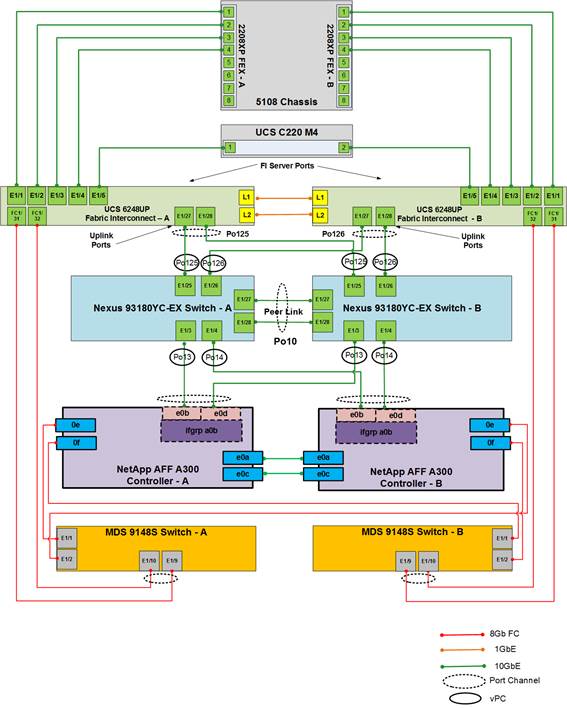
Active Directory DC/DNS
Production environments at most customer’s location might have an active directory and DNS infrastructure configured; the FlexPod with Microsoft Windows Server 2016 Hyper-V deployment model does not require an additional domain controller to be setup. The optional domain controllers is omitted from the configuration in this case or used as a resource domain. In this document we have used an existing AD domain controller and an AD integrated DNS server role running on the same server, which is available in our lab environment.
Microsoft System Center 2016
This document does not cover the steps to install Microsoft System Center Operations Manager (SCOM) and Virtual Machine Manager (SCVMM). Follow Microsoft guidelines to install SCOM and SCVMM 2016:
· SCOM: https://docs.microsoft.com/en-us/system-center/scom/deploy-overview
· SCVMM: https://docs.microsoft.com/en-us/system-center/vmm/install-console
This section provides a detailed procedure for configuring the Cisco Nexus 9000s for use in a FlexPod environment. Follow these steps precisely because failure to do so could result in an improper configuration.
Physical Connectivity
Follow the physical connectivity guidelines for FlexPod as covered in the section "FlexPod Cabling”.
FlexPod Cisco Nexus Base
The following procedures describe how to configure the Cisco Nexus switches for use in a base FlexPod environment. This procedure assumes the use of Cisco Nexus 9000 7.0(3)I4(5), and is valid for both the Cisco Nexus 9332PQ switches deployed with the 40Gb end-to-end topology, and the Cisco Nexus 93180YC-EX switches used in the 10Gb based topology.
![]() The following procedure includes the setup of NTP distribution on the in-band management VLAN. The interface-vlan feature and ntp commands are used to set this up. This procedure also assumes that the default VRF is used to route the in-band management VLAN.
The following procedure includes the setup of NTP distribution on the in-band management VLAN. The interface-vlan feature and ntp commands are used to set this up. This procedure also assumes that the default VRF is used to route the in-band management VLAN.
Set Up Initial Configuration
Cisco Nexus A
To set up the initial configuration for the Cisco Nexus A switch on <nexus-A-hostname>, complete the following steps:
1. Configure the switch.
![]() On initial boot and connection to the serial or console port of the switch, the NX-OS setup should automatically start and attempt to enter Power on Auto Provisioning.
On initial boot and connection to the serial or console port of the switch, the NX-OS setup should automatically start and attempt to enter Power on Auto Provisioning.
Abort Power on Auto Provisioning and continue with normal setup? (yes/no) [n]: yes
Do you want to enforce secure password standard (yes/no) [y]: Enter
Enter the password for "admin": <password>
Confirm the password for "admin": <password>
Would you like to enter the basic configuration dialog (yes/no): yes
Create another login account (yes/no) [n]: Enter
Configure read-only SNMP community string (yes/no) [n]: Enter
Configure read-write SNMP community string (yes/no) [n]: Enter
Enter the switch name: <nexus-A-hostname>
Continue with Out-of-band (mgmt0) management configuration? (yes/no) [y]: Enter
Mgmt0 IPv4 address: <nexus-A-mgmt0-ip>
Mgmt0 IPv4 netmask: <nexus-A-mgmt0-netmask>
Configure the default gateway? (yes/no) [y]: Enter
IPv4 address of the default gateway: <nexus-A-mgmt0-gw>
Configure advanced IP options? (yes/no) [n]: Enter
Enable the telnet service? (yes/no) [n]: Enter
Enable the ssh service? (yes/no) [y]: Enter
Type of ssh key you would like to generate (dsa/rsa) [rsa]: Enter
Number of rsa key bits <1024-2048> [1024]: Enter
Configure the ntp server? (yes/no) [n]: y
NTP server IPv4 address: <global-ntp-server-ip>
Configure default interface layer (L3/L2) [L3]: L2
Configure default switchport interface state (shut/noshut) [shut]: Enter
Configure CoPP system profile (strict/moderate/lenient/dense/skip) [strict]: Enter
Would you like to edit the configuration? (yes/no) [n]: Enter
2. Review the configuration summary before enabling the configuration.
Use this configuration and save it? (yes/no) [y]: Enter
Cisco Nexus B
To set up the initial configuration for the Cisco Nexus B switch on <nexus-B-hostname>, complete the following steps:
1. Configure the switch.
![]() On initial boot and connection to the serial or console port of the switch, the NX-OS setup should automatically start and attempt to enter Power on Auto Provisioning.
On initial boot and connection to the serial or console port of the switch, the NX-OS setup should automatically start and attempt to enter Power on Auto Provisioning.
Abort Power on Auto Provisioning and continue with normal setup? (yes/no) [n]: yes
Do you want to enforce secure password standard (yes/no) [y]: Enter
Enter the password for "admin": <password>
Confirm the password for "admin": <password>
Would you like to enter the basic configuration dialog (yes/no): yes
Create another login account (yes/no) [n]: Enter
Configure read-only SNMP community string (yes/no) [n]: Enter
Configure read-write SNMP community string (yes/no) [n]: Enter
Enter the switch name: <nexus-B-hostname>
Continue with Out-of-band (mgmt0) management configuration? (yes/no) [y]: Enter
Mgmt0 IPv4 address: <nexus-B-mgmt0-ip>
Mgmt0 IPv4 netmask: <nexus-B-mgmt0-netmask>
Configure the default gateway? (yes/no) [y]: Enter
IPv4 address of the default gateway: <nexus-B-mgmt0-gw>
Configure advanced IP options? (yes/no) [n]: Enter
Enable the telnet service? (yes/no) [n]: Enter
Enable the ssh service? (yes/no) [y]: Enter
Type of ssh key you would like to generate (dsa/rsa) [rsa]: Enter
Number of rsa key bits <1024-2048> [1024]: Enter
Configure the ntp server? (yes/no) [n]: y
NTP server IPv4 address: <global-ntp-server-ip>
Configure default interface layer (L3/L2) [L3]: L2
Configure default switchport interface state (shut/noshut) [shut]: Enter
Configure CoPP system profile (strict/moderate/lenient/dense/skip) [strict]: Enter
Would you like to edit the configuration? (yes/no) [n]: Enter
2. Review the configuration summary before enabling the configuration.
Use this configuration and save it? (yes/no) [y]: Enter
FlexPod Cisco Nexus Switch Configuration
Enable Licenses
Cisco Nexus A and Cisco Nexus B
To license the Cisco Nexus switches, complete the following steps:
1. Log in as admin.
2. Run the following commands:
config t
feature interface-vlan
feature lacp
feature vpc
feature lldp
feature nxapi
Set Global Configurations
Cisco Nexus A and Cisco Nexus B
To set global configurations, complete the following step on both switches.
Run the following commands to set global configurations:
spanning-tree port type network default
spanning-tree port type edge bpduguard default
spanning-tree port type edge bpdufilter default
port-channel load-balance src-dst l4port
ntp server <global-ntp-server-ip> use-vrf management
ntp master 3
ip route 0.0.0.0/0 <ib-mgmt-vlan-gateway>
copy run start
Create VLANs
Cisco Nexus A and Cisco Nexus B
To create the necessary virtual local area networks (VLANs), complete the following step on both the switches.
From the global configuration mode, run the following commands:
vlan <ms-ib-mgmt-vlan-id>
name MS-IB-MGMT-VLAN
vlan <native-vlan-id>
name Native-VLAN
vlan < ms-lvmn-vlan-id>
name MS-LVMN-VLAN
vlan <ms-tenant-vm-vlan-id>
name MS-Tenant-VM-VLAN
vlan <ms-cluster-vlan-id>
name MS-Cluster-VLAN
vlan <ms-SMB-1-vlan-id>
name MS-SMB-1-VLAN
vlan <ms-SMB-2-vlan-id>
name MS-SMB-2-VLAN
exit
Add NTP Distribution Interface
Cisco Nexus A
From the global configuration mode, run the following commands:
ntp source <switch-a-ntp-ip>
interface Vlan<ib-mgmt-vlan-id>
ip address <switch-a-ntp-ip>/<ib-mgmt-vlan-netmask-length>
no shutdown
exit
Cisco Nexus B
From the global configuration mode, run the following commands:
ntp source <switch-b-ntp-ip>
interface Vlan<ib-mgmt-vlan-id>
ip address <switch-b-ntp-ip>/<ib-mgmt-vlan-netmask-length>
no shutdown
exit
Add Individual Port Descriptions for Troubleshooting
Cisco Nexus A
To add individual port descriptions for troubleshooting activity and verification for switch A, complete the following step:
![]() In this step and in the later sections, configure the AFF nodename <st-node> and Cisco UCS 6332-16UP or UCS 6248UP fabric interconnect clustername <ucs-clustername> interfaces as appropriate to your deployment.
In this step and in the later sections, configure the AFF nodename <st-node> and Cisco UCS 6332-16UP or UCS 6248UP fabric interconnect clustername <ucs-clustername> interfaces as appropriate to your deployment.
From the global configuration mode, run the following commands:
interface Eth1/3
description <st-node>-1:e2a
interface Eth1/4
description <st-node>-2:e2a
interface Eth1/25
description <ucs-clustername>-a:1/27
interface Eth1/26
description <ucs-clustername>-b:1/27
interface Eth1/27
description <nexus-hostname>-b:1/27
interface Eth1/28
description <nexus-hostname>-b:1/28
exit
Cisco Nexus B
To add individual port descriptions for troubleshooting activity and verification for switch B, complete the following step:
From the global configuration mode, run the following commands:
interface Eth1/3
description <st-node>-1:e2e
interface Eth1/4
description <st-node>-2:e2e
interface Eth1/25
description <ucs-clustername>-a:1/28
interface Eth1/26
description <ucs-clustername>-b:1/28
interface Eth1/27
description <nexus-hostname>-a:1/27
interface Eth1/28
description <nexus-hostname>-a:1/28
exit
Create Port Channels
Cisco Nexus A and Cisco Nexus B
To create necessary port channels between the devices, complete the following step on both the switches.
From the global configuration mode, run the following commands:
interface Po10
description vPC peer-link
interface Eth1/27-28
channel-group 10 mode active
no shutdown
interface Po13
description <st-node>-1
interface Eth1/3
channel-group 13 mode active
no shutdown
interface Po14
description <st-node>-2
interface Eth1/4
channel-group 14 mode active
no shutdown
interface Po125
description <ucs-clustername>-a
interface Eth1/25
channel-group 125 mode active
no shutdown
interface Po126
description <ucs-clustername>-b
interface Eth1/26
channel-group 126 mode active
no shutdown
exit
copy run start
Configure Port Channel Parameters
Cisco Nexus A and Cisco Nexus B
To configure port channel parameters, complete the following step on both the switches.
From the global configuration mode, run the following commands:
interface Po10
switchport mode trunk
switchport trunk native vlan 2
switchport trunk allowed vlan <ib-mgmt-vlan-id>, <infra-SMB-1-id>, <infra-SMB-2-id>, <LiveMigration-vlan-id>, <vm-traffic-vlan-id>, <infra-ClusterComm-id>,
spanning-tree port type network
interface Po13
switchport mode trunk
switchport trunk native vlan 2
switchport trunk allowed vlan <ib-mgmt-vlan-id>, <infra-SMB-1-id>, <infra-SMB-2-id>
spanning-tree port type edge trunk
mtu 9216
interface Po14
switchport mode trunk
switchport trunk native vlan 2
switchport trunk allowed vlan <ib-mgmt-vlan-id>, <infra-SMB-1-id>, <infra-SMB-2-id>
spanning-tree port type edge trunk
mtu 9216
interface Po125
switchport mode trunk
switchport trunk native vlan 2
switchport trunk allowed vlan <ib-mgmt-vlan-id>, <infra-SMB-1-id>, <infra-SMB-2-id>, <LiveMigration-vlan-id>, <vm-traffic-vlan-id>, <infra-ClusterComm-id>
spanning-tree port type edge trunk
mtu 9216
interface Po126
switchport mode trunk
switchport trunk native vlan 2
switchport trunk allowed vlan <ib-mgmt-vlan-id>, <infra-SMB-1-id>, <infra-SMB-2-id>, <LiveMigration-vlan-id>, <vm-traffic-vlan-id>, <infra-ClusterComm-id>
spanning-tree port type edge trunk
mtu 9216
exit
copy run start
Configure Virtual Port Channels
Cisco Nexus A
To configure virtual port channels (vPCs) for switch A, complete the following step.
From the global configuration mode, run the following commands:
vpc domain <nexus-vpc-domain-id>
role priority 10
peer-keepalive destination <nexus-B-mgmt0-ip> source <nexus-A-mgmt0-ip>
peer-switch
peer-gateway
auto-recovery
delay restore 150
interface Po10
vpc peer-link
interface Po13
vpc 13
interface Po14
vpc 14
interface Po125
vpc 125
interface Po126
vpc 126
exit
copy run start
Cisco Nexus B
To configure vPCs for switch B, complete the following step.
From the global configuration mode, run the following commands:
vpc domain <nexus-vpc-domain-id>
role priority 20
peer-keepalive destination <nexus-A-mgmt0-ip> source <nexus-B-mgmt0-ip>
peer-switch
peer-gateway
auto-recovery
delay restore 150
interface Po10
vpc peer-link
interface Po13
vpc 13
interface Po14
vpc 14
interface Po125
vpc 125
interface Po126
vpc 126
exit
copy run start
Uplink into Existing Network Infrastructure
Depending on the available network infrastructure, several methods and features can be used to provide uplink connectivity to the FlexPod environment. If a Cisco Nexus environment is present, we recommend using vPCs with the Cisco Nexus switches included in the FlexPod environment. The previously described procedures can be used to create an uplink vPC to the existing environment. Make sure to run copy run start to save the configuration on each switch after completing the configuration.
NetApp All Flash FAS A300 Controllers
![]() Pursuant to best practices, NetApp recommends the following command on the LOADER prompt of the NetApp controllers to assist with LUN stability during copy operations. To access the LOADER prompt, connect to the controller via serial console port or Service Processor connection and press Ctrl-C to halt the boot process when prompted: setenv bootarg.tmgr.disable_pit_hp 1
Pursuant to best practices, NetApp recommends the following command on the LOADER prompt of the NetApp controllers to assist with LUN stability during copy operations. To access the LOADER prompt, connect to the controller via serial console port or Service Processor connection and press Ctrl-C to halt the boot process when prompted: setenv bootarg.tmgr.disable_pit_hp 1
![]() For more information about the workaround, please see the NetApp public report. Note that a NetApp login is required to view the report: http://nt-ap.com/2w6myr4
For more information about the workaround, please see the NetApp public report. Note that a NetApp login is required to view the report: http://nt-ap.com/2w6myr4
![]() For more information about Windows Offloaded Data Transfers see: https://technet.microsoft.com/en- us/library/hh831628(v=ws.11).aspx
For more information about Windows Offloaded Data Transfers see: https://technet.microsoft.com/en- us/library/hh831628(v=ws.11).aspx
NetApp Hardware Universe
The NetApp Hardware Universe (HWU) application provides supported hardware and software components for any specific ONTAP version. It provides configuration information for all the NetApp storage appliances currently supported by ONTAP software. It also provides a table of component compatibilities. Confirm that the hardware and software components that you would like to use are supported with the version of ONTAP that you plan to install by using the HWU application at the NetApp Support site.
Access the HWU application to view the System Configuration guides. Click the Controllers tab to view the compatibility between different version of the ONTAP software and the NetApp storage appliances with your desired specifications. Alternatively, to compare components by storage appliance, click Compare Storage Systems.
Controllers
Follow the physical installation procedures for the controllers found in the AFF A300 Series product documentation at the NetApp Support site.
Disk Shelves
NetApp storage systems support a wide variety of disk shelves and disk drives. The complete list of disk shelves that are supported by the AFF A300 is available at the NetApp Support site.
For SAS disk shelves with NetApp storage controllers, refer to the SAS Disk Shelves Universal SAS and ACP Cabling Guide for proper cabling guidelines.
NetApp ONTAP 9.1
Complete Configuration Worksheet
Before running the setup script, complete the cluster setup worksheet from the ONTAP 9.1 Software Setup Guide. You must have access to the NetApp Support site to open the cluster setup worksheet.
Configure ONTAP Nodes
Before running the setup script, review the configuration worksheets in the ONTAP 9.1 Software Setup Guide to learn about configuring ONTAP. Table 4 lists the information needed to configure two ONTAP nodes. Customize the cluster detail values with the information applicable to your deployment.
Table 4 ONTAP software installation prerequisites
| Cluster Detail |
Cluster Detail Value |
| Cluster node 01 IP address |
<node01-mgmt-ip> |
| Cluster node 01 netmask |
<node01-mgmt-mask> |
| Cluster node 01 gateway |
<node01-mgmt-gateway> |
| Cluster node 02 IP address |
<node02-mgmt-ip> |
| Cluster node 02 netmask |
<node02-mgmt-mask> |
| Cluster node 02 gateway |
<node02-mgmt-gateway> |
| Data ONTAP 9.1 URL |
<url-boot-software> |
Configure Node 01
To configure node 01, complete the following steps:
1. Connect to the storage system console port. You should see a Loader-A prompt. However, if the storage system is in a reboot loop, press Ctrl-C to exit the autoboot loop when the following message displays:
Starting AUTOBOOT press Ctrl-C to abort…
2. Allow the system to boot up.
autoboot
3. Press Ctrl-C when prompted.
![]() If ONTAP 9.1 is not the version of software being booted, continue with the following steps to install new software. If ONTAP 9.1 is the version being booted, select option 8 and y to reboot the node. Then continue with step 14.
If ONTAP 9.1 is not the version of software being booted, continue with the following steps to install new software. If ONTAP 9.1 is the version being booted, select option 8 and y to reboot the node. Then continue with step 14.
4. To install new software, select option 7.
5. Enter y to perform an upgrade.
6. Select e0M for the network port you want to use for the download.
7. Enter y to reboot now.
8. Enter the IP address, netmask, and default gateway for e0M.
<node01-mgmt-ip> <node01-mgmt-mask> <node01-mgmt-gateway>
9. Enter the URL where the software can be found.
![]() This web server must be reachable.
This web server must be reachable.
<url-boot-software>
10. Press Enter for the user name, indicating no user name.
11. Enter y to set the newly installed software as the default to be used for subsequent reboots.
12. Enter y to reboot the node.
![]() When installing new software, the system might perform firmware upgrades to the BIOS and adapter cards, causing reboots and possible stops at the Loader-A prompt. If these actions occur, the system might deviate from this procedure.
When installing new software, the system might perform firmware upgrades to the BIOS and adapter cards, causing reboots and possible stops at the Loader-A prompt. If these actions occur, the system might deviate from this procedure.
13. Press Ctrl-C when the following message displays:
Press Ctrl-C for Boot Menu
14. Select option 4 for Clean Configuration and Initialize All Disks.
15. Enter y to zero disks, reset config, and install a new file system.
16. Enter y to erase all the data on the disks.
![]() The initialization and creation of the root aggregate can take 90 minutes or more to complete, depending on the number and type of disks attached. When initialization is complete, the storage system reboots. Note that SSDs take considerably less time to initialize. You can continue with node 02 configuration while the disks for node 01 are zeroing.
The initialization and creation of the root aggregate can take 90 minutes or more to complete, depending on the number and type of disks attached. When initialization is complete, the storage system reboots. Note that SSDs take considerably less time to initialize. You can continue with node 02 configuration while the disks for node 01 are zeroing.
Configure Node 02
To configure node 02, complete the following steps:
1. Connect to the storage system console port. You should see a Loader-A prompt. However, if the storage system is in a reboot loop, press Ctrl-C to exit the autoboot loop when the following message displays:
Starting AUTOBOOT press Ctrl-C to abort…
2. Allow the system to boot up.
autoboot
3. Press Ctrl-C when prompted.
![]() If ONTAP 9.1 is not the version of software being booted, continue with the following steps to install new software. If ONTAP 9.1 is the version being booted, select option 8 and y to reboot the node. Then continue with step 14.
If ONTAP 9.1 is not the version of software being booted, continue with the following steps to install new software. If ONTAP 9.1 is the version being booted, select option 8 and y to reboot the node. Then continue with step 14.
4. To install new software, select option 7.
5. Enter y to perform an upgrade.
6. Select e0M for the network port you want to use for the download.
7. Enter y to reboot now.
8. Enter the IP address, netmask, and default gateway for e0M.
<node02-mgmt-ip> <node02-mgmt-mask> <node02-mgmt-gateway>
9. Enter the URL where the software can be found.
![]() This web server must be reachable.
This web server must be reachable.
<url-boot-software>
10. Press Enter for the user name, indicating no user name.
11. Enter y to set the newly installed software as the default to be used for subsequent reboots.
12. Enter y to reboot the node.
![]() When installing new software, the system might perform firmware upgrades to the BIOS and adapter cards, causing reboots and possible stops at the Loader-A prompt. If these actions occur, the system might deviate from this procedure.
When installing new software, the system might perform firmware upgrades to the BIOS and adapter cards, causing reboots and possible stops at the Loader-A prompt. If these actions occur, the system might deviate from this procedure.
13. Press Ctrl-C when you see this message:
Press Ctrl-C for Boot Menu
14. Select option 4 for Clean Configuration and Initialize All Disks.
15. Enter y to zero disks, reset config, and install a new file system.
16. Enter y to erase all the data on the disks.
![]() The initialization and creation of the root aggregate can take 90 minutes or more to complete, depending on the number and type of disks attached. When initialization is complete, the storage system reboots. Note that SSDs take considerably less time to initialize. You can continue with node 02 configuration while the disks for node 01 are zeroing.
The initialization and creation of the root aggregate can take 90 minutes or more to complete, depending on the number and type of disks attached. When initialization is complete, the storage system reboots. Note that SSDs take considerably less time to initialize. You can continue with node 02 configuration while the disks for node 01 are zeroing.
Set Up Node
From a console port program attached to the storage controller A (node 01) console port, run the node setup script. This script appears when ONTAP 9.1 boots on the node for the first time.
1. Follow the prompts to set up node 01:
Welcome to node setup.
You can enter the following commands at any time:
"help" or "?" - if you want to have a question clarified,
"back" - if you want to change previously answered questions, and
"exit" or "quit" - if you want to quit the setup wizard.
Any changes you made before quitting will be saved.
You can return to cluster setup at any time by typing “cluster setup”.
To accept a default or omit a question, do not enter a value.
This system will send event messages and weekly reports to NetApp Technical Support.
To disable this feature, enter "autosupport modify -support disable" within 24 hours.
Enabling AutoSupport can significantly speed problem determination and resolution should a problem occur on your system.
For further information on AutoSupport, see:
http://support.netapp.com/autosupport/
Type yes to confirm and continue {yes}: yes
Enter the node management interface port [e0M]: Enter
Enter the node management interface IP address: <node01-mgmt-ip>
Enter the node management interface netmask: <node01-mgmt-mask>
Enter the node management interface default gateway: <node01-mgmt-gateway>
A node management interface on port e0M with IP address <node01-mgmt-ip> has been created
Use your web browser to complete cluster setup by accesing https://<node01-mgmt-ip>
Otherwise press Enter to complete cluster setup using the command line interface:
2. To complete the cluster setup, open a web browser and navigate to https://<node01-mgmt-ip>.
Table 5 Cluster create in ONTAP prerequisites
| Cluster Detail |
Cluster Detail Value |
| Cluster name |
<clustername> |
| ONTAP base license |
<cluster-base-license-key> |
| Cluster management IP address |
<clustermgmt-ip> |
| Cluster management netmask |
<clustermgmt-mask> |
| Cluster management gateway |
<clustermgmt-gateway> |
| Cluster node 01 IP address |
<node01-mgmt-ip> |
| Cluster node 01 netmask |
<node01-mgmt-mask> |
| Cluster node 01 gateway |
<node01-mgmt-gateway> |
| Cluster node 02 IP address |
<node02-mgmt-ip> |
| Cluster node 02 netmask |
<node02-mgmt-mask> |
| Cluster node 02 gateway |
<node02-mgmt-gateway> |
| Node 01 service processor IP address |
<node01-SP-ip> |
| Node 02 service processor IP address |
<node02-SP-ip> |
| DNS domain name |
<dns-domain-name> |
| DNS server IP address |
<dns-ip> |
| NTP server IP address |
<ntp-ip> |
![]() Cluster setup can also be performed with the command line interface. This document describes the cluster setup using the NetApp System Manager guided setup.
Cluster setup can also be performed with the command line interface. This document describes the cluster setup using the NetApp System Manager guided setup.
3. Click Guided Setup on the welcome screen.
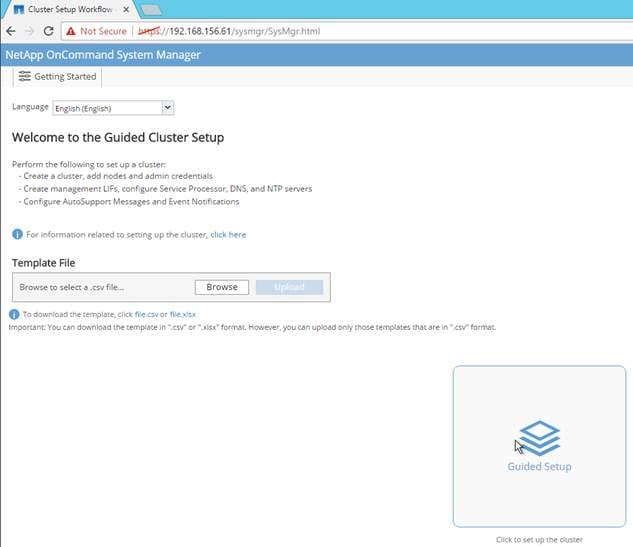
4. In the Cluster screen, complete the following steps:
· Enter the cluster and node names.
· Select the cluster configuration.
· Enter and confirm the password.
· (Optional) Enter the cluster base and feature licenses.
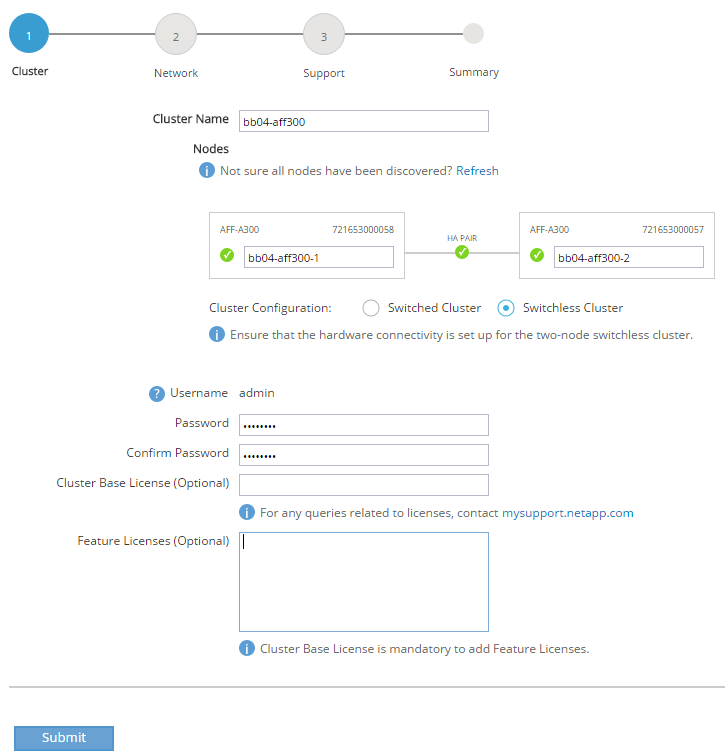
![]() The nodes are discovered automatically, if they are not discovered, click the Refresh link. By default, the cluster interfaces are created on all new storage controllers shipped from the factory. If all the nodes are not discovered, then configure the cluster using the command line. Cluster license and feature licenses can also be installed after completing the cluster creation.
The nodes are discovered automatically, if they are not discovered, click the Refresh link. By default, the cluster interfaces are created on all new storage controllers shipped from the factory. If all the nodes are not discovered, then configure the cluster using the command line. Cluster license and feature licenses can also be installed after completing the cluster creation.
5. Click Submit.
6. On the network page, complete the following sections:
· Cluster Management
- Enter the IP address, netmask, gateway and port details.
· Node Management
- Enter the node management IP addresses and port details for all the nodes.
· Service Processor Management
- Enter the IP addresses for all the nodes.
· DNS Details
- Enter the DNS domain names and server address.
· NTP Details
- Enter the primary and alternate NTP server.
7. Click Submit.
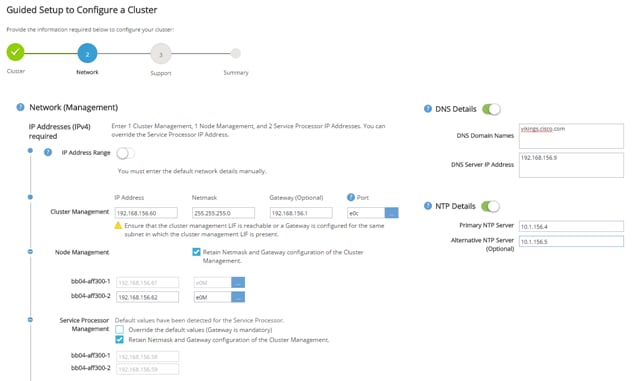
8. On the Support page, configure the AutoSupport and Event Notifications sections.
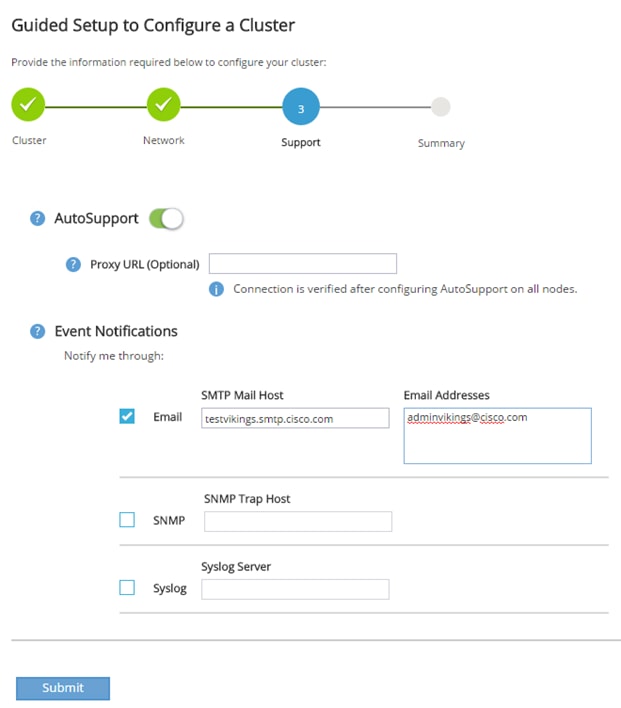
9. Click Submit.
10. On the Summary page, review the configuration details.
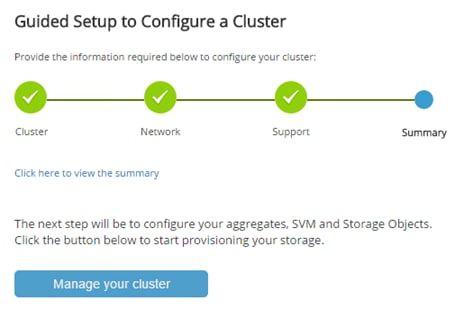
![]() The node management interface can be on the same subnet as the cluster management interface, or it can be on a different subnet. In this document, we assume that it is on the same subnet.
The node management interface can be on the same subnet as the cluster management interface, or it can be on a different subnet. In this document, we assume that it is on the same subnet.
Login to the Cluster
To log in to the cluster, complete the following steps:
1. Open an SSH connection to either the cluster IP or host name.
2. Log in to the admin user with the password you provided earlier.
Zero All Spare Disks
To zero all spare disks in the cluster, run the following command:
disk zerospares.
![]() Advanced Data Partitioning creates a root partition and two data partitions on each SSD drive in an All Flash FAS configuration. Disk autoassign should have assigned one data partition to each node in an HA pair.
Advanced Data Partitioning creates a root partition and two data partitions on each SSD drive in an All Flash FAS configuration. Disk autoassign should have assigned one data partition to each node in an HA pair.
![]() If a different disk assignment is required, disk autoassignment must be disabled on both nodes in the HA pair by running the disk option modify command. Spare partitions can then be moved from one node to another by running the disk removeowner and disk assign commands.
If a different disk assignment is required, disk autoassignment must be disabled on both nodes in the HA pair by running the disk option modify command. Spare partitions can then be moved from one node to another by running the disk removeowner and disk assign commands.
Set Onboard Unified Target Adapter 2 Port Personality
To set the personality of the onboard unified target adapter 2 (UTA2), complete the following steps:
1. Verify the Current Mode and Current Type properties of the ports by running the ucadmin show command.
ucadmin show
Current Current Pending Pending Admin
Node Adapter Mode Type Mode Type Status
------------ ------- ------- --------- ------- --------- -----------
<st-node01>
0e fc target - - online
<st-node01>
0f fc target - - online
<st-node01>
0g cna target - - online
<st-node01>
0h cna target - - online
<st-node02>
0e fc target - - online
<st-node02>
0f fc target - - online
<st-node02>
0g cna target - - online
<st-node02>
0h cna target - - online
8 entries were displayed.
2. Verify that the Current Mode and Current Type properties for all ports are set properly. Set the ports used for FC connectivity to mode fc. The port type for all protocols should be set to target. Change the port personality by running the following command:
ucadmin modify -node <home-node-of-the-port> -adapter <port-name> -mode fc -type target.
![]() The ports must be offline to run this command. To take an adapter offline, run the fcp adapter modify –node <home-node-of-the-port> -adapter <port-name> -state down command. Ports must be converted in pairs (for example, 0e and 0f).
The ports must be offline to run this command. To take an adapter offline, run the fcp adapter modify –node <home-node-of-the-port> -adapter <port-name> -state down command. Ports must be converted in pairs (for example, 0e and 0f).
![]() After conversion, a reboot is required. After reboot, bring the ports online by running fcp adapter modify -node <home-node-of-the-port> -adapter <port-name> -state up.
After conversion, a reboot is required. After reboot, bring the ports online by running fcp adapter modify -node <home-node-of-the-port> -adapter <port-name> -state up.
Set Auto-Revert on Cluster Management
To set the auto-revert parameter on the cluster management interface, run the following command:
![]() A storage virtual machine (SVM) is referred to as a Vserver (or vserver) in the GUI and CLI.
A storage virtual machine (SVM) is referred to as a Vserver (or vserver) in the GUI and CLI.
Run the following command:
network interface modify –vserver <clustername> -lif cluster_mgmt –auto-revert true
Set Up Management Broadcast Domain
By default, all network ports are included in the default broadcast domain. Network ports used for data services (for example, e0d, e2a, and e2e) should be removed from the default broadcast domain, leaving just the management network ports (e0c and e0M). To perform this task, run the following commands:
broadcast-domain remove-ports -broadcast-domain Default -ports bb04-affa300-1:e0d,bb04-affa300-1:e0g,bb04-affa300-1:e0h,bb04-affa300-1:e2a,bb04-affa300-1:e2e,bb04-affa300-2:e0d,bb04-affa300-2:e0g,bb04-affa300-2:e0h,bb04-affa300-2:e2a,bb04-affa300-2:e2e
broadcast-domain show
Set Up Service Processor Network Interface
To assign a static IPv4 address to the service processor on each node, run the following commands:
system service-processor network modify –node <st-node01> -address-family IPv4 –enable true –dhcp none –ip-address <node01-sp-ip> -netmask <node01-sp-mask> -gateway <node01-sp-gateway>
system service-processor network modify –node <st-node02> -address-family IPv4 –enable true –dhcp none –ip-address <node02-sp-ip> -netmask <node02-sp-mask> -gateway <node02-sp-gateway>
![]() The service processor IP addresses should be in the same subnet as the node management IP addresses.
The service processor IP addresses should be in the same subnet as the node management IP addresses.
Create Aggregates
An aggregate containing the root volume is created during the ONTAP setup process. To create additional aggregates, determine the aggregate name, the node on which to create it, and the number of disks it should contain.
To create new aggregates, run the following commands:
aggr create -aggregate aggr1_node01 -node <st-node01> -diskcount <num-disks>
aggr create -aggregate aggr1_node02 -node <st-node02> -diskcount <num-disks>
![]() You should have the minimum number of hot spare disks for hot spare disk partitions recommended for your aggregate. For all-flash aggregates, you should have a minimum of one hot spare disk or disk partition. For non-flash homogenous aggregates, you should have a minimum of two hot spare disks or disk partitions.
You should have the minimum number of hot spare disks for hot spare disk partitions recommended for your aggregate. For all-flash aggregates, you should have a minimum of one hot spare disk or disk partition. For non-flash homogenous aggregates, you should have a minimum of two hot spare disks or disk partitions.
![]() For Flash Pool aggregates, you should have a minimum of two hot spare disks or disk partitions for each disk type. Start with five disks initially; you can add disks to an aggregate when additional storage is required. In an AFF configuration with a small number of SSDs, you might want to create an aggregate with all but one remaining disk (spare) assigned to the controller.
For Flash Pool aggregates, you should have a minimum of two hot spare disks or disk partitions for each disk type. Start with five disks initially; you can add disks to an aggregate when additional storage is required. In an AFF configuration with a small number of SSDs, you might want to create an aggregate with all but one remaining disk (spare) assigned to the controller.
![]() The aggregate cannot be created until disk zeroing completes. Run the aggr show command to display aggregate creation status. Do not proceed until both aggr1_node1 and aggr1_node2 are online.
The aggregate cannot be created until disk zeroing completes. Run the aggr show command to display aggregate creation status. Do not proceed until both aggr1_node1 and aggr1_node2 are online.
(Optional) Rename the root aggregate on node 01 to match the naming convention for this aggregate on node 02. The aggregate is automatically renamed if system-guided setup is used.
aggr show
aggr rename –aggregate aggr0 –newname <node01-rootaggrname>
Verify Storage Failover
To confirm that storage failover is enabled, run the following commands for a failover pair:
1. Verify the status of the storage failover.
storage failover show
![]() Both <st-node01> and <st-node02> must be able to perform a takeover. Continue with step 3 if the nodes can perform a takeover.
Both <st-node01> and <st-node02> must be able to perform a takeover. Continue with step 3 if the nodes can perform a takeover.
2. Enable failover on one of the two nodes.
storage failover modify -node <st-node01> -enabled true
![]() Enabling failover on one node enables it for both nodes.
Enabling failover on one node enables it for both nodes.
3. Verify the HA status for a two-node cluster.
![]() This step is not applicable for clusters with more than two nodes.
This step is not applicable for clusters with more than two nodes.
cluster ha show
4. Continue with step 6 if high availability is configured.
![]() Only enable HA mode for two-node clusters. Do not run this command for clusters with more than two nodes because it causes problems with failover.
Only enable HA mode for two-node clusters. Do not run this command for clusters with more than two nodes because it causes problems with failover.
cluster ha modify -configured true
Do you want to continue? {y|n}: y
5. Verify that hardware assist is correctly configured and, if needed, modify the partner IP address.
storage failover hwassist show
storage failover modify –hwassist-partner-ip <node02-mgmt-ip> -node <st-node01>
storage failover modify –hwassist-partner-ip <node01-mgmt-ip> -node <st-node02>
Disable Flow Control on 10GbE and 40GbE ports
NetApp recommends disabling flow control on all the 10GbE and UTA2 ports that are connected to external devices. To disable flow control, complete the following steps:
1. Run the following commands to configure node 01:
network port modify -node <st-node01> -port e0a,e0b,e0e,e0f,e0g,e0h,e2a,e2e -flowcontrol-admin none
Warning: Changing the network port settings will cause a several second interruption in carrier.
Do you want to continue? {y|n}: y
2. Run the following commands to configure node 02:
network port modify -node <st-node02> -port e0a,e0b,e0e,e0f,e0g,e0h,e2a,e2e -flowcontrol-admin none
Warning: Changing the network port settings will cause a several second interruption in carrier.
Do you want to continue? {y|n}: y
network port show –fields flowcontrol-admin
Disable Unused FCoE Capability on CNA Ports
If the UTA2 port is set to CNA mode and is only expected to handle Ethernet data traffic (for example CIFS), then the unused FCoE capability of the port should be disabled by setting the corresponding FCP adapter to state down with the fcp adapter modify command. Here are some examples:
fcp adapter modify -node <st-node01> -adapter 0g –status-admin down
fcp adapter modify -node <st-node01> -adapter 0h –status-admin down
fcp adapter modify -node <st-node02> -adapter 0g –status-admin down
fcp adapter modify -node <st-node02> -adapter 0h –status-admin down
fcp adapter show –fields status-admin
Configure Network Time Protocol
To configure time synchronization on the cluster, complete the following steps:
1. Set the time zone for the cluster.
timezone <timezone>
![]() For example, in the eastern United States, the time zone is America/New_York.
For example, in the eastern United States, the time zone is America/New_York.
2. Set the date for the cluster.
date <ccyymmddhhmm.ss>
![]() The format for the date is <[Century][Year][Month][Day][Hour][Minute].[Second]> (for example, 201703231549.30).
The format for the date is <[Century][Year][Month][Day][Hour][Minute].[Second]> (for example, 201703231549.30).
3. Configure the Network Time Protocol (NTP) servers for the cluster.
cluster time-service ntp server create -server <switch-a-ntp-ip>
cluster time-service ntp server create -server <switch-b-ntp-ip>
Configure Simple Network Management Protocol
To configure the Simple Network Management Protocol (SNMP), complete the following steps:
1. Configure basic SNMP information, such as the location and contact. When polled, this information is visible as the sysLocation and sysContact variables in SNMP.
snmp contact <snmp-contact>
snmp location “<snmp-location>”
snmp init 1
options snmp.enable on
2. Configure SNMP traps to send to remote hosts, such as a DFM server or another fault management system.
snmp traphost add <oncommand-um-server-fqdn>
Configure SNMPv1 Access
To configure SNMPv1 access, set the shared, secret plain-text password (called a community).
snmp community add ro <snmp-community>
Configure AutoSupport
NetApp AutoSupport® sends support summary information to NetApp through HTTPS. To configure AutoSupport, run the following command:
system node autosupport modify -node * -state enable –mail-hosts <mailhost> -transport https -support enable -noteto <storage-admin-email>
Enable Cisco Discovery Protocol
To enable the Cisco Discovery Protocol (CDP) on the NetApp storage controllers, run the following command:
node run -node * options cdpd.enable on
![]() To be effective, CDP must also be enabled on directly connected networking equipment such as switches and routers.
To be effective, CDP must also be enabled on directly connected networking equipment such as switches and routers.
Create Jumbo Frame MTU Broadcast Domains in ONTAP
To create a data broadcast domain with an MTU of 9000 for SMB and management on ONTAP, run the following command:
broadcast-domain create -broadcast-domain IB-MGMT-904 -mtu 9000
broadcast-domain create -broadcast-domain Infra_MS_SMB -mtu 9000
Create Interface Groups
To create LACP interface groups for the 10GbE data interfaces, run the following commands:
ifgrp create -node <st-node01> -ifgrp a0a -distr-func port -mode multimode_lacp
ifgrp add-port -node <st-node01> -ifgrp a0a -port e2a
ifgrp add-port -node <st-node01> -ifgrp a0a -port e2e
ifgrp create -node <st-node02> -ifgrp a0a -distr-func port -mode multimode_lacp
ifgrp add-port -node <st-node02> -ifgrp a0a -port e2a
ifgrp add-port -node <st-node02> -ifgrp a0a -port e2e
ifgrp show
Create VLANs
To create SMB VLAN, create SMB VLAN ports and add them to the SMB broadcast domain:
network port modify –node <st-node01> -port a0a –mtu 9000
network port modify –node <st-node02> -port a0a –mtu 9000
network port vlan create –node <st-node01> -vlan-name a0a-<infra-smb-vlan-id>
network port vlan create –node <st-node02> -vlan-name a0a-<infra-smb-vlan-id>
broadcast-domain add-ports -broadcast-domain Infra_MS_SMB -ports <st-node01>:a0a-<infra-smb-vlan-id>, <st-node02>:a0a-<infra-smb-vlan-id>
To create In-Band-Management VLAN and add them to the management broadcast domain:
network port vlan create –node <st-node01> -vlan-name a0a-<MS-IB-MGMT-VLAN>
network port vlan create –node <st-node02> -vlan-name a0a-<MS-IB-MGMT-VLAN>
broadcast-domain add-ports -broadcast-domain IB-MGMT-904 -ports <st-node01>:a0a-<MS-IB-MGMT-VLAN>, <st-node02>:a0a-<MS-IB-MGMT-VLAN>
Create Storage Virtual Machine
To create an infrastructure SVM, complete the following steps:
1. Run the vserver create command.
vserver create –vserver Infra-MS-SVM –rootvolume ms_rootvol –aggregate aggr1_node01 –rootvolume-security-style ntfs
2. Remove the unused data protocols (NFS, iSCSI, and NDMP) from the SVM.
vserver remove-protocols -vserver Infra-MS-SVM -protocols nfs,ndmp,iscsi
3. Add the two data aggregates to the Infra-MS-SVM aggregate list for the NetApp VSC.
Create the CIFS Service
You can enable and configure CIFS servers on storage virtual machines (SVMs) with NetApp FlexVol® volumes to let SMB clients access files on your cluster. Each data SVM in the cluster can be bound to exactly one Active Directory domain. However, the data SVMs do not need to be bound to the same domain. Each data SVM can be bound to a unique Active Directory domain.
Before configuring the CIFS service on your SVM, the DNS must be configured. To do so, complete the following steps:
1. Configure the DNS for your SVM.
dns create -vserver Infra-Hyper-V -domains <<domain_name>> -name-servers <<dns_server_ip>>
The node management network interfaces should be able to route to the Active Directory domain controller to which you want to join the CIFS server. Alternatively, a data network interface must exist on the SVM that can route to the Active Directory domain controller.
2. Create a network interface on the in-band VLAN.
network interface create -vserver Infra-MS-SVM -lif <<svm_mgmt_lif_name>> -role data -data-protocol none -home-node <<st-node-01>> -home-port a0a-<MS-IB-MGMT-VLAN> -address <svm-mgmt-ip> -netmask <svm-mgmt-mask> -failover-policy broadcast-domain-wide -firewall-policy mgmt -auto-revert true
3. Create the CIFS service.
vserver cifs create -vserver Infra-MS-SVM -cifs-server Infra-CIFS -domain flexpod.local
In order to create an Active Directory machine account for the CIFS server, you must supply the name and password of a Windows account with sufficient privileges to add computers to the "CN=Computers" container within the
"FLEXPOD.LOCAL" domain.
Enter the user name: Administrator@flexpod.local
Enter the password:
Modify Storage Virtual Machine Options
NetApp ONTAP can use automatic node referrals to increase SMB client performance on SVMs with FlexVol volumes. This feature allows the SVM to automatically redirect a client request to a network interface on the node where the FlexVol volume resides.
To enable automatic node referrals on your SVM, run the following command:
set -privilege advanced
vserver cifs options modify -vserver Infra-MS-SVM -is-referral-enabled true
Create Load-Sharing Mirrors of SVM Root Volume
To create a load-sharing mirror of an SVM root volume, complete the following steps:
1. Create a volume to be the load-sharing mirror of the infrastructure SVM root volume on each node.
volume create –vserver Infra-MS-SVM –volume ms_rootvol_m01 –aggregate aggr1_node01 –size 1GB –type DP
volume create –vserver Infra-MS-SVM –volume ms_rootvol_m02 –aggregate aggr1_node02 –size 1GB –type DP
2. Create a job schedule to update the root volume mirror relationships every 15 minutes.
job schedule interval create -name 15min -minutes 15
3. Create the mirroring relationships.
snapmirror create –source-path Infra-MS-SVM:ms_rootvol –destination-path Infra-MS-SVM:ms_rootvol_m01 –type LS -schedule 15min
snapmirror create –source-path Infra-MS-SVM:ms_rootvol –destination-path Infra-MS-SVM:ms_rootvol_m02 –type LS -schedule 15min
4. Initialize the mirroring relationship.
snapmirror initialize-ls-set –source-path Infra-MS-SVM:ms_rootvol
snapmirror show
Create Block Protocol FC Service
To create the FCP service on each SVM, run the following command. This command also starts the FCP service and sets the worldwide name (WWN) for the SVM.fcp create -vserver Infra-MS-SVM
fcp show
![]() If an FC license is not installed during the cluster configuration, you must install the FC service license.
If an FC license is not installed during the cluster configuration, you must install the FC service license.
Configure HTTPS Access
To configure secure access to the storage controller, complete the following steps:
1. Increase the privilege level to access the certificate commands.
set -privilege diag
Do you want to continue? {y|n}: y
2. Generally, a self-signed certificate is already in place. Verify the certificate and obtain parameters (for example, <serial-number>) by running the following command:
security certificate show
For each SVM shown, the certificate common name should match the DNS FQDN of the SVM. Delete the two default certificates and replace them with either self-signed certificates or certificates from a certificate authority (CA). To delete the default certificates, run the following commands:
security certificate delete -vserver Infra-MS-SVM -common-name Infra-MS-SVM -ca Infra-MS-SVM -type server -serial <serial-number>
![]() Deleting expired certificates before creating new certificates is a best practice. Run the security certificate delete command to delete the expired certificates. In the following command, use TAB completion to select and delete each default certificate.
Deleting expired certificates before creating new certificates is a best practice. Run the security certificate delete command to delete the expired certificates. In the following command, use TAB completion to select and delete each default certificate.
3. To generate and install self-signed certificates, run the following commands as one-time commands. Generate a server certificate for the Infra-MS-SVM and the cluster SVM. Use TAB completion to aid in the completion of these commands.
security certificate create -common-name <cert-common-name> -type server -size 2048 -country <cert-country> -state <cert-state> -locality <cert-locality> -organization <cert-org> -unit <cert-unit> -email-addr <cert-email> -expire-days <cert-days> -protocol SSL -hash-function SHA256 -vserver Infra-MS-SVM
4. To obtain the values for the parameters required in step 5 (<cert-ca> and <cert-serial>), run the security certificate show command.
5. Enable each certificate that was just created by using the –server-enabled true and –client-enabled false parameters. Use TAB completion to aid in the completion of these commands.
security ssl modify -vserver <clustername> -server-enabled true -client-enabled false -ca <cert-ca> -serial <cert-serial> -common-name <cert-common-name>
6. Disable HTTP cluster management access.
system services firewall policy delete -policy mgmt -service http –vserver <clustername>
![]() It is normal for some of these commands to return an error message stating that the entry does not exist.
It is normal for some of these commands to return an error message stating that the entry does not exist.
7. Change back to the normal admin privilege level and set up the system to allow SVM logs to be available by web.
set –privilege admin
vserver services web modify –name spi|ontapi|compat –vserver * -enabled true
Create SMB Export Policy
Optionally, you can use export policies to restrict SMB access to files and folders on SMB volumes. You can use export policies in combination with share level and file level permissions to determine effective access rights.
To create an export policy that limits access to devices in the domain, run the following command:
export-policy create -vserver Infra-MS-SVM -policyname smb
export-policy rule create -vserver Infra-MS-SVM -policyname cifs -clientmatch flexpod.local -rorule krb5i,krb5p -rwrule krb5i,krb5p
Create NetApp FlexVol Volumes
volume create -vserver Infra-MS-SVM -volume infra_datastore_1 -aggregate aggr1_node01 -size 500GB -state online -policy smb -security-style ntfs -junction-path /infra_datastore_1 -space-guarantee none -percent-snapshot-space 5
volume create -vserver Infra-MS-SVM -volume infra_datastore_2 -aggregate aggr1_node02 -size 500GB -state online -policy smb -security-style ntfs -junction-path /infra_datastore_2 -space-guarantee none -percent-snapshot-space 5
volume create -vserver Infra-MS-SVM -volume witness_FC_6332 -aggregate aggr1_node01 -size 5GB -state online -policy default -security-style ntfs -space-guarantee none -percent-snapshot-space 0
volume create -vserver Infra-MS-SVM -volume HV_boot -aggregate aggr1_node01 -size 500GB -state online -policy default -security-style ntfs -space-guarantee none -percent-snapshot-space 0
snapmirror update-ls-set -source-path Infra-MS-SVM:ms_rootvol
Create CIFS Shares
A CIFS share is a named access point in a volume that enables CIFS clients to view, browse, and manipulate files on a file server.
cifs share create -vserver Infra-MS-SVM -share-name infra_share_1_Share -path /infra_datastore_1 -share-properties oplocks,browsable,continuously-available,showsnapshot
cifs share create -vserver Infra-MS-SVM -share-name infra_share_2_Share -path /infra_datastore_2 -share-properties oplocks,browsable,continuously-available,showsnapshot
Configuring share permissions by creating access control lists (ACLs) for SMB shares enables you to control the level of access to a share for users and groups.
To configure the Administrators and Hyper-V hosts to access to the CIFS Share, run the following commands:
cifs share access-control create -vserver Infra-MS-SVM -share 6332_Share -user-or-group Flexpod\Administrator -user-group-type windows -permission Full_Control
cifs share access-control create -vserver Infra-MS-SVM -share 6332_Share -user-or-group flexpod\<FC_Host_1>$ -user-group-type windows -permission Full_Control
cifs share access-control create -vserver Infra-MS-SVM -share 6332_Share -user-or-group flexpod\<FC_Host_2>$ -user-group-type windows -permission Full_Control
Create Boot LUNs
To create two boot LUNs, run the following commands:
lun create -vserver Infra-MS-SVM -volume HV_boot -lun VM-Host-Infra-01 -size 200GB –ostype windows_2008 -space-reserve disabled
lun create -vserver Infra-MS-SVM -volume HV_boot -lun VM-Host-Infra-02 -size 200GB -ostype windows_2008 -space-reserve disabled
Create Witness LUN
A witness LUN is required in a Hyper-V cluster. To create the witness LUN, run the following command:
lun create -vserver Infra-MS-SVM -volume witness_FC_6332 -lun witness_FC_6332 -size 1GB –ostype windows_2008 -space-reserve disabled
Schedule Deduplication
On NetApp All Flash FAS systems, deduplication is enabled by default. To schedule deduplication, complete the following steps:
1. After the volumes are created, assign a once-a-day deduplication schedule to HV_boot, infra_datastore_1 and infra_datastore_2:
efficiency modify –vserver Infra-MS-SVM –volume HV_boot –schedule sun-sat@0
efficiency modify –vserver Infra-MS-SVM –volume infra_datastore_1 –schedule sun-sat@0
efficiency modify –vserver Infra-MS-SVM –volume infra_datastore_2 –schedule sun-sat@0
Create FC LIFs
Run the following commands to create four FC LIFs (two on each node):
network interface create -vserver Infra-MS-SVM -lif fcp_lif01a -role data -data-protocol fcp -home-node <st-node01> -home-port 0e –status-admin up
network interface create -vserver Infra-MS-SVM -lif fcp_lif01b -role data -data-protocol fcp -home-node <st-node01> -home-port 0f –status-admin up
network interface create -vserver Infra-MS-SVM -lif fcp_lif02a -role data -data-protocol fcp -home-node <st-node02> -home-port 0e –status-admin up
network interface create -vserver Infra-MS-SVM -lif fcp_lif02b -role data -data-protocol fcp -home-node <st-node02> -home-port 0f –status-admin up
Create SMB LIF
To create an SMB LIF, run the following commands:
network interface create -vserver Infra-MS-SVM -lif smb_lif01 -role data -data-protocol cifs -home-node <st-node01> -home-port a0a-<infra-smb-vlan-id> –address <node01-smb_lif01-ip> -netmask <node01-smb_lif01-mask> -status-admin up –failover-policy broadcast-domain-wide –firewall-policy data –auto-revert true
network interface create -vserver Infra-MS-SVM -lif smb_lif02 -role data -data-protocol cifs -home-node <st-node02> -home-port a0a-<infra-smb-vlan-id> –address <node02-smb_lif02-ip> -netmask <node02-smb_lif02-mask>> -status-admin up –failover-policy broadcast-domain-wide –firewall-policy data –auto-revert true
network interface show
Add Infrastructure SVM Administrator
To add an infrastructure SVM administrator and an SVM administration LIF in the out-of-band management network, complete the following steps:
![]() If the network interface created during the Create the CIFS Service step was created on the out-of-band network, skip to step 2.
If the network interface created during the Create the CIFS Service step was created on the out-of-band network, skip to step 2.
1. Create a network interface.
network interface create –vserver Infra-MS-SVM –lif svm-mgmt –role data –data-protocol none –home-node <st-node02> -home-port e0c –address <svm-mgmt-ip> -netmask <svm-mgmt-mask> -status-admin up –failover-policy broadcast-domain-wide –firewall-policy mgmt –auto-revert true
![]() The SVM management IP in this step should be in the same subnet as the storage cluster management IP.
The SVM management IP in this step should be in the same subnet as the storage cluster management IP.
2. Create a default route to allow the SVM management interface to reach the outside world.
network route create –vserver Infra-MS-SVM -destination 0.0.0.0/0 –gateway <svm-mgmt-gateway>
network route show
3. Set a password for the SVM vsadmin user and unlock the user.
security login password –username vsadmin –vserver Infra-MS-SVM
Enter a new password: <password>
Enter it again: <password>
security login unlock –username vsadmin –vserver Infra-MS-SVM
![]() A cluster serves data through at least one and possibly several SVMs. We have just described the creation of a single SVM. If you would like to configure your environment with multiple SVMs, this is a good time to create them.
A cluster serves data through at least one and possibly several SVMs. We have just described the creation of a single SVM. If you would like to configure your environment with multiple SVMs, this is a good time to create them.
Cisco UCS Base Configuration
This FlexPod deployment will show configuration steps for the Cisco UCS 6332-16UP Fabric Interconnects (FI) in a design that will support Fibre Channel to the NetApp AFF through the Cisco Nexus.
Perform Initial Setup
This section provides detailed procedures for configuring the Cisco Unified Computing System (Cisco UCS) for use in a FlexPod environment. The steps are necessary to provision the Cisco UCS B-Series and C-Series servers and should be followed precisely to avoid improper configuration.
Cisco UCS Fabric Interconnect A
To configure the Cisco UCS for use in a FlexPod environment, complete the following steps:
1. Connect to the console port on the first Cisco UCS fabric interconnect.
Enter the configuration method: gui
Physical switch Mgmt0 IP address: <ucsa-mgmt-ip>
Physical switch Mgmt0 IPv4 netmask: <ucsa-mgmt-mask>
IPv4 address of the default gateway: <ucsa-mgmt-gateway>
2. Using a supported web browser, connect to <ucsa-mgmt-ip>, accept the security prompts, and click the ‘Express Setup’ link under HTML.
3. Select Initial Setup and click Submit.
4. Select Enable clustering, Fabric A, and IPv4.
5. Fill in the Virtual IP Address with the UCS cluster IP.
6. Completely fill in the System setup section. For system name, use the overall UCS system name. For the Mgmt IP Address, use <ucsa-mgmt-ip>.
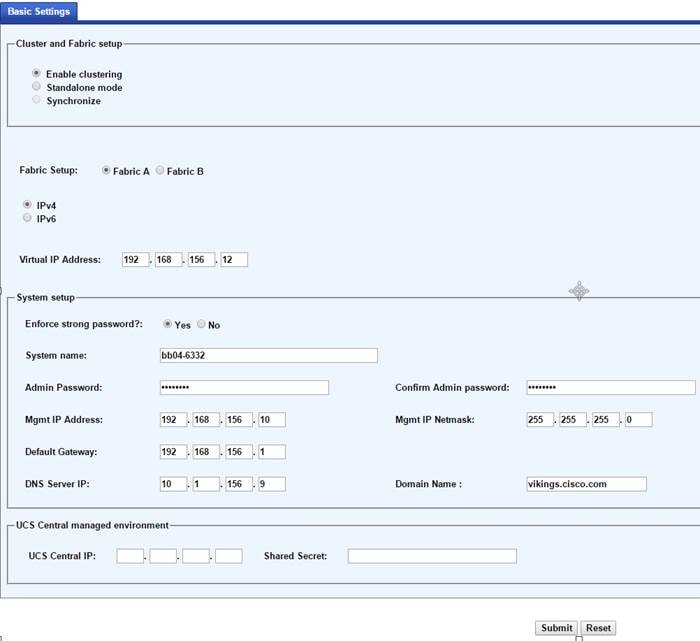
7. Click Submit.
Cisco UCS Fabric Interconnect B
To configure the Cisco UCS for use in a FlexPod environment, complete the following steps:
1. Connect to the console port on the second Cisco UCS fabric interconnect.
Enter the configuration method: gui
Physical switch Mgmt0 IP address: <ucsb-mgmt-ip>
Physical switch Mgmt0 IPv4 netmask: <ucsb-mgmt-mask>
IPv4 address of the default gateway: <ucsb-mgmt-gateway>
2. Using a supported web browser, connect to <ucsb-mgmt-ip>, accept the security prompts, and click the ‘Express Setup’ link under HTML.
3. Under System setup, enter the Admin Password entered above and click Submit.
4. Enter <ucsb-mgmt-ip> for the Mgmt IP Address and click Submit.
Cisco UCS Setup
Log in to Cisco UCS Manager
To log in to the Cisco Unified Computing System (UCS) environment, complete the following steps:
1. Open a web browser and navigate to the Cisco UCS fabric interconnect cluster address.
![]() You may need to wait at least 5 minutes after configuring the second fabric interconnect for UCS Manager to come up.
You may need to wait at least 5 minutes after configuring the second fabric interconnect for UCS Manager to come up.
2. Click the Launch UCS Manager link under HTML to launch Cisco UCS Manager.
3. If prompted to accept security certificates, accept as necessary.
4. When prompted, enter admin as the user name and enter the administrative password.
5. Click Login to log in to Cisco UCS Manager.
Upgrade Cisco UCS Manager Software to Version 3.1(3a)
This document assumes the use of Cisco UCS 3.1(3a). To upgrade the Cisco UCS Manager software and the Cisco UCS Fabric Interconnect software to version 3.1(3a), refer to Cisco UCS Manager Install and Upgrade Guides.
Anonymous Reporting
To create anonymous reporting, complete the following step:
1. In the Anonymous Reporting window, select whether to send anonymous data to Cisco for improving future products. If you select Yes, enter the IP address of your SMTP Server. Click OK.
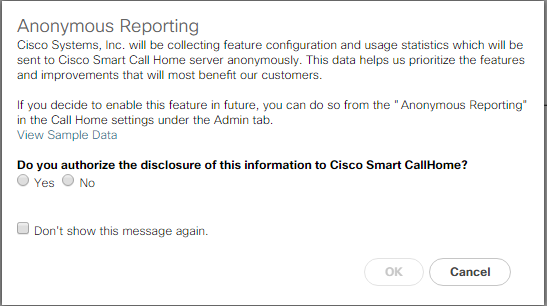
Configure Cisco UCS Call Home
It is highly recommended by Cisco to configure Call Home in UCSM. Configuring Call Home will accelerate resolution of support cases. To configure Call Home, complete the following steps:
1. In Cisco UCS Manager, click Admin on the left.
2. Select All > Communication Management > Call Home.
3. Change the State to On.
4. Fill in all the fields according to your Management preferences and click Save Changes and OK to complete configuring Call Home.
Configure Unified Ports
Fiber Channel port configurations differ slightly between the 6332-16UP and the 6248UP Fabric Interconnects. Both Fabric Interconnects have a slider mechanism within the UCSM GUI interface, but the fiber channel port selection options for the 6332-16UP are from the first 16 ports starting from the first port on the left, and configured in increments of the first 6, 12, or all 16 of the unified ports. With the 6248UP, the port selection options will start from the right of the 32 fixed ports, or the right of the 16 ports of the expansion module, going down in contiguous increments of 2.
To enable the fiber channel ports, complete the following steps for the 6332-16UP:
1. In Cisco UCS Manager, click Equipment on the left.
2. Select Equipment > Fabric Interconnects > Fabric Interconnect A (primary).
3. Select Configure Unified Ports.
4. Click Yes on the pop-up window warning that changes to the fixed module will require a reboot of the fabric interconnect and changes to the expansion module will require a reboot of that module.
5. Within the Configured Fixed Ports pop-up window move the gray slider bar from the left to the right to select either 6, 12, or 16 ports to be set as FC Uplinks.
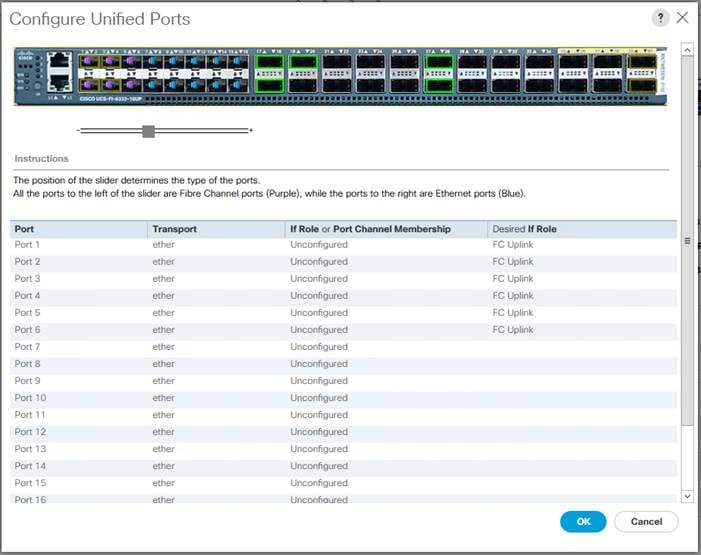
6. Click OK, then Yes, then OK to continue
7. Select Equipment > Fabric Interconnects > Fabric Interconnect B (primary)
8. Select Configure Unified Ports.
9. Click Yes on the pop-up window warning that changes to the fixed module will require a reboot of the fabric interconnect and changes to the expansion module will require a reboot of that module.
10. Within the Configured Fixed Ports pop-up window move the gray slider bar from the left to the right to select either 6, 12, or 16 ports to be set as FC Uplinks.
11. Click OK, then Yes, then OK to continue.
12. Wait for both the Fabric Interconnects to reboot.
13. Log back into UCS Manager.
![]() This process will be similar for the UCS 6248UP Fabric Interconnect, but will be in increments of two unified ports that can be converted to FC uplinks, and will slide from the right to the left instead of the left to the right process used with the UCS 6332-16UP Fabric Interconnects.
This process will be similar for the UCS 6248UP Fabric Interconnect, but will be in increments of two unified ports that can be converted to FC uplinks, and will slide from the right to the left instead of the left to the right process used with the UCS 6332-16UP Fabric Interconnects.
Add Block of IP Addresses for KVM Access
To create a block of IP addresses for in band server Keyboard, Video, Mouse (KVM) access in the Cisco UCS environment, complete the following steps:
1. In Cisco UCS Manager, click LAN on the left.
2. Expand Pools > root > IP Pools.
3. Right-click IP Pool ext-mgmt and select Create Block of IPv4 Addresses.
4. Enter the starting IP address of the block, number of IP addresses required, and the subnet mask and gateway information.
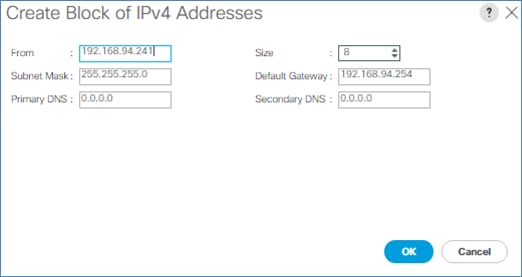
5. Click OK to create the block.
6. Click OK in the confirmation message.
Synchronize Cisco UCS to NTP
To synchronize the Cisco UCS environment to the NTP servers in the Nexus switches, complete the following steps:
1. In Cisco UCS Manager, click Admin on the left.
2. Expand All > Time Zone Management.
3. Select Timezone.
4. In the Properties pane, select the appropriate time zone in the Timezone menu.
5. Click Save Changes, and then click OK.
6. Click Add NTP Server.
7. Enter <switch-a-ntp-ip> and click OK. Click OK on the confirmation.
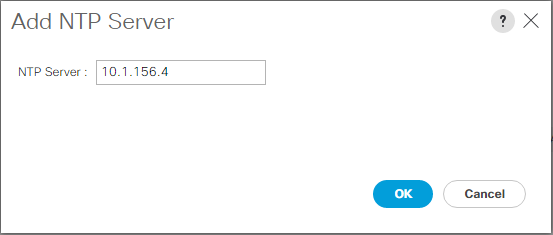
8. Click Add NTP Server.
9. Enter <switch-b-ntp-ip> and click OK. Click OK on the confirmation.
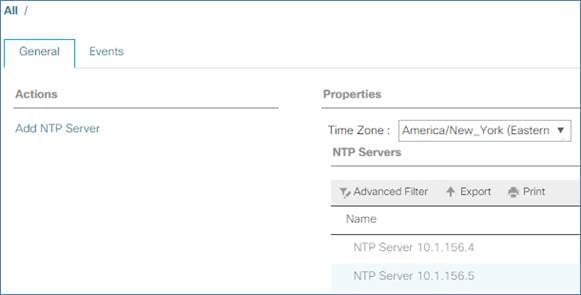
Edit Chassis Discovery Policy
Setting the discovery policy simplifies the addition of B-Series Cisco UCS chassis and of additional fabric extenders for further C-Series connectivity. To modify the chassis discovery policy, complete the following steps:
1. In Cisco UCS Manager, click Equipment on the left and select Equipment in the second list.
2. In the right pane, click the Policies tab.
3. Under Global Policies, set the Chassis/FEX Discovery Policy to match the minimum number of uplink ports that are cabled between the chassis or fabric extenders (FEXes) and the fabric interconnects.
4. Set the Link Grouping Preference to Port Channel. If Backplane Speed Preference appears, leave it set at 40G. If the environment being setup contains a large amount of multicast traffic, set the Multicast Hardware Hash setting to Enabled.

5. Click Save Changes.
6. Click OK.
Enable Server and Uplink Ports
To enable server and uplink ports, complete the following steps:
1. In Cisco UCS Manager, click Equipment on the left.
2. Expand Equipment > Fabric Interconnects > Fabric Interconnect A (primary) > Fixed Module.
3. Expand Ethernet Ports.
4. Select the ports that are connected to the chassis, Cisco FEX, and direct connect UCS C-Series servers, right-click them, and select “Configure as Server Port.”
5. Click Yes to confirm server ports and click OK.
6. Verify that the ports connected to the chassis, C-series servers and Cisco FEX are now configured as server ports.
7. Select the ports that are connected to the Cisco Nexus switches, right-click them, and select Configure as Uplink Port.
![]() The last 6 ports of the UCS 6332 and UCS 6332-16UP FIs will only work with optical based QSFP transceivers and AOC cables, so they can be better utilized as uplinks to upstream resources that might be optical only.
The last 6 ports of the UCS 6332 and UCS 6332-16UP FIs will only work with optical based QSFP transceivers and AOC cables, so they can be better utilized as uplinks to upstream resources that might be optical only.
8. Click Yes to confirm uplink ports and click OK.
9. Select Equipment > Fabric Interconnects > Fabric Interconnect B (subordinate) > Fixed Module.
10. Expand Ethernet Ports.
11. Select the ports that are connected to the chassis, C-series servers or to the Cisco 2232 FEX (two per FEX), right-click them, and select Configure as Server Port.
12. Click Yes to confirm server ports and click OK.
13. Select the ports that are connected to the Cisco Nexus switches, right-click them, and select Configure as Uplink Port.
14. Click Yes to confirm the uplink ports and click OK.
Acknowledge Cisco UCS Chassis and FEX
To acknowledge all Cisco UCS chassis and any external 2232 FEX modules, complete the following steps:
1. In Cisco UCS Manager, click Equipment on the left.
2. Expand Chassis and select each chassis that is listed.
3. Right-click each chassis and select Acknowledge Chassis.

4. Click Yes and then click OK to complete acknowledging the chassis.
5. If Nexus 2232 FEX are part of the configuration, expand Rack Mounts and FEX.
6. Right-click each FEX that is listed and select Acknowledge FEX.
7. Click Yes and then click OK to complete acknowledging the FEX.
Create Uplink Port Channels to Cisco Nexus Switches
To configure the necessary port channels out of the Cisco UCS environment, complete the following steps:
1. In Cisco UCS Manager, click LAN on the left.
![]() In this procedure, two port channels are created: one from fabric A to both Cisco Nexus switches and one from fabric B to both Cisco Nexus switches.
In this procedure, two port channels are created: one from fabric A to both Cisco Nexus switches and one from fabric B to both Cisco Nexus switches.
2. Under LAN > LAN Cloud, expand the Fabric A tree.
3. Right-click Port Channels.
4. Select Create Port Channel.
5. Enter 125 as the unique ID of the port channel.
6. Enter vPC-125-Nexus as the name of the port channel.
7. Click Next.
8. Select the ports connected to the Nexus switches to be added to the port channel:
9. Click >> to add the ports to the port channel.
10. Click Finish to create the port channel.
11. Click OK.
12. In the navigation pane, under LAN > LAN Cloud, expand the fabric B tree.
13. Right-click Port Channels.
14. Select Create Port Channel.
15. Enter 126 as the unique ID of the port channel.
16. Enter vPC-126-Nexus as the name of the port channel.
17. Click Next.
18. Select the ports connected to the Nexus switches to be added to the port channel:
19. Click >> to add the ports to the port channel.
20. Click Finish to create the port channel.
21. Click OK.
Create a WWNN Pool for FC Boot
To configure the necessary WWNN pool for the Cisco UCS environment, complete the following steps on Cisco UCS Manager.
1. Select SAN on the left.
2. Select Pools > root.
3. Right-click WWNN Pools under the root organization.
4. Select Create WWNN Pool to create the WWNN pool.
5. Enter WWNN-POOL for the name of the WWNN pool.
6. Optional: Enter a description for the WWNN pool.
7. Select Sequential for Assignment Order.
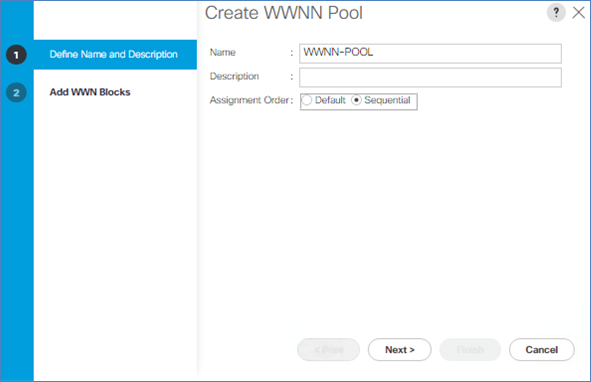
8. Click Next.
9. Click Add.
10. Modify the From field as necessary for the UCS Environment
![]() Modifications of the WWNN block, as well as the WWPN and MAC Addresses, can convey identifying information for the UCS domain. Within the From field in our example, the 6th octet was changed from 00 to 52 to represent as identifying information for this being in the UCS 6332 in the 4th cabinet.
Modifications of the WWNN block, as well as the WWPN and MAC Addresses, can convey identifying information for the UCS domain. Within the From field in our example, the 6th octet was changed from 00 to 52 to represent as identifying information for this being in the UCS 6332 in the 4th cabinet.
![]() Also, when having multiple UCS domains sitting in adjacency, it is important that these blocks, the WWNN, WWPN, and MAC hold differing values between each set.
Also, when having multiple UCS domains sitting in adjacency, it is important that these blocks, the WWNN, WWPN, and MAC hold differing values between each set.
11. Specify a size of the WWNN block sufficient to support the available server resources.
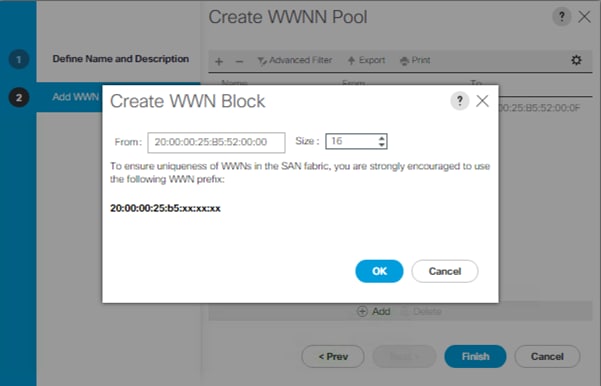
12. Click OK.
13. Click Finish and OK to complete creating the WWNN pool.
Create WWPN Pools
To configure the necessary WWPN pools for the Cisco UCS environment, complete the following steps:
1. In Cisco UCS Manager, click SAN on the left.
2. Select Pools > root.
3. In this procedure, two WWPN pools are created, one for each switching fabric.
4. Right-click WWPN Pools under the root organization.
5. Select Create WWPN Pool to create the WWPN pool.
6. Enter WWPN-POOL-A as the name of the WWPN pool.
7. Optional: Enter a description for the WWPN pool.
8. Select Sequential for Assignment Order
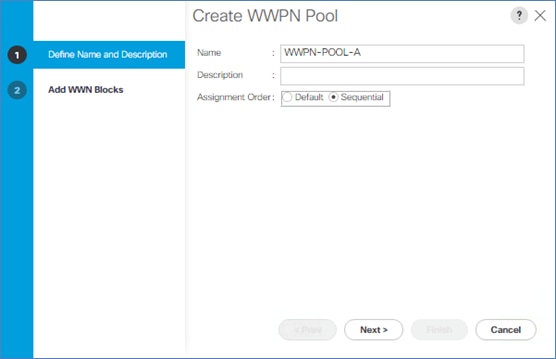
9. Click Next.
10. Click Add.
11. Specify a starting WWPN
![]() For the FlexPod solution, the recommendation is to place 0A in the next-to-last octet of the starting WWPN to identify all of the WWPNs as fabric A addresses. Merging this with the pattern we used for the WWNN we see a WWPN block starting with 20:00:00:25:B5:52:0A:00
For the FlexPod solution, the recommendation is to place 0A in the next-to-last octet of the starting WWPN to identify all of the WWPNs as fabric A addresses. Merging this with the pattern we used for the WWNN we see a WWPN block starting with 20:00:00:25:B5:52:0A:00
12. Specify a size for the WWPN pool that is sufficient to support the available blade or server resources. 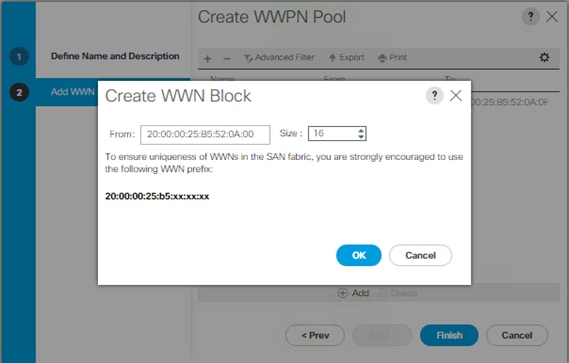
13. Click OK.
14. Click Finish.
15. In the confirmation message, click OK.
16. Right-click WWPN Pools under the root organization.
17. Select Create WWPN Pool to create the WWPN pool.
18. Enter WWPN-POOL-B as the name of the WWPN pool.
19. Optional: Enter a description for the WWPN pool.
20. Select Sequential for Assignment Order.
21. Click Next.
22. Click Add.
23. Specify a starting WWPN.
![]() For the FlexPod solution, the recommendation is to place 0B in the next-to-last octet of the starting WWPN to identify all of the WWPNs as fabric A addresses. Merging this with the pattern we used for the WWNN we see a WWPN block starting with 20:00:00:25:B5:52:0B:00.
For the FlexPod solution, the recommendation is to place 0B in the next-to-last octet of the starting WWPN to identify all of the WWPNs as fabric A addresses. Merging this with the pattern we used for the WWNN we see a WWPN block starting with 20:00:00:25:B5:52:0B:00.
24. Specify a size for the WWPN address pool that is sufficient to support the available blade or server resources.
25. Click OK.
26. Click Finish.
27. In the confirmation message, click OK
Create VSAN
1. To configure the necessary virtual storage area networks (VSANs) for the Cisco UCS environment, complete the following steps:
2. In Cisco UCS Manager, click the SAN on the left.
![]() In this procedure, two VSANs are created.
In this procedure, two VSANs are created.
3. Select SAN > SAN Cloud.
4. Right-click VSANs.
5. Select Create VSAN.
6. Enter VSAN-A as the name of the VSAN to be used for Fabric A
7. Leave FC Zoning set at Disabled.
8. Select Fabric A.
9. Enter a unique VSAN ID and a corresponding FCoE VLAN ID that matches the configuration in the MDS switch for Fabric A. It is recommended to use the same ID for both parameters and to use something other than 1.

10. Click OK and then click OK again.
11. Under SAN Cloud, right-click VSANs.
12. Select Create VSAN.
13. Enter VSAN-B as the name of the VSAN to be used for Fabric B.
14. Leave FC Zoning set at Disabled.
15. Select Fabric B.
16. Enter a unique VSAN ID and a corresponding FCoE VLAN ID that matches the configuration in the MDS switch for Fabric B. It is recommended use the same ID for both parameters and to use something other than 1.

17. Click OK, and then click OK again
Create FC Uplink Port Channels
To create the FC Uplink Port Channels and assign the appropriate VSANs to them for the Cisco UCS environment, complete the following steps:
1. In Cisco UCS Manager, click SAN on the left.
2. Select SAN > SAN Cloud.
3. Expand Fabric A and select FC Port Channels.
4. Right-click FC Port Channels and select Create FC Port Channel.
5. Set a unique ID for the port channel and provide a unique name for the port channel.
6. Click Next.
7. Select the ports connected to Cisco MDS A and use >> to add them to the port channel

8. Click Finish to complete creating the port channel.
9. Click OK the confirmation.
10. Under FC Port-Channels, select the newly created port channel.
11. In the right pane, use the pulldown to select VSAN-A
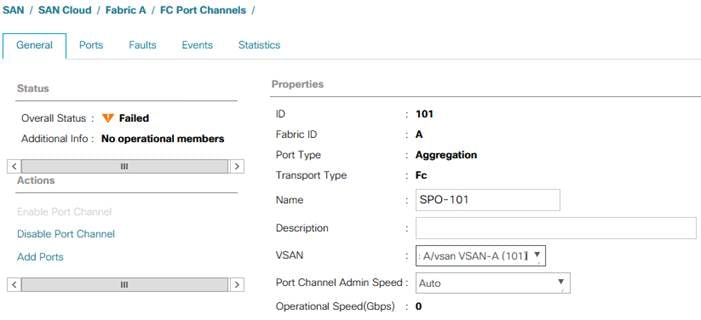
12. Click Save Changes to assign the VSAN.
13. Click OK.
14. Expand Fabric B and select FC Port Channels.
15. Right-click FC Port Channels and select Create FC Port Channel.
16. Set a unique ID for the port channel and provide a unique name for the port channel.
17. Click Next.
18. Select the ports connected to Cisco MDS B and use >> to add them to the port channel.
19. Click Finish to complete creating the port channel.
20. Click OK on the confirmation.
21. Under FC Port-Channels, select the newly created port channel.
22. In the right pane, use the pulldown to select VSAN-B.
23. Click Save Changes to assign the VSAN.
24. Click OK.
Create vHBA Templates
To create the necessary virtual host bus adapter (vHBA) templates for the Cisco UCS environment, complete the following steps:
1. In Cisco UCS Manager, click SAN on the left.
2. Select Policies > root.
3. Right-click vHBA Templates.
4. Select Create vHBA Template.
5. Enter vHBA-Template-A as the vHBA template name.
6. Keep Fabric A selected.
7. Leave Redundancy Type set to No Redundancy.
8. Select VSAN-A.
9. Leave Initial Template as the Template Type.
10. Select WWPN-POOL-A as the WWPN Pool.
11. Click OK to create the vHBA template.
12. Click OK
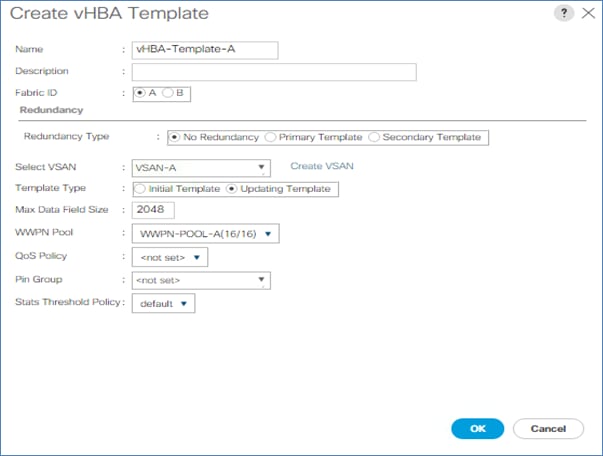
13. Right-click vHBA Templates.
14. Select Create vHBA Template.
15. Enter vHBA-Template-B as the vHBA template name.
16. Leave Redundancy Type set to No Redundancy.
17. Select Fabric B as the Fabric ID.
18. Select VSAN-B.
19. Leave Initial Template as the Template Type.
20. Select WWPN-POOl-B as the WWPN Pool.
21. Click OK to create the vHBA template.
22. Click OK.
Create SAN Connectivity Policy
To configure the necessary Infrastructure SAN Connectivity Policy, complete the following steps:
1. In Cisco UCS Manager, click SAN on the left.
2. Select SAN > Policies > root.
3. Right-click SAN Connectivity Policies.
4. Select Create SAN Connectivity Policy.
5. Enter FC-BOOT as the name of the policy.
6. Select the previously created WWNN-POOl for the WWNN Assignment.
7. Click the Add button at the bottom to add a vHBA.
8. In the Create vHBA dialog box, enter FABRIC-A as the name of the vHBA.
9. Select the Use vHBA Template checkbox.
10. In the vHBA Template list, select vHBA-Template-A.
11. In the Adapter Policy list, select WindowsBoot
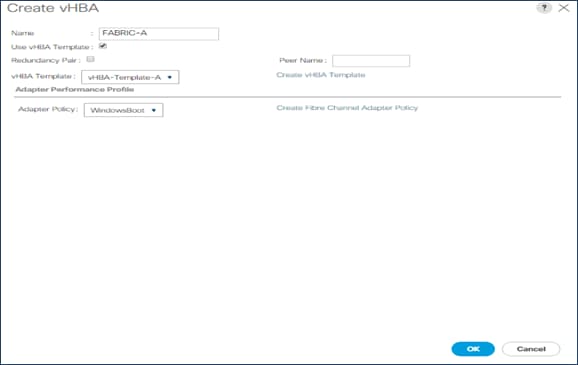
12. Click OK.
13. Click the Add button at the bottom to add a second vHBA.
14. In the Create vHBA dialog box, enter FABRIC-B as the name of the vHBA.
15. Select the Use vHBA Template checkbox.
16. In the vHBA Template list, select vHBA-Template-B.
17. In the Adapter Policy list, select WindowsBoot.
18. Click OK
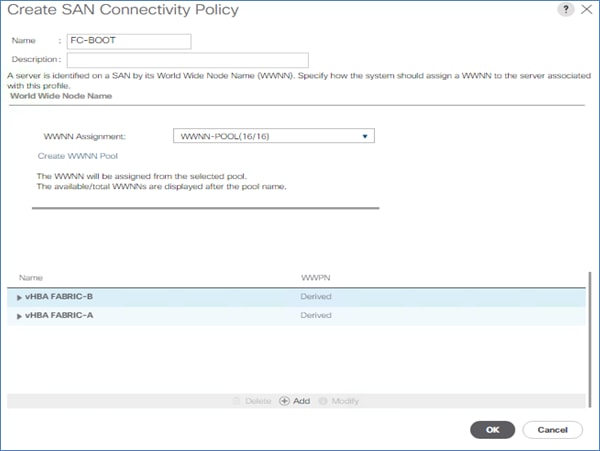
19. Click OK to create the SAN Connectivity Policy.
20. Click OK to confirm creation.
Create MAC Address Pools
To configure the necessary MAC address pools for the Cisco UCS environment, complete the following steps:
1. In Cisco UCS Manager, click LAN on the left.
2. Select Pools > root.
![]() In this procedure, two MAC address pools are created, one for each switching fabric.
In this procedure, two MAC address pools are created, one for each switching fabric.
3. Right-click MAC Pools under the root organization.
4. Select Create MAC Pool to create the MAC address pool.
5. Enter MAC-POOl-A as the name of the MAC pool.
6. Optional: Enter a description for the MAC pool.
7. Select Sequential as the option for Assignment Order.
8. Click Next.
9. Click Add.
10. Specify a starting MAC address.
![]() For the FlexPod solution, the recommendation is to place 0A in the next-to-last octet of the starting MAC address to identify all of the MAC addresses as fabric A addresses. In our example, we have carried forward the of also embedding the UCS domain number information giving us 00:25:B5:52:0A:00 as our first MAC address.
For the FlexPod solution, the recommendation is to place 0A in the next-to-last octet of the starting MAC address to identify all of the MAC addresses as fabric A addresses. In our example, we have carried forward the of also embedding the UCS domain number information giving us 00:25:B5:52:0A:00 as our first MAC address.
11. Specify a size for the MAC address pool that is sufficient to support the available blade or server resources.
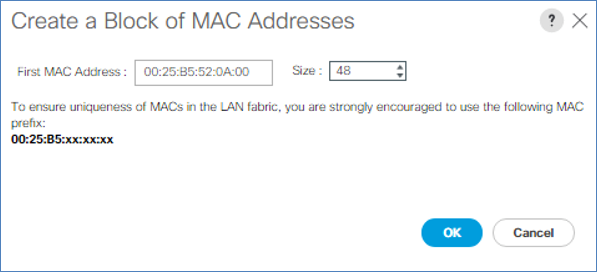
12. Click OK.
13. Click Finish.
14. In the confirmation message, click OK.
15. Right-click MAC Pools under the root organization.
16. Select Create MAC Pool to create the MAC address pool.
17. Enter MAC-POOL-B as the name of the MAC pool.
18. Optional: Enter a description for the MAC pool.
19. Select Sequential as the option for Assignment Order.
20. Click Next.
21. Click Add.
22. Specify a starting MAC address.
![]() For the FlexPod solution, it is recommended to place 0B in the next to last octet of the starting MAC address to identify all the MAC addresses in this pool as fabric B addresses. Once again, we have carried forward in our example of also embedding the UCS domain number information giving us 00:25:B5:52:0B:00 as our first MAC address.
For the FlexPod solution, it is recommended to place 0B in the next to last octet of the starting MAC address to identify all the MAC addresses in this pool as fabric B addresses. Once again, we have carried forward in our example of also embedding the UCS domain number information giving us 00:25:B5:52:0B:00 as our first MAC address.
23. Specify a size for the MAC address pool that is sufficient to support the available blade or server resources.
24. Click OK.
25. Click Finish.
26. In the confirmation message, click OK.
Create UUID Suffix Pool
To configure the necessary universally unique identifier (UUID) suffix pool for the Cisco UCS environment, complete the following steps:
1. In Cisco UCS Manager, click Servers on the left.
2. Select Pools > root.
3. Right-click UUID Suffix Pools.
4. Select Create UUID Suffix Pool.
5. Enter UUID-POOl as the name of the UUID suffix pool.
6. Optional: Enter a description for the UUID suffix pool.
7. Keep the prefix at the derived option.
8. Select Sequential for the Assignment Order.
9. Click Next.
10. Click Add to add a block of UUIDs.
11. Keep the From field at the default setting.
12. Specify a size for the UUID block that is sufficient to support the available blade or server resources.
13. Click OK.
14. Click Finish.
15. Click OK.
Create Server Pool
To configure the necessary server pool for the Cisco UCS environment, complete the following steps:
![]() Consider creating unique server pools to achieve the granularity that is required in your environment.
Consider creating unique server pools to achieve the granularity that is required in your environment.
1. In Cisco UCS Manager, click Servers on the left.
2. Select Pools > root.
3. Right-click Server Pools.
4. Select Create Server Pool.
5. Enter MS-Server-Pool as the name of the server pool.
6. Optional: Enter a description for the server pool.
7. Click Next.
8. Select two (or more) servers to be used for the Hyper-V management cluster and click >> to add them to the MS-Server-Pool server pool.
9. Click Finish.
10. Click OK.
Create VLANs
To configure the necessary virtual local area networks (VLANs) for the Cisco UCS environment, complete the following steps:
1. In Cisco UCS Manager, click LAN on the left.
![]() In this procedure, five unique VLANs are created. See Table 1.
In this procedure, five unique VLANs are created. See Table 1.
2. Select LAN > LAN Cloud.
3. Right-click VLANs.
4. Select Create VLANs.
5. Enter Native-VLAN as the name of the VLAN to be used as the native VLAN.
6. Keep the Common/Global option selected for the scope of the VLAN.
7. Enter the native VLAN ID.
8. Keep the Sharing Type as None.
9. Click OK, and then click OK again.
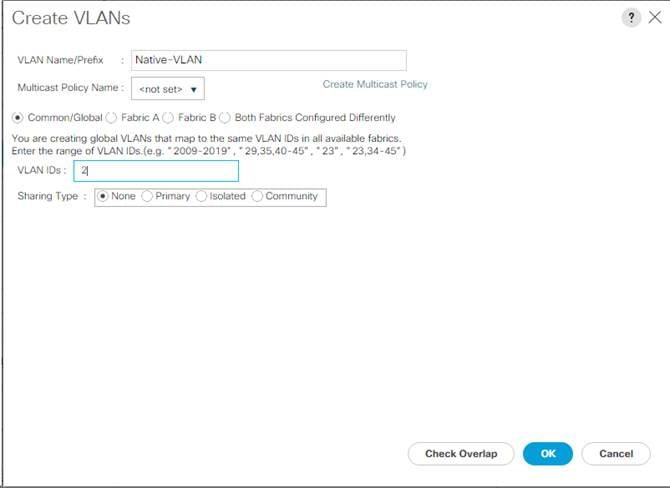
10. Expand the list of VLANs in the navigation pane, right-click the newly created Native-VLAN and select Set as Native VLAN.
11. Click Yes, and then click OK.
12. Right-click VLANs.
13. Select Create VLANs
14. Enter MS-IB-MGMT as the name of the VLAN to be used for management traffic.
15. Keep the Common/Global option selected for the scope of the VLAN.
16. Enter the In-Band management VLAN ID.
17. Keep the Sharing Type as None.
18. Click OK, and then click OK again.
19. Right-click VLANs.
20. Select Create VLANs.
21. Enter MS-SMB-1 as the name of the VLAN to be used for SMB File share.
22. Keep the Common/Global option selected for the scope of the VLAN.
23. Enter the SMB File Share VLAN ID.
24. Keep the Sharing Type as None.
25. Click OK, and then click OK again.
26. Right-click VLANs.
27. Select Create VLANs.
28. Enter MS-SMB-2 as the name of the VLAN to be used for 2nd SMB File share.
29. Keep the Common/Global option selected for the scope of the VLAN.
30. Enter the Infrastructure SMB File Share VLAN ID.
31. Keep the Sharing Type as None.
32. Click OK, and then click OK again
33. Right-click VLANs.
34. Select Create VLANs.
35. Enter MS-LVMN as the name of the VLAN to be used for Live Migration.
36. Keep the Common/Global option selected for the scope of the VLAN.
37. Enter the Live Migration VLAN ID.
38. Keep the Sharing Type as None.
39. Click OK, and then click OK again.
40. Select Create VLANs.
41. Enter MS-Cluster as the name of the VLAN to be used for Cluster communication network.
42. Keep the Common/Global option selected for the scope of the VLAN.
43. Enter the Cluster network VLAN ID.
44. Keep the Sharing Type as None.
45. Click OK, and then click OK again.
46. Select Create VLANs.
47. Enter MS-Tenant-VM as the name of the VLAN to be used for VM Traffic.
48. Keep the Common/Global option selected for the scope of the VLAN.
49. Enter the VM-Traffic VLAN ID.
50. Keep the Sharing Type as None.
51. Click OK, and then click OK again.

Modify Default Host Firmware Package
Firmware management policies allow the administrator to select the corresponding packages for a given server configuration. These policies often include packages for adapter, BIOS, board controller, FC adapters, host bus adapter (HBA) option ROM, and storage controller properties.
To create a firmware management policy for a given server configuration in the Cisco UCS environment, complete the following steps:
1. In Cisco UCS Manager, click Servers on the left.
2. Select Policies > root.
3. Expand Host Firmware Packages.
4. Select default.
5. In the Actions pane, select Modify Package Versions.
6. Select the version 3.1(2f) for both the Blade and Rack Packages.
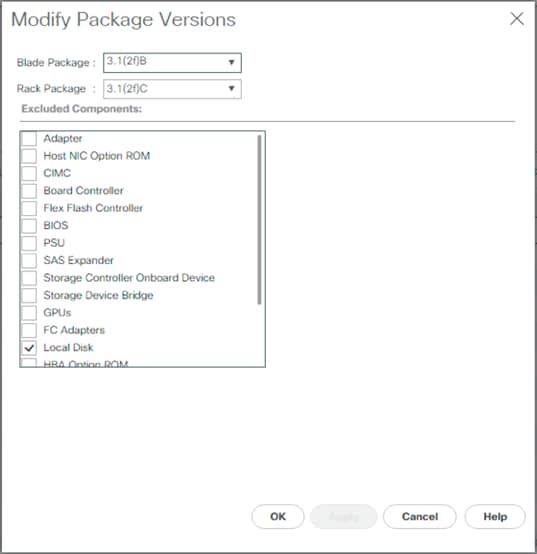
7. Click OK then OK again to modify the host firmware package.
Set Jumbo Frames in Cisco UCS Fabric
To configure jumbo frames and enable quality of service in the Cisco UCS fabric, complete the following steps:
1. In Cisco UCS Manager, click LAN on the left.
2. Select LAN > LAN Cloud > QoS System Class.
3. In the right pane, click the General tab.
4. On the Best Effort row, enter 9216 in the box under the MTU column.
5. Click Save Changes in the bottom of the window.
6. Click OK

Create Local Disk Configuration Policy (Optional)
A local disk configuration for the Cisco UCS environment is necessary if the servers in the environment do not have a local disk.
![]() This policy should not be used on servers that contain local disks.
This policy should not be used on servers that contain local disks.
To create a local disk configuration policy, complete the following steps:
1. In Cisco UCS Manager, click Servers on the left.
2. Select Policies > root.
3. Right-click Local Disk Config Policies.
4. Select Create Local Disk Configuration Policy.
5. Enter SAN-Boot as the local disk configuration policy name.
6. Change the mode to No Local Storage.
7. Click OK to create the local disk configuration policy.
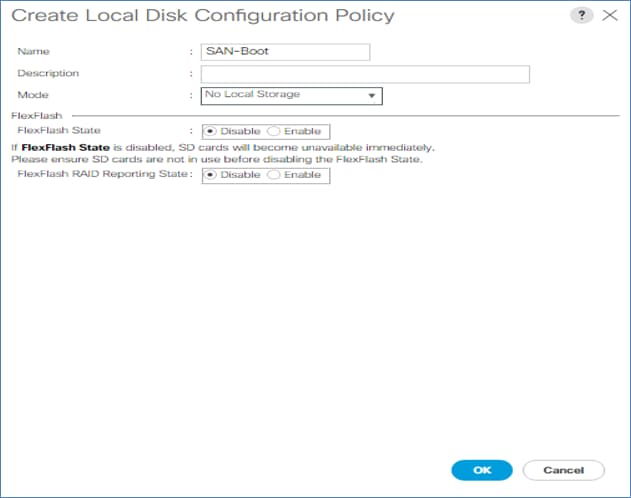
8. Click OK.
Create Network Control Policy for Cisco Discovery Protocol (CDP) and Link Layer Discovery Protocol (LLDP)
To create a network control policy that enables CDP and LLDP on virtual network ports, complete the following steps:
1. In Cisco UCS Manager, click LAN on the left.
2. Select Policies > root.
3. Right-click Network Control Policies.
4. Select Create Network Control Policy.
5. Enter Enable-CDP-LLDP as the policy name.
6. For CDP, select the Enabled option.
7. For LLDP, scroll down and select Enabled for both Transmit and Receive.
8. Click OK to create the network control policy.
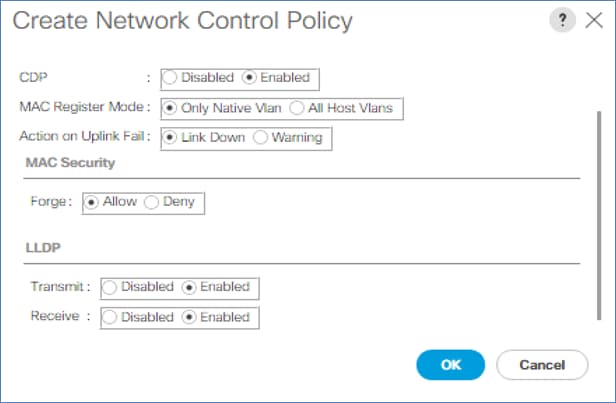
9. Click OK.
Create Power Control Policy
To create a power control policy for the Cisco UCS environment, complete the following steps:
1. In Cisco UCS Manager, click Servers tab on the left.
2. Select Policies > root.
3. Right-click Power Control Policies.
4. Select Create Power Control Policy.
5. Enter No-Power-Cap as the power control policy name.
6. Change the power capping setting to No Cap.
7. Click OK to create the power control policy.
8. Click OK.
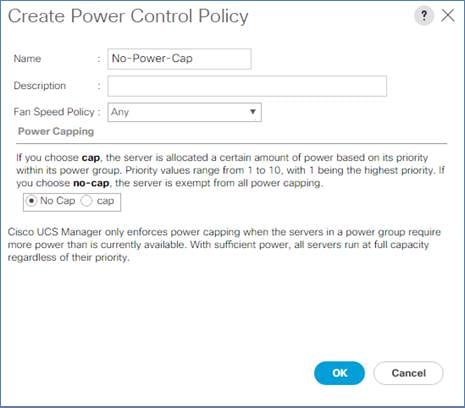
Create Server Pool Qualification Policy (Optional)
To create an optional server pool qualification policy for the Cisco UCS environment, complete the following steps:
![]() This example creates a policy for Cisco UCS B-Series and Cisco UCS C-Series servers with the Intel E2660 v4 Xeon Broadwell processors.
This example creates a policy for Cisco UCS B-Series and Cisco UCS C-Series servers with the Intel E2660 v4 Xeon Broadwell processors.
1. In Cisco UCS Manager, click Servers on the left.
2. Select Policies > root.
3. Right-click Server Pool Policy Qualifications.
4. Select Create Server Pool Policy Qualification.
5. Name the policy UCS-Broadwell.
6. Select Create CPU/Cores Qualifications.
7. Select Xeon for the Processor/Architecture.
8. Enter UCS-CPU-E52660E as the PID.
9. Click OK to create the CPU/Core qualification.
10. Click OK to create the policy then OK for the confirmation.
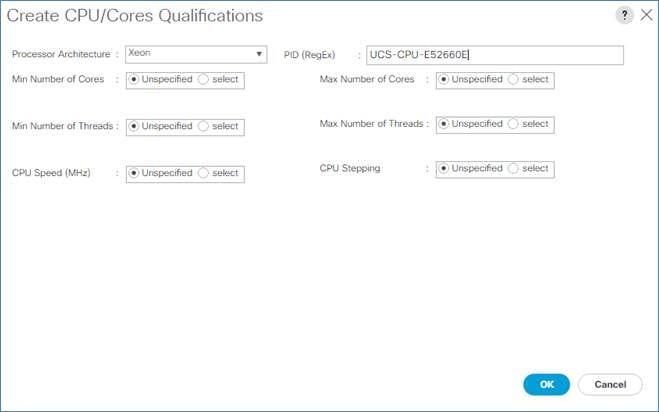
Create Server BIOS Policy
To create a server BIOS policy for the Cisco UCS environment, complete the following steps:
1. In Cisco UCS Manager, click Servers on the left.
2. Select Policies > root.
3. Right-click BIOS Policies.
4. Select Create BIOS Policy.
5. Enter MS-Host as the BIOS policy name.
6. Change the Quiet Boot setting to disabled.
7. Change Consistent Device Naming to enabled.

8. Click on the Processor tab on the left.
9. Set the following within the Processor tab
10. Processor C State -> disabled
11. Processor C1E -> disabled
12. Processor C3 Report -> disabled
13. Processor C7 Report -> disabled
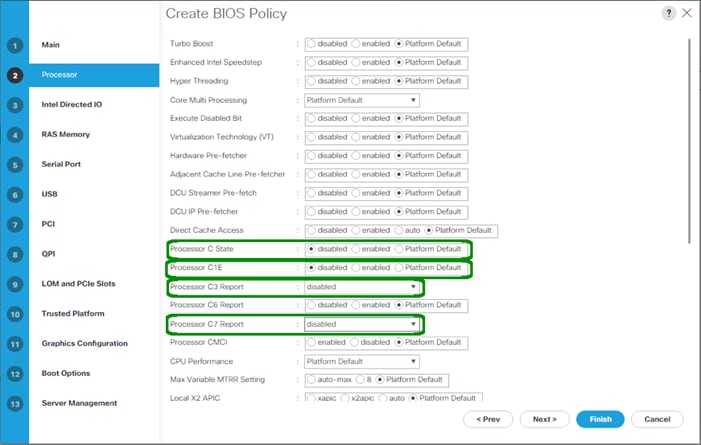
14. Scroll down to the remaining Processor options, and select:
15. Energy Performance -> performance
16. Frequency Floor Override -> enabled
17. DRAM Clock Throttling -> performance
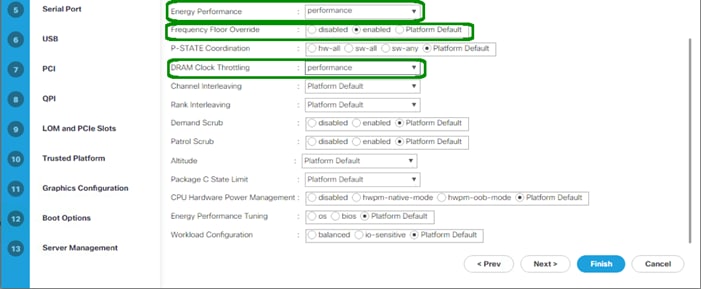
18. Click on the RAS Memory option, and select:
19. LV DDR Mode -> performance-mode
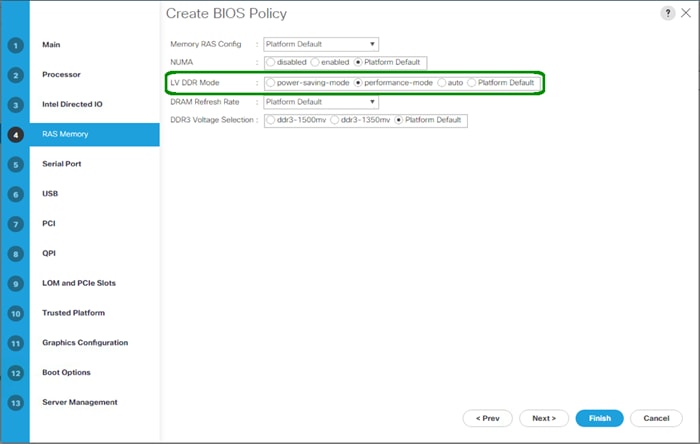
20. Click Finish to create the BIOS policy.
21. Click OK.
Update the Default Maintenance Policy
To update the default Maintenance Policy, complete the following steps:
1. In Cisco UCS Manager, click Servers on the left.
2. Select Policies > root.
3. Select Maintenance Policies > default.
4. Change the Reboot Policy to User Ack.
5. Select “On Next Boot” to delegate maintenance windows to server administrators.

6. Click Save Changes.
7. Click OK to accept the change.
Create vNIC Templates
To create multiple virtual network interface card (vNIC) templates for the Cisco UCS environment, complete the following steps. A total of 2 vNIC Templates will be created.
Create Infrastructure vNICs
1. In Cisco UCS Manager, click LAN on the left.
2. Select Policies > root.
3. Right-click vNIC Templates.
4. Select Create vNIC Template.
5. Enter Host-A as the vNIC template name.
6. Keep Fabric A selected.
7. Do not select the Enable Failover checkbox.
8. Select Primary Template for Redundancy Type.
9. Leave the Peer Redundancy Template set to <not set>.
10. Under Target, make sure that only the Adapter checkbox is selected.
11. Select Updating Template as the Template Type.
12. Under VLANs, select the checkboxes for MS-IB-MGMT, MS-Cluster, MS-CSV, MS-SMB1, MS-SMB2, and MS-Tenant-VM VLANs.
13. Set Native-VLAN as the native VLAN.
14. Select vNIC Name for the CDN Source.
15. For MTU, enter 9000.
16. In the MAC Pool list, select MAC-POOL-A.
17. In the Network Control Policy list, select Enable-CDP-LLDP.
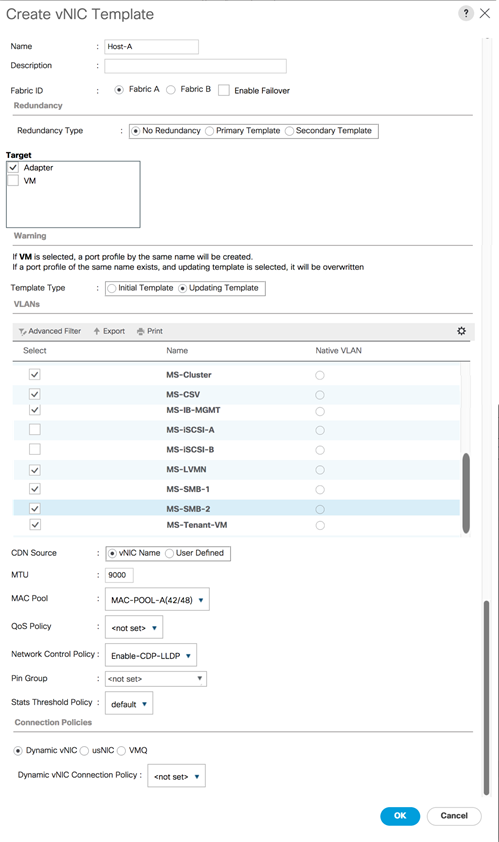
18. Click OK to create the vNIC template.
19. Click OK.
Create the secondary redundancy template Infra-B:
1. Select LAN on the left.
2. Select Policies > root.
3. Right-click vNIC Templates.
4. Select Create vNIC Template
5. Enter Host-B as the vNIC template name.
6. Select Fabric B.
7. Do not elect the Enable Failover checkbox.
8. Set Redundancy Type to Secondary Template.
9. Select Infra-A for the Peer Redundancy Template.
10. In the MAC Pool list, select MAC-POOL-B. The MAC Pool is all that needs to be selected for the Secondary Template.
11. Click OK to create the vNIC template.
12. Click OK.
Create LAN Connectivity Policy for FC Boot
To configure the necessary Infrastructure LAN Connectivity Policy, complete the following steps:
1. In Cisco UCS Manager, click LAN on the left.
2. Select LAN > Policies > root.
3. Right-click LAN Connectivity Policies.
4. Select Create LAN Connectivity Policy.
5. Enter FC-Boot as the name of the policy.
6. Click the upper Add button to add a vNIC.
7. In the Create vNIC dialog box, enter 00-Host-A as the name of the vNIC.
8. Select the Use vNIC Template checkbox.
9. In the vNIC Template list, select Host-A.
10. In the Adapter Policy list, select Windows.
11. Click OK to add this vNIC to the policy.
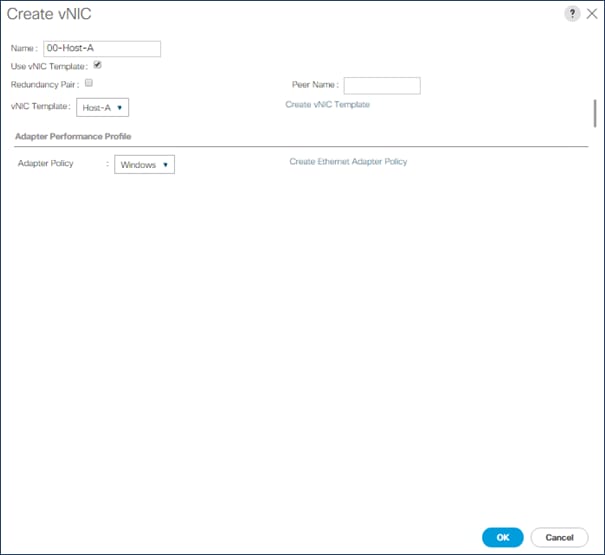
12. Click the upper Add button to add another vNIC to the policy.
13. In the Create vNIC box, enter 01-Host-B as the name of the vNIC.
14. Select the Use vNIC Template checkbox.
15. In the vNIC Template list, select Host-B.
16. In the Adapter Policy list, select Windows.
17. Click OK to add the vNIC to the policy.
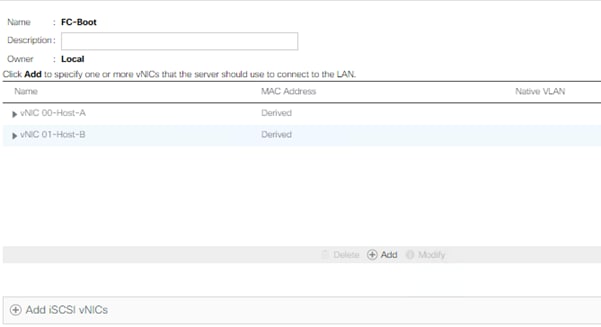
18. Click OK, then OK again to create the LAN Connectivity Policy.
Create FC Boot Policy
This procedure applies to a Cisco UCS environment in which two Fibre Channel logical interfaces (LIFs) are on cluster node 1 (fcp_lif01a and fcp_lif01b) and two Fibre Channel LIFs are on cluster node 2 (fcp_lif02a andfcp_lif02b). Also, it is assumed that the A LIFs are connected to Fabric A (Cisco UCS Fabric Interconnect A) and the B LIFs are connected to Fabric B (Cisco UCS Fabric Interconnect B).
One boot policy is configured in this procedure. The policy configures the primary target to be fcp_lif01a.
To create a boot policy for the Cisco UCS environment, complete the following steps:
1. In Cisco UCS Manager, click Servers on the left.
2. Select Policies > root.
3. Right-click Boot Policies.
4. Select Create Boot Policy.
5. Enter FC-Boot as the name of the boot policy.
6. Optional: Enter a description for the boot policy.
![]() Do not select the Reboot on Boot Order Change checkbox.
Do not select the Reboot on Boot Order Change checkbox.
7. Keep the Reboot on Boot Order Change option cleared.
8. Expand the Local Devices drop-down menu and select Local CD/DVD.
9. Expand the vHBAs drop-down menu and select Add SAN Boot.
10. Select the Primary for type field.
11. Enter FABRIC-A in vHBA field.
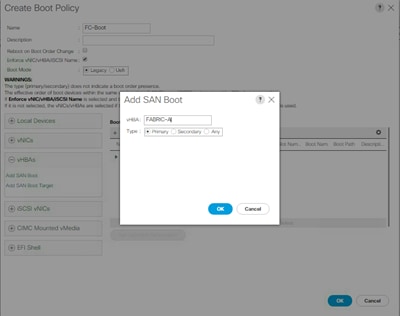
12. Click OK.
13. From the vHBA drop-down menu, select Add SAN Boot Target.
14. Keep 0 as the value for Boot Target LUN.
15. Enter the WWPN for fcp_lif01a
![]() To obtain this information, log in to the storage cluster and run the network interface show command
To obtain this information, log in to the storage cluster and run the network interface show command
16. Select Primary for the SAN boot target type.
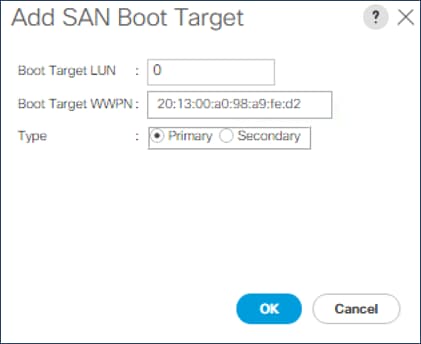
17. Click OK to add the SAN boot target.
18. From the vHBA drop-down menu, select Add SAN Boot Target.
19. Enter 0 as the value for Boot Target LUN.
20. Enter the WWPN for fcp_lif02a.
21. Click OK to add the SAN boot target.
22. From the vHBA drop-down menu, select Add SAN Boot.
23. In the Add SAN Boot dialog box, enter FABRIC-B in the vHBA box.
24. The SAN boot type should automatically be set to Secondary.
25. Click OK to add the SAN boot.
26. From the vHBA drop-down menu, select Add SAN Boot Target.
27. Keep 0 as the value for Boot Target LUN.
28. Enter the WWPN for fcp_lif01b.
29. Select Primary for the SAN boot target type.
30. Click OK to add the SAN boot target.
31. From the vHBA drop-down menu, select Add SAN Boot Target.
32. Keep 0 as the value for Boot Target LUN.
33. Enter the WWPN for fcp_lif02b.
34. Click OK to add the SAN boot target. Click OK, then click OK again to create the boot policy.
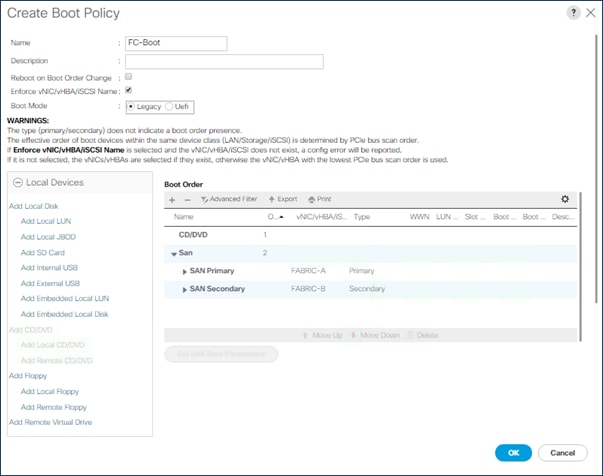
Create Service Profile Templates
In this procedure, one service profile template for Infrastructure Hyper-V hosts is created for Fabric A boot.
To create the service profile template, complete the following steps:
1. In Cisco UCS Manager, click Servers on the left.
2. Select Service Profile Templates > root.
3. Right-click root.
4. Select Create Service Profile Template to open the Create Service Profile Template wizard.
5. Enter Hyper-V-Host-FC as the name of the service profile template. This service profile template is configured to boot from storage node 1 on fabric A.
6. Select the “Updating Template” option.
7. Under UUID, select UUID_Pool as the UUID pool.
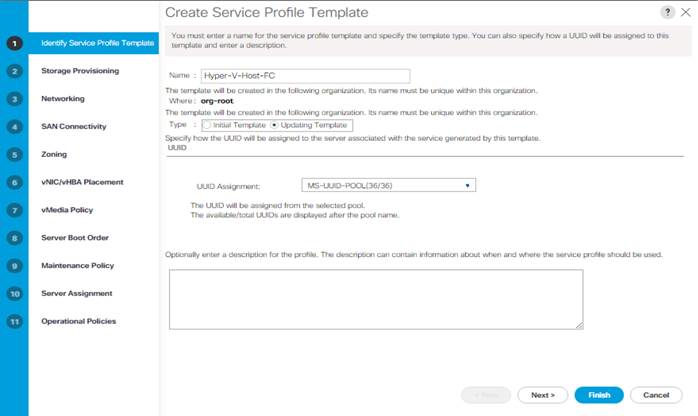
8. Click Next.
Configure Storage Provisioning
1. If you have servers with no physical disks, click on the Local Disk Configuration Policy and select the SAN-Boot Local Storage Policy. Otherwise, select the default Local Storage Policy.
2. Click Next.
Configure Networking Options
1. Keep the default setting for Dynamic vNIC Connection Policy.
2. Select the “Use Connectivity Policy” option to configure the LAN connectivity.
3. Select FC-Boot from the LAN Connectivity Policy pull-down.
4. Leave Initiator Name Assignment at <not set>.

5. Click Next.
Configure Storage Options
1. Select the Use Connectivity Policy option for the “How would you like to configure SAN connectivity?” field.
2. Select the FC-BOOT option from the SAN Connectivity Policy pull-down.
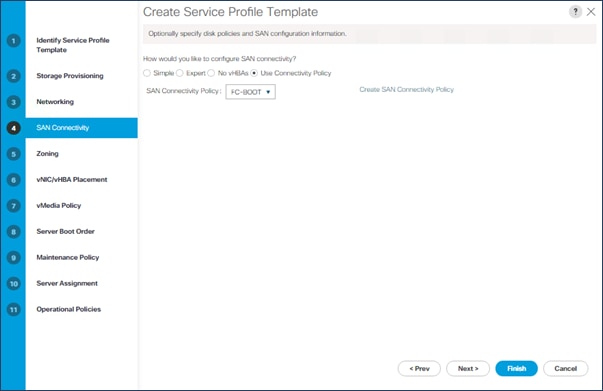
3. Click Next.
Configure Zoning Options
1. Click Next.
Configure vNIC/HBA Placement
1. In the “Select Placement” list, leave the placement policy as “Let System Perform Placement”.
2. Click Next.
Configure vMedia Policy
1. Do not select a vMedia Policy.
2. Click Next.
Configure Server Boot Order
1. Select FC-Boot for Boot Policy.
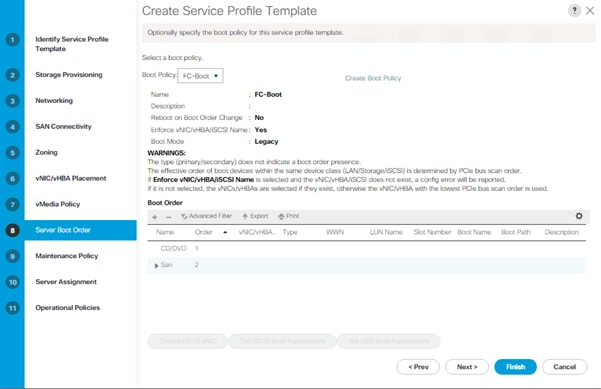
2. Click Next.
Configure Maintenance Policy
1. Change the Maintenance Policy to default.
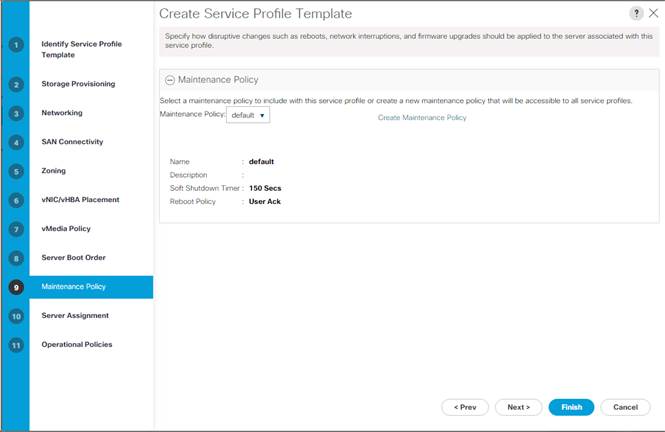
2. Click Next.
Configure Server Assignment
To configure server assignment, complete the following steps:
1. In the Pool Assignment list, select MS-Server-Pool.
2. Select Down as the power state to be applied when the profile is associated with the server.
3. Optional: select “UCS-Broadwell” for the Server Pool Qualification.
4. Expand Firmware Management at the bottom of the page and select the default policy
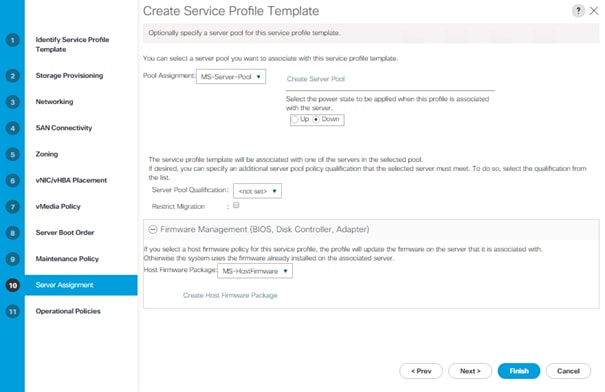
5. Click Next.
Configure Operational Policies
To configure the operational policies, complete the following steps:
1. In the BIOS Policy list, select MS-Host.
2. Expand Power Control Policy Configuration and select No-Power-Cap in the Power Control Policy list.
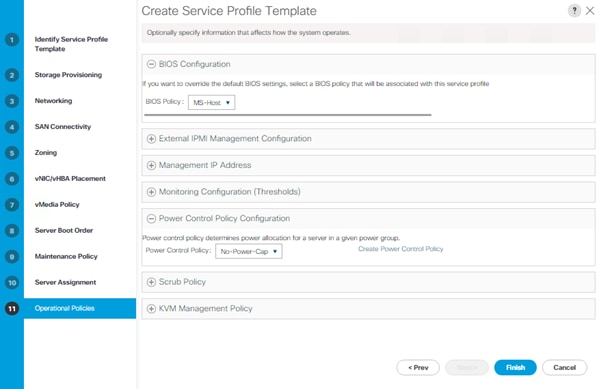
3. Click Finish to create the service profile template.
4. Click OK in the confirmation message.
Create Service Profiles
To create service profiles from the service profile template, complete the following steps:
1. Connect to UCS Manager and click Servers on the left.
2. Select Service Profile Templates > root > Service Template Hyper-V-Host-FC.
3. Right-click Hyper-V-Host-FC and select Create Service Profiles from Template.
4. Enter Hyper-V-Host-0 as the service profile prefix.
5. Enter 1 as “Name Suffix Starting Number.”
6. Enter 2 as the “Number of Instances.”
7. Click OK to create the service profiles.
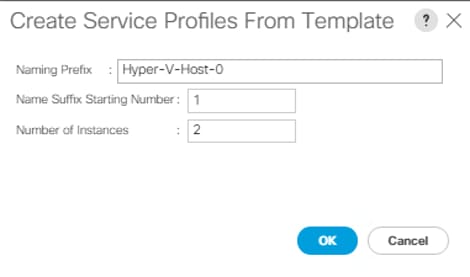
8. Click OK in the confirmation message.
Add More Servers to FlexPod Unit
Additional server pools, service profile templates, and service profiles can be created in the respective organizations to add more servers to the FlexPod unit. All other pools and policies are at the root level and can be shared among the organizations.
Gather Necessary Information
After the Cisco UCS service profiles have been created, each infrastructure server in the environment will have a unique configuration. To proceed with the FlexPod deployment, specific information must be gathered from each Cisco UCS server and from the NetApp controllers. Insert the required information into Table 6 and Table 7 below.
Table 6 WWPNs from NetApp storage
| SVM |
Adapter |
MDS Switch |
Target: WWPN |
| Infra-MS-SVM |
fcp_lif01a |
Fabric A |
<fcp_lif01a-wwpn> |
| fcp_lif01b |
Fabric B |
<fcp_lif01b-wwpn> |
|
| fcp_lif02a |
Fabric A |
<fcp_lif02a-wwpn> |
|
| fcp_lif02b |
Fabric B |
<fcp_lif02b-wwpn> |
![]() To obtain the FC WWPNs, run the network interface show command on the storage cluster management interface.
To obtain the FC WWPNs, run the network interface show command on the storage cluster management interface.
Table 7 WWPNs for UCS Service Profiles
| Cisco UCS Service Profile Name |
MDS Switch |
Initiator WWPN |
| Hyper-V-Host-01 |
Fabric A |
Hyper-V-Host -01-wwpna |
| Fabric B |
Hyper-V-Host -01-wwpnb |
|
| Hyper-V-Host -02 |
Fabric A |
Hyper-V-Host -02-wwpna |
| Fabric B |
Hyper-V-Host -02-wwpnb |
![]() To obtain the FC vHBA WWPN information in Cisco UCS Manager GUI, go to Servers > Service Profiles > root. Click each service profile and then click the “Storage” tab, then “vHBAs” tab on the right. The WWPNs are displayed in the table at the bottom of the page.
To obtain the FC vHBA WWPN information in Cisco UCS Manager GUI, go to Servers > Service Profiles > root. Click each service profile and then click the “Storage” tab, then “vHBAs” tab on the right. The WWPNs are displayed in the table at the bottom of the page.
This section provides a detailed procedure for configuring the Cisco MDS 9000s for use in a FlexPod environment. Follow these steps precisely because failure to do so could result in an improper configuration.
If directly connecting storage to the UCS fabric interconnects, skip this section.
Follow the physical connectivity guidelines for FlexPod as covered in the section “FlexPod Cabling.”
The following procedures describe how to configure the Cisco Nexus switches for use in a base FlexPod environment. This procedure assumes the use of the Cisco MDS 9148s with NX-OS
Cisco MDS 9148S A
To set up the initial configuration for the Cisco MDS A switch, <mds-A-hostname>, complete the following steps:
![]() On initial boot and connection to the serial or console port of the switch, the NX-OS setup should automatically start and attempt to enter Power on Auto Provisioning.
On initial boot and connection to the serial or console port of the switch, the NX-OS setup should automatically start and attempt to enter Power on Auto Provisioning.
1. Configure the switch using the command line.
Do you want to enforce secure password standard (yes/no) [y]: Enter
Enter the password for "admin": <password>
Confirm the password for "admin": <password>
Would you like to enter the basic configuration dialog (yes/no): yes
Create another login account (yes/no) [n]: Enter
Configure read-only SNMP community string (yes/no) [n]: Enter
Configure read-write SNMP community string (yes/no) [n]: Enter
Enter the switch name : <mds-A-hostname> Enter
Continue with Out-of-band (mgmt0) management configuration? (yes/no) [y]: Enter
Mgmt0 IPv4 address : <mds-A-mgmt0-ip> Enter
Mgmt0 IPv4 netmask : <mds-A-mgmt0-netmask> Enter
Configure the default gateway? (yes/no) [y]: Enter
IPv4 address of the default gateway : <mds-A-mgmt0-gw> Enter
Configure advanced IP options? (yes/no) [n]: Enter
Enable the ssh service? (yes/no) [y]: Enter
Type of ssh key you would like to generate (dsa/rsa) [rsa]: Enter
Number of rsa key bits <1024-2048> [1024]: Enter
Enable the telnet service? (yes/no) [n]: Enter
Configure congestion/no_credit drop for fc interfaces? (yes/no) [y]: Enter
Enter the type of drop to configure congestion/no_credit drop? (con/no) [c]: Enter
Enter milliseconds in multiples of 10 for congestion-drop for port mode F
in range (<100-500>/default), where default is 500. [d]: Enter
Enable the http-server? (yes/no) [y]: Enter
Configure timezone? (yes/no) [n]: Enter
Configure summertime? (yes/no) [n]: Enter
Configure the ntp server? (yes/no) [n]: yes
NTP server IPv4 address : <switch-a-ntp-ip>
Configure default switchport interface state (shut/noshut) [shut]: Enter
Configure default switchport trunk mode (on/off/auto) [on]: Enter
Configure default switchport port mode F (yes/no) [n]: yes
Configure default zone policy (permit/deny) [deny]: Enter
Enable full zoneset distribution? (yes/no) [n]: yes
Configure default zone mode (basic/enhanced) [basic]: Enter
2. Review the configuration.
Would you like to edit the configuration? (yes/no) [n]: Enter
Use this configuration and save it? (yes/no) [y]: Enter
Cisco MDS 9148S B
To set up the initial configuration for the Cisco MDS B switch, <mds-B-hostname>, complete the following steps:
![]() On initial boot and connection to the serial or console port of the switch, the NX-OS setup should automatically start and attempt to enter Power on Auto Provisioning
On initial boot and connection to the serial or console port of the switch, the NX-OS setup should automatically start and attempt to enter Power on Auto Provisioning
1. Configure the switch using the command line.
Do you want to enforce secure password standard (yes/no) [y]: Enter
Enter the password for "admin": <password>
Confirm the password for "admin": <password>
Would you like to enter the basic configuration dialog (yes/no): yes
Create another login account (yes/no) [n]: Enter
Configure read-only SNMP community string (yes/no) [n]: Enter
Configure read-write SNMP community string (yes/no) [n]: Enter
Enter the switch name : <mds-B-hostname> Enter
Continue with Out-of-band (mgmt0) management configuration? (yes/no) [y]: Enter
Mgmt0 IPv4 address : <mds-B-mgmt0-ip> Enter
Mgmt0 IPv4 netmask : <mds-B-mgmt0-netmask> Enter
Configure the default gateway? (yes/no) [y]: Enter
IPv4 address of the default gateway : <mds-B-mgmt0-gw> Enter
Configure advanced IP options? (yes/no) [n]: Enter
Enable the ssh service? (yes/no) [y]: Enter
Type of ssh key you would like to generate (dsa/rsa) [rsa]: Enter
Number of rsa key bits <1024-2048> [1024]: Enter
Enable the telnet service? (yes/no) [n]: Enter
Configure congestion/no_credit drop for fc interfaces? (yes/no) [y]: Enter
Enter the type of drop to configure congestion/no_credit drop? (con/no) [c]: Enter
Enter milliseconds in multiples of 10 for congestion-drop for port mode F
in range (<100-500>/default), where default is 500. [d]: Enter
Enable the http-server? (yes/no) [y]: Enter
Configure timezone? (yes/no) [n]: Enter
Configure summertime? (yes/no) [n]: Enter
Configure the ntp server? (yes/no) [n]: yes
NTP server IPv4 address : <<var_global_ntp_server_ip>>
Configure default switchport interface state (shut/noshut) [shut]: Enter
Configure default switchport trunk mode (on/off/auto) [on]: Enter
Configure default switchport port mode F (yes/no) [n]: yes
Configure default zone policy (permit/deny) [deny]: Enter
Enable full zoneset distribution? (yes/no) [n]: yes
Configure default zone mode (basic/enhanced) [basic]: Enter
2. Review the configuration.
Would you like to edit the configuration? (yes/no) [n]: Enter
Use this configuration and save it? (yes/no) [y]: Enter
FlexPod Cisco MDS Switch Configuration
Enable Licenses
Cisco MDS 9148S A and Cisco MDS 9148S B
To enable the correct features on the Cisco MDS switches, complete the following steps:
1. Log in as admin
2. Run the following commands:
configure terminal
feature npiv
feature fport-channel-trunk
Configure Individual Ports
Cisco MDS 9148S A
To configure individual ports and port-channels for switch A, complete the following step:
![]() In this step and in further sections, configure the <ucs-6248-clustername> and <ucs-6332-clustername> interfaces as appropriate to your deployment.
In this step and in further sections, configure the <ucs-6248-clustername> and <ucs-6332-clustername> interfaces as appropriate to your deployment.
From the global configuration mode, run the following commands:
interface fc1/1
switchport description <st-node01>:0e
switchport trunk mode off
port-license acquire
no shut
interface fc1/2
switchport description <st-node02>:0e
switchport trunk mode off
port-license acquire
no shutdown
exit
interface fc1/9
switchport description <ucs-6248-clustername>-a:1/31
port-license acquire
channel-group 110
no shutdown
exit
interface fc1/10
switchport description <ucs-6248-clustername>-b:1/31
port-license acquire
channel-group 110
no shutdown
exit
interface fc1/11
switchport description <ucs-6332-clustername>-a:1/1
port-license acquire
channel-group 112
no shutdown
exit
interface fc1/12
switchport description <ucs-6332-clustername>-b:1/1
port-license acquire
channel-group 112
no shutdown
exit
interface port-channel110
channel mode active
switchport mode F
switchport trunk allowed vsan <vsan-a-id>
switchport description <ucs-6248-clustername>
switchport rate-mode dedicated
interface port-channel112
channel mode active
switchport mode F
switchport trunk allowed vsan <vsan-a-id>
switchport description <ucs-6332-clustername>
switchport rate-mode dedicated
Cisco MDS 9148S B
To configure individual ports and port-channels for switch B, complete the following step:
From the global configuration mode, run the following commands:
interface fc1/1
switchport description <st-node01>:0f
switchport trunk mode off
port-license acquire
no shut
interface fc1/2
switchport description <st-node02>:0f
switchport trunk mode off
port-license acquire
no shutdown
exit
interface fc1/9
switchport description <ucs-6248-clustername>-a:1/32
port-license acquire
channel-group 111
no shutdown
exit
interface fc1/10
switchport description <ucs-6248-clustername>-a:1/32
port-license acquire
channel-group 111
no shutdown
exit
interface fc1/11
switchport description <ucs-6332-clustername>-a:1/2
port-license acquire
channel-group 113
no shutdown
exit
interface fc1/12
switchport description <ucs-6332-clustername>-a:1/2
port-license acquire
channel-group 113
no shutdown
exit
interface port-channel111
channel mode active
switchport mode F
switchport trunk allowed vsan <vsan-b-id>
switchport description <ucs-6248-clustername>
switchport rate-mode dedicated
interface port-channel113
channel mode active
switchport mode F
switchport trunk allowed vsan <vsan-b-id>
switchport description <ucs-6332-clustername>
switchport rate-mode dedicated
Create VSANs
Cisco MDS 9148S A
To create the necessary VSANs for fabric A and add ports to them, complete the following steps:
From the global configuration mode, run the following commands:
vsan database
vsan <vsan-a-id>
vsan <vsan-a-id> name Fabric-A
exit
zone smart-zoning enable vsan <vsan-a-id>
vsan database
vsan <vsan-a-id> interface fc1/1
vsan <vsan-a-id> interface fc1/2
vsan <vsan-a-id> interface port-channel110
vsan <vsan-a-id> interface port-channel112
Cisco MDS 9148S B
To create the necessary VSANs for fabric A and add ports to them, complete the following steps:
From the global configuration mode, run the following commands:
vsan database
vsan <vsan-b-id>
vsan <vsan-b-id> name Fabric-B
exit
zone smart-zoning enable vsan <vsan-b-id>
vsan database
vsan <vsan-b-id> interface fc1/1
vsan <vsan-b-id> interface fc1/2
vsan <vsan-b-id> interface port-channel111
vsan <vsan-b-id> interface port-channel113
Create Device Aliases
Cisco MDS 9148S A
To create device aliases for Fabric A that will be used to create zones, complete the following steps:
From the global configuration mode, run the following commands:
configure terminal
device-alias database
device-alias name Infra-MS-SVM-fcp_lif01a pwwn <fcp_lif01a-wwpn>
device-alias name Infra-MS-SVM-fcp_lif02a pwwn <fcp_lif02a-wwpn>
device-alias name Hyper-V-Host-01-A pwwn <vm-host-infra-01-wwpna>
device-alias name Hyper-V-Host-02-A pwwn <vm-host-infra-02-wwpna>
device-alias commit
Cisco MDS 9148S B
To create device aliases for Fabric B that will be used to create zones, complete the following steps:
From the global configuration mode, run the following commands:
configure terminal
device-alias database
device-alias name Infra-MS-SVM-fcp_lif01b pwwn <fcp_lif01b-wwpn>
device-alias name Infra-MS-SVM-fcp_lif02b pwwn <fcp_lif02b-wwpn>
device-alias name Hyper-V-Host-01-B pwwn <vm-host-infra-01-wwpnb>
device-alias name Hyper-V-Host-02-B pwwn <vm-host-infra-02-wwpnb>
device-alias commit
Create Zones
Cisco MDS 9148S A
To create the required zones on Fabric A, run the following commands:
configure terminal
zone name Hyper-V-Host-01-A vsan <vsan-a-id>
member device-alias Hyper-V-Host-01-A init
member device-alias Infra-MS-SVM-fcp_lif01a target
member device-alias Infra-MS-SVM-fcp_lif02a target
exit
zone name Hyper-V-Host-02-A vsan <vsan-a-id>
member device-alias Hyper-V-Host-02-A init
member device-alias Infra-MS-SVM-fcp_lif01a target
member device-alias Infra-MS-SVM-fcp_lif02a target
exit
zoneset name Fabric-A vsan <vsan-a-id>
member Hyper-V-Host-01-A
member Hyper-V-Host-02-A
exit
zoneset activate name Fabric-A vsan <vsan-a-id>
exit
show zoneset active vsan <vsan-a-id>
Cisco MDS 9148S B
To create the required zones on Fabric B, run the following commands:
configure terminal
zone name Hyper-V-Host-01-B vsan <vsan-b-id>
member device-alias Hyper-V-Host-01-B init
member device-alias Infra-MS-SVM-fcp_lif01b target
member device-alias Infra-MS-SVM-fcp_lif02b target
exit
zone name Hyper-V-Host-02-B vsan <vsan-b-id>
member device-alias Hyper-V-Host-02-B init
member device-alias Infra-MS-SVM-fcp_lif01b target
member device-alias Infra-MS-SVM-fcp_lif02b target
exit
zoneset name Fabric-B vsan <vsan-b-id>
member Hyper-V-Host-01-B
member Hyper-V-Host-02-B
exit
zoneset activate name Fabric-B vsan <vsan-b-id>
exit
show zoneset active vsan <vsan-b-id>
NetApp ONTAP Boot Storage Setup
To disable one network interface on each node, run the following commands:
network interface modify -vserver Infra-MS-SVM -lif fcp_lif01b -home-node bb04-affa300-1 -status-admin down
network interface modify -vserver Infra-MS-SVM -lif fcp_lif02b -home-node bb04-affa300-2 -status-admin down
Create igroups
To create igroups, run the following commands:
igroup create –vserver Infra-MS-SVM –igroup VM-Host-Infra-01 –protocol fcp –ostype windows –initiator <vm-host-infra-01-wwpna>,<vm-host-infra-01-wwpnb>
igroup create –vserver Infra-MS-SVM –igroup VM-Host-Infra-02 –protocol fcp –ostype windows –initiator <vm-host-infra-02-wwpna>,<vm-host-infra-02-wwpnb>
igroup create –vserver Infra-MS-SVM –igroup VM-Host-Infra-All –protocol fcp –ostype windows –initiator <vm-host-infra-01-wwpna>,<vm-host-infra-01-wwpnb>,<vm-host-infra-02-wwpna>,<vm-host-infra-02-wwpnb>
Map Boot LUNs to igroups
To map LUNs to igroups, run the following commands:
lun map –vserver Infra-MS-SVM –volume HV_boot –lun VM-Host-Infra-01 –igroup VM-Host-Infra-01 –lun-id 0
lun map –vserver Infra-MS-SVM –volume HV_boot –lun VM-Host-Infra-02 –igroup VM-Host-Infra-02 –lun-id 0
lun map –vserver Infra-MS-SVM –volume witness_FC_6332 –lun witness_FC_6332 –igroup VM-Host-Infra-All –lun-id 1
Setting Up Microsoft Windows Server 2016
This section provides detailed instructions for installing Microsoft Windows Server 2016 in an environment. After the procedures are completed, two booted Windows Server 2016 hosts will be provisioned.
Several methods exist for installing Microsoft Windows Server 2016. These procedures focus on how to use the built-in keyboard, video, mouse (KVM) console and virtual media features in Cisco UCS Manager to map remote installation media to individual servers and connect to their boot logical unit numbers (LUNs).
The Cisco UCS IP KVM enables the administrator to begin the installation of the operating system (OS) through remote media. It is necessary to log in to the UCS environment to run the IP KVM.
To log in to the Cisco UCS environment, complete the following steps:
1. Open a web browser and enter the IP address for the Cisco UCS cluster address. This step launches the Cisco UCS Manager application.
2. Click the Launch UCS Manager link under HTML to launch the HTML 5 UCS Manager GUI.
3. If prompted to accept security certificates, accept as necessary.
4. When prompted, enter admin as the user name and enter the administrative password.
5. To log in to Cisco UCS Manager, click Login.
6. From the main menu, click Servers on the left.
7. Select Servers > Service Profiles > root > Hyper-V-Host-01.
8. Right-click Hyper-V-Host-01 and select KVM Console.
9. Follow the prompts to launch the Java-based KVM console.
10. Select Servers > Service Profiles > root > Hyper-V-Host-02.
11. Right-click Hyper-V-Host-02. and select KVM Console.
12. Follow the prompts to launch the Java-based KVM console.
13. From the virtual KVM Console, select the Virtual Media tab.
14. Select Add Image in the right pane.
15. Browse to the Windows Server 2016 installation ISO image file and click Open.
16. Map the image that you just added by selecting Mapped.
17. To boot the server, select the KVM tab.
18. Select Power On Server in the KVM interface Summary tab, and then click OK.
Install Windows Server 2016
1. The following steps describe the installation of Windows Server 2016 to each host:
2. All Hosts
3. On boot, the machine detects the presence of the Windows installation media.
4. After the installer has finished loading, Enter the relevant region information and click Next.
5. Click Install now.
6. Enter the Product Key and click Next.
7. Select Windows Server 2016 Datacenter (Server with a GUI) and click Next.
8. After reviewing the EULA, accept the license terms and click Next.
9. Select Custom: Install Windows only (advanced).
10. Select Custom (advanced) installation.
11. In the Virtual Media Session manager uncheck the Mapped checkbox for the Windows ISO and select yes to confirm.
12. Click Add Image.
13. Browse to the Cisco fNIC driver ISO, click Open.
14. Check the Mapped checkbox next to the Cisco fNIC Driver ISO. Download the latest driver iso image from the cisco.com site.

15. Back in the KVM Console, click Load Driver and then, click OK.
16. The Cisco VIC FCoE Storport Miniport driver should auto detected; Click Next.
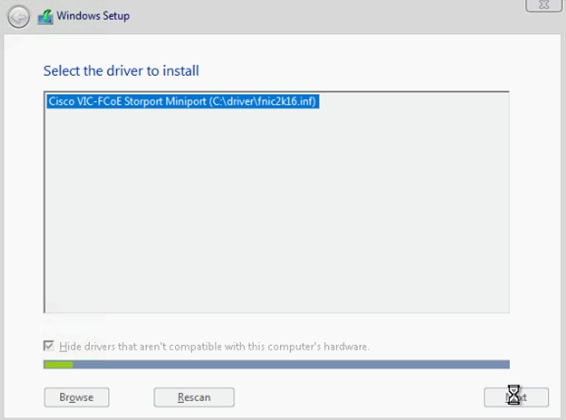
17. You should see a LUN listed in the drive selection screen.
![]() Only a single LUN instance should be displayed. Multiple instance of the same LUN indicates that there are multiple paths to the installation LUN. Verify that the SAN zoning is correct and restart the installation.
Only a single LUN instance should be displayed. Multiple instance of the same LUN indicates that there are multiple paths to the installation LUN. Verify that the SAN zoning is correct and restart the installation.
![]() The message "Windows Can't be installed on this drive" appears because the Windows installation ISO image is not mapped at this time.
The message "Windows Can't be installed on this drive" appears because the Windows installation ISO image is not mapped at this time.
![]() The Cisco eNIC driver can be loaded at this point in the same way as the fNIC driver. Loading the eNIC driver at this time bypasses the need to load the eNIC driver in the section titled "Installing Windows eNIC Driver".
The Cisco eNIC driver can be loaded at this point in the same way as the fNIC driver. Loading the eNIC driver at this time bypasses the need to load the eNIC driver in the section titled "Installing Windows eNIC Driver".
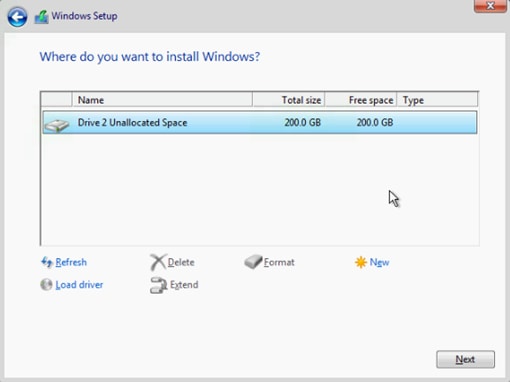
18. Select the LUN, and click Next to continue with the install.
19. When Windows is finished installing, enter an administrator password on the settings page and click Finish.
Install Chipset and Windows eNIC Drivers
This section provides detailed information on installing the Intel chipset drivers and the Cisco VIC enic drivers.
All Hosts
1. In the Virtual Media Session manager, uncheck the Mapped checkbox for the Windows ISO.
2. Click Add Image
3. Browse to the Cisco UCS driver ISO, click Open
4. Check the Mapped checkbox for the Cisco UCS driver ISO.
5. Browse to the CD ROM > Chipset > Intel > <Server Model> W2K16 > x64
6. Double click on Setup Chipset to install the chipset driver and reboot the system
7. In the KVM console, open Server Manager, and select Tools > Computer Management
8. In Computer Manager, select System Tools > Device Manager > Other devices.
9. Right-click one of the Ethernet Controller, and select Update Driver Software.
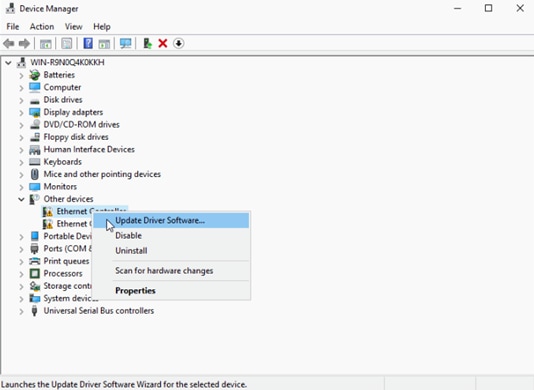
10. Click Browse, and select CDROM drive, click OK.
11. Click Next > Close.
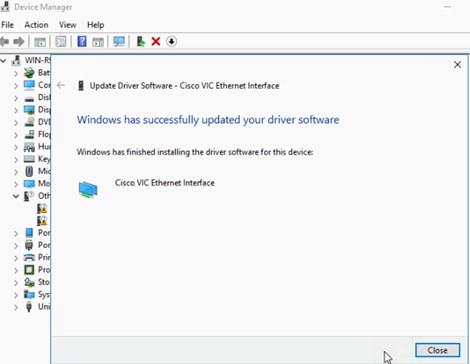
12. Right-click the next Ethernet Controller and select Update Driver Software.
13. Click Search automatically for update driver software.
14. Click Close.
15. Repeat these steps for the remaining Ethernet Controllers.
16. All Cisco VIC Ethernet devices will appear under Network Adapters.
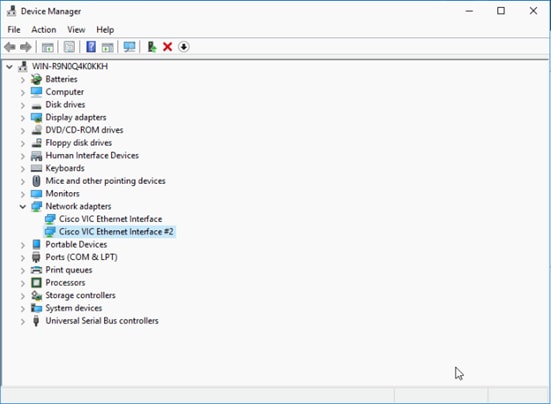
Install Windows Roles and Features
This section provides the steps to enable the MPIO feature from the Server Manager.
1. In Server Manager, select Manage > Add Roles and Features to launch the wizard.

2. Click Next in the ‘Before you begin’ section of the wizard to continue
3. In the ‘Installation Type’ section, select ‘Role-based or feature-based installation’ and click Next.
4. In the ‘Server selection’ section, select the server.
5. Click Next in the ‘Server Roles’ section without making any selection.
6. Select Multipath I/O and Data Center Bridging in the ‘Features’ section and click Next
7. Click on Install in the confirmation page to install the feature.

Install NetApp Host Utilities
After enabling the MPIO feature in Windows, download and install NetApp Windows Unified Host Utilities. This section provides the steps to download and install the host utilities.
1. Download the NetApp host utilities v7.0 for Windows from the link below:
https://mysupport.netapp.com/documentation/productlibrary/index.html?productID=61343
2. Unzip the file and run the executable file. The NetApp Windows Unified Host Utilities setup wizard is launched and Click Next.

3. Select “Yes, install support for Multipath IO” and click Next.

4. Accept the default destination folder and click Next.
5. Click Ok and Next to finish the installation of host utilities.
Host Renaming and Join to Domain
Login to the host and open PowerShell and enter the below commands to
1. Rename the host.
Rename-Computer -NewName <hostname> -restart
2. Assign an IP address to the management interface.
new-netipaddress –interfaceindex <UInt32> -ipaddress <string> -prefixlength <Byte> -DefaultGateway <string>
3. Assign DNS server IP address to the above management interface
Set-DnsClientServerAddress -InterfaceIndex <UInt32[]> -ServerAddresses <String[]>
4. Add the host to Active Directory.
Add-Computer -DomainName <domain_name> -Restart
NetApp ONTAP Boot Storage Setup
![]() Enable All Network Interfaces - now that multipathing has been installed and enabled in Windows 2016, all network interfaces can be enabled.
Enable All Network Interfaces - now that multipathing has been installed and enabled in Windows 2016, all network interfaces can be enabled.
network interface modify -vserver Infra-MS-SVM -lif fcp_lif01b -home-node bb04-affa300-1 -status-admin up
network interface modify -vserver Infra-MS-SVM -lif fcp_lif02b -home-node bb04-affa300-2 -status-admin up
For this part of the section, we assume that System Center 2016 VMM is up-and-running in your environment. This section will focus only on configuring the Networking, Storage and Servers in VMM to deploy and manage Hyper-V failover clusters. Figure 5 provides a high-level view of the steps that will be covered in detail in the following sections.
Figure 5 Deployment of Hyper-V Cluster Using SCVMM
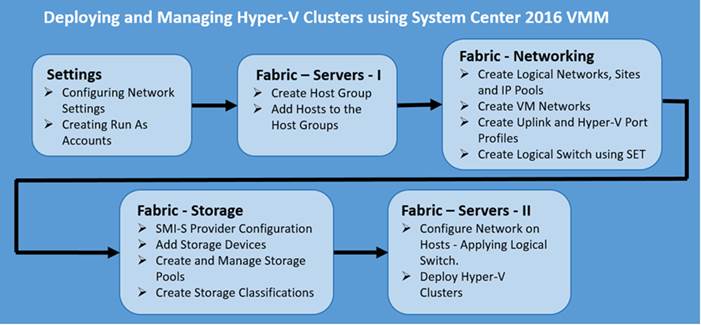
Settings
Configuring Network Settings
By default, VMM creates logical networks automatically. When you provision a host in the VMM fabric and there's no VMM logical network associated with a physical network adapter on that host, VMM automatically creates a logical network and associates it with an adapter. Follow the below procedure to disable automatic logical network creation.
1. Open Virtual Machine Manager.
2. Open the Settings workspace.
3. Select the General navigation node.
4. Double-click Network Settings in the details pane.
5. In the Network Settings dialog box, uncheck the Create Logical Networks Automatically option and click OK.
![]() Notice also in this dialog box that you can change the logical network matching behavior to a scheme that may better suit your naming conventions and design.
Notice also in this dialog box that you can change the logical network matching behavior to a scheme that may better suit your naming conventions and design.
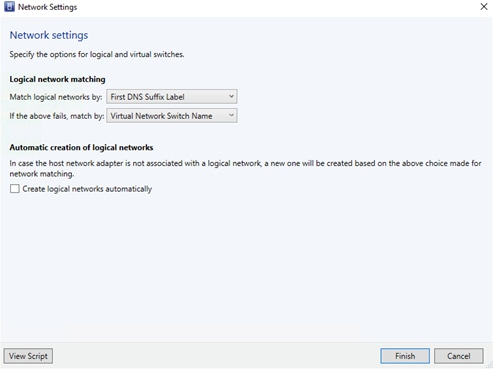
Create Run As accounts in VMM
A Run As account is a container for a set of stored credentials. In VMM a Run As account can be provided for any process that requires credentials. Administrators and Delegated Administrators can create Run As accounts. For this deployment, a Run As account should be created for adding Hyper-V hosts and integrating NetApp SMI-S provider.
1. Click Settings, and in Create click Create Run As Account.
2. In Create Run As Account specify name and optional description to identify the credentials in VMM.
3. In User name and Password specify the credentials. The credentials can be a valid Active Directory user or group account, or local credentials.
4. Clear Validate domain credentials if you don't need it, and click OK to create the Run As account.
Fabric – Servers - I
This section covers:
· Create Host Groups
· Add Windows Hosts to the Host Group
Create Host Groups
You can use host groups to group virtual machine hosts in meaningful ways, often based on physical site location and resource allocation.
Follow the below procedures to create a host group structure in Virtual Machine Manager (VMM) that aligns to your organizational needs.
1. To create a host group structure.
2. Open the Fabric workspace.
3. In the Fabric pane, expand Servers, and then do either of the following:
4. Right-click All Hosts, and then click Create Host Group.
5. Click All Hosts. On the Folder tab, in the Create group, click Create Host Group. VMM creates a new host group that is named New host group, with the host group name highlighted.
6. Type a new name, and then press ENTER.
7. Repeat the steps in this procedure to create the rest of the host group structure.
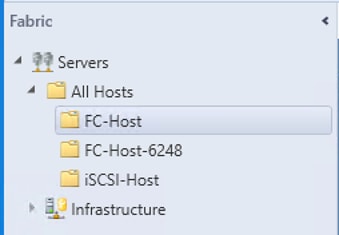
Add Hosts to the Host Group
Once the virtual switch is created, you can add the Hyper-V hosts to Virtual Machine Manager:
1. Open the Fabric workspace.
2. Select a host group, and On the Home tab, in the Add group, click Add Resources, and then click Hyper-V Hosts and Clusters. The Add Resource Wizard starts.
3. On the Resource location page, click Windows Server computers in a trusted Active Directory domain, and then click Next.
4. On Credentials page, select Use an Run As account, click Browse and add the Run as account created earlier. Click Next.
5. On Discovery scope, select Specify Windows Server computers by names and enter the Computer names. Click Next.
6. Under Target Resources, select the check box next to the computer names that needs to be the part of the Hyper-V cluster.
![]() If the Hyper-V role is not enabled on a selected server, you receive a message that VMM will install the Hyper-V role and restart the server. Click OK to continue.
If the Hyper-V role is not enabled on a selected server, you receive a message that VMM will install the Hyper-V role and restart the server. Click OK to continue.
7. On the Host settings page, In the Host group list, click the host group to which you want to assign the host or host cluster.
8. On the Summary page, confirm the settings, and then click Finish.
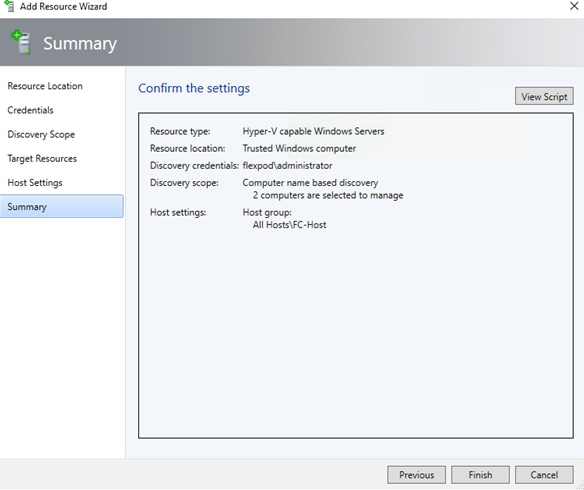

Fabric – Networking
Figure 6 SCVMM Logical Network

The above figure shows the logical representation of the network that will be configured in this section using the System Center 2016 VMM and applied later to configure the network settings of Hyper-V hosts before deploying the failover cluster. For this document, we are going to use and deploy “Switch Embedded Teaming (SET); a new feature released in Windows server 2016. SET is a new teaming solution integrated with the Hyper-V switch.
The topics that will be covered in this Networking section are:
· Create Logical Networks, Sites and IP Pools
· Create VM Networks
· Create Uplink and Hyper-V Port Profiles
· Create Logical Switch using SET
Creating Logical Networks, Sites and IP Pools
In this environment, we have six networks available that we will model as logical networks. However, they are all separate VLANs on the same physical network that will be controlled by setting the VLAN ID on the virtual network adapter. The physical ports on the switch have been configured to allow all of the various VLANs that can be configured (similar to a trunk port):
· MS-IB-MGMT: This logical network will be used for management traffic and has its own IP subnet and VLAN.
· MS-Cluster: This network will be used for Microsoft Hyper-V cluster communication and will have its own IP subnet and VLAN.
· MS-LVMN: This network will be used for Live Migration traffic and will have its own IP subnet and VLAN
· MS-SMB-1 and MS-SMB-2: This network will be used for SMB file share access/traffic and has its own IP subnet and VLAN.
· MS-Tenant-VM (optional): This network will be used for all the VM traffic.
Perform the following steps to create logical networks and sites:
1. Open Virtual Machine Manager Console.
2. Open the Fabric workspace.
3. Select the Networking > Logical Networks navigation node.
4. Click the Create Logical Network button, which launches the Create Logical Network Wizard.
5. Enter a name and description for the logical network and click Next.
6. In the Settings tab, select VLAN-based independent networks.
![]() You can select a type of network. It can be a connected network that allows multiple sites to communicate with each other and use network virtualization, a VLAN-based independent network, or a PVLAN-based network.
You can select a type of network. It can be a connected network that allows multiple sites to communicate with each other and use network virtualization, a VLAN-based independent network, or a PVLAN-based network.
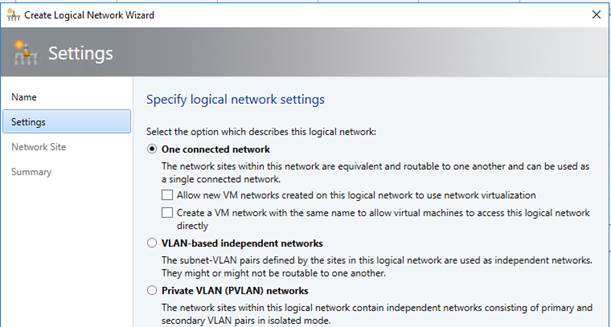
7. Select the sites and Host Group, where you want to apply the Management VLAN. Click the Add button to add a site and then click Insert Row to add VLAN/IP details for the site.
![]() If IP space is configured by corporate DHCP servers, leave the IP subnet blank, which tells SCVMM to just configure the VM for DHCP. If the network does not use VLANs, set the VLAN ID to 0; this tells SCVMM that VLANs are not to be configured. By default, sites are given the name <Logical Network>_<number>, but you should rename this to something more useful.
If IP space is configured by corporate DHCP servers, leave the IP subnet blank, which tells SCVMM to just configure the VM for DHCP. If the network does not use VLANs, set the VLAN ID to 0; this tells SCVMM that VLANs are not to be configured. By default, sites are given the name <Logical Network>_<number>, but you should rename this to something more useful.
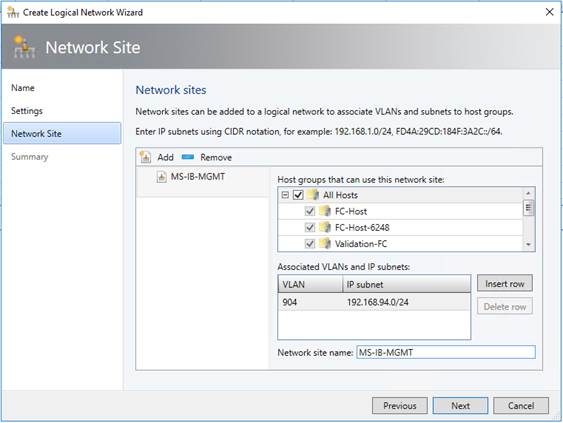
8. The Summary screen is displayed. It includes a View Script button that when clicked shows the PowerShell code that can be used to automate the creation. This can be useful when you are creating many logical networks, or more likely, many sites.
9. Click Finish to create the logical network.
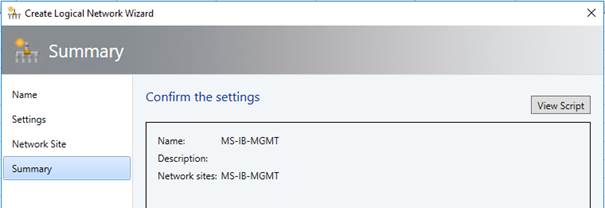
10. Follow the above steps to create all the Logical Networks for the environment. The figure below shows the all the logical networks created for this document.

Perform the following steps to create a static IP address pool for a logical network in Virtual Machine Manager (VMM). With static IP address pools,
IP address management for the virtual environment is brought within the scope of the VMM administrator.
1. From the Fabric workspace, Click the Create IP Pool button, or right-click the logical network and select the Create IP Pool context menu action.
2. Enter a name and description. From the drop-down list, select the logical network for the IP pool.
3. The next screen, allows you to use an existing network site or create a new one. Choose to use an existing one and then click Next.
4. The next screen, allows you to use an existing network site or create a new one. Choose to use an existing one and then click Next.
5. The IP Address Range page allows configuration of the IP address range that SCVMM will manage and allocate to resources such as virtual machines and load balancers. Within the range, you can configure specific addresses to be reserved for other purposes or for use by load-balancer virtual IPs (VIPs) that SCVMM can allocate.
6. Click the Insert button, and enter the gateway IP address. Then click Next.
7. Configure the DNS servers, DNS suffix, and additional DNS suffixes to append, and then click Next.
8. Enter the WINS server details if used, and click Next.
9. On the Summary screen, confirm the configuration, click the View Script button to see the PowerShell that will be used, and then click Finish to create the IP pool.
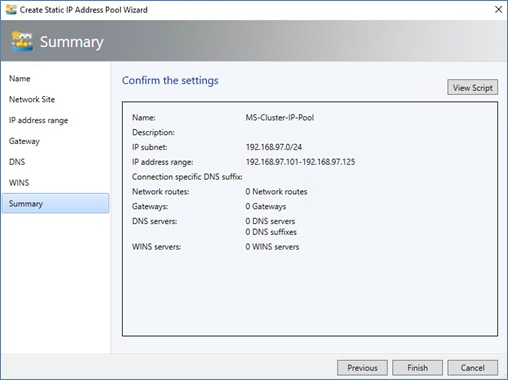
10. Create IP Pools for all the Logical Networks as shown the figure below.
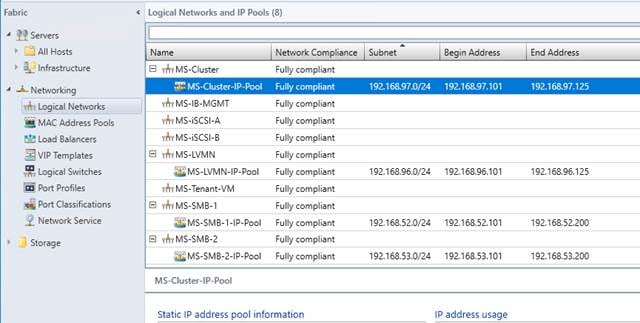
Create VM Networks
With logical networks created, the next step is to create the VM networks to which virtual machines can be connected.
1. Open Virtual Machine Manager.
2. Open the VMs and Services workspace.
3. Select the VM Networks navigation node.
4. Click the Create VM Network button.
5. Enter a name and description for the VM network, select the logical network, and click Next.
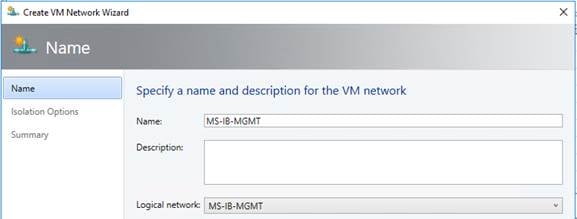
6. In the Isolation Options screen, select Specify a VLAN and select Network Site, IPv4 Subnet VLAN and click Next
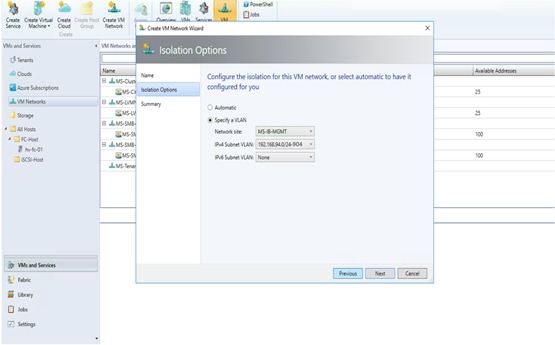
7. Click Finish to complete the VM network creation process.
8. Repeat the above steps to create all the required VM Networks.
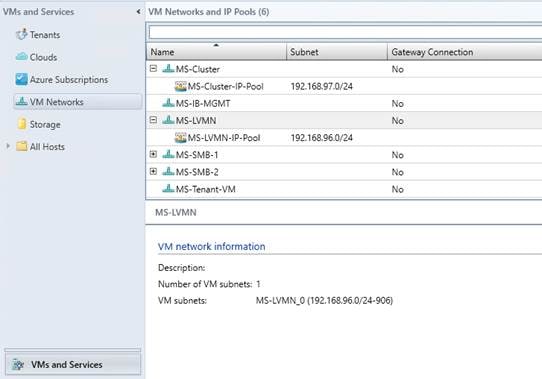
Create Uplink Port Profiles and Hyper-V Port Profiles
Create uplink port profile
Uplink port profiles define the load balancing algorithm for an adapter, and specify how to team multiple network adapters on a host that use the same uplink port profile. This profile is used in conjunction with the logical network that you associated with the adapter.
1. Open Virtual Machine Manager.
2. Open the Fabric workspace.
3. Select the Networking > Port Profiles navigation node.
4. Click the Create button drop-down, and select Hyper-V Port Profile.
5. Enter a name and description for the new port profile, Select the Uplink Port Profile radio button. Leave the Load balancing algorithm to Host Default and set Teaming Mode to Switch Independent and click Next.
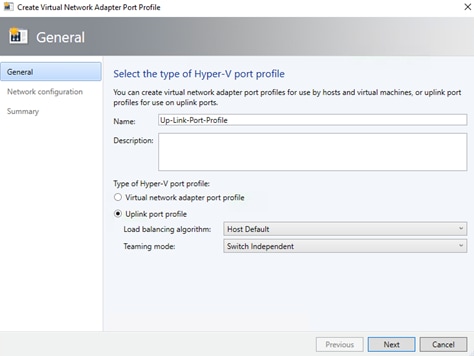
6. Select the network sites (which are part of your logical networks) that can be connected to via this uplink port profile. Click Next.
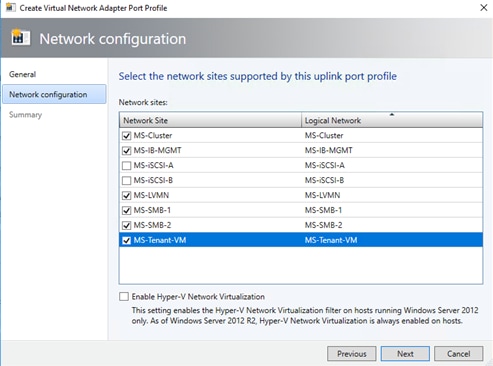
7. Click Finish to complete the creation of the uplink port profile.
Create Logical Switch using SET
A logical switch brings virtual switch extensions, port profiles, and port classifications together so that you can configure each network adapter with the settings you need, and have consistent settings on network adapters across multiple hosts.
This section covers the steps to create logical switch using embedded team as the uplink mode. Windows Server 2016 introduces Switch Embedded Teaming (SET) which, as the name suggests, teams multiple adapters directly in the VM Switch instead of creating a separate NIC team by using the Load Balancing and Failover (LBFO) functionality. SET has the benefit of enabling mixed use of adapters with the VM Switch and utilizing RDMA.
The logical switch will bring all of the components together. Follow these steps to create the Logical Switch:
1. Open Virtual Machine Manager
2. Click Fabric tab > Networking > Logical Switches > Create Logical Switch.
3. In Create Logical Switch Wizard > Getting Started, review the information, Click Next.
4. Enter a name, description for the new logical switch and select Uplink Mode as Embedded Team to deploy the switch with SET-based teaming and click Next
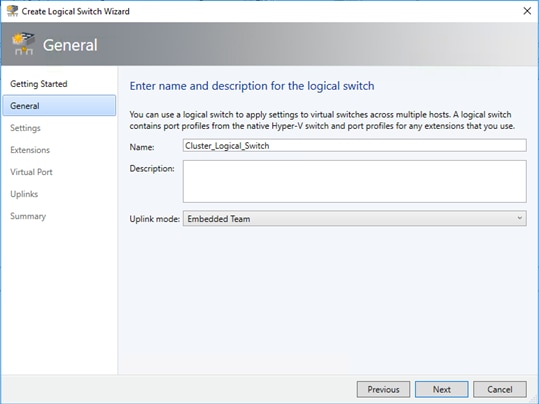
5. Select the minimum bandwidth mode as Weight, which quantifies minimum bandwidth for workloads, click Next
6. In Extensions selection window, leave the default and click Next.
![]() The list of installed virtual switch extensions is displayed and can be selected for deployment as part of the logical switch usage. This can be changed in the future if required.
The list of installed virtual switch extensions is displayed and can be selected for deployment as part of the logical switch usage. This can be changed in the future if required.
7. In Virtual Port window, Click the Add button, and in the dialog box that appears, click the Browse button to select the port classification. Then select the “Include a virtual network adapter port profile in this virtual port” check box and select the virtual port profile that corresponds. For example, if you select the high-bandwidth port classification, then most likely you would select the High Bandwidth Adapter virtual port profile object. Click OK. Repeat to add classifications. Select the classification that you would like to be the default, and click the Set Default button. Click Next.
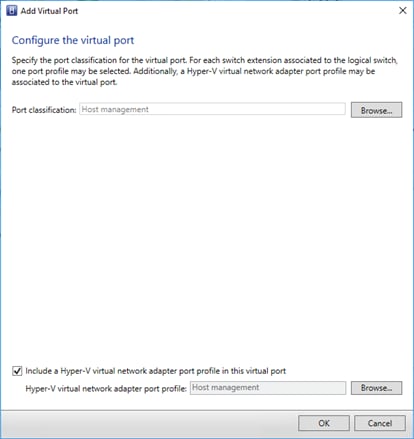
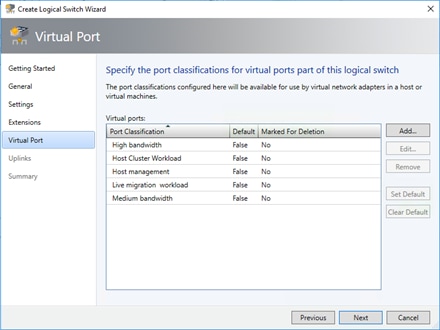
8. In the Uplinks window, Click the Add button and then select Existing Uplink Port Profile - Up-Link-Port-Profile.
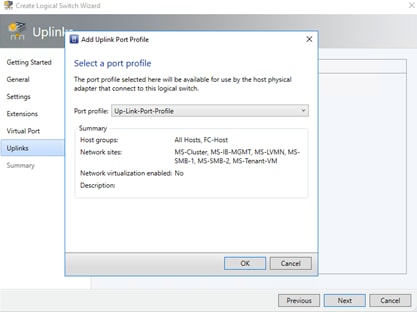
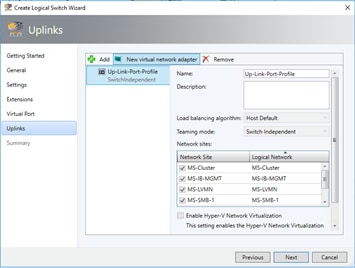
9. Highlight Up link port profile, and click new virtual network adapter to add a virtual network adapter, click Browse to add the VM Networks and enter the name to match the VM Network under Connectivity. Under IP address configuration, select Static, select the IP Pool for the VM Network and Port Profile for the virtual adapter. Add all the virtual network adapters needed for your infrastructure and Click Next.
![]() Only the MS-IB-MGMT virtual network adapter will have check box enabled for “This virtual network adapter will be used for host management” and “Inherit connection settings from host network adapter”. This ensures continued connectivity for the host.
Only the MS-IB-MGMT virtual network adapter will have check box enabled for “This virtual network adapter will be used for host management” and “Inherit connection settings from host network adapter”. This ensures continued connectivity for the host.
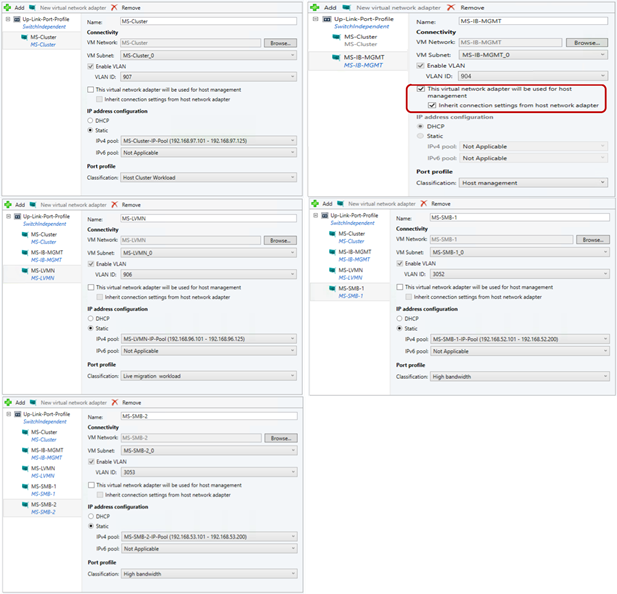
10. Click Finish to create the logical switch.
Fabric - Storage
NetApp SMI-S Provider Configuration
![]() The NetApp SMI-S Provider can be downloaded from http://mysupport.netapp.com
The NetApp SMI-S Provider can be downloaded from http://mysupport.netapp.com
Install the NetApp SMI-S Provider
1. Log into the Windows VM as Administrator.
2. Navigate to the directory that contains the NetApp SMI-S Provider software package. Double-click the package name.
3. Complete the steps in the setup wizard to complete the install.
Create the Local Administrator
1. Enter Win-R to open the Run application.
2. Open the Local Users and Groups window by entering lusrmgr.msc and pressing Enter.
3. Add a user named SMIS-User as a local Administrator
Configure the NetApp SMI-S Provider
1. In the Programs menu, navigate to NetApp SMI-S Provider.
2. Right click and select Run as Administrator. A command line prompt should open.
3. Run the command smis cimserver status to ensure the NetApp SMI-S Provider is running
C:\Program Files (x86)\NetApp\smis\pegasus\bin>smis cimserver status
NetApp SMI-S Provider is running.
4. Add a user to the CIM server by running the following command:
![]() The added user should be a valid domain administrator on your domain.
The added user should be a valid domain administrator on your domain.
C:\Program Files (x86)\NetApp\smis\pegasus\bin>cimuser -a -u flexpod\SMIS
Please enter your password: ********
Please re-enter your password: ********
User added successfully.
5. Add the SVM to the SMI-S Provider using the following command:
C:\Program Files (x86)\NetApp\smis\pegasus\bin>smis addsecure 192.168.94.80 vsadmin
Enter password: ********
Returned Path ONTAP_FilerData.hostName="192.168.94.80",port=443
Successfully added 192.168.94.80
NetApp SMI-S Integration with VMM
To add a remote storage device in Virtual Machine Manager (VMM), you can add and discover external storage arrays that are managed by Storage Management Initiative – Specification (SMI-S) or Store Management Provider (SMP) providers.
To add an SMI-S storage device, ensure that you have installed the SMI-S provider for the array on a server that the VMM management server can access over the network by IP address or by fully qualified domain name (FQDN).
![]() Do not install the SMI-S provider on the VMM management server. This configuration is not supported.
Do not install the SMI-S provider on the VMM management server. This configuration is not supported.
Add a storage device
1. Click Fabric > Storage > Add Resources >Storage Devices.
2. In Add Storage Devices Wizard > Select Provider Type, select to add a storage device with SMI-S.

3. In Specify Discovery Scope, select Protocol - SMI-S CIMXML, add the IP address/FQDN, and add the port used to connect to the provider on the remote server. You can enable SSL if you're using CIMXML. Then specify an account for connecting to the provider.

4. In Gather Information, VMM automatically tries to discover and import the storage device information.
5. If the discovery process succeeds, the discovered storage arrays, storage pools, manufacturer, model, and capacity are listed as shown in the below figure. When the process finishes, click Next.

6. In Select Storage Devices, specify a classification and host group from the drop-down list for each storage pool. Create storage classifications if none exists to group storage pools with similar characteristics.
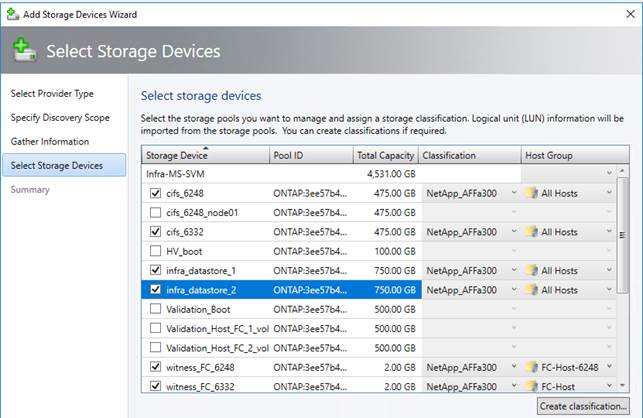
7. On the Summary page, confirm the settings, and then click Finish. The Jobs dialog box appears. When status is Completed you can verify the storage in Fabric > Storage.

Create and Assign SMB 3.0 file shares to the Hyper-V host clusters
SMB file shares can be used by Hyper-V hosts as a shared storage to store virtual machine files. This section covers steps to create and assign SMB file shares to stand-alone Hyper-V servers and host cluster.
1. To add a storage device, refer to the steps covered in the above section.
2. To create a file share, open Fabric workspace, expand Storage and click on File Servers.
3. Select the File Server and click on Create File Share and in the Create File Share wizard, enter a name for the share and select Storage Type, Pool and Classification. Click Next.
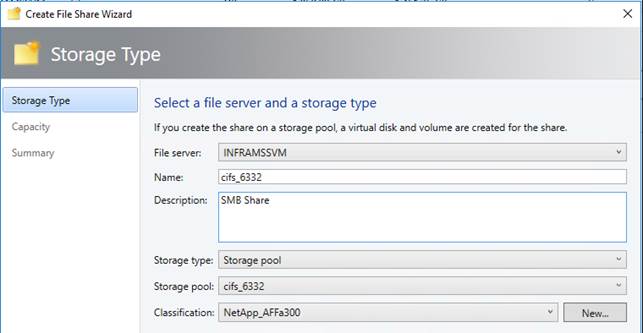
4. In the Capacity page, enter a size and click Next.
5. In the Summary page, confirm the setting and click Finish.
6. Verify the file share created in the above steps by navigating to Fabric > Storage and click on File Servers.
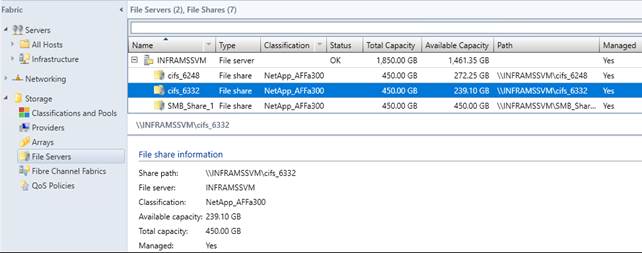
7. Assign the file share to the host cluster by navigating to Fabric > Servers > All Hosts.
8. Locate and right-click on the cluster icon and click on Properties.
9. Click on File Share Storage and click Add.

10. From the drop-down menu next to the File Share Path, select a share.
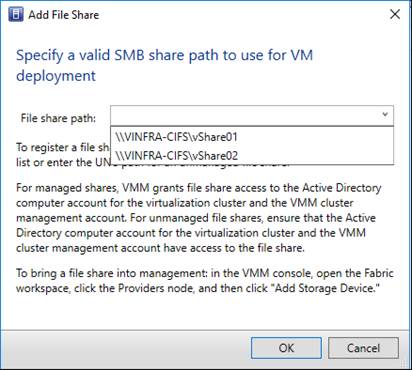
11. Repeat this step to select other shares.

12. Verify the allocation by checking each cluster node properties for the file share allocation under the storage as shown in the figure below.
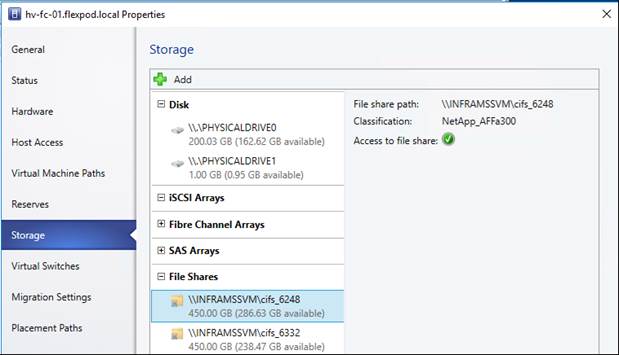
Allocate a storage pool to a host group
For this document purpose, the necessary SAN LUNs required for deploying Windows Hyper-V clusters were already created on the array before the SMI-S integration with VMM section. During the integration process of SMI-S with VMM, these storage pools were classified and associated with the appropriate host groups. The steps in the sections below show how to create storage pools and LUNs from the VMM console after the SMI-S integration as an example.
1. Click Fabric > Storage > Allocate Capacity, and click the host group.
2. The total and available storage capacity information is displayed for the host group. The storage capacity information includes the total and available capacity for both local and remote storage, and total and available allocated storage. Click Allocate Storage Pools.
3. Click a storage pool > Add.
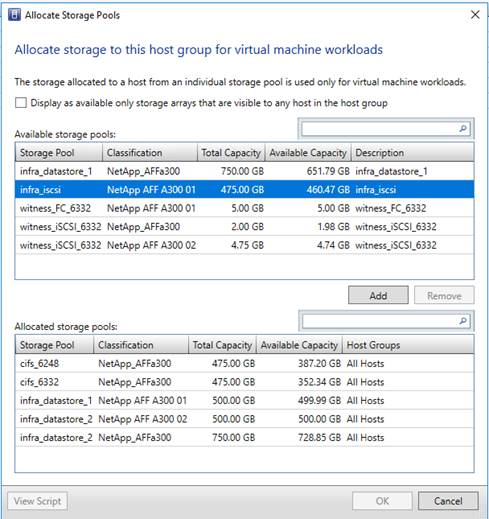
4. Create a LUN in VMMIn the SCVMM console, Click Fabric > Storage > Create Logical Unit.
5. Specify the storage pool, a name and description for the LUN, and the size. Click OK to create the LUN.
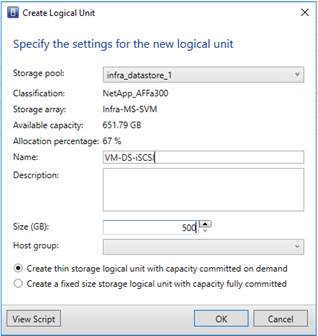
6. Verify that the LUN was created in Fabric Resources > Classifications, Storage Pools, and Logical Units.

Allocate a LUN to a host group
1. Click Fabric > Storage > Allocate Capacity > Allocate Storage Capacity and click the host group.
2. Click Allocate Logical Units, select a unit > Add.
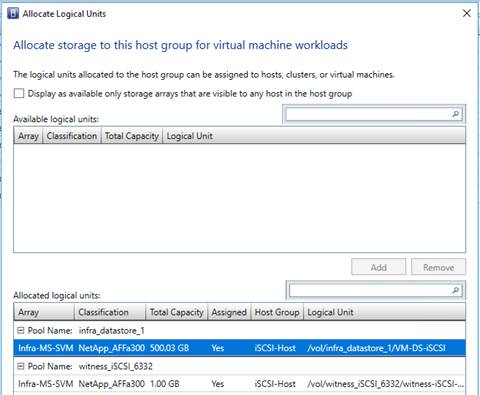
Fabric – Servers - II
Once the networking and storage configuration is complete and associated to the host groups, the next step is to deploy Hyper-V failover cluster.
· Configure Network on Hosts by Applying Logical Switch
· Deploy Hyper-V Failover Cluster
Configure Network on Host – Applying Logical Switch
1. Click Fabric > Storage > All Hosts > host group > Hosts > Host > Properties > Virtual Switches.
2. Open Fabric > Servers > click New Virtual Switch.
3. Select the logical switch you created. Under Adapter, select both the physical adapter to apply to the logical switch.
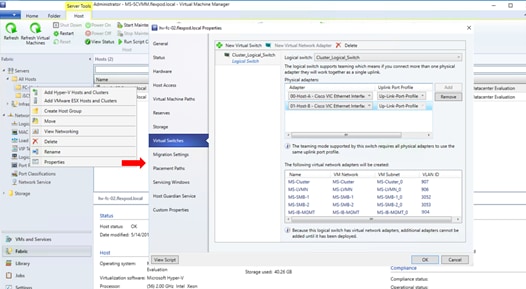
4. In the Uplink Port Profile list, select the uplink port profile Up-Link-Port-Profile and click Ok.
5. Repeat the above steps to configure the Logical Switch on all the hosts in the Host Group.
6. After applying the logical switch, you can check that the network adapter settings and verify whether they're in compliance with the switch:
a. Click Fabric > Networking > Logical Switches > Home > Show > Hosts.
b. Login to the host and verify the Network Adapters under Network Connections.
![]() In Logical Switch Information for Hosts verify the settings. Fully compliant indicates that the host settings are compliant with the logical switch. Partially compliant indicates some issues. Check the reasons in Compliance errors. Non-compliant indicates that none of the IP subnets and VLANs defined for the logical network are assigned to the physical adapter. Click the switch > Remediate to fix this.
In Logical Switch Information for Hosts verify the settings. Fully compliant indicates that the host settings are compliant with the logical switch. Partially compliant indicates some issues. Check the reasons in Compliance errors. Non-compliant indicates that none of the IP subnets and VLANs defined for the logical network are assigned to the physical adapter. Click the switch > Remediate to fix this.

Enable Jumbo Frames
SET Team virtual switch does not require jumbo frame settings, however, the jumbo frames need to be enabled on the virtual network adapters of the Windows OS. Set the Jumbo Frames for the following vEthernet/virtual adapters.
· MS-LVMN
· MS-SMB-1
· MS-SMB-2
· MS-Cluster
1. Login to the Windows Operating System, under Network Connections, right click on the virtual adapters, select Properties.
2. Check the Advanced Properties on the NIC in windows and set the Jumbo Packet value to 9014 Bytes

3. Verify and validate the jumbo packet settings as shown in the below commands


Deploy Hyper-V Cluster
1. In the VMM console, click Fabric > Create > Hyper-V Cluster to open the Create Hyper-V Cluster wizard.
2. In General, specify a cluster name and choose the host group in which the existing Hyper-V hosts are located.
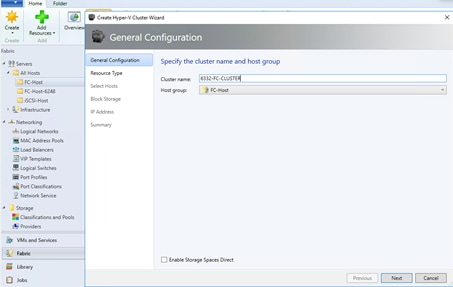
3. In Resource Type, select the Run As account that you'll use to create the cluster.
![]() The accounts that you use must have administrative permissions on the servers that will become cluster nodes, and must belong to the same domain as the Hyper-V hosts that you want to cluster. Also, the account requires Create Computer objects permission in the container that is used for Computer accounts in the domain. Ensure that the option Existing Windows servers is selected.
The accounts that you use must have administrative permissions on the servers that will become cluster nodes, and must belong to the same domain as the Hyper-V hosts that you want to cluster. Also, the account requires Create Computer objects permission in the container that is used for Computer accounts in the domain. Ensure that the option Existing Windows servers is selected.
4. In Nodes, select the Hyper-V host servers that you want to include in the cluster.
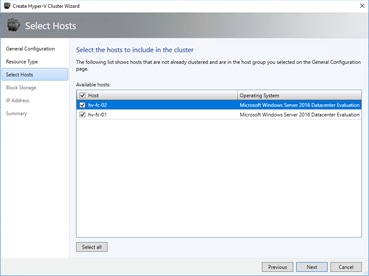
5. In Block Storage, select the data disks you want the cluster to use as witness disk.
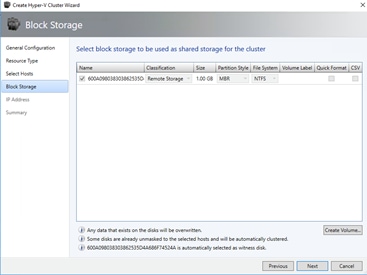
6. In IP address, type in the IP address you want to use for the cluster.
7. In Summary, confirm the settings and then click Finish.
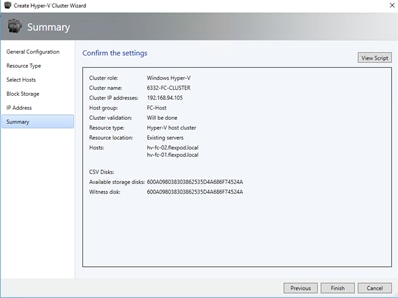
8. You can go to the jobs workspace and click on “Install Cluster” job to see the status of cluster installation. Fix and troubleshoot any errors or warnings and revalidate the cluster.

9. After the cluster is installed, a new cluster icon is seen after expanding the Servers>All Hosts>FC-Host host group in the fabric workspace. Right-click on the cluster and click on properties to view the status and other information about the cluster.


Hyper-V Cluster Communication Network Configuration
A failover cluster can use any network that allows cluster network communication for cluster monitoring, state communication, and for CSV-related communication.
The following table shows the recommended settings for each type of network traffic.
To configure a network to allow or not to allow cluster network communication, you can use Failover Cluster Manager or Windows PowerShell.
Table 8 Recommended Settings for Network Traffic
| Network Type |
Recommended Setting |
| Management |
Both of the following: - Allow cluster network communication on this network - Allow clients to connect through this network |
| Cluster |
Allow cluster network communication on this network Note: Clear the Allow clients to connect through this network check box. |
| Live migration |
Allow cluster network communication on this network Note: Clear the Allow clients to connect through this network check box. |
| Storage |
Do not allow cluster network communication on this network |
1. Open Failover Cluster Manager, click Networks in the navigation tree.
2. In the Networks pane, right-click a network, and then click Properties.
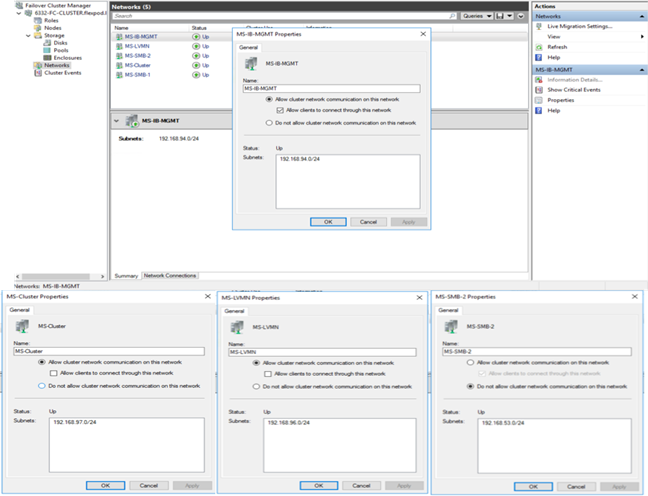
Live Migration Network Settings
By default, live migration traffic uses the cluster network topology to discover available networks and to establish priority. However, you can manually configure live migration preferences to isolate live migration traffic to only the networks that you define.
1. Open Failover Cluster Manager.
2. In the navigation tree, right-click Networks, and then click Live Migration Settings.
3. Select the Live Migration network.
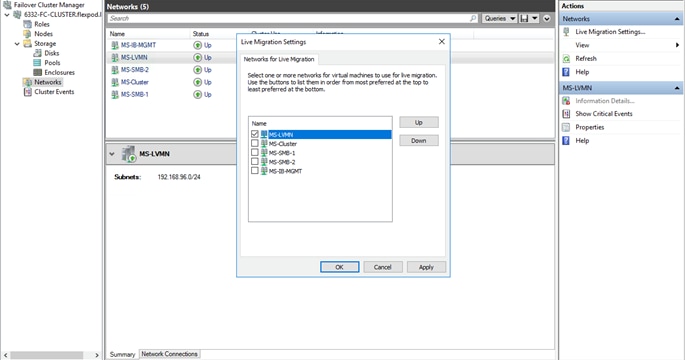
Cisco UCS Manager Integration with SCOM
About Cisco UCS Management Pack Suite
Management Pack is a definition file with predefined monitoring settings. It enables you to monitor a specific service or application in Operations Manager. These predefined settings include discovery information which allows Operations Manager to automatically detect and start the monitoring services and applications. It also has a knowledge base which contains error details, troubleshooting information, alerts, and reports which helps to resolve the problems detected in the environment.
The Cisco UCS Manager Management Pack provides visibility to the health, performance, and availability of a Cisco UCS domain through a single, familiar, and easy-to-use interface. The management pack contains rules to monitor chassis, blade servers, rack servers, and service profiles across multiple Cisco UCS domains.
The Cisco UCS Central Management Pack has rules to monitor global service profiles and organizations across multiple Cisco UCS Central. It provides visibility of health and alerts through familiar and easy-to-use interface.
For more information, see: https://www.cisco.com/c/en/us/td/docs/unified_computing/ucs/sw/msft_tools/installation_guide/SCOM/b_Management_Pack_Installation_Guide.html
Installing Cisco UCS Monitoring Service
1. Navigate to the folder in which the unzipped Cisco UCS Management Pack Suite is stored.
2. Select the monitoring service installer .msi file, and launch the installer.
3. In the Setup wizard, click Next.
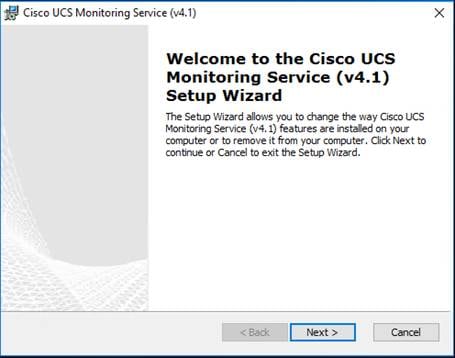
4. In the License Agreement page, do the following:
a. Review and accept the EULA.
b. Click Next.
5. In the Product Registration page, complete the following:
a. Enter a username.
b. Optional: Enter the name of your organization. The username is required, but the organization name is optional.
c. Click Next.
6. In the Select Installation Folder page, accept the default installation folder or click Browse to navigate to a different folder, and then click Next.
7. On the Ready to Install page, click Install to start the installation.
8. Once the Cisco UCS monitoring service is successfully installed, the Installation Complete message appears.
9. Click Finish.
![]() The same installation procedure is followed to install the monitoring service on agent managed computers and gateway servers.
The same installation procedure is followed to install the monitoring service on agent managed computers and gateway servers.
Adding a Firewall Exception for the Cisco UCS Monitoring Service
1. Before you monitor a Cisco UCS domain, enable the following inbound rules in the Windows Firewall with Advanced Security on the computer where you run the Cisco UCS Management Service.
2. File and Printer Sharing:
a. Echo-Request—ICMPv4-In
b. Echo-Request—ICMPv6-In
3. Remote Service Management (RPC)
4. Remote Service Management (RPC-EPMAP)
Installing the Cisco UCS Management Pack Suite
1. For importing Management Packs using Operations Manager console, you must have administrative privileges. For more information on the access privileges, see https://technet.microsoft.com/en-in/library/hh212691.aspx. On the Cisco.com download site for Cisco UCS Management Partner Ecosystem Software, download the Cisco UCS management pack suite file and unzip the file into a folder.
2. Launch Operations Manager console.
3. Navigate to the Administration > Management Packs > Import Management Packs tab.
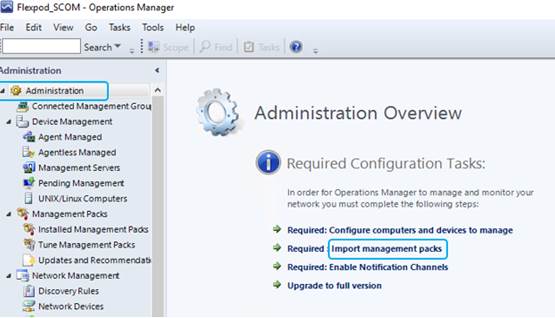
4. On the Import Management Pack page, click Add and select Add from the disk. An Online Catalog Connection dialog box appears.
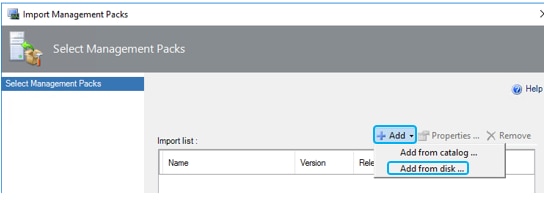
5. Click No, if you do not want to search the management pack dependencies online.
6. Navigate to the unzipped management pack suite files folder.
7. From the list of files, select the mandatory files:
· Cisco.Ucs.Views.Library.mpb
· Cisco.Ucs.Core.Library.mpb
· Cisco.Ucs.Monitoring.Service.mpb
8. Other management pack files can be imported based on your machine requirements. For example, select Cisco.Ucsm.mpb for UCS Manager, Cisco.UCS.CSeries.mpb for Cisco IMC, and Cisco.UCSCentral.mpb for UCS Central.
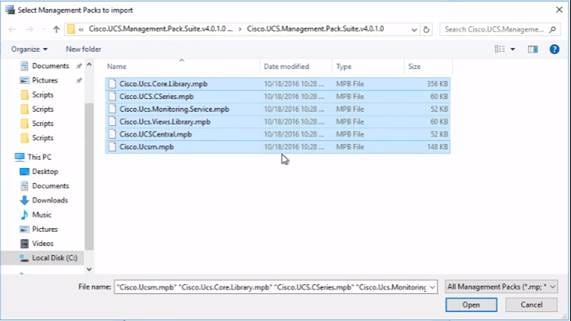
9. Click Open.
10. Click Install on the Import Management Packs page.
It may take few minutes to import the files.
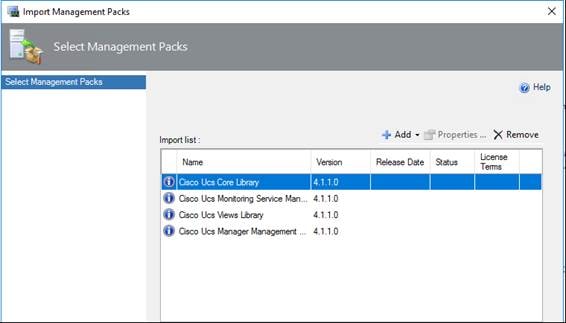
11. Verify the installation by navigating to the Administration > Management Packs and click on Installed Management Packs
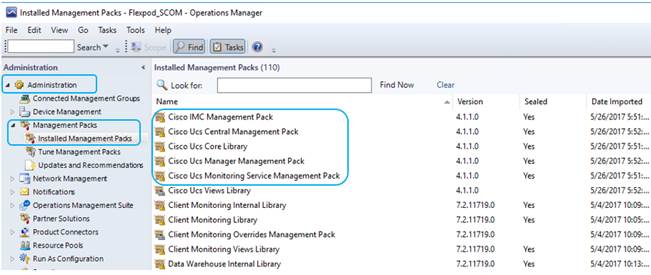
12. In the Monitoring pane, a Cisco UCS folder is also created. When the folder is expanded, it lists the Cisco UCS Monitoring Service, IMC, UCS Central and UCS Domain monitoring folders.

Adding a Cisco UCS Domains to the Operations Manager
You can add Cisco UCS domains on the servers, where either management pack is imported or the Cisco UCS Management Service is installed.
1. Launch the Operations Manager console.
2. Navigate to Authoring > Cisco UCS Manager.
3. From the Tasks pane, click Add Monitoring Wizard.
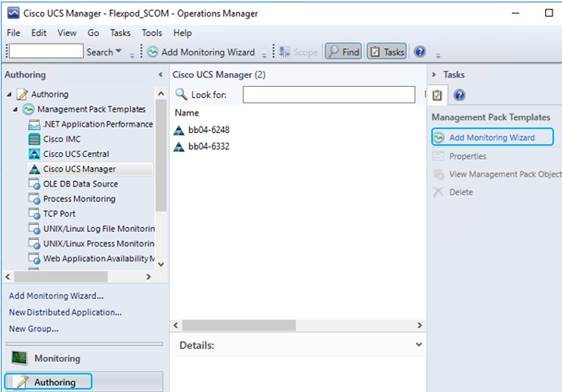
4. On the Monitoring Type tab, click Cisco UCS Manager.
5. Click Next.
6. On the General Information tab, review and complete the following as shown in the below figure:
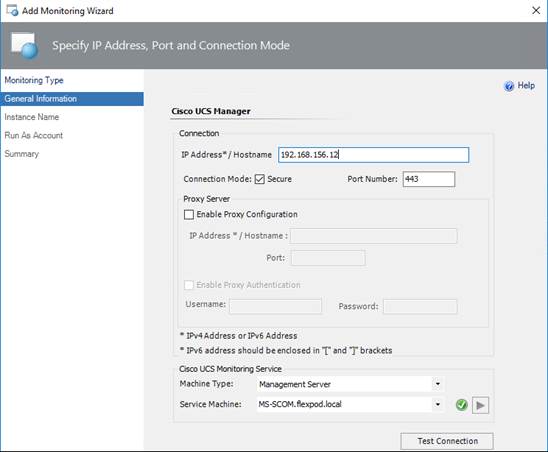
7. To check Operations Manager connectivity to UCS Manager, click Test Connection.
8. In the Authentication dialog box, enter the username and password, and click OK and Click Next.
9. On the Instance Name tab, complete the following as shown in the figure below and Click Next.

10. On the Run As Account tab, click Add
11. If you want to associate a new run-as account to the UCS domain instance, click New.
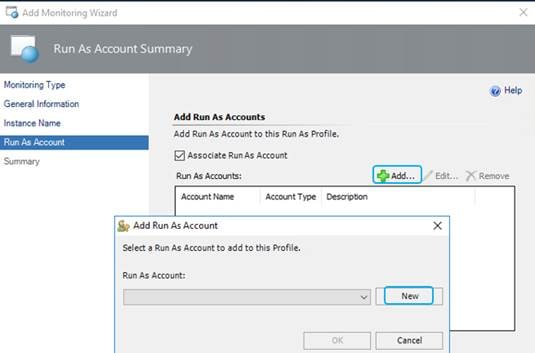
12. Click Next.
13. On the Summary tab, review the configuration summary, and click Create. The template for monitoring the UCS domain is created.

Cisco UCS Manager Monitoring Dashboards
The UCS Domain(s) Monitoring folder contains the following views:
· Ucs Domain Alert Dashboard—Displays all alerts generated in the UCS domain. The alerts are further categorized into the following views:
- Active Alerts
- Acknowledge Alerts
- Cleared Alerts
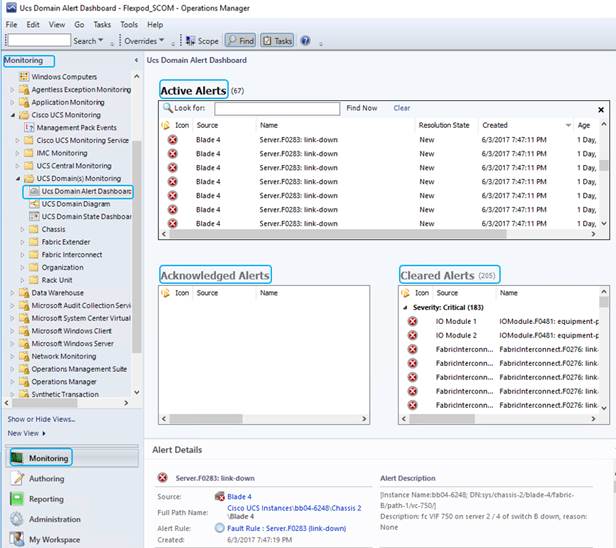
· UCS Domain Diagram—Displays a graphical view of the relationship between different Cisco UCS Domain(s) components for all Instances.
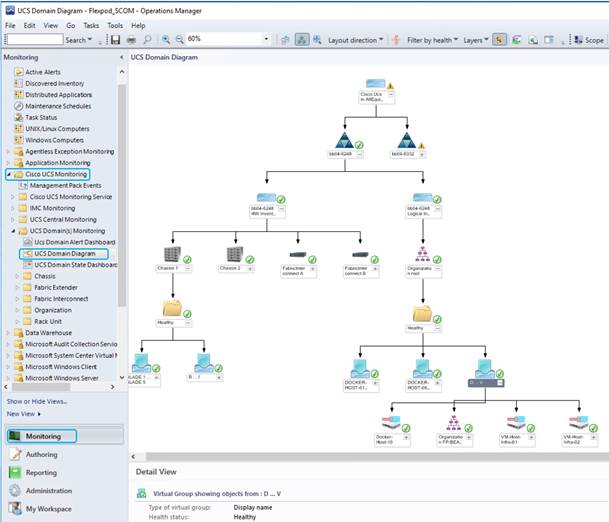
· UCS Domain State Dashboard—Displays the list of domains added and its health state and other inventory information.
· When you select a UCS domain from the State dashboard, you can perform the tasks listed in the following sections.
- Generating Cisco UCS Domain Technical Support Bundle
- Launching UCS GUI
- Loading the UCS Inventory Data
- Ping UCS
- Ping UCS Continuously
- Physical and Logical Inventory
- Launching KVM Console
- Alert Operations

· You can view performance metrics for the various Cisco UCS components as shown the below figure.

Using the Cisco UCS Manager add-in you can view the details such as properties, faults information, and firmware details of the servers (blades or rack-mount servers) on which the host is running.
Cisco UCS Manager Plug-in Installation
Perform the following steps to install the Cisco UCS virtual machine manager add-in:
1. Open https://software.cisco.com/download/type.html?mdfid=286282669&flowid=72562
2. Click Unified Computing System (UCS) Microsoft System Center Virtual Machine Manager to view the list of available versions for download (CiscoUCS-Scvmm-1.1.2.zip).
3. Download and save the zipped folder.
![]() The add-in is made available as a zipped file that has to be imported into the virtual machine manager to install it.
The add-in is made available as a zipped file that has to be imported into the virtual machine manager to install it.
4. Open an instance of the Virtual Machine Manager console.
5. In the Navigation pane, click Settings.
6. In the toolbar, click Import Console Add-in. The Import Console Add-in wizard appears.
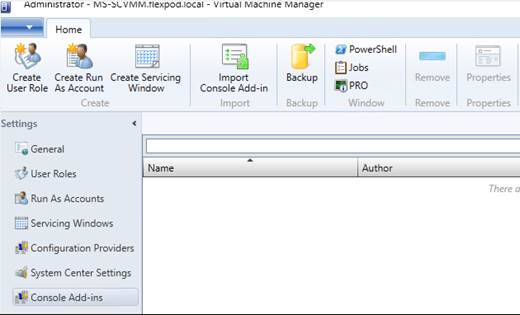
7. Click Browse and navigate to the location where the zipped file is saved.
8. Select the zip file and click Open. Click Next. Click Finish.

9. The add-in is installed and a new icon called Cisco UCS Manager appears in the toolbar.

Cisco UCS Domain Registration:
You can register domains using any access privileges. Depending on the privileges available to the user with which UCS domain is registered, some or all actions may be disabled.
Perform the following steps to register a UCS domain:
1. On the toolbar, click Cisco UCS Manager.
2. Right-click on UCS Domains.
3. Click Add UCS Domain.
4. The Add UCS Domain dialog box appears.
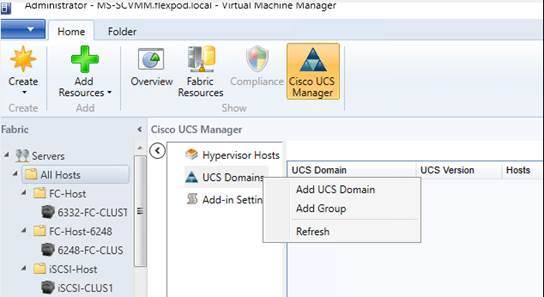
5. Enter the following details in the dialog box:
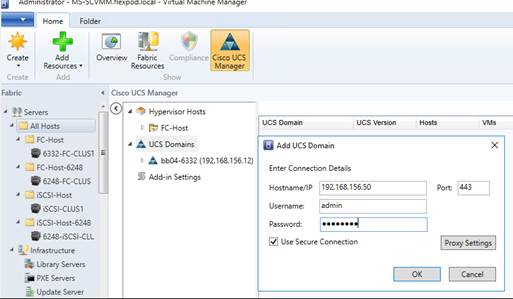
![]() If required, you can edit the UCS domain details at a later time.
If required, you can edit the UCS domain details at a later time.
6. Click Proxy Settings. Proxy Settings dialog box appears.
7. In the Proxy Settings dialog box, click Use Custom Proxy Settings radio button and enter the following details:
![]() If required, you can edit the proxy settings at a later time.
If required, you can edit the proxy settings at a later time.
8. Click OK.
The registered UCS domain appears under the UCS domains node. Upon adding a UCS domain, the Hyper-Visor hosts running on the newly added UCS domain appear under the Hyper-Visor Hosts node.
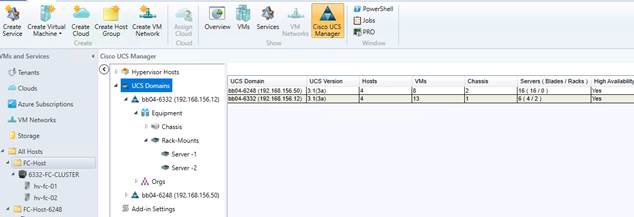
![]() You also can add UCS domains within groups. If you want to add a UCS domain within a group, right-click on the group and follow steps 3 through step 7 in the preceding procedure.
You also can add UCS domains within groups. If you want to add a UCS domain within a group, right-click on the group and follow steps 3 through step 7 in the preceding procedure.
Using the Cisco UCS SCVMM Plugin
Viewing the Server Details from the Hypervisor Host View
The following procedure provides steps to view server details:
1. On the toolbar, click Cisco UCS Manager.
2. In the Hypervisors node, select the Hypervisor host which is associated with the server.
| Name |
Description |
| General tab |
|
| Fault summary |
Displays the number of faults categorized based on fault severity. You can click on the severity fault icons in this section to view the fault details. |
| Properties |
Displays the properties of the server such as, server ID, UUID, serial number, associated service profiles and so on. If a service profile is associated with the server, a link to the location of the service profile is provided. Clicking on the link displays the properties of the associated service profile. |
| Status |
Indicates the status of the tasks running on the host. |
| Actions area |
|
| Associate Service Profile |
Enables you to associate a service profile to the server. |
| Disassociate Service Profile |
Enables you to disassociate a service profile from the server. |
| Set Desired Power State |
Provides options to set the power state of a service profile. |
| KVM Console |
Enables you to launch the KVM console. |
| Turn on Locator LED |
Enables you to either turn on or turn off the locator LED depending on the current state. |
| Firmware tab |
Provides the firmware details such as BIOS, CIMC, adaptors and storage device part IDs, and the firmware versions. If there are any changes to the firmware details on the server, those changes will reflect here. |
| Faults tab |
Displays the faults' details specific to the server, such as properties, severity, fault codes and IDs, description, affected objects, and so on. Provides options to filter the faults based on severity, and option under the Actions area to acknowledge the fault on UCS. |
3. On the right pane of the window, you can view the following information of the server on which the host is running:

Viewing Registered UCS Domains
1. On the toolbar, click Cisco UCS Manager.
2. Click UCS Domains. The list of registered UCS domains and consolidated UCS information for each domain, such as the name and version, number of associated hosts, VMs and servers appear on the right pane of the window as shown in the above figure.
3. (Optional) You can view the details in the grid view or the card view by clicking View option on the right-top corner and choosing the appropriate option.
Viewing the UCS Blade Server Details
Using the add-in you can view the server details, such as properties, faults information, and firmware details. The following procedure provides steps to view server details:
1. On the toolbar, click Cisco UCS Manager.
2. Under the UCS Domains node, expand the UCS domain.
3. Expand Equipment > Chassis. A list of chassis appears.
4. Choose a chassis.
5. The list of blade servers on the chassis appears under the chassis on the left pane. You can also view the list of blade servers on the right pane on the window.
6. Select the blade for which you want to view the details.
7. The properties of the blade appear on the right pane of the window. You can view the following server information as shown in the table below.
| Name |
Description |
| General tab |
|
| Fault summary |
Displays the number of faults categorized based on fault severity. You can click on the severity fault icons in this section to view the fault details. |
| Properties |
Displays the properties of the server such as, chassis ID, UUID, serial number, associated service profiles and so on. If a service profile is associated with the blade, a link to the location of the service profile is provided. Clicking on the link displays the properties of the associated service profile. |
| Status |
Indicates the status of the server. |
| Actions area |
|
| Set Desired Power State |
Provides options to set the power state of a service profile. |
| KVM Console |
Enables you to launch the KVM console. |
| Rename Service Profile |
Enables you to rename a service profile. |
| Associate Service Profiles |
Enables you to associate a service profile to the server. |
| Turn on Locator LED |
Enables you to either turn on or turn off the locator LED depending on the current state. |
| Disassociate Service Profile |
Enables you to disassociate a service profile from the server. |
| Firmware tab |
Provides the firmware details such as BIOS, CIMC, adaptors and storage device part IDs and the firmware versions. If there are any changes to the firmware details on the server, those changes will reflect here. |
| Faults tab |
Displays the faults' details specific to the server such as properties, severity, fault codes and IDs, description, affected objects, and so on. Provides options to filter the faults based on severity, and option under the Actions area to acknowledge the fault on UCS. |
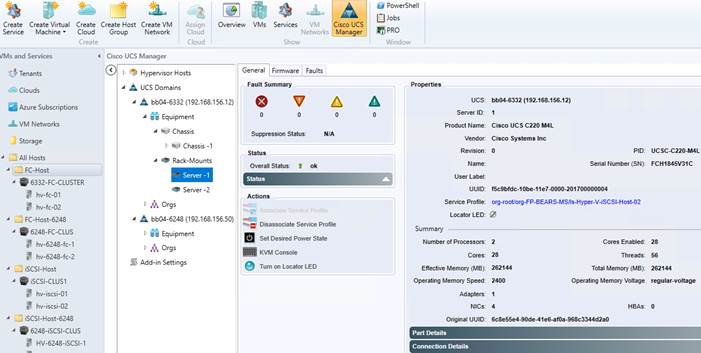
Viewing the UCS Rack-Mount Server Details:
Using the add-in you can view the details such as properties, faults information, and firmware details of the servers on which the host is running. The following procedure provides steps to view server details:
1. On the toolbar, click Cisco UCS Manager.
2. In the UCS Domains node, expand the UCS domain.
3. Expand Equipment > Rack-Mounts.
4. The list of registered UCS rack-mount servers appears.
5. Choose the server for which you want to view the details.
6. The properties of the rack-mount server appear on the right pane of the window. You can view the following server information:
| Name |
Description |
| General tab |
|
| Fault summary |
Displays the number of faults categorized based on fault severity. You can click on the severity fault icons in this section to view the fault details. |
| Properties |
Displays the properties of the server such as, server ID, UUID, serial number, associated service profiles and so on. If a service profile is associated with the server, a link to the location of the service profile is provided. Clicking on the link displays the properties of the associated service profile. |
| Status |
Indicates the status of the server. |
| Actions area |
|
| Set Desired Power State |
Provides options to set the power state of a service profile. |
| KVM Console |
Enables you to launch the KVM console. |
| Rename Service Profile |
Enables you to rename a service profile. |
| Associate Service Profiles |
Enables you to associate a service profile to the server. |
| Turn on Locator LED |
Enables you to either turn on or turn off the locator LED depending on the current state. |
| Disassociate Service Profile |
Enables you to disassociate a service profile from the server. |
| Firmware tab |
Provides the firmware details such as BIOS, Cisco IMC, adaptors and storage device part IDs and the firmware versions. If there are any changes to the firmware details on the server, those changes will reflect here. |
| Faults tab |
Displays the faults' details specific to the server such as properties, severity, fault codes and IDs, description, affected objects, and so on. Provides options to filter the faults based on severity, and option under the Actions area to acknowledge the fault on UCS. |
Viewing the Service Profile Details
Using the add-in you can view the service profile details, such as properties, and faults information. The following procedure provides steps to view the service profile details:
1. On the toolbar, click Cisco UCS Manager.
2. In the UCS Domains node, expand the UCS domain.
3. Expand Orgs > root.
4. Choose Service Profiles.
5. The list of service profiles and associated information appear on the right pane of the window. The server column lists the links to the servers that the service profile is associated with. Click the link to view the details of the server.
6. Click the service profile for which you want to view the details.
7. The service profile details appear on the right pane of the window. You can view the following service profile information:
| Name |
Description |
| General tab |
|
| Fault summary |
Displays the number of faults and the severity of the faults. |
| Properties |
Displays the properties of the service profile such as, name, associated server, service profile template used and so on. |
| Status |
Indicates the status of the service profile. |
| Actions area |
|
| Set Desired Power State |
Provides options to set the power state of the server. |
| KVM Console |
Enables you to launch the KVM console. |
| Rename Service Profile |
Enables you to rename a service profile. |
| Create a Clone |
Enables you to create a clone of the service profile by inheriting the attributes of the service profile. |
| Disassociate Service Profile |
Enables you to disassociate the service profile from the server. |
| Change Host Firmware Package |
Enables you to change the host firmware association. |
| Change Service Profile Association |
Enables you to upgrade the host firmware on the servers. |

Viewing the Service Profile Template Details
Using the add-in you can view the service profile template details, such as properties, and faults information. The following procedure provides steps to view the service profile template details:
1. On the toolbar, click Cisco UCS Manager.
2. In the UCS Domains node, expand the UCS domain.
3. Expand Orgs > root.
4. Expand Service Profile Templates and select the service profile template for which you want to view the details.
5. You can view the following service profile template information on the right pane of the window:
| Name |
Description |
| General tab |
|
| Properties area |
Displays the properties of the service profile template, such as name, type and so on. |
| Actions area |
|
| Create Service Profile from Templates |
Enables you to use the template to create a service profile. |
| Create a Clone |
Enables you to create a clone of the service profile template by inheriting the attributes of the |

Viewing the Host Firmware Package Details
Using the add-in you can view the host firmware packages properties. The following procedure provides steps to view the host firmware packages details:
1. On the toolbar, click Cisco UCS Manager.
2. In the UCS Domains node, expand the UCS domain.
3. Expand Orgs > root.
4. Expand Host Firmware Packages and select the host firmware package for which you want to view the details.
You can view the following host firmware package information on the right pane of the window:
| Name |
Description |
| General tab |
|
| Properties area |
Displays the properties of the host firmware package, such as name, description, ownership information, package version and so on. |
| Actions area |
|
| Modify Package Versions |
Enables you to modify Blade package version and Rack package version properties. |
OnCommand Unified Manager 7.2
1. Deploy a Windows Server 2016 Virtual Machine for the OnCommand installation.
2. Download and review the OnCommand Unified Manager 7.2 Installation and Setup Guide for Microsoft Windows
3. Download OnCommand Unified Manager version 7.2 from http://mysupport.netapp.com to the virtual machine.
4. Follow the instructions to install OnCommand after double-clicking on the executable.
5. After installation, fill in Setup Email, Time Settings and enable Autosupport
6. To add your cluster for monitoring, Click on Add from the main dashboard as seen in figure 7 and fill in your cluster details as seen in figure 8.
Figure 7 NetApp OnCommand Dashboard
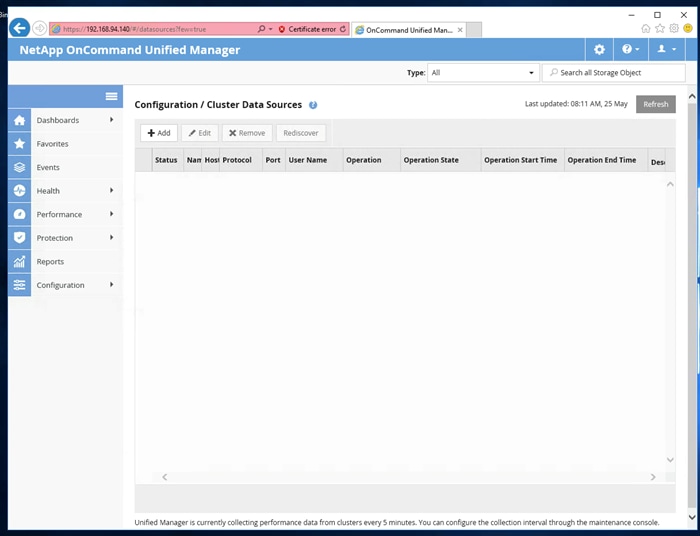
Figure 8 NetApp OnCommand - Add a cluster
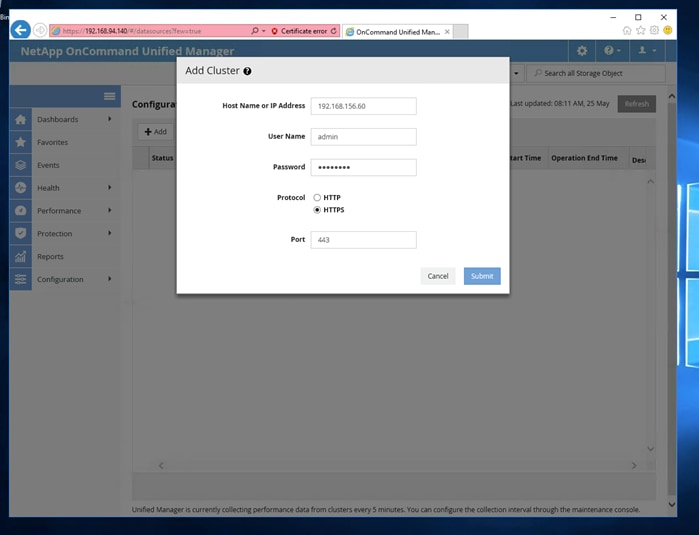
NetApp SnapDrive 7.1.3
SnapDrive 7.1.3 for Windows enables you to automate storage provisioning tasks and to manage data in physical or virtual Microsoft Windows hosts, in SMB 3.0 environments.
You can use the following steps to install SnapDrive 7.1.3 for Windows on Microsoft Hyper-V Hosts. These steps assume that prerequisites have been verified.
Configuring access for SnapDrive for Windows
You can use the following steps to configure access for SnapDrive 7.1.3 for Windows:
1. Create a user account on the storage system by entering the following command: security login create –vserver –user –authentication-method –application –role.
The variables represent the following values:
· Vserver is the name of the Vserver for the user to be created.
· User is the name of the SnapDrive user.
· authentication-method is the method used for authentication
· application is the option you use to specify how the user will access.
· role is the privileges this user will have.
For example,
The following command adds a user called “snapdrive” to the BUILTIN\Administrators group on the storage system:
security login create -vserver Infra-MS-SVM -user snapdrive –authentication
method password -application ssh -role vsadmin
![]() You must provide this user name later in this procedure. Therefore, make a note of the user name, including the letter case (lowercase or uppercase) of each character in the user name.
You must provide this user name later in this procedure. Therefore, make a note of the user name, including the letter case (lowercase or uppercase) of each character in the user name.
2. Enter a password, when prompted to do so, for the user account you are creating.
3. You are prompted to enter the password twice. You are required to provide this password later, so make a note of it, including letter case.
4. Check to ensure that the user account you just created belongs to the local administrator's group on the storage system by entering the following command:
security login show
For additional information, see the section about creating local groups on the storage system in the Data ONTAP File Access and Protocols Management Guide for 7-Mode.
5. On each Windows host that needs access to the storage system, create a local user account with administrative rights on the host, using the same user name and password that you specified in Step 1 and Step 2.
![]() Set up the local user account so that the password for the account never expires. For detailed instructions on how to create local user accounts, see your Windows documentation.
Set up the local user account so that the password for the account never expires. For detailed instructions on how to create local user accounts, see your Windows documentation.
Downloading SnapDrive for Windows
Before installing SnapDrive for Windows, you must download the software package from the NetApp Support Site.
Before you begin you need the NetApp Support Site login credentials .
Steps
1. Log in to the NetApp Support Site.
2. Go to the Download Software page.
3. From the drop-down list, select the operating system on which you are installing SnapDrive and click Go!.
4. Click View & Download for the software version you want to install.
5. On the SnapDrive for Windows Description page, click Continue.
6. Review and accept the license agreement.
7. On the Download page, click the link for the installation file.
8. Save the SnapManager for Hyper-V file to a local or network directory.
9. Click Save File.
10. Verify the checksum to ensure that the software downloaded correctly.
Installing SnapDrive for Windows
1. Launch the SnapDrive for Windows installer, and then follow the Installation wizard instructions.
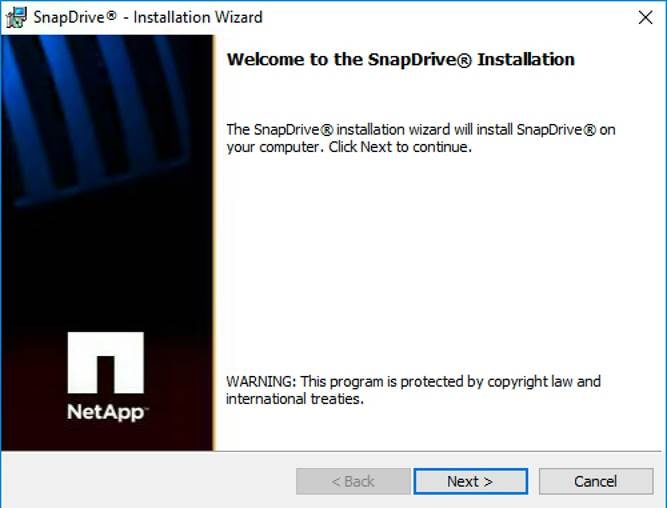
2. In the SnapDrive License screen, select the appropriate license type.
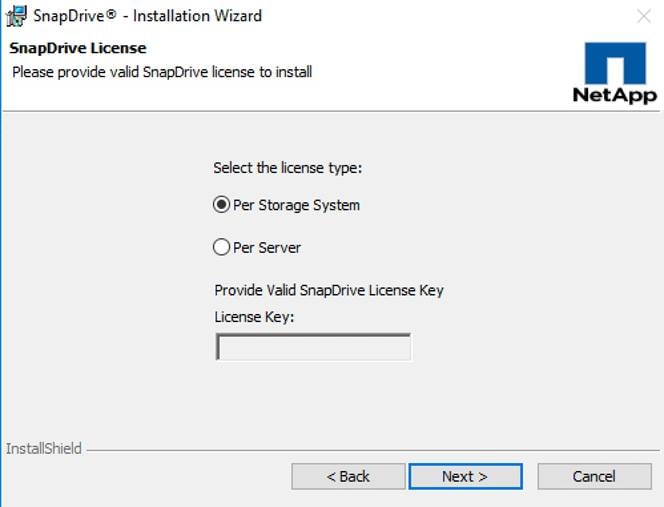
3. In the Customer Information screen, enter the appropriate information.
4. In the Destination Folder screen, enter the appropriate destination or accept default.
5. In the SnapDrive Credentials screen, enter the account and password information of an account that is a member of the local administrators

6. In the SnapDrive Web Service Configuration screen, accept the default port numbers.
If you want to change the port numbers, you should also change the port numbers for other SnapDrive hosts.

7. In the Preferred IP Address screen, identify the IP address you want to use to communicate with the storage system.
You should configure the preferred IP address, because doing this improves performance and scalability.
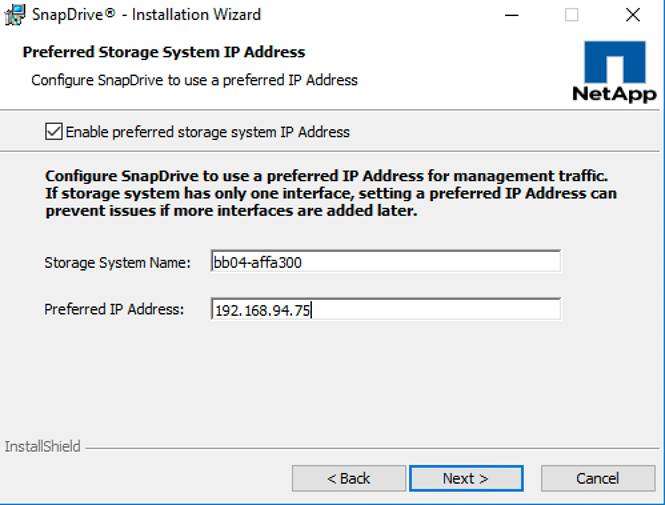
8. In the Transport Protocol Default Setting screen, enable the storage protocol settings. RPC is not supported in clustered Data ONTAP.

9. In the Unified Manager Configuration Screen, click next.
![]() OnCommand Unified Manager Core Package data protection capabilities are available only in 7- Mode environments.
OnCommand Unified Manager Core Package data protection capabilities are available only in 7- Mode environments.
10. In the Ready to Install screen, click Install.
11. When you have completed the Installation wizard instructions, click Finish.
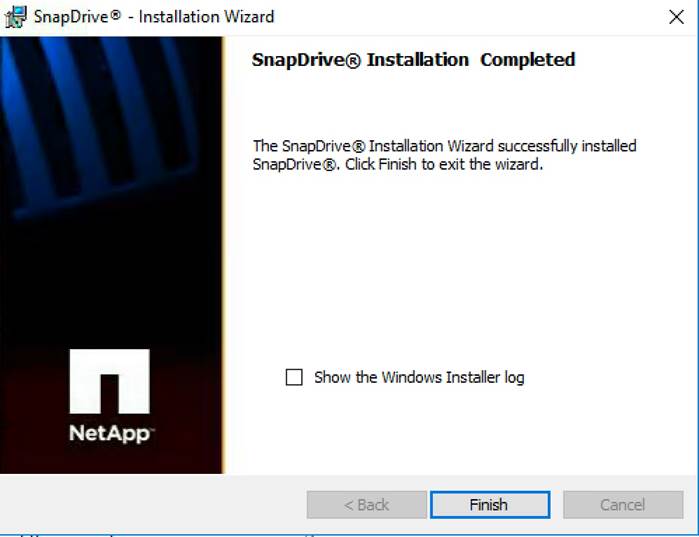
NetApp SnapManager for Hyper-V
SnapManager for Hyper-V provides a solution for data protection and recovery for Microsoft® Hyper-V virtual machines (VMs) running on ONTAP® software. You can perform application-consistent and crash-consistent dataset backups according to protection policies set by your backup administrator. You can also restore VMs from these backups. Reporting features enable you to monitor the status of and get detailed information about your backup and restore jobs.
You can use the following steps to install SnapManager 2.1.2 for Hyper-V.
Downloading SnapManager for Hyper-V
Before installing SnapManager for Hyper-V, you must download the software package from the NetApp Support Site.
Before you begin you must have login credentials for the NetApp Support Site.
Steps
1. Log in to the NetApp Support Site.
2. Go to the Download Software page.
3. From the drop-down list, select the operating system on which you are installing SnapManager for Hyper-V and click Go!.
4. Click View & Download for the software version you want to install.
5. On the Description page, click Continue.
6. Review and accept the license agreement.
7. On the Download page, click the link for the installation file.
8. Save the SnapManager for Hyper-V file to a local or network directory.
9. Click Save File.
10. Verify the checksum to ensure that the software downloaded correctly.
Installing SnapManager for Hyper-V
1. Launch the SnapManager for Hyper-V executable file, and then follow the Installation wizard instructions.
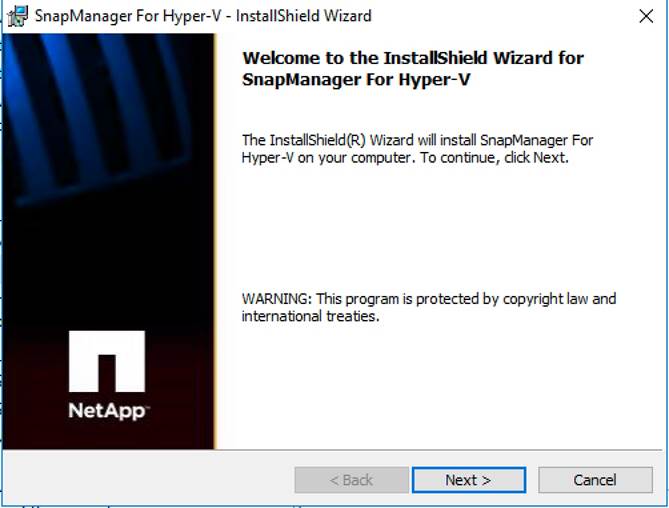
2. In the SnapManager for Hyper-V License screen, select the appropriate license type.

3. Select the installation location and click Next.
4. In the SnapManager for Hyper-V Credentials screen, enter the account and password information of an account that is a member of the local administrators.
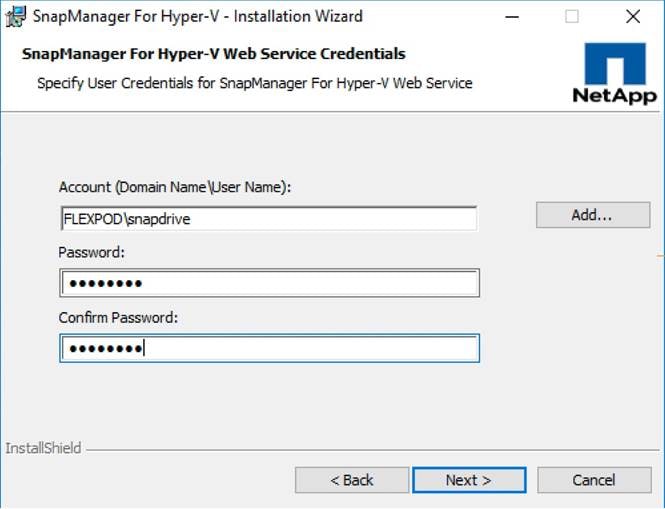
5. In the SnapDrive Web Service Configuration screen, accept the default port numbers.

6. Click Install on the Ready to Install page.
7. Review the summary of your selections and click Finish.
Provisioning a Sample Application Tenant
This section describes a sample procedure for provisioning an application tenant. The procedure here refers back to previous sections of this document and can be used as a guide and modified as needed when provisioning an application tenant.
1. Plan your application tenant and determine what storage protocols will be provided in the tenant. In the architecture covered in this document, fiber channel, iSCSI, FCoE and CIFS/SMB can be provided to the tenant. Also, plan what network VLANs the tenant will use.
2. In the Nexus switches, declare all added VLANs and configure the VM VLAN as an allowed VLAN on the UCS port channels and the vPC peer link. Also, Layer 3 with HSRP or VRRP can be configured in the Nexus switches to provide this VLAN access to the outside. Layer 3 setup is not covered in this document, but is covered in the Nexus 9000 documentation. Configure the storage VLANs on the UCS and storage port channels, and on the vPC peer link. The VM VLAN can also be added to the storage port channels in order to configure the tenant SVM management interface on this VLAN.
3. In the storage cluster:
a. Create a broadcast domain with MTU 1500 for the tenant SVM management interface. Create a broadcast domain with MTU 9000 for each tenant storage protocol except fiber channel.
b. Create VLAN interface ports on the node interface group on each node for tenant SVM management (VM VLAN) and for the VLAN for each storage protocol except fiber channel. Add these VLAN ports to the appropriate broadcast domains.
c. Create the tenant SVM and follow all procedures in that section.
d. Create Load-Sharing Mirrors for the tenant SVM.
e. Create the FC service for the tenant SVM if fiber channel is being deployed in this tenant.
f. Optionally, create a self-signed security certificate for the tenant SVM.
g. Configure CIFS for the tenant SVM.
h. Create a volume and CIFS share in the tenant SVM.
i. Create a once-a-day deduplication schedule on the volume.
j. If fiber channel is being deployed in this tenant, configure four FCP LIFs in the tenant SVM on the same fiber channel ports as in the Infrastructure SVM.
k. Create SMB LIFs in the tenant SVM on each storage node.
l. Create a boot LUN in the HV_boot volume in the Infra-MS-SVM for each tenant Hyper-V host.
m. Add the tenant SVM Administrator, SVM management LIF on the SVM management VLAN port, and default route for the SVM.
4. In the UCS one method of tenant setup is to dedicate a Hyper-V cluster and set of UCS servers to each tenant. Service profiles will be generated for at least two tenant Hyper-V hosts. These hosts can boot from LUNs from the HV_boot volume in the Infra-MS-SVM, but will also have access to FC storage in the tenant SVM.
a. Create a Server Pool for the tenant Hyper-V host servers.
b. Create all tenant VLANs in the LAN Cloud.
c. Add the tenant VLANs to the DVS vNIC templates.
Generate service profiles from the service profile template with the vMedia policy for the tenant Hyper-V hosts. Remember to bind these service profiles to the service profile template without the vMedia policy after Windows Server 2016 installation.
5. In the Cisco MDS 9148S switches:
a. Create device aliases for the tenant Hyper-V host vHBAs and the FC LIFs in the tenant storage SVM.
b. Create zones for the tenant Hyper-V hosts with fiber channel targets from both the storage Infra-MS-SVM and the tenant SVM.
c. Add these zones to the Fabric zoneset and activate the zoneset.
6. In the storage cluster:
a. Create igroups for the tenant Hyper-V hosts in both the Infra-MS-SVM and tenant SVM. Also, create an igroup in the tenant SVM that includes the WWPNs for all tenant Hyper-V hosts to support shared storage from the tenant SVM.
b. In Infra-MS-SVM, map the boot LUNs created earlier to the tenant Hyper-V hosts.
7. Install and configure Windows Server 2016 on all tenant host servers. It is not necessary to map infra_datastore_1.
8. In System Center VMM, create a cluster for the tenant Hyper-V hosts. Add the hosts to the cluster.
9. Using the VMM console, add the tenant hosts to the Host groups and apply the logical switch to the hosts.
10. After applying the logical switch to the Hyper-V host from the VMM, verify, check and enable the VM adapters created on the hosts for MTU, RSS and RDMA are set correctly. Mount the tenant CIFS datastore on the tenant cluster if one was created.
This FlexPod deployment will show configuration steps for both the Cisco UCS 6332-16UP and Cisco UCS 6248UP Fabric Interconnects (FI) in a design that will support Ethernet connectivity to the NetApp AFF through the Cisco Nexus 9000.
Configuration steps will be referenced for both fabric interconnects and will be called out by the specific model where steps have differed.
This section contains the UCS deployment for end-to-end 10/40 Gb Ethernet connections between the Cisco UCS 5108 Blade Chassis and C-Series rackmounts and the Cisco UCS Fabric Interconnect, between the Cisco UCS Fabric Interconnect and Cisco Nexus 9000, and between Cisco Nexus 9000 and NetApp AFF A300. This infrastructure is deployed to provide iSCSI-booted hosts with block-level access to shared storage.
Figure 9 shows the Microsoft Hyper-V 2016 built on FlexPod components and the network connections for a configuration with the Cisco UCS 6332-16UP Fabric Interconnects. This design has end-to-end 40 Gb Ethernet connections between the Cisco UCS 5108 Blade Chassis and C-Series rackmounts and the Cisco UCS Fabric Interconnect, between the Cisco UCS Fabric Interconnect and Cisco Nexus 9000, and between Cisco Nexus 9000 and NetApp AFF A300.
Figure 9 Nexus 9000 based FlexPod – Cisco UCS 6332 Fabric Interconnects and 40GbE End to End – iSCSI
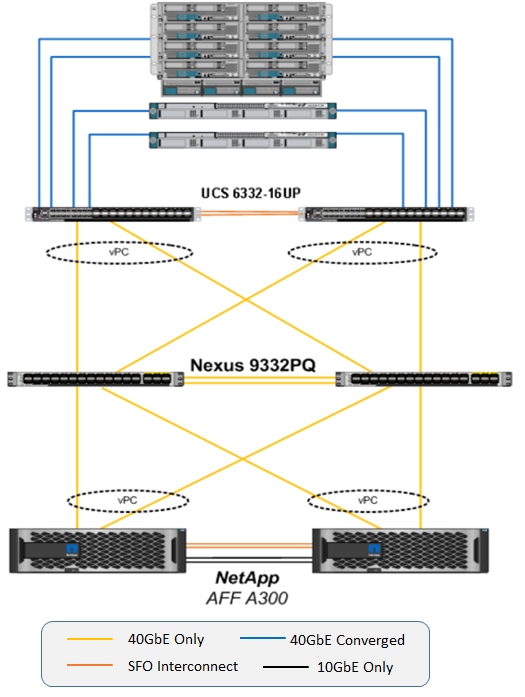
Figure 10 shows the Hyper-V built on FlexPod components and the network connections for a configuration with the Cisco UCS 6248UP Fabric Interconnects. This design is identical to the 6332-16UP based topology, but has 10 Gb Ethernet connecting through a pair of Cisco Nexus 93180YC-EX switches to access iSCSI access to the AFF A300. Alternately, the Cisco Nexus 9332PQ switch can be used with the Cisco UCS 6248UP with a QSFP breakout cable and port configuration setting on the 9332PQ switch.
Figure 10 Nexus 9000 based FlexPod – Cisco UCS 6248UP Fabric Interconnects and 10GbE End to End – iSCSI

Network Switch Configuration
This section provides a detailed procedure for configuring the Cisco Nexus 9000s for use in a FlexPod environment. Follow these steps precisely because failure to do so could result in an improper configuration.
Physical Connectivity
Figure 11 FlexPod Cabling with Cisco UCS 6332-16UP Fabric Interconnect
Figure 12 FlexPod Cabling with Cisco UCS 6248UP Fabric Interconnect
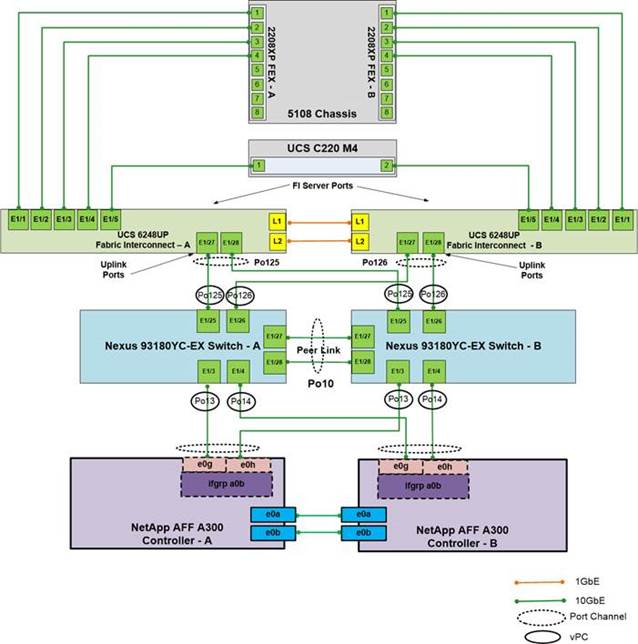
Create VLANs
To create the necessary virtual local area networks (VLANs), complete the following step on both switches.
From the global configuration mode, run the following commands:
vlan <ms-ib-mgmt-vlan-id>
name MS-IB-MGMT-VLAN
vlan <native-vlan-id>
name Native-VLAN
vlan < ms-lvmn-vlan-id>
name MS-LVMN-VLAN
vlan <ms-tenant-vm-vlan-id>
name MS-Tenant-VM-VLAN
vlan <ms-Cluster-vlan-id>
name MS-Cluster-VLAN
vlan <ms--iSCSI-A-vlan-id>
name MS-iSCSI-A-VLAN
vlan <ms-iSCSI-B-vlan-id>
name MS-iSCSI-B-VLAN
exit
Add NTP Distribution Interface
Cisco Nexus A
From the global configuration mode, run the following commands:
ntp source <switch-a-ntp-ip>
interface Vlan<ib-mgmt-vlan-id>
ip address <switch-a-ntp-ip>/<ib-mgmt-vlan-netmask-length>
no shutdown
exit
Cisco Nexus B
From the global configuration mode, run the following commands:
ntp source <switch-b-ntp-ip>
interface Vlan<ib-mgmt-vlan-id>
ip address <switch-b-ntp-ip>/<ib-mgmt-vlan-netmask-length>
no shutdown
exit
Add Individual Port Descriptions for Troubleshooting
Cisco Nexus A
To add individual port descriptions for troubleshooting activity and verification for switch A, complete the following step:
![]() In this step and in the later sections, configure the AFF nodename <st-node> and Cisco UCS 6332-16UP or Cisco UCS 6248UP fabric interconnect clustername <ucs-clustername> interfaces as appropriate to your deployment.
In this step and in the later sections, configure the AFF nodename <st-node> and Cisco UCS 6332-16UP or Cisco UCS 6248UP fabric interconnect clustername <ucs-clustername> interfaces as appropriate to your deployment.
From the global configuration mode, run the following commands:
interface Eth1/3
description <st-node>-1:e2a
interface Eth1/4
description <st-node>-2:e2a
interface Eth1/25
description <ucs-clustername>-a:1/27
interface Eth1/26
description <ucs-clustername>-b:1/27
interface Eth1/27
description <nexus-hostname>-b:1/27
interface Eth1/28
description <nexus-hostname>-b:1/28
exit
Cisco Nexus B
To add individual port descriptions for troubleshooting activity and verification for switch B, complete the following step:
From the global configuration mode, run the following commands:
interface Eth1/3
description <st-node>-1:e2e
interface Eth1/4
description <st-node>-2:e2e
interface Eth1/25
description <ucs-clustername>-a:1/28
interface Eth1/26
description <ucs-clustername>-b:1/28
interface Eth1/27
description <nexus-hostname>-a:1/27
interface Eth1/28
description <nexus-hostname>-a:1/28
exit
Create Port Channels
Cisco Nexus A and Cisco Nexus B
To create the necessary port channels between devices, complete the following step on both switches:
From the global configuration mode, run the following commands:
interface Po10
description vPC peer-link
interface Eth1/27-28
channel-group 10 mode active
no shutdown
interface Po13
description <st-node>-1
interface Eth1/3
channel-group 13 mode active
no shutdown
interface Po14
description <st-node>-2
interface Eth1/4
channel-group 14 mode active
no shutdown
interface Po125
description <ucs-clustername>-a
interface Eth1/25
channel-group 125 mode active
no shutdown
interface Po126
description <ucs-clustername>-b
interface Eth1/26
channel-group 126 mode active
no shutdown
exit
copy run start
Configure Port Channel Parameters
Cisco Nexus A and Cisco Nexus B
To configure port channel parameters, complete the following step on both switches:
From the global configuration mode, run the following commands:
interface Po10
switchport mode trunk
switchport trunk native vlan 2
switchport trunk allowed vlan <ms-ib-mgmt-vlan-id>, < ms-lvmnvlan-id>, <ms-tenant-vm-vlan-id>, <ms-iSCSI-A-vlan-id>, <ms-iSCSI-B-vlan-id>, < ms-cluster-vlan-id>
spanning-tree port type network
interface Po13
switchport mode trunk
switchport trunk native vlan 2
switchport trunk allowed vlan < ms-iSCSI-A-vlan-id >, < ms-iSCSI-B-vlan-id >
spanning-tree port type edge trunk
mtu 9216
interface Po14
switchport mode trunk
switchport trunk native vlan 2
switchport trunk allowed vlan <ms-iSCSI-A-vlan-id>, <ms-iSCSI-B-vlan-id>
spanning-tree port type edge trunk
mtu 9216
interface Po125
switchport mode trunk
switchport trunk native vlan 2
switchport trunk allowed vlan <ms-ib-mgmt-vlan-id>, < ms-lvmn-vlan-id>, <ms-tenant-vm-vlan-id>, <ms-iSCSI-A-vlan-id>, <ms-iSCSI-B-vlan-id>
spanning-tree port type edge trunk
mtu 9216
interface Po126
switchport mode trunk
switchport trunk native vlan 2
switchport trunk allowed vlan <ms-ib-mgmt-vlan-id>, < ms-lvmn-vlan-id>, <ms-tenant-vm-vlan-id>, <ms-iSCSI-A-vlan-id>, <ms-iSCSI-B-vlan-id>,< ms-cluster-vlan-id>
spanning-tree port type edge trunk
mtu 9216
exit
copy run start
Configure Virtual Port Channels
Cisco Nexus A
To configure virtual port channels (vPCs) for switch A, complete the following step:
From the global configuration mode, run the following commands:
vpc domain <nexus-vpc-domain-id>
role priority 10
peer-keepalive destination <nexus-B-mgmt0-ip> source <nexus-A-mgmt0-ip>
peer-switch
peer-gateway
auto-recovery
delay restore 150
interface Po10
vpc peer-link
interface Po13
vpc 13
interface Po14
vpc 14
interface Po125
vpc 125
interface Po126
vpc 126
exit
copy run start
Cisco Nexus B
To configure vPCs for switch B, complete the following step:
From the global configuration mode, run the following commands:
vpc domain <nexus-vpc-domain-id>
role priority 20
peer-keepalive destination <nexus-A-mgmt0-ip> source <nexus-B-mgmt0-ip>
peer-switch
peer-gateway
auto-recovery
delay restore 150
interface Po10
vpc peer-link
interface Po13
vpc 13
interface Po14
vpc 14
interface Po125
vpc 125
interface Po126
vpc 126
exit
copy run start
Uplink into Existing Network Infrastructure
Depending on the available network infrastructure, several methods and features can be used to uplink the FlexPod environment. If an existing Cisco Nexus environment is present, we recommend using vPCs to uplink the Cisco Nexus switches included in the FlexPod environment into the infrastructure. The previously described procedures can be used to create an uplink vPC to the existing environment. Make sure to run copy run start to save the configuration on each switch after the configuration is completed.
Storage Configuration
Create Jumbo Frame MTU Broadcast Domains in ONTAP
To create a data broadcast domain with an MTU of 9000, run the following commands to create a broadcast domain for SMB and iSCSI on ONTAP:
broadcast-domain create -broadcast-domain Infra_MS_iSCSI-A -mtu 9000
broadcast-domain create -broadcast-domain Infra_MS_iSCSI-B -mtu 9000
Create VLANs
To create iSCSI VLAN, create iSCSI VLAN ports and add them to the iSCSI broadcast domain:
network port vlan create –node <st-node01> -vlan-name a0a-<infra-iscsi-A-vlan-id>
network port vlan create –node <st-node01> -vlan-name a0a-<infra-iscsi-B-vlan-id>
network port vlan create –node <st-node02> -vlan-name a0a-<infra-iscsi-A-vlan-id>
network port vlan create –node <st-node02> -vlan-name a0a-<infra-iscsi-B-vlan-id>
broadcast-domain add-ports -broadcast-domain Infra_MS_iSCSI-A -ports <st-node01>:a0a-<infra-iSCSI-A-vlan-id>, <st-node02>:a0a-<infra-iSCSI-A-vlan-id>
broadcast-domain add-ports -broadcast-domain Infra_MS_iSCSI-B -ports <st-node01>:a0a-<infra-iSCSI-B-vlan-id>, <st-node02>:a0a-<infra-iSCSI-B-vlan-id>
Run the following command to create the iSCSI service on each SVM. This command also starts the iSCSI service and sets the iSCSI Qualified Name (IQN) for the SVM.
iscsi create -vserver Infra-MS-SVM
iscsi show
Create iSCSI LIFs
Run the following commands to create four iSCSI LIFs (two on each node):
network interface create -vserver Infra-MS-SVM -lif iscsi_lif01a -role data -data-protocol iscsi -home-node <st-node01> -home-port a0a-<infra-iscsi-a-vlan-id> -address <var_node01_iscsi_lif01a_ip> -netmask <var_node01_iscsi_lif01a_mask> –status-admin up –failover-policy disabled –firewall-policy data –auto-revert false
network interface create -vserver Infra-MS-SVM -lif iscsi_lif01b -role data -data-protocol iscsi -home-node <st-node01> -home-port a0a-<infra-iscsi-b-vlan-id> -address <var_node01_iscsi_lif01b_ip> -netmask <var_node01_iscsi_lif01b_mask> –status-admin up –failover-policy disabled –firewall-policy data –auto-revert false
network interface create -vserver Infra-MS-SVM -lif iscsi_lif02a -role data -data-protocol iscsi -home-node <st-node02> -home-port a0a-<infra-iscsi-a-vlan-id> -address <var_node02_iscsi_lif02a_ip> -netmask <var_node02_iscsi_lif02a_mask> –status-admin up –failover-policy disabled –firewall-policy data –auto-revert false
network interface create -vserver Infra-MS-SVM -lif iscsi_lif02b -role data -data-protocol iscsi -home-node <st-node02> -home-port a0a-<infra-iscsi-b-vlan-id> -address <var_node02_iscsi_lif02b_ip> -netmask <var_node02_iscsi_lif02b_mask> –status-admin up –failover-policy disabled –firewall-policy data –auto-revert false
network interface show
Server Configuration
Perform Initial Setup of Cisco UCS 6332-16UP Fabric Interconnects for FlexPod Environments
This section provides detailed procedures for configuring the Cisco Unified Computing System (Cisco UCS) for use in a FlexPod environment. The steps are necessary to provision the Cisco UCS B-Series and C-Series servers and should be followed precisely to avoid improper configuration.
Create Uplink Port Channels to Cisco Nexus Switches
To configure the necessary port channels out of the Cisco UCS environment, complete the following steps:
1. In Cisco UCS Manager, click LAN on the left.
![]() In this procedure, two port channels are created: one from fabric A to both Cisco Nexus switches and one from fabric B to both Cisco Nexus switches.
In this procedure, two port channels are created: one from fabric A to both Cisco Nexus switches and one from fabric B to both Cisco Nexus switches.
2. Under LAN > LAN Cloud, expand the Fabric A tree.
3. Right-click Port Channels.
4. Select Create Port Channel.
5. Enter 125 as the unique ID of the port channel.
6. Enter vPC-125-Nexus as the name of the port channel.
7. Click Next.
8. Select the ports connected to the Nexus switches to be added to the port channel:
9. Click >> to add the ports to the port channel.
10. Click Finish to create the port channel.
11. Click OK.
12. In the navigation pane, under LAN > LAN Cloud, expand the fabric B tree.
13. Right-click Port Channels.
14. Select Create Port Channel.
15. Enter 126 as the unique ID of the port channel.
16. Enter vPC-126-Nexus as the name of the port channel.
17. Click Next.
18. Select the ports connected to the Nexus switches to be added to the port channel:
19. Click >> to add the ports to the port channel.
20. Click Finish to create the port channel.
21. Click OK.
22. Create MAC Address Pools
23. To configure the necessary MAC address pools for the Cisco UCS environment, complete the following steps:
24. 1 In Cisco UCS Manager, click LAN on the left.
25. Select Pools > root.
![]() In this procedure, two MAC address pools are created, one for each switching fabric.
In this procedure, two MAC address pools are created, one for each switching fabric.
26. Right-click MAC Pools under the root organization.
27. Select Create MAC Pool to create the MAC address pool.
28. Enter MAC-POOl-A as the name of the MAC pool.
29. Optional: Enter a description for the MAC pool.
30. Select Sequential as the option for Assignment Order.
31. Click Next.
32. Click Add.
33. Specify a starting MAC address.
![]() For the FlexPod solution, the recommendation is to place 0A in the next-to-last octet of the starting MAC address to identify all of the MAC addresses as fabric A addresses. In our example, we have carried forward the same and also have embedded the UCS domain number information to give us 00:25:B5:52:0A:00 as our first MAC address.
For the FlexPod solution, the recommendation is to place 0A in the next-to-last octet of the starting MAC address to identify all of the MAC addresses as fabric A addresses. In our example, we have carried forward the same and also have embedded the UCS domain number information to give us 00:25:B5:52:0A:00 as our first MAC address.
34. Specify a size for the MAC address pool that is sufficient to support the available blade or server resources.
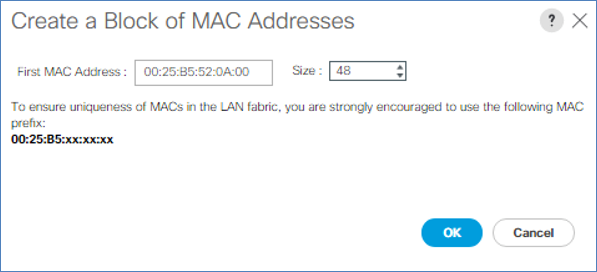
35. Click OK.
36. Click Finish.
37. In the confirmation message, click OK.
38. Right-click MAC Pools under the root organization.
39. Select Create MAC Pool to create the MAC address pool.
40. Enter MAC-POOL-B as the name of the MAC pool.
41. Optional: Enter a description for the MAC pool.
42. Select Sequential as the option for Assignment Order.
43. Click Next.
44. Click Add.
45. Specify a starting MAC address.
![]() For the FlexPod solution, it is recommended to place 0B in the next to last octet of the starting MAC address to identify all the MAC addresses in this pool as fabric B addresses. Once again, we have carried forward in our example and have embedded the UCS domain number information to give us 00:25:B5:52:0B:00 as our first MAC address.
For the FlexPod solution, it is recommended to place 0B in the next to last octet of the starting MAC address to identify all the MAC addresses in this pool as fabric B addresses. Once again, we have carried forward in our example and have embedded the UCS domain number information to give us 00:25:B5:52:0B:00 as our first MAC address.
46. Specify a size for the MAC address pool that is sufficient to support the available blade or server resources.
47. Click OK.
48. Click Finish.
49. In the confirmation message, click OK.
Create IQN Pools for iSCSI Boot
To configure the necessary IQN pools for the Cisco UCS environment, complete the following steps:
1. In Cisco UCS Manager, click SAN on the left.
2. Select Pools > root.
3. Right click IQN Pools.
4. Select Create IQN Suffix Pool to create the IQN pool.
5. Enter IQN-Pool for the name of the IQN pool
6. Optional: Enter a description for the IQN pool
7. Enter iqn.1992-08.com.cisco as the prefix.
8. Select Sequential for Assignment Order
9. Click Next.
10. Click Add.
11. Enter ucs-host as the suffix.
![]() If multiple Cisco UCS domains are being used, a more specific IQN suffix may need to be used.
If multiple Cisco UCS domains are being used, a more specific IQN suffix may need to be used.
12. Enter 1 in the From field.
13. Specify the size of the IQN block sufficient to support the available server resources.
14. Click OK.
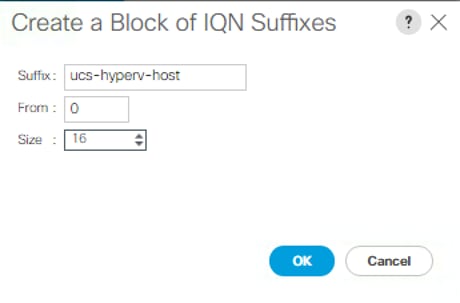
15. Click Finish.
Create IP Pools for iSCSI Boot
To configure the necessary IP pools iSCSI boot for the Cisco UCS environment, complete the following steps:
1. In Cisco UCS Manager, click LAN on the left.
2. Select Pools > root.
3. Right-click IP Pools.
4. Select Create IP Pool.
5. Enter iSCSI-IP-Pool-A as the name of IP pool.
6. Optional: Enter a description for the IP pool.
7. Select Sequential for the assignment order.
8. Click Next.
9. Click Add to add a block of IP address.
10. In the From field, enter the beginning of the range to assign as iSCSI IP addresses.
11. Set the size to enough addresses to accommodate the servers.
12. Click OK.
13. Click Next.
14. Click Finish.
15. Right-click IP Pools.
16. Select Create IP Pool.
17. Enter iSCSI-IP-Pool-B as the name of IP pool.
18. Optional: Enter a description for the IP pool.
19. Select Sequential for the assignment order.
20. Click Next.
21. Click Add to add a block of IP address.
22. In the From field, enter the beginning of the range to assign as iSCSI IP addresses.
23. Set the size to enough addresses to accommodate the servers.
24. Click OK.
25. Click Next.
26. Click Finish.
Create UUID Suffix Pool
To configure the necessary universally unique identifier (UUID) suffix pool for the Cisco UCS environment, complete the following steps:
1. In Cisco UCS Manager, click Servers on the left.
2. Select Pools > root.
3. Right-click UUID Suffix Pools.
4. Select Create UUID Suffix Pool.
5. Enter UUID-POOl as the name of the UUID suffix pool.
6. Optional: Enter a description for the UUID suffix pool.
7. Keep the prefix at the derived option.
8. Select Sequential for the Assignment Order.
9. Click Next.
10. Click Add to add a block of UUIDs.
11. Keep the From field at the default setting.
12. Specify a size for the UUID block that is sufficient to support the available blade or server resources.
13. Click OK.
14. Click Finish.
15. Click OK.
Create Server Pool
To configure the necessary server pool for the Cisco UCS environment, complete the following steps:
![]() Consider creating unique server pools to achieve the granularity that is required in your environment.
Consider creating unique server pools to achieve the granularity that is required in your environment.
1. In Cisco UCS Manager, click Servers on the left.
2. Select Pools > root.
3. Right-click Server Pools.
4. Select Create Server Pool.
5. Enter MS-Server-Pool as the name of the server pool.
6. Optional: Enter a description for the server pool.
7. Click Next.
8. Select two (or more) servers to be used for the Hyper-V management cluster and click >> to add them to the MS-Server-Pool server pool.
9. Click Finish.
10. Click OK.
Create VLANs
To configure the necessary virtual local area networks (VLANs) for the Cisco UCS environment, complete the following steps:
1. In Cisco UCS Manager, click LAN on the left.
![]() In this procedure, five unique VLANs are created. See Table 1.
In this procedure, five unique VLANs are created. See Table 1.
2. Select LAN > LAN Cloud.
3. Right-click VLANs.
4. Select Create VLANs.
5. Enter Native-VLAN as the name of the VLAN to be used as the native VLAN.
6. Keep the Common/Global option selected for the scope of the VLAN.
7. Enter the native VLAN ID.
8. Keep the Sharing Type as None.
9. Click OK, and then click OK again.

10. Expand the list of VLANs in the navigation pane, right-click the newly created Native-VLAN and select Set as Native VLAN.
11. Click Yes, and then click OK.
12. Right-click VLANs.
13. Select Create VLANs
14. Enter MS-IB-MGMT as the name of the VLAN to be used for management traffic.
15. Keep the Common/Global option selected for the scope of the VLAN.
16. Enter the In-Band management VLAN ID.
17. Keep the Sharing Type as None.
18. Click OK, and then click OK again.
19. Right-click VLANs.
20. Select Create VLANs.
21. Enter MS-iSCSI-A-VLAN as the name of the VLAN to be used for iSCSI-A.
22. Keep the Common/Global option selected for the scope of the VLAN.
23. Enter the iSCSI-A VLAN ID.
24. Keep the Sharing Type as None.
25. Click OK, and then click OK again.
26. Right-click VLANs.
27. Select Create VLANs.
28. Enter MS-iSCSI-B-VLAN as the name of the VLAN to be used for iSCSI-B
29. Keep the Common/Global option selected for the scope of the VLAN.
30. Enter the iSCSI-B VLAN ID.
31. Keep the Sharing Type as None.
32. Click OK, and then click OK again
33. Right-click VLANs.
34. Select Create VLANs.
35. Enter MS-LVMN as the name of the VLAN to be used for Live Migration.
36. Keep the Common/Global option selected for the scope of the VLAN.
37. Enter the Live Migration VLAN ID.
38. Keep the Sharing Type as None.
39. Click OK, and then click OK again.
40. Select Create VLANs.
41. Enter MS-Cluster as the name of the VLAN to be used for Cluster Communication VLAN.
42. Keep the Common/Global option selected for the scope of the VLAN.
43. Enter the Cluster network VLAN ID.
44. Keep the Sharing Type as None.
45. Click OK, and then click OK again.
46. Select Create VLANs.
47. Enter MS-Tenant-VM as the name of the VLAN to be used for VM Traffic.
48. Keep the Common/Global option selected for the scope of the VLAN.
49. Enter the VM-Traffic VLAN ID.
50. Keep the Sharing Type as None.
51. Click OK, and then click OK again.

Modify Default Host Firmware Package
Firmware management policies allow the administrator to select the corresponding packages for a given server configuration. These policies often include packages for adapter, BIOS, board controller, FC adapters, host bus adapter (HBA) option ROM, and storage controller properties.
To create a firmware management policy for a given server configuration in the Cisco UCS environment, complete the following steps:
1. In Cisco UCS Manager, click Servers on the left.
2. Select Policies > root.
3. Expand Host Firmware Packages.
4. Select default.
5. In the Actions pane, select Modify Package Versions.
6. Select the version 3.1(2f) for both the Blade and Rack Packages.
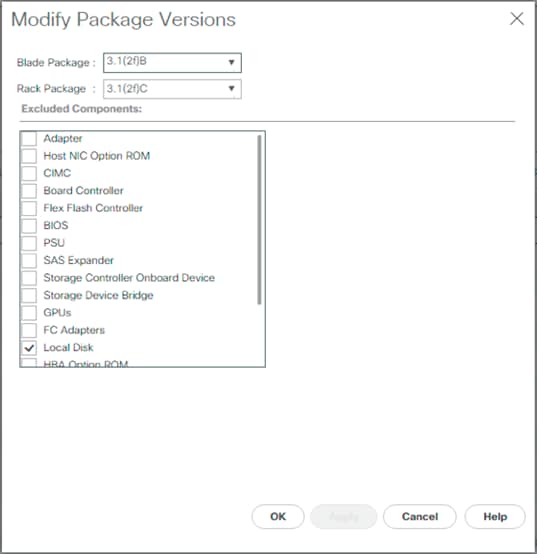
7. Click OK then OK again to modify the host firmware package.
Set Jumbo Frames in Cisco UCS Fabric
To configure jumbo frames and enable quality of service in the Cisco UCS fabric, complete the following steps:
1. In Cisco UCS Manager, click LAN on the left.
2. Select LAN > LAN Cloud > QoS System Class.
3. In the right pane, click the General tab.
4. On the Best Effort row, enter 9216 in the box under the MTU column.
5. Click Save Changes in the bottom of the window.
6. Click OK

Create Local Disk Configuration Policy (Optional)
A local disk configuration for the Cisco UCS environment is necessary if the servers in the environment do not have a local disk.
![]() This policy should not be used on servers that contain local disks.
This policy should not be used on servers that contain local disks.
To create a local disk configuration policy, complete the following steps:
1. In Cisco UCS Manager, click Servers on the left.
2. Select Policies > root.
3. Right-click Local Disk Config Policies.
4. Select Create Local Disk Configuration Policy.
5. Enter SAN-Boot as the local disk configuration policy name.
6. Change the mode to No Local Storage.
7. Click OK to create the local disk configuration policy.
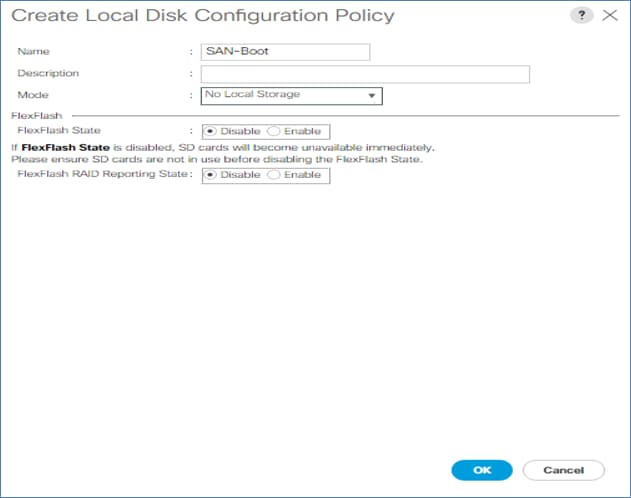
8. Click OK.
Create Network Control Policy for Cisco Discovery Protocol (CDP) and Link Layer Discovery Protocol (LLDP)
To create a network control policy that enables CDP and LLDP on virtual network ports, complete the following steps:
1. In Cisco UCS Manager, click LAN on the left.
2. Select Policies > root.
3. Right-click Network Control Policies.
4. Select Create Network Control Policy.
5. Enter Enable-CDP-LLDP as the policy name.
6. For CDP, select the Enabled option.
7. For LLDP, scroll down and select Enabled for both Transmit and Receive.
8. Click OK to create the network control policy.
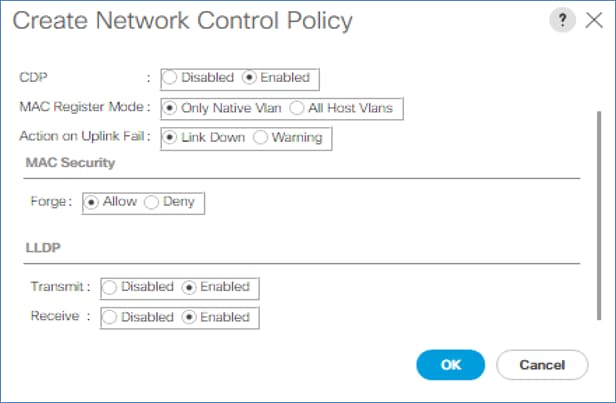
9. Click OK.
Create Power Control Policy
To create a power control policy for the Cisco UCS environment, complete the following steps:
1. In Cisco UCS Manager, click Servers tab on the left.
2. Select Policies > root.
3. Right-click Power Control Policies.
4. Select Create Power Control Policy.
5. Enter No-Power-Cap as the power control policy name.
6. Change the power capping setting to No Cap.
7. Click OK to create the power control policy.
8. Click OK.
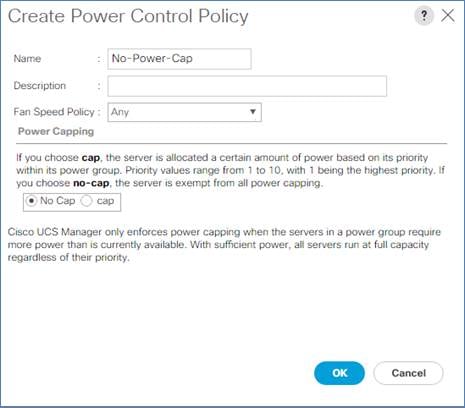
Create Server Pool Qualification Policy (Optional)
To create an optional server pool qualification policy for the Cisco UCS environment, complete the following steps:
![]() This example creates a policy for Cisco UCS B-Series and Cisco UCS C-Series servers with the Intel E2660 v4 Xeon Broadwell processors.
This example creates a policy for Cisco UCS B-Series and Cisco UCS C-Series servers with the Intel E2660 v4 Xeon Broadwell processors.
1. In Cisco UCS Manager, click Servers on the left.
2. Select Policies > root.
3. Right-click Server Pool Policy Qualifications.
4. Select Create Server Pool Policy Qualification.
5. Name the policy UCS-Broadwell.
6. Select Create CPU/Cores Qualifications.
7. Select Xeon for the Processor/Architecture.
8. Enter UCS-CPU-E52660E as the PID.
9. Click OK to create the CPU/Core qualification.
10. Click OK to create the policy then OK for the confirmation.
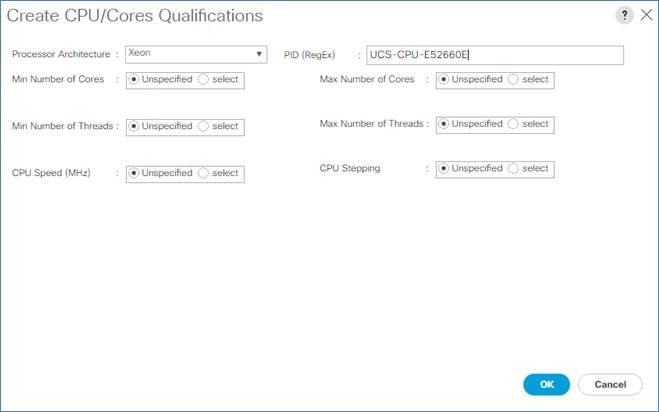
Create Server BIOS Policy
To create a server BIOS policy for the Cisco UCS environment, complete the following steps:
1. In Cisco UCS Manager, click Servers on the left.
2. Select Policies > root.
3. Right-click BIOS Policies.
4. Select Create BIOS Policy.
5. Enter MS-Host as the BIOS policy name.
6. Change the Quiet Boot setting to disabled.
7. Change Consistent Device Naming to enabled.

8. Click on the Processor tab on the left.
9. Set the following within the Processor tab
10. Processor C State -> disabled
11. Processor C1E -> disabled
12. Processor C3 Report -> disabled
13. Processor C7 Report -> disabled
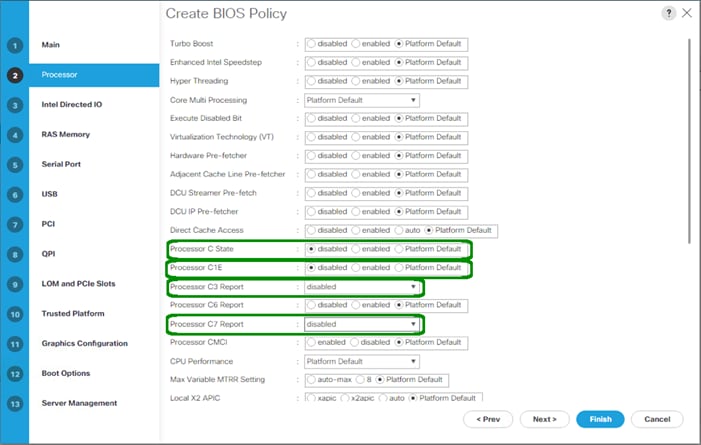
14. Scroll down to the remaining Processor options, and select:
15. Energy Performance -> performance
16. Frequency Floor Override -> enabled
17. DRAM Clock Throttling -> performance
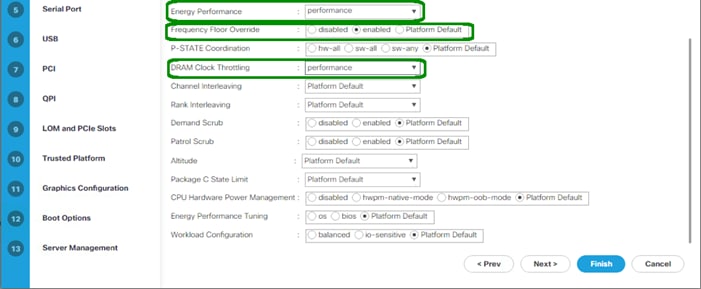
18. Click on the RAS Memory option, and select:
19. LV DDR Mode -> performance-mode

20. Click Finish to create the BIOS policy.
21. Click OK.
Update the Default Maintenance Policy
To update the default Maintenance Policy, complete the following steps:
1. In Cisco UCS Manager, click Servers on the left.
2. Select Policies > root.
3. Select Maintenance Policies > default.
4. Change the Reboot Policy to User Ack.
5. Select “On Next Boot” to delegate maintenance windows to server administrators.

6. Click Save Changes.
7. Click OK to accept the change.
Create vNIC Templates
To create multiple virtual network interface card (vNIC) templates for the Cisco UCS environment, complete the following steps. A total of 4 vNIC Templates will be created.
Create Infrastructure vNICs
1. In Cisco UCS Manager, click LAN on the left.
2. Select Policies > root.
3. Right-click vNIC Templates.
4. Select Create vNIC Template.
5. Enter vNIC-Template-A as the vNIC template name.
6. Keep Fabric A selected.
7. Do not select the Enable Failover checkbox.
8. Select Primary Template for Redundancy Type.
9. Leave the Peer Redundancy Template set to <not set>.
10. Under Target, make sure that only the Adapter checkbox is selected.
11. Select Updating Template as the Template Type.
12. Under VLANs, select the checkboxes for MS-IB-MGMT, MS-Cluster, MS-CSV, and MS-Tenant-VM VLANs.
13. Set Native-VLAN as the native VLAN.
14. Select vNIC Name for the CDN Source.
15. For MTU, enter 9000.
16. In the MAC Pool list, select MAC-POOL-A.
17. In the Network Control Policy list, select Enable-CDP-LLDP.
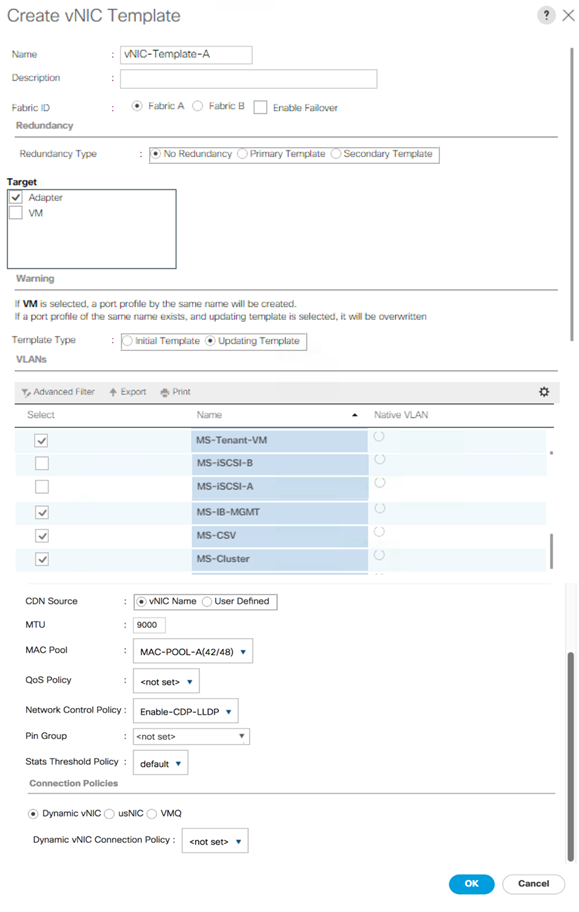
18. Click OK to create the vNIC template.
19. Click OK.
Create Secondary Redundancy Template Infra-B
1. Select LAN on the left.
2. Select Policies > root.
3. Right-click vNIC Templates.
4. Select Create vNIC Template
5. Enter vNIC-Template-B as the vNIC template name.
6. Select Fabric B.
7. Select the Enable Failover checkbox.
8. Set Redundancy Type to Secondary Template.
9. Select Infra-A for the Peer Redundancy Template.
10. In the MAC Pool list, select MAC-POOL-B. The MAC Pool is all that needs to be selected for the Secondary Template.
11. Click OK to create the vNIC template.
12. Click OK.
13. Create iSCSI vNICs
14. Select LAN on the left.
15. Select Policies > root.
16. Right-click vNIC Templates.
17. Select Create vNIC Template.
18. Enter iSCSI-Template-A as the vNIC template name.
19. Select Fabric A. Do not select the Enable Failover checkbox.
20. Leave Redundancy Type set at No Redundancy.
21. Under Target, make sure that only the Adapter checkbox is selected.
22. Select Updating Template for Template Type.
23. Under VLANs, select only MS-iSCSI-A-VLAN.
24. Select MS-iSCSI-A-VLAN as the native VLAN.
25. Leave vNIC Name set for the CDN Source.
26. Under MTU, enter 9000.
27. From the MAC Pool list, select MAC-Pool-A.
28. From the Network Control Policy list, select Enable-CDP-LLDP.
29. Click OK to complete creating the vNIC template.
30. Click OK.
31. Select LAN on the left.
32. Select Policies > root.
33. Right-click vNIC Templates.
34. Select Create vNIC Template.
35. Enter iSCSI-Template-B as the vNIC template name.
36. Select Fabric B. Do not select the Enable Failover checkbox.
37. Leave Redundancy Type set at No Redundancy.
38. Under Target, make sure that only the Adapter checkbox is selected.
39. Select Updating Template for Template Type.
40. Under VLANs, select only MS-iSCSI-B-VLAN.
41. Select MS-iSCSI-B-VLAN as the native VLAN.
42. Leave vNIC Name set for the CDN Source.
43. Under MTU, enter 9000.
44. From the MAC Pool list, select MAC-Pool-B.
45. From the Network Control Policy list, select Enable-CDP-LLDP.
46. Click OK to complete creating the vNIC template.
47. Click OK.
Create LAN Connectivity Policy for iSCSI Boot
To configure the necessary Infrastructure LAN Connectivity Policy, complete the following steps:
1. In Cisco UCS Manager, click LAN on the left.
2. Select LAN > Policies > root.
3. Right-click LAN Connectivity Policies.
4. Select Create LAN Connectivity Policy.
5. Enter iSCSI-BOOT as the name of the policy.
6. Click the upper Add button to add a vNIC.
7. In the Create vNIC dialog box, enter 00-Infra-A as the name of the vNIC.
8. Select the Use vNIC Template checkbox.
9. In the vNIC Template list, select vNIC-Template-A.
10. In the Adapter Policy list, select Windows.
11. Click OK to add this vNIC to the policy.
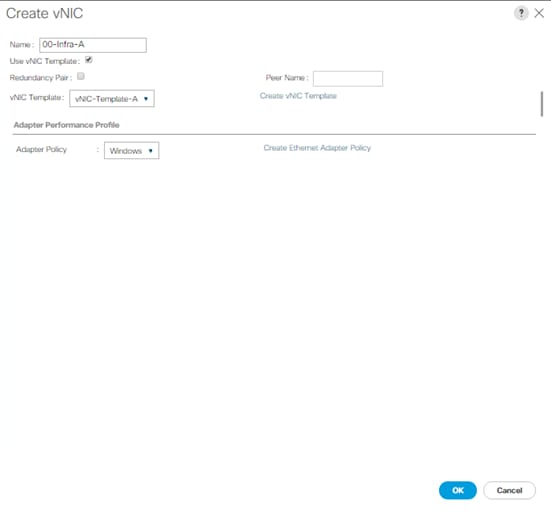
12. Click the upper Add button to add another vNIC to the policy.
13. In the Create vNIC box, enter 01-Infra-B as the name of the vNIC.
14. Select the Use vNIC Template checkbox.
15. In the vNIC Template list, select vNIC-Template-B.
16. In the Adapter Policy list, select Windows.
17. Click OK to add the vNIC to the policy.
18. Click the upper Add button to add a vNIC.
19. In the Create vNIC dialog box, enter 02-iSCSI-A as the name of the vNIC.
20. Select the Use vNIC Template checkbox.
21. In the vNIC Template list, select iSCSI-Template-A.
22. In the Adapter Policy list, select Windows.
23. Click OK to add this vNIC to the policy.
24. Click the upper Add button to add a vNIC to the policy.
25. In the Create vNIC dialog box, enter 03-iSCSI-B as the name of the vNIC.
26. Select the Use vNIC Template checkbox.
27. In the vNIC Template list, select iSCSI-Template-B.
28. In the Adapter Policy list, select Windows.
29. Click OK to add this vNIC to the policy.
30. Expand the Add iSCSI vNICs.
31. Select Add in the Add iSCSI vNICs section.
32. Set the name to iSCSI-A-vNIC.
33. Select the 02-iSCSI-A as Overlay vNIC.
34. Set the VLAN to iSCSI-A-VLAN (native).
35. Set the iSCSI Adapter Policy to default
36. Leave the MAC Address set to None.
37. Click OK.
38. Select Add in the Add iSCSI vNICs section.
39. Set the name to iSCSI-B-vNIC.
40. Select the 03-iSCSI-B as Overlay vNIC.
41. Set the VLAN to iSCSI-B-VLAN.
42. Set the VLAN to iSCSI-B-VLAN (native).
43. Set the iSCSI Adapter Policy to default.
44. Leave the MAC Address set to None.
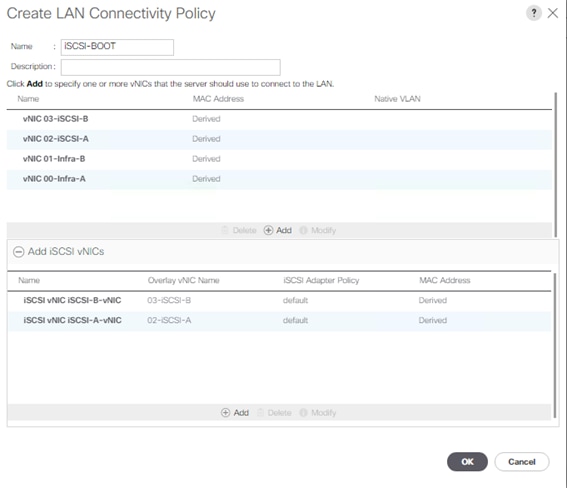
45. Click OK, then click OK again to create the LAN Connectivity Policy.
Create iSCSI Boot Policy
This procedure applies to a Cisco UCS environment in which two iSCSI logical interfaces (LIFs) are on cluster node 1 (iscsi_lif01a and iscsi_lif01b) and two iSCSI LIFs are on cluster node 2 (iscsi_lif02a and iscsi_lif02b). Also, it is assumed that the A LIFs are connected to Fabric A (Cisco UCS Fabric Interconnect A) and the B LIFs are connected to Fabric B (Cisco UCS Fabric Interconnect B).
![]() One boot policy is configured in this procedure. The policy configures the primary target to be iscsi_lif01a.
One boot policy is configured in this procedure. The policy configures the primary target to be iscsi_lif01a.
To create a boot policy for the Cisco UCS environment, complete the following steps:
1. In Cisco UCS Manager, click Servers on the left.
2. Select Policies > root.
3. Right-click Boot Policies.
4. Select Create Boot Policy.
5. Enter iSCSI-Boot-Fab-A as the name of the boot policy.
6. Optional: Enter a description for the boot policy.
![]() Do not select the Reboot on Boot Order Change checkbox.
Do not select the Reboot on Boot Order Change checkbox.
7. Keep the Reboot on Boot Order Change option cleared.
8. Expand the Local Devices drop-down menu and select Local CD/DVD.
9. Expand the iSCSI vNICs drop-down menu and select Add iSCSI Boot.
10. In the Add iSCSI Boot dialog box, enter iSCSI-A-vNIC.
11. Click OK.
12. Select Add iSCSI Boot.
13. In the Add iSCSI Boot dialog box, enter iSCSI-B-vNIC.
14. Click OK.
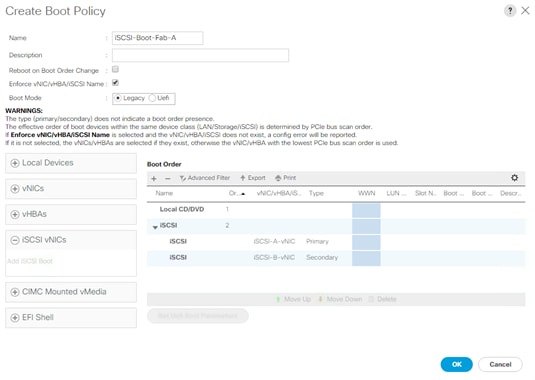
15. Click OK to create the policy.
Create Service Profile Templates
In this procedure, one service profile template for Infrastructure Hyper-V hosts is created for Fabric A boot.
To create the service profile template, complete the following steps:
1. In Cisco UCS Manager, click Servers on the left.
2. Select Service Profile Templates > root.
3. Right-click root.
4. Select Create Service Profile Template to open the Create Service Profile Template wizard.
5. Enter Hyper-V-Host-iSCSI as the name of the service profile template. This service profile template is configured to boot from storage node 1 on fabric A.
6. Select the “Updating Template” option.
7. Under UUID, select UUID_Pool as the UUID pool.
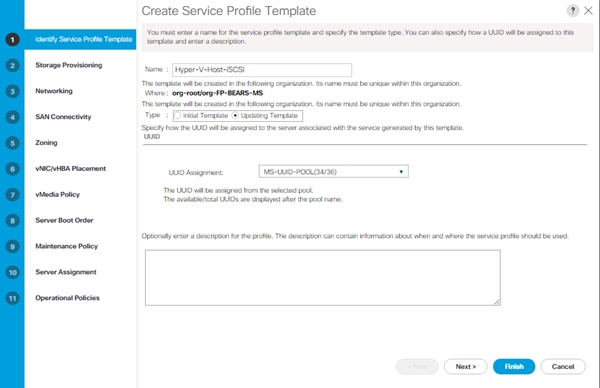
8. Click Next.
Configure Storage Provisioning
1. If you have servers with no physical disks, click the Local Disk Configuration Policy and select the SAN-Boot Local Storage Policy. Otherwise, select the default Local Storage Policy.
2. Click Next.
Configure Networking Options
1. Keep the default setting for Dynamic vNIC Connection Policy.
2. Select the “Use Connectivity Policy” option to configure the LAN connectivity.
3. Select iSCSI-BOOT from the LAN Connectivity Policy pull-down.
4. Select IQN_POOL in Initiator Name Assignment.
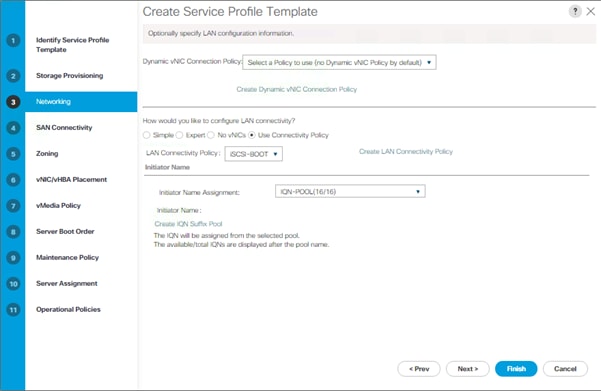
5. Click Next.
Configure Storage Options
1. Select No vHBAs for the “How would you like to configure SAN connectivity?” field.
2. Click Next.
Configure Zoning Options
1. Click Next.
Configure vNIC/HBA Placement
1. In the “Select Placement” list, leave the placement policy as “Let System Perform Placement”.
2. Click Next.
Configure vMedia Policy
1. Do not select a vMedia Policy.
2. Click Next.
Configure Server Boot Order
1. Select iSCSI-Boot-Fab-A for Boot Policy.
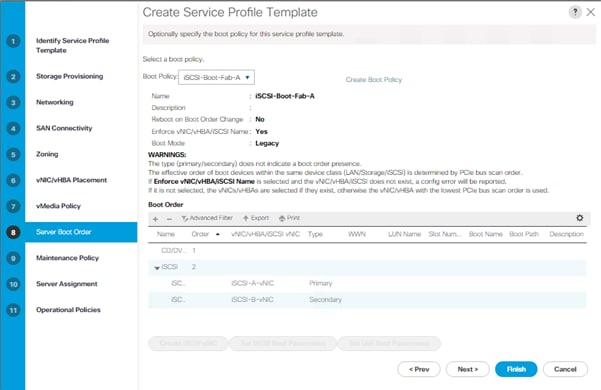
2. In the Boor order, select iSCSI-A-vNIC.
3. Click Set iSCSI Boot Parameters button.
4. In the Set iSCSI Boot Parameters pop-up, leave Authentication Profile to <not set> unless you have independently created one appropriate to your environment.
5. Leave the “Initiator Name Assignment” dialog box <not set> to use the single Service Profile Initiator Name defined in the previous steps.
6. Set iSCSI_IP_POOL_A as the “Initiator IP address Policy”.
7. Select iSCSI Static Target Interface option.
8. Click Add.
9. Enter the iSCSI Target Name. To get the iSCSI target name of Infra-MS-SVM, login into storage cluster management interface and run “iscsi show” command”.

10. Enter the IP address of iscsi_lif_01a for the IPv4 Address field.
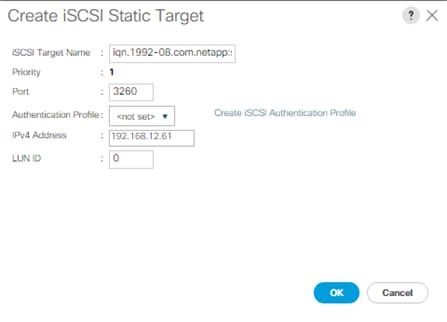
11. Click OK to add the iSCSI static target.
12. Click Add.
13. Enter the iSCSI Target Name.
14. Enter the IP address of iscsi_lif_02a for the IPv4 Address field.
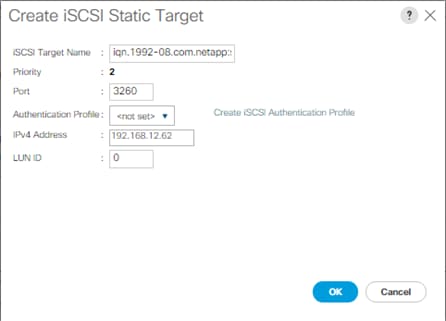
15. Click OK to add the iSCSI static target.
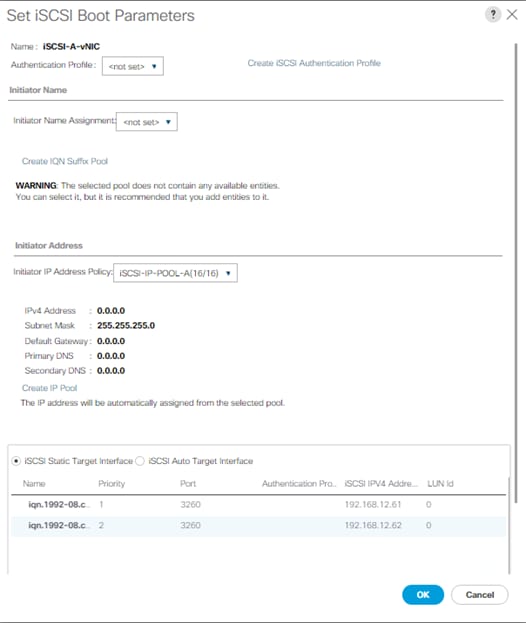
16. In the Boot order, select iSCSI-B-vNIC.
17. Click Set iSCSI Boot Parameters button.
18. In the Set iSCSI Boot Parameters pop-up, leave Authentication Profile to <not set> unless you have independently created one appropriate to your environment
19. Leave the “Initiator Name Assignment” dialog box <not set> to use the single Service Profile Initiator Name defined in the previous steps
20. Set iSCSI_IP_POOL_B as the “Initiator IP address Policy”.
21. Select iSCSI Static Target Interface option.
22. Click Add.
23. Enter the iSCSI Target Name. To get the iSCSI target name of Infra-MS-SVM, login into storage cluster management interface and run “iscsi show” command”.

24. Enter the IP address of iscsi_lif_01b for the IPv4 Address field.
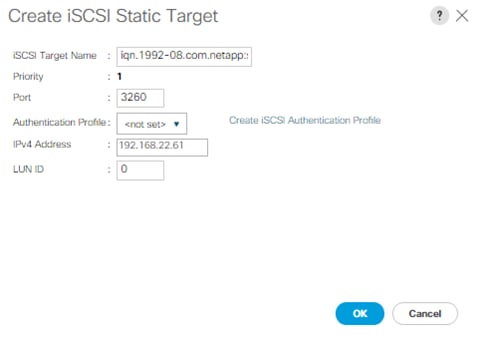
25. Click OK to add the iSCSI static target.
26. Click Add.
27. Enter the iSCSI Target Name.
28. Enter the IP address of iscsi_lif_02b for the IPv4 Address field.
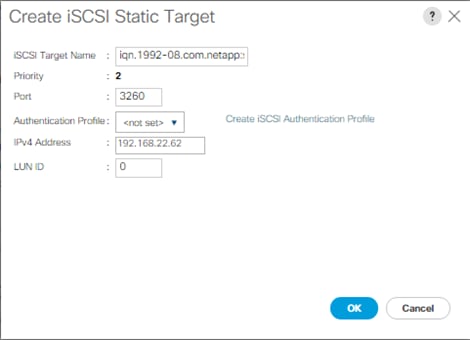
29. Click OK to add the iSCSI static target.

30. Click Next.
Configure Maintenance Policy
1. Change the Maintenance Policy to default.
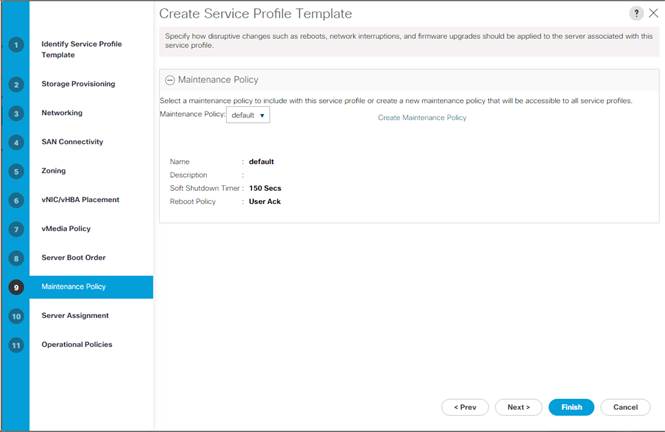
2. Click Next.
Configure Server Assignment
To configure server assignment, complete the following steps:
1. In the Pool Assignment list, select MS-Server-Pool.
2. Select Down as the power state to be applied when the profile is associated with the server.
3. Optional: select “UCS-Broadwell” for the Server Pool Qualification.
4. Expand Firmware Management at the bottom of the page and select the default policy
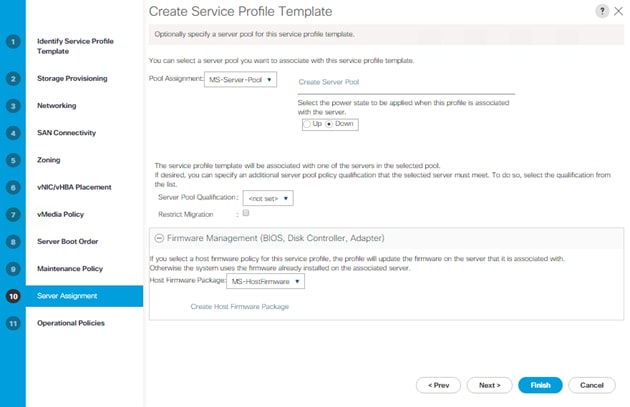
5. Click Next.
Configure Operational Policies
To configure the operational policies, complete the following steps:
1. In the BIOS Policy list, select MS-Host.
2. Expand Power Control Policy Configuration and select No-Power-Cap in the Power Control Policy list.
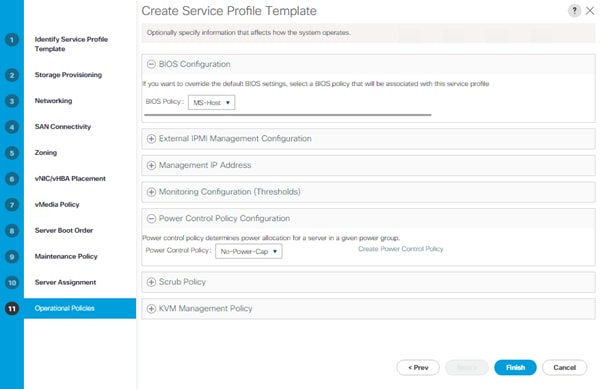
3. Click Finish to create the service profile template.
4. Click OK in the confirmation message.
Create Service Profiles
To create service profiles from the service profile template, complete the following steps:
1. Connect to UCS Manager, click Servers on the left pane.
5. Select Service Profile Templates > root > Service Template Hyper-V-Host-iSCSI.
6. Right-click Hyper-V-Host-iSCSI and select Create Service Profiles from Template.
7. Enter Hyper-V-iSCSI-Host-0 as the service profile prefix.
8. Enter 1 as “Name Suffix Starting Number.”
9. Enter 2 as the “Number of Instances.”
10. Click OK to create the service profiles.
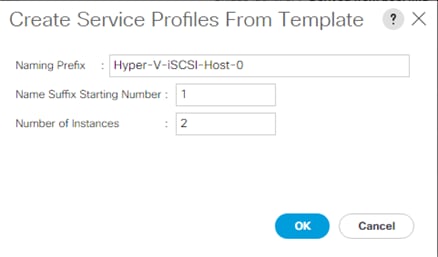
11. Click OK in the confirmation message.
Add More Servers to FlexPod Unit
Additional server pools, service profile templates, and service profiles can be created in the respective organizations to add more servers to the FlexPod unit. All other pools and policies are at the root level and can be shared among the organizations.
Gather Necessary Information
After the Cisco UCS service profiles have been created, each infrastructure server in the environment will have a unique configuration. To proceed with the FlexPod deployment, specific information must be gathered from each Cisco UCS server and from the NetApp controllers. Insert the required information into Table 9 and Table 10.
Table 9 iSCSI LIFs for iSCSI IQN
| SVM |
Target: IQN |
| Infra-MS-SVM |
|
![]() To obtain the iSCSI IQN, run iscsi show command on the storage cluster management interface.
To obtain the iSCSI IQN, run iscsi show command on the storage cluster management interface.
Table 10 vNIC iSCSI IQNs for fabric A and fabric B
| Cisco UCS Service Profile Name |
iSCSI IQN |
Variables |
| Hyper-V-iSCSI-Host-01 |
|
< Hyper-V-iSCSI-Host-01-iqn> |
| Hyper-V-iSCSI-Host-02 |
|
< Hyper-V-iSCSI-Host-02-iqn> |
![]() To obtain the iSCSI vNIC IQN information in Cisco UCS Manager GUI, go to Servers > Service Profiles > root. Click each service profile and then click the “iSCSI vNICs” tab on the right. The “Initiator Name” is displayed at the top of the page under the “Service Profile Initiator Name”.
To obtain the iSCSI vNIC IQN information in Cisco UCS Manager GUI, go to Servers > Service Profiles > root. Click each service profile and then click the “iSCSI vNICs” tab on the right. The “Initiator Name” is displayed at the top of the page under the “Service Profile Initiator Name”.
Storage Configuration – Boot LUNs and Igroups
Create Boot LUNs
To create two boot LUNs, run the following commands:
lun create -vserver Infra-MS-SVM -volume HV_boot -lun VM-Host-Infra-01 -size 200GB –ostype windows_2008 -space-reserve disabled
lun create -vserver Infra-MS-SVM -volume HV_boot -lun VM-Host-Infra-02 -size 200GB -ostype windows_2008 -space-reserve disabled
Create Witness and Data LUN
A witness LUN is required in a Hyper-V cluster. To create the witness and Data LUN, run the following command:
lun create -vserver Infra-MS-SVM -volume witness_FC_6332 -lun witness_FC_6332 -size 1GB –ostype windows_2008 -space-reserve disabled
lun create -vserver Infra-MS-SVM -volume infra_datastore_1 -lun data_FC_6332 -size 250GB –ostype windows_2008 -space-reserve disabled
Create igroups
To create igroups, run the following commands:
igroup create –vserver Infra-MS-SVM –igroup VM-Host-Infra-01 –protocol iscsi –ostype windows –initiator <vm-host-infra-01-iqn>
igroup create –vserver Infra-MS-SVM –igroup VM-Host-Infra-02 –protocol iscsi –ostype windows –initiator <vm-host-infra-02-iqn>
igroup create –vserver Infra-MS-SVM –igroup VM-Host-Infra-All –protocol iscsi –ostype windows –initiator <vm-host-infra-01-iqn>,<vm-host-infra-02-iqn>
Map Boot LUNs to igroups
To map LUNs to igroups, run the following commands:
lun map –vserver Infra-MS-SVM –volume HV_boot –lun VM-Host-Infra-01 –igroup VM-Host-Infra-01 –lun-id 0
lun map –vserver Infra-MS-SVM –volume HV_boot –lun VM-Host-Infra-02 –igroup VM-Host-Infra-02 –lun-id 0
lun map –vserver Infra-MS-SVM –volume witness_FC_6332 –lun witness_FC_6332 –igroup VM-Host-Infra-All –lun-id 1
lun map –vserver Infra-MS-SVM –volume infra_datastore_1 -lun data_FC_6332 –igroup VM-Host-Infra-All –lun-id 2
Setup the Microsoft Windows 2016 install
Most of the sub-sections of Microsoft Windows 2016 install are similar to the steps covered in the main document; hence the delta changes required for iSCSI deployment are captured below.
Install Windows Server 2016
To complete this section, refer to the corresponding section of the main document and execute all the steps.
Install Chipset and Windows eNIC Drivers
To complete this section, refer to the corresponding section of the main document and execute all the steps.
Install Windows Roles and Features
1. Complete the installation steps from the main section and enable the roles and features as mentioned in the main document.
2. For configuring MPIO, Open Server Manager and click Tools > MPIO.
3. Click Discover Multi-Paths tab.
4. Select the check box next to “Add Support for iSCSI Devices” and also select the “NetApp LUN C-Mode” under the Hardware ID. Click Add and reboot the server.
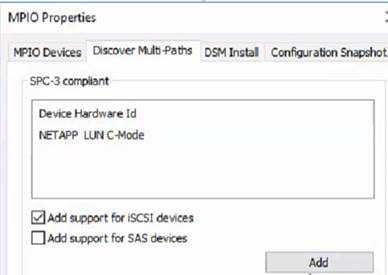
Install NetApp Host Utilities
To complete this section, refer to corresponding section of the main document and execute all the steps.
Configure Microsoft iSCSI Initiator
1. Open Server Manager, click Tools and then click iSCSI Initiator and click Yes to start the service.
2. Click on the Targets tab and you will see a discovered target with status as connected. This entry is because of the iSCSI SAN boot.
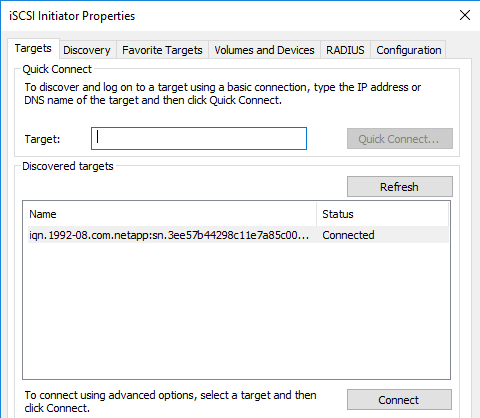
3. In the iSCSI Initiator properties, click the Discovery tab and then click Discover portal.
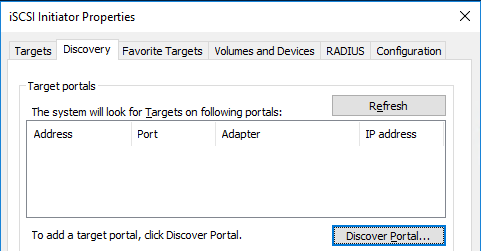
4. In the Discover Target Portal window, enter the IP address or DNS name of the iSCSI target and click Advanced.
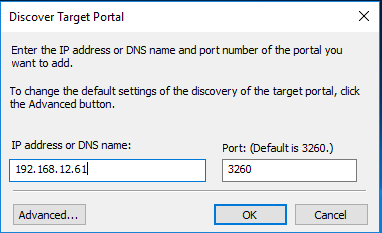
5. In the Advanced setting, select Microsoft iSCSI Initiator as local adapter and an iSCSI IP address for the Initiator IP as shown in the below figure.
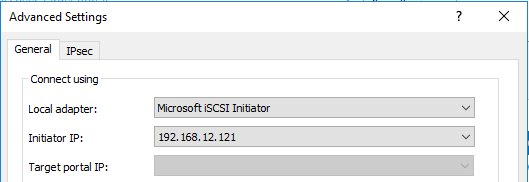
6. Click on Targets tab and select the discovered target and click on Connect.
7. In the Connect To Target, select Enable multi-path and click on Advanced.

8. In the Advanced settings, configure the Initiator IP and the Target portal IP for the iSCSI-A path as shown in the figure below.
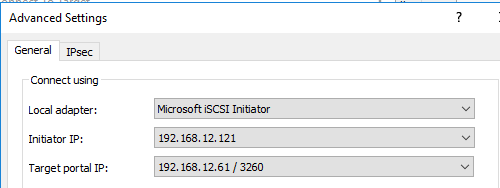
9. Repeat steps 6 to 8 and configure as shown in the figure below for the iSCSI-B path.
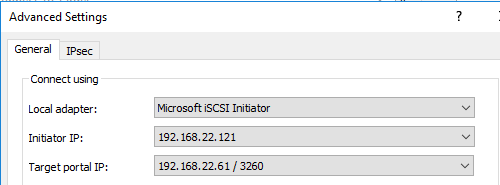
10. Verify the MPIO configuration by navigating to the Server Manager > Tools > MPIO > Configuration Snapshot. Select “Open File upon capture” and click Capture.

11. The MPIO configuration log file opens showing the number of paths and the load balance policies used to manage the LUNs/disks.
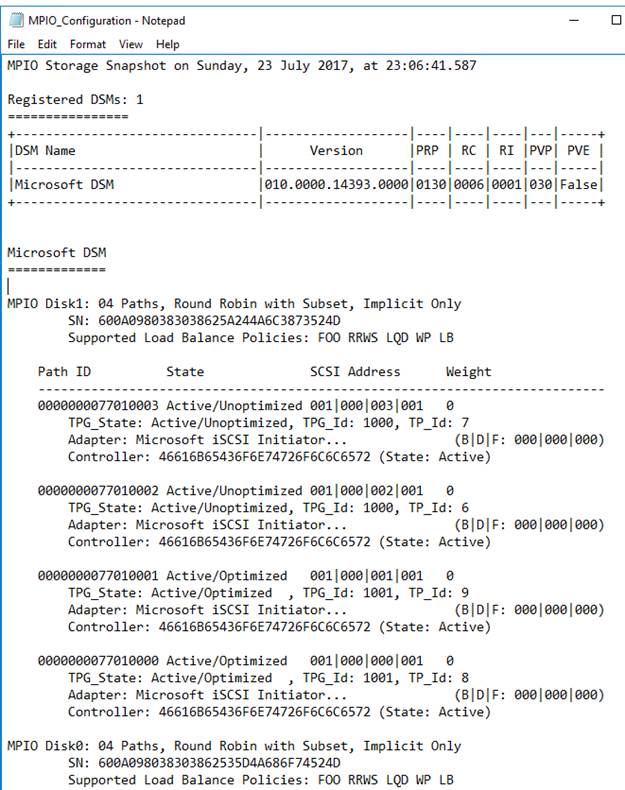
Host Renaming and Join to Domain
To complete this section, refer to the corresponding section of the main document and execute all the steps.
To complete this section, refer to the corresponding section of the main document and execute all the steps.
This section of FlexPod deployment will show configuration steps for both the Cisco UCS 6332-16UP and Cisco UCS 6248UP Fabric Interconnects (FI) in a design that will support direct connectivity to NetApp AFF using Fibre Channel over Ethernet (FCoE).
Configuration steps will be referenced for both fabric interconnects and will be called out by the specific model where steps have differed.
Figure 13 shows the Microsoft Hyper-V 2016 built on FlexPod components and the network connections for a configuration with the Cisco UCS 6332-16UP Fabric Interconnects with storage FCoE connections directly connected to the fabric interconnect. This design has 40Gb Ethernet connections between the Cisco UCS 5108 Blade Chassis and C-Series rackmounts and the Cisco UCS Fabric Interconnect, and between the Cisco UCS Fabric Interconnect and Cisco Nexus 9000. This design also has a 10Gb FCoE connection between Cisco UCS Fabric Interconnect and NetApp AFF A300. FC zoning is done in the Cisco UCS Fabric Interconnect. This infrastructure is deployed to provide FCoE-booted hosts with file-level and block-level access to shared storage with use cases that do not require the Cisco MDS SAN connectivity or scale.
Figure 13 FlexPod with Cisco UCS 6332-16UP Fabric Interconnects and Cisco UCS Direct Connect SAN
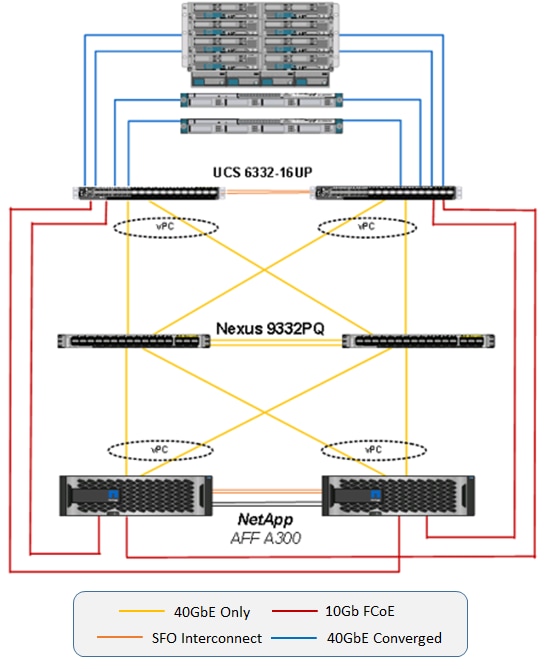
Figure 14 shows the Hyper-V built on FlexPod components and the network connections for a configuration with the Cisco UCS 6248UP Fabric Interconnects with storage FC connections directly connected to the fabric interconnect. This design has 10Gb Ethernet connections throughout the architecture. This design also has 10Gb FCoE connections between the Cisco UCS Fabric Interconnect and the NetApp AFF family of storage controllers. This infrastructure is also deployed to provide FCoE-booted hosts with file-level and block-level access to shared storage with use cases that do not require the Cisco MDS SAN connectivity or scale.
Figure 14 FlexPod with Cisco UCS 6248UP Fabric Interconnects and Cisco UCS Direct Connect SAN

Network Switch Configuration
This section provides a detailed procedure for configuring the Cisco Nexus 9000s for use in a FlexPod environment. Follow these steps precisely because failure to do so could result in an improper configuration.
Physical Connectivity
Figure 15 FlexPod Cabling with Cisco UCS 6332-16UP Fabric Interconnect for Direct Connect FCoE SAN

Figure 16 FlexPod Cabling with Cisco UCS 6248UP Fabric Interconnect for Direct Connect FCoE SAN

FlexPod Cisco Nexus Base
To complete this section, refer to the corresponding section of the main document and execute all the steps.
FlexPod Cisco Nexus Switch Configuration
To complete this section, refer to the corresponding section of the main document and execute all the steps.
Storage Configuration
Set Onboard Unified Target Adapter 2 Port Personality
In order to use FCoE storage targets, CNA ports must be configured on the storage. To set the personality of the onboard unified target adapter 2 (UTA2), complete the following steps for both controllers in an HA pair:
1. Verify the Current Mode and Current Type properties of the ports by running the ucadmin show command.
ucadmin show
Current Current Pending Pending Admin
Node Adapter Mode Type Mode Type Status
------------ ------- ------- --------- ------- --------- -----------
<st-node01>
0e fc target - - online
<st-node01>
0f fc target - - online
<st-node01>
0g cna target - - online
<st-node01>
0h cna target - - online
<st-node02>
0e fc target - - online
<st-node02>
0f fc target - - online
<st-node02>
0g cna target - - online
<st-node02>
0h cna target - - online
8 entries were displayed.
2. Verify that the Current Mode and Current Type properties for all ports are set properly. Set the ports used for FCoE connectivity to mode cna. The port type for all protocols should be set to target. Change the port personality by running the following command:
ucadmin modify -node <home-node-of-the-port> -adapter <port-name> -mode cna -type target.
![]() The ports must be offline to run this command. To take an adapter offline, run the fcp adapter modify –node <home-node-of-the-port> -adapter <port-name> -state down command. Ports must be converted in pairs (for example, 0e and 0f).
The ports must be offline to run this command. To take an adapter offline, run the fcp adapter modify –node <home-node-of-the-port> -adapter <port-name> -state down command. Ports must be converted in pairs (for example, 0e and 0f).
![]() After conversion, a reboot is required. After reboot, bring the ports online by running fcp adapter modify -node <home-node-of-the-port> -adapter <port-name> -state up.
After conversion, a reboot is required. After reboot, bring the ports online by running fcp adapter modify -node <home-node-of-the-port> -adapter <port-name> -state up.
Create FC LIFs
Run the following commands to create four FC LIFs (two on each node) by using the previously configured FCoE ports.:
network interface create -vserver Infra-MS-SVM -lif fcp_lif01a -role data -data-protocol fcp -home-node <st-node01> -home-port 0e –status-admin up
network interface create -vserver Infra-MS-SVM -lif fcp_lif01b -role data -data-protocol fcp -home-node <st-node01> -home-port 0f –status-admin up
network interface create -vserver Infra-MS-SVM -lif fcp_lif02a -role data -data-protocol fcp -home-node <st-node02> -home-port 0e –status-admin up
network interface create -vserver Infra-MS-SVM -lif fcp_lif02b -role data -data-protocol fcp -home-node <st-node02> -home-port 0f –status-admin up
![]() From storage controller’s perspective, LIF’s are created according to the native protocol to be used. Therefore, FC LIFs are created using FCoE ports.
From storage controller’s perspective, LIF’s are created according to the native protocol to be used. Therefore, FC LIFs are created using FCoE ports.
![]() For additional storage related tasks, please see the storage configuration portion of this document.
For additional storage related tasks, please see the storage configuration portion of this document.
Create Boot LUNs
To create two boot LUNs, run the following commands:
lun create -vserver Infra-MS-SVM -volume HV_boot -lun VM-Host-Infra-01 -size 200GB –ostype windows_2008 -space-reserve disabled
lun create -vserver Infra-MS-SVM -volume HV_boot -lun VM-Host-Infra-02 -size 200GB -ostype windows_2008 -space-reserve disabled
Create Witness and Data LUN
A witness LUN is required in a Hyper-V cluster. To create the witness and Data LUN, run the following command:
lun create -vserver Infra-MS-SVM -volume witness_FC_6332 -lun witness_FC_6332 -size 1GB –ostype windows_2008 -space-reserve disabled
lun create -vserver Infra-MS-SVM -volume infra_datastore_1 -lun data_FC_6332 -size 250GB –ostype windows_2008 -space-reserve disabled
Create igroups
To create igroups, run the following commands:
igroup create –vserver Infra-MS-SVM –igroup VM-Host-Infra-01 –protocol fcp –ostype windows –initiator <vm-host-infra-01-wwpna>,<vm-host-infra-01-wwpnb>
igroup create –vserver Infra-MS-SVM –igroup VM-Host-Infra-02 –protocol fcp –ostype windows –initiator <vm-host-infra-02-wwpna>,<vm-host-infra-02-wwpnb>
igroup create –vserver Infra-MS-SVM –igroup VM-Host-Infra-All –protocol fcp –ostype windows –initiator <vm-host-infra-01-wwpna>,<vm-host-infra-01-wwpnb>,<vm-host-infra-02-wwpna>,<vm-host-infra-02-wwpnb>
Map Boot LUNs to igroups
To map LUNs to igroups, run the following commands:
lun map –vserver Infra-MS-SVM –volume HV_boot –lun VM-Host-Infra-01 –igroup VM-Host-Infra-01 –lun-id 0
lun map –vserver Infra-MS-SVM –volume HV_boot –lun VM-Host-Infra-02 –igroup VM-Host-Infra-02 –lun-id 0
lun map –vserver Infra-MS-SVM –volume witness_FC_6332 –lun witness_FC_6332 –igroup VM-Host-Infra-All –lun-id 1
lun map –vserver Infra-MS-SVM –volume infra_datastore_1 -lun data_FC_6332 –igroup VM-Host-Infra-All –lun-id 2
![]() For additional storage related tasks, please see the storage configuration portion of this document.
For additional storage related tasks, please see the storage configuration portion of this document.
Server Configuration
Perform Initial Setup of Cisco UCS 6332-16UP and 6248UP Fabric Interconnects for FlexPod Environments
This section provides detailed procedures for configuring the Cisco Unified Computing System (Cisco UCS) for use in a FlexPod environment. The steps are necessary to provision the Cisco UCS B-Series and C-Series servers and should be followed precisely to avoid improper configuration.
Cisco UCS Fabric Interconnect A
To configure the Cisco UCS for use in a FlexPod environment, complete the following steps:
1. Connect to the console port on the first Cisco UCS fabric interconnect.
Enter the configuration method: gui
Physical switch Mgmt0 IP address: <ucsa-mgmt-ip>
Physical switch Mgmt0 IPv4 netmask: <ucsa-mgmt-mask>
IPv4 address of the default gateway: <ucsa-mgmt-gateway>
2. Using a supported web browser, connect to <ucsa-mgmt-ip>, accept the security prompts, and click the ‘Express Setup’ link under HTML.
3. Select Initial Setup and click Submit.
4. Select Enable clustering, Fabric A, and IPv4.
5. Fill in the Virtual IP Address with the UCS cluster IP.
6. Completely fill in the System setup section. For system name, use the overall UCS system name. For the Mgmt IP Address, use <ucsa-mgmt-ip>.

7. Click Submit.
Cisco UCS Fabric Interconnect B
To configure the Cisco UCS for use in a FlexPod environment, complete the following steps:
1. Connect to the console port on the second Cisco UCS fabric interconnect.
Enter the configuration method: gui
Physical switch Mgmt0 IP address: <ucsb-mgmt-ip>
Physical switch Mgmt0 IPv4 netmask: <ucsb-mgmt-mask>
IPv4 address of the default gateway: <ucsb-mgmt-gateway>
2. Using a supported web browser, connect to <ucsb-mgmt-ip>, accept the security prompts, and click the ‘Express Setup’ link under HTML.
3. Under System setup, enter the Admin Password entered above and click Submit.
4. Enter <ucsb-mgmt-ip> for the Mgmt IP Address and click Submit.
Cisco UCS Direct Storage Connect Setup
Log in to Cisco UCS Manager
![]() The following steps are the same between the UCS 6332-16UP and the UCS 6248UP Fabric Interconnects unless otherwise noted
The following steps are the same between the UCS 6332-16UP and the UCS 6248UP Fabric Interconnects unless otherwise noted
To log in to the Cisco Unified Computing System (UCS) environment, complete the following steps:
1. Open a web browser and navigate to the Cisco UCS fabric interconnect cluster address.
![]() You may need to wait at least 5 minutes after configuring the second fabric interconnect for UCS Manager to come up.
You may need to wait at least 5 minutes after configuring the second fabric interconnect for UCS Manager to come up.
2. Click the Launch UCS Manager link under HTML to launch Cisco UCS Manager.
3. If prompted to accept security certificates, accept as necessary.
4. When prompted, enter admin as the user name and enter the administrative password.
5. Click Login to log in to Cisco UCS Manager.
Upgrade Cisco UCS Manager Software to Version 3.1(3a)
This document assumes the use of Cisco UCS 3.1(3a). To upgrade the Cisco UCS Manager software and the Cisco UCS Fabric Interconnect software to version 3.1(3a), refer to Cisco UCS Manager Install and Upgrade Guides.
Anonymous Reporting
To create anonymous reporting, complete the following step:
1. In the Anonymous Reporting window, select whether to send anonymous data to Cisco for improving future products. If you select Yes, enter the IP address of your SMTP Server. Click OK.

Configure Cisco UCS Call Home
It is highly recommended by Cisco to configure Call Home in UCSM. Configuring Call Home will accelerate resolution of support cases. To configure Call Home, complete the following steps:
1. In Cisco UCS Manager, click Admin on the left.
2. Select All > Communication Management > Call Home.
3. Change the State to On.
4. Fill in all the fields according to your Management preferences and click Save Changes and OK to complete configuring Call Home.
Place UCS Fabric Interconnects in Fiber Channel Switching Mode
In order to use Fiber Channel Storage Ports for storage directly connected to the Cisco UCS fabric interconnects, the fabric interconnects must be changed from fiber channel end host mode to fiber channel switching mode.
To place the fabric interconnects in fiber channel switching mode, complete the following steps:
1. In Cisco UCS Manager, click Equipment on the left.
2. Select Equipment > Fabric Interconnects > Fabric Interconnect A (primary).
3. In the center pane, select set FC Switching Mode. Click Yes and OK for the confirmation message.

4. Wait for both Fabric Interconnects to reboot by monitoring the console ports and log back into Cisco UCS Manager.
Add Block of IP Addresses for KVM Access
To create a block of IP addresses for in band server Keyboard, Video, Mouse (KVM) access in the Cisco UCS environment, complete the following steps:
1. In Cisco UCS Manager, click LAN on the left.
2. Expand Pools > root > IP Pools.
3. Right-click IP Pool ext-mgmt and select Create Block of IPv4 Addresses.
4. Enter the starting IP address of the block, number of IP addresses required, and the subnet mask and gateway information.
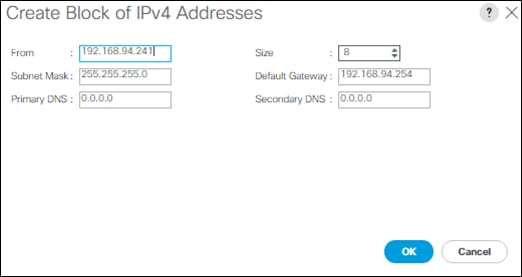
5. Click OK to create the block.
6. Click OK in the confirmation message.
Synchronize Cisco UCS to NTP
To synchronize the Cisco UCS environment to the NTP servers in the Nexus switches, complete the following steps:
1. In Cisco UCS Manager, click Admin on the left.
2. Expand All > Time Zone Management.
3. Select Timezone.
4. In the Properties pane, select the appropriate time zone in the Timezone menu.
5. Click Save Changes, and then click OK.
6. Click Add NTP Server.
7. Enter <switch-a-ntp-ip> and click OK. Click OK on the confirmation.

8. Click Add NTP Server.
9. Enter <switch-b-ntp-ip> and click OK. Click OK on the confirmation.
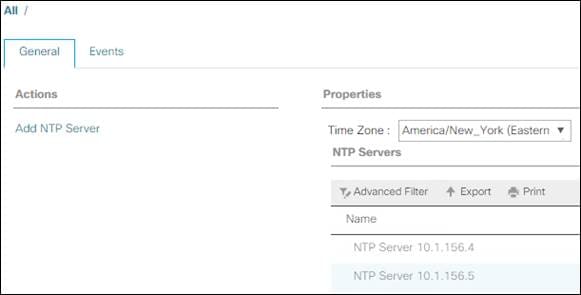
Edit Chassis Discovery Policy
Setting the discovery policy simplifies the addition of B-Series Cisco UCS chassis and of additional fabric extenders for further C-Series connectivity. To modify the chassis discovery policy, complete the following steps:
1. In Cisco UCS Manager, click Equipment on the left and select Equipment in the second list.
2. In the right pane, click the Policies tab.
3. Under Global Policies, set the Chassis/FEX Discovery Policy to match the minimum number of uplink ports that are cabled between the chassis or fabric extenders (FEXes) and the fabric interconnects.
4. Set the Link Grouping Preference to Port Channel. If Backplane Speed Preference appears, leave it set at 40G. If the environment being setup contains a large amount of multicast traffic, set the Multicast Hardware Hash setting to Enabled.

5. Click Save Changes.
6. Click OK.
Enable Server and Uplink Ports
To enable server and uplink ports, complete the following steps:
1. In Cisco UCS Manager, click Equipment on the left.
2. Expand Equipment > Fabric Interconnects > Fabric Interconnect A (primary) > Fixed Module.
3. Expand Ethernet Ports.
4. Select the ports that are connected to the chassis, Cisco FEX, and direct connect UCS C-Series servers, right-click them, and select “Configure as Server Port.”
5. Click Yes to confirm server ports and click OK.
6. Verify that the ports connected to the chassis, C-series servers and Cisco FEX are now configured as server ports.
7. Select the ports that are connected to the Cisco Nexus switches, right-click them, and select Configure as Uplink Port.
![]() The last 6 ports of the UCS 6332 and UCS 6332-16UP FIs will only work with optical based QSFP transceivers and AOC cables, so they can be better utilized as uplinks to upstream resources that might be optical only.
The last 6 ports of the UCS 6332 and UCS 6332-16UP FIs will only work with optical based QSFP transceivers and AOC cables, so they can be better utilized as uplinks to upstream resources that might be optical only.
8. Click Yes to confirm uplink ports and click OK.
9. Select Equipment > Fabric Interconnects > Fabric Interconnect B (subordinate) > Fixed Module.
10. Expand Ethernet Ports.
11. Select the ports that are connected to the chassis, C-series servers or to the Cisco 2232 FEX (two per FEX), right-click them, and select Configure as Server Port.
12. Click Yes to confirm server ports and click OK.
13. Select the ports that are connected to the Cisco Nexus switches, right-click them, and select Configure as Uplink Port.
14. Click Yes to confirm the uplink ports and click OK.
Acknowledge Cisco UCS Chassis and FEX
To acknowledge all Cisco UCS chassis and any external 2232 FEX modules, complete the following steps:
1. In Cisco UCS Manager, click Equipment on the left.
2. Expand Chassis and select each chassis that is listed.
3. Right-click each chassis and select Acknowledge Chassis.
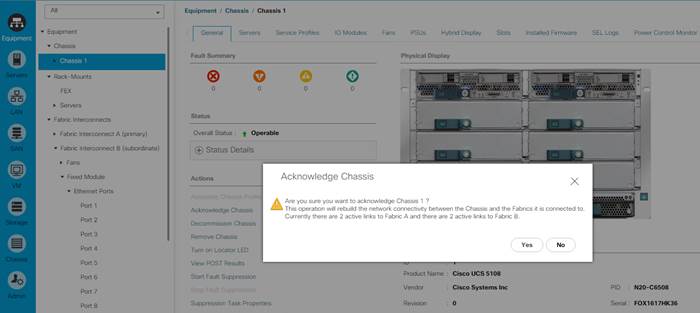
4. Click Yes and then click OK to complete acknowledging the chassis.
5. If Nexus 2232 FEX are part of the configuration, expand Rack Mounts and FEX.
6. Right-click each FEX that is listed and select Acknowledge FEX.
7. Click Yes and then click OK to complete acknowledging the FEX.
Create Uplink Port Channels to Cisco Nexus Switches
To configure the necessary port channels out of the Cisco UCS environment, complete the following steps:
1. In Cisco UCS Manager, click LAN on the left.
![]() In this procedure, two port channels are created: one from fabric A to both Cisco Nexus switches and one from fabric B to both Cisco Nexus switches.
In this procedure, two port channels are created: one from fabric A to both Cisco Nexus switches and one from fabric B to both Cisco Nexus switches.
2. Under LAN > LAN Cloud, expand the Fabric A tree.
3. Right-click Port Channels.
4. Select Create Port Channel.
5. Enter 125 as the unique ID of the port channel.
6. Enter vPC-125-Nexus as the name of the port channel.
7. Click Next.
8. Select the ports connected to the Nexus switches to be added to the port channel:
9. Click >> to add the ports to the port channel.
10. Click Finish to create the port channel.
11. Click OK.
12. In the navigation pane, under LAN > LAN Cloud, expand the fabric B tree.
13. Right-click Port Channels.
14. Select Create Port Channel.
15. Enter 126 as the unique ID of the port channel.
16. Enter vPC-126-Nexus as the name of the port channel.
17. Click Next.
18. Select the ports connected to the Nexus switches to be added to the port channel:
19. Click >> to add the ports to the port channel.
20. Click Finish to create the port channel.
21. Click OK.
Create a WWNN Pool for FC Boot
To configure the necessary WWNN pool for the Cisco UCS environment, complete the following steps on Cisco UCS Manager.
1. Select SAN on the left.
2. Select Pools > root.
3. Right-click WWNN Pools under the root organization.
4. Select Create WWNN Pool to create the WWNN pool.
5. Enter WWNN-POOL for the name of the WWNN pool.
6. Optional: Enter a description for the WWNN pool.
7. Select Sequential for Assignment Order.
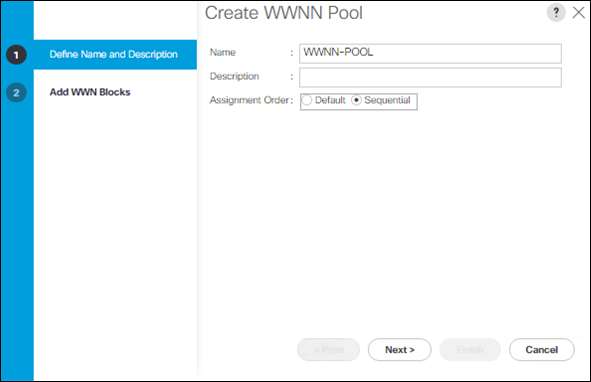
8. Click Next.
9. Click Add.
10. Modify the From field as necessary for the UCS Environment
![]() Modifications of the WWNN block, as well as the WWPN and MAC Addresses, can convey identifying information for the UCS domain. Within the From field in our example, the 6th octet was changed from 00 to 52 to represent as identifying information for this being in the UCS 6332 in the 4th cabinet
Modifications of the WWNN block, as well as the WWPN and MAC Addresses, can convey identifying information for the UCS domain. Within the From field in our example, the 6th octet was changed from 00 to 52 to represent as identifying information for this being in the UCS 6332 in the 4th cabinet
![]() Also, when having multiple UCS domains sitting in adjacency, it is important that these blocks, the WWNN, WWPN, and MAC hold differing values between each set.
Also, when having multiple UCS domains sitting in adjacency, it is important that these blocks, the WWNN, WWPN, and MAC hold differing values between each set.
11. Specify a size of the WWNN block sufficient to support the available server resources.
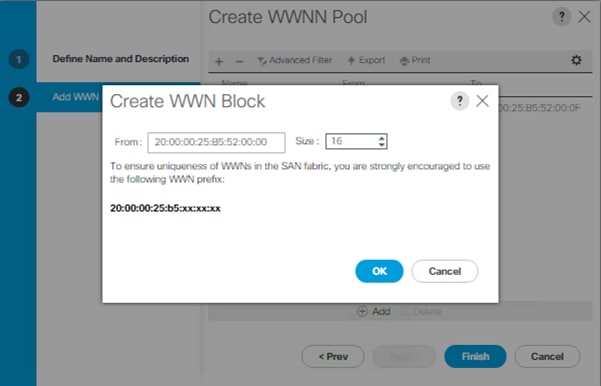
12. Click OK.
13. Click Finish and OK to complete creating the WWNN pool.
Create WWPN Pools
To configure the necessary WWPN pools for the Cisco UCS environment, complete the following steps:
1. In Cisco UCS Manager, click SAN on the left.
2. Select Pools > root.
3. In this procedure, two WWPN pools are created, one for each switching fabric.
4. Right-click WWPN Pools under the root organization.
5. Select Create WWPN Pool to create the WWPN pool.
6. Enter WWPN-POOL-A as the name of the WWPN pool.
7. Optional: Enter a description for the WWPN pool.
8. Select Sequential for Assignment Order
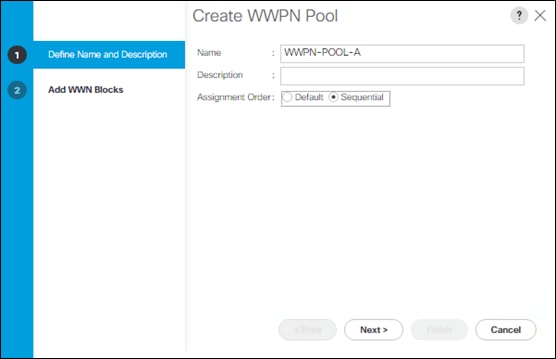
9. Click Next.
10. Click Add.
11. Specify a starting WWPN
![]() For the FlexPod solution, the recommendation is to place 0A in the next-to-last octet of the starting WWPN to identify all of the WWPNs as fabric A addresses. Merging this with the pattern we used for the WWNN we see a WWPN block starting with 20:00:00:25:B5:52:0A:00
For the FlexPod solution, the recommendation is to place 0A in the next-to-last octet of the starting WWPN to identify all of the WWPNs as fabric A addresses. Merging this with the pattern we used for the WWNN we see a WWPN block starting with 20:00:00:25:B5:52:0A:00
12. Specify a size for the WWPN pool that is sufficient to support the available blade or server resources.
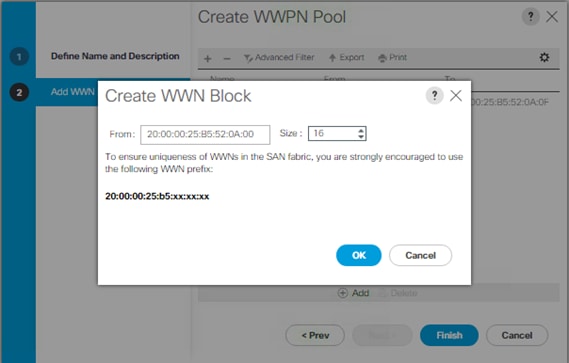
13. Click OK.
14. Click Finish.
15. In the confirmation message, click OK.
16. Right-click WWPN Pools under the root organization.
17. Select Create WWPN Pool to create the WWPN pool.
18. Enter WWPN-POOL-B as the name of the WWPN pool.
19. Optional: Enter a description for the WWPN pool.
20. Select Sequential for Assignment Order.
21. Click Next.
22. Click Add.
23. Specify a starting WWPN.
![]() For the FlexPod solution, the recommendation is to place 0B in the next-to-last octet of the starting WWPN to identify all of the WWPNs as fabric A addresses. Merging this with the pattern we used for the WWNN we see a WWPN block starting with 20:00:00:25:B5:52:0B:00.
For the FlexPod solution, the recommendation is to place 0B in the next-to-last octet of the starting WWPN to identify all of the WWPNs as fabric A addresses. Merging this with the pattern we used for the WWNN we see a WWPN block starting with 20:00:00:25:B5:52:0B:00.
24. Specify a size for the WWPN address pool that is sufficient to support the available blade or server resources.
25. Click OK.
26. Click Finish.
27. In the confirmation message, click OK
Create Storage VSAN
To configure the necessary virtual storage area networks (VSANs) for the Cisco UCS environment, complete the following steps:
1. In Cisco UCS Manager, click the SAN on the left.
![]() In this procedure, two VSANs are created.
In this procedure, two VSANs are created.
2. Select SAN > Storage Cloud.
3. Right-click VSANs.
4. Select Create Storage VSAN.
5. Enter VSAN-A as the name of the VSAN to be used for Fabric A
6. Set FC Zoning to Enabled.
7. Select Fabric A.
8. Enter a unique VSAN ID and a corresponding FCoE VLAN ID for Fabric A. It is recommended to use the same ID for both parameters and to use something other than 1.

9. Click OK and then click OK again.
10. Under Storage Cloud, right-click VSANs.
11. Select Create Storage VSAN.
12. Enter VSAN-B as the name of the VSAN to be used for Fabric B.
13. Leave FC Zoning set at Disabled.
14. Select Fabric B.
15. Enter a unique VSAN ID and a corresponding FCoE VLAN ID for Fabric B. It is recommended use the same ID for both parameters and to use something other than 1.

16. Click OK, and then click OK again
Configure FCoE Storage Port
To configure the necessary FCoE Storage port for the Cisco UCS environment, complete the following steps:
1. In Cisco UCS Manager, click Equipment on the left.
2. Select Equipment > Fabric Interconnects > Fabric Interconnect A (primary) > Fixed Module > Ethernet Ports
3. Select the ports (15 and 16 for this document) that are connected to the NetApp array, right-click them, and select “Configure as FCoE Storage Port”
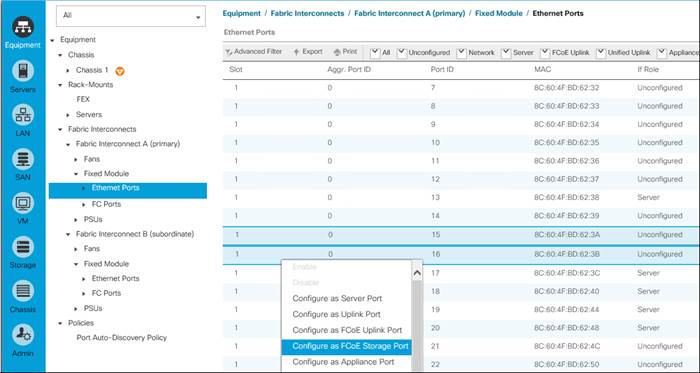
4. Click Yes to confirm and then click OK.
5. Verify that the ports connected to the NetApp array are now configured as FCoE Storage.
6. Select Equipment > Fabric Interconnects > Fabric Interconnect B (sunordinate) > Fixed Module > Ethernet Ports
7. Select the ports (15 and 16 for this document) that are connected to the NetApp array, right-click them, and select “Configure as FCoE Storage Port”
8. Click Yes to confirm and then click OK.
9. Verify that the ports connected to the NetApp array are now configured as FCoE Storage.
Assign VSANs to FCoE Storage Ports
To assign storage VSANs to FCoE Storage Ports, complete the following steps:
1. In Cisco UCS Manager, Click SAN on the left.
2. Select SAN > Storage Cloud.
3. Expand Fabric A and Storage FCoE Interfaces.
4. Select the first FCoE Interface (1/15)
5. For User Label, enter the storage controller name and port. Click Save Changes and OK.
6. Use the pulldown to select VSAN VSAN-A (101). Click Save Changes and OK.
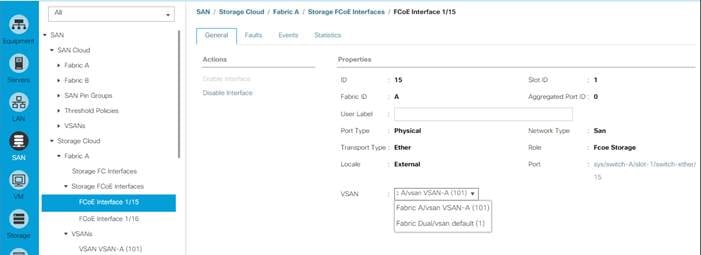
7. Select the first FCoE Interface (1/16)
8. For User Label, enter the storage controller name and port. Click Save Changes and OK.
9. Use the pulldown to select VSAN VSAN-A (101). Click Save Changes and OK.
10. Expand Fabric B and Storage FCoE Interfaces.
11. Select the first FCoE Interface (1/15)
12. For User Label, enter the storage controller name and port. Click Save Changes and OK.
13. Use the pulldown to select VSAN VSAN-B (102). Click Save Changes and OK.
14. Select the first FCoE Interface (1/16)
15. For User Label, enter the storage controller name and port. Click Save Changes and OK.
16. Use the pulldown to select VSAN VSAN-B (102). Click Save Changes and OK.
Create vHBA Templates
To create the necessary virtual host bus adapter (vHBA) templates for the Cisco UCS environment, complete the following steps:
1. In Cisco UCS Manager, click SAN on the left.
2. Select Policies > root.
3. Right-click vHBA Templates.
4. Select Create vHBA Template.
5. Enter vHBA-Template-A as the vHBA template name.
6. Keep Fabric A selected.
7. Leave Redundancy Type set to No Redundancy.
8. Select VSAN-A.
9. Leave Initial Template as the Template Type.
10. Select WWPN-POOL-A as the WWPN Pool.
11. Click OK to create the vHBA template.
12. Click OK
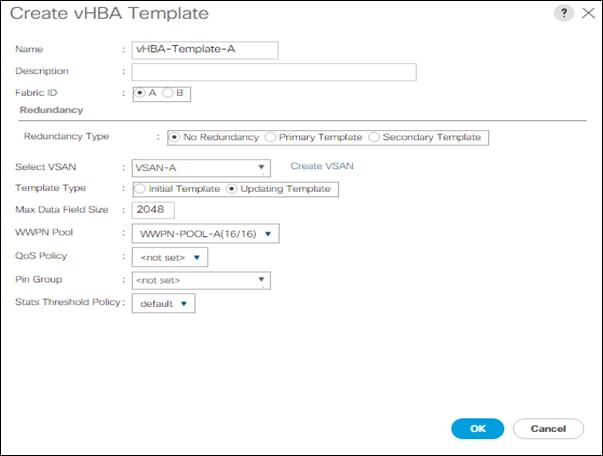
13. Right-click vHBA Templates.
14. Select Create vHBA Template.
15. Enter vHBA-Template-B as the vHBA template name.
16. Leave Redundancy Type set to No Redundancy.
17. Select Fabric B as the Fabric ID.
18. Select VSAN-B.
19. Leave Initial Template as the Template Type.
20. Select WWPN-POOl-B as the WWPN Pool.
21. Click OK to create the vHBA template.
22. Click OK.
Create SAN Connectivity Policy
To configure the necessary Infrastructure SAN Connectivity Policy, complete the following steps:
1. In Cisco UCS Manager, click SAN on the left.
2. Select SAN > Policies > root.
3. Right-click SAN Connectivity Policies.
4. Select Create SAN Connectivity Policy.
5. Enter FC-BOOT as the name of the policy.
6. Select the previously created WWNN-POOl for the WWNN Assignment.
7. Click the Add button at the bottom to add a vHBA.
8. In the Create vHBA dialog box, enter FABRIC-A as the name of the vHBA.
9. Select the Use vHBA Template checkbox.
10. In the vHBA Template list, select vHBA-Template-A.
11. In the Adapter Policy list, select WindowsBoot.
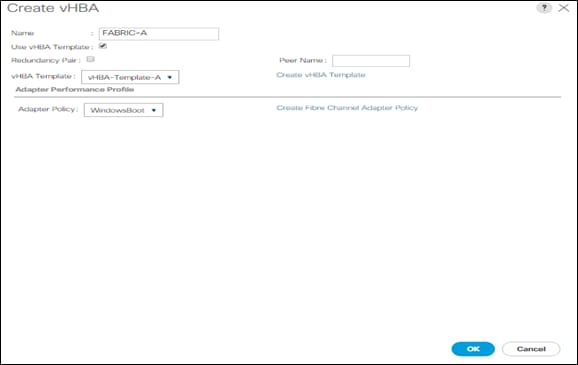
12. Click OK.
13. Click the Add button at the bottom to add a second vHBA.
14. In the Create vHBA dialog box, enter FABRIC-B as the name of the vHBA.
15. Select the Use vHBA Template checkbox.
16. In the vHBA Template list, select vHBA-Template-B.
17. In the Adapter Policy list, select WindowsBoot.
18. Click OK.
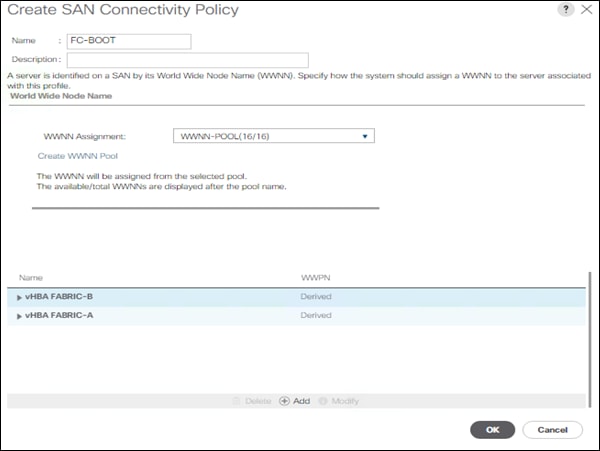
19. Click OK to create the SAN Connectivity Policy.
20. Click OK to confirm creation.
Create MAC Address Pools
To configure the necessary MAC address pools for the Cisco UCS environment, complete the following steps:
1. In Cisco UCS Manager, click LAN on the left.
2. Select Pools > root.
![]() In this procedure, two MAC address pools are created, one for each switching fabric.
In this procedure, two MAC address pools are created, one for each switching fabric.
3. Right-click MAC Pools under the root organization.
4. Select Create MAC Pool to create the MAC address pool.
5. Enter MAC-POOl-A as the name of the MAC pool.
6. Optional: Enter a description for the MAC pool.
7. Select Sequential as the option for Assignment Order.
8. Click Next.
9. Click Add.
10. Specify a starting MAC address.
![]() For the FlexPod solution, the recommendation is to place 0A in the next-to-last octet of the starting MAC address to identify all of the MAC addresses as fabric A addresses. In our example, we have carried forward the of also embedding the UCS domain number information giving us 00:25:B5:52:0A:00 as our first MAC address.
For the FlexPod solution, the recommendation is to place 0A in the next-to-last octet of the starting MAC address to identify all of the MAC addresses as fabric A addresses. In our example, we have carried forward the of also embedding the UCS domain number information giving us 00:25:B5:52:0A:00 as our first MAC address.
11. Specify a size for the MAC address pool that is sufficient to support the available blade or server resources.
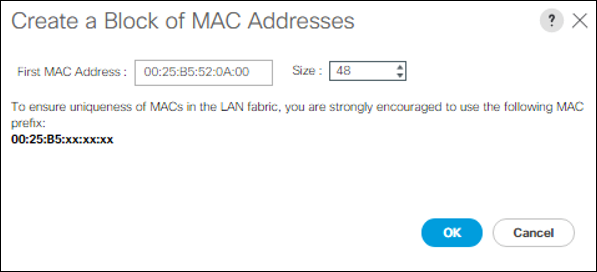
12. Click OK.
13. Click Finish.
14. In the confirmation message, click OK.
15. Right-click MAC Pools under the root organization.
16. Select Create MAC Pool to create the MAC address pool.
17. Enter MAC-POOL-B as the name of the MAC pool.
18. Optional: Enter a description for the MAC pool.
19. Select Sequential as the option for Assignment Order.
20. Click Next.
21. Click Add.
22. Specify a starting MAC address.
![]() For the FlexPod solution, it is recommended to place 0B in the next to last octet of the starting MAC address to identify all the MAC addresses in this pool as fabric B addresses. Once again, we have carried forward in our example of also embedding the UCS domain number information giving us 00:25:B5:52:0B:00 as our first MAC address.
For the FlexPod solution, it is recommended to place 0B in the next to last octet of the starting MAC address to identify all the MAC addresses in this pool as fabric B addresses. Once again, we have carried forward in our example of also embedding the UCS domain number information giving us 00:25:B5:52:0B:00 as our first MAC address.
23. Specify a size for the MAC address pool that is sufficient to support the available blade or server resources.
24. Click OK.
25. Click Finish.
26. In the confirmation message, click OK.
Create UUID Suffix Pool
To configure the necessary universally unique identifier (UUID) suffix pool for the Cisco UCS environment, complete the following steps:
1. In Cisco UCS Manager, click Servers on the left.
2. Select Pools > root.
3. Right-click UUID Suffix Pools.
4. Select Create UUID Suffix Pool.
5. Enter UUID-POOl as the name of the UUID suffix pool.
6. Optional: Enter a description for the UUID suffix pool.
7. Keep the prefix at the derived option.
8. Select Sequential for the Assignment Order.
9. Click Next.
10. Click Add to add a block of UUIDs.
11. Keep the From field at the default setting.
12. Specify a size for the UUID block that is sufficient to support the available blade or server resources.
13. Click OK.
14. Click Finish.
15. Click OK.
Create Server Pool
To configure the necessary server pool for the Cisco UCS environment, complete the following steps:
![]() Consider creating unique server pools to achieve the granularity that is required in your environment.
Consider creating unique server pools to achieve the granularity that is required in your environment.
1. In Cisco UCS Manager, click Servers on the left.
2. Select Pools > root.
3. Right-click Server Pools.
4. Select Create Server Pool.
5. Enter MS-Server-Pool as the name of the server pool.
6. Optional: Enter a description for the server pool.
7. Click Next.
8. Select two (or more) servers to be used for the Hyper-V management cluster and click >> to add them to the MS-Server-Pool server pool.
9. Click Finish.
10. Click OK.
Create VLANs
To configure the necessary virtual local area networks (VLANs) for the Cisco UCS environment, complete the following steps:
1. In Cisco UCS Manager, click LAN on the left.
![]() In this procedure, five unique VLANs are created. See Table 1.
In this procedure, five unique VLANs are created. See Table 1.
2. Select LAN > LAN Cloud.
3. Right-click VLANs.
4. Select Create VLANs.
5. Enter Native-VLAN as the name of the VLAN to be used as the native VLAN.
6. Keep the Common/Global option selected for the scope of the VLAN.
7. Enter the native VLAN ID.
8. Keep the Sharing Type as None.
9. Click OK, and then click OK again.

10. Expand the list of VLANs in the navigation pane, right-click the newly created Native-VLAN and select Set as Native VLAN.
11. Click Yes, and then click OK.
12. Right-click VLANs.
13. Select Create VLANs
14. Enter MS-IB-MGMT as the name of the VLAN to be used for management traffic.
15. Keep the Common/Global option selected for the scope of the VLAN.
16. Enter the In-Band management VLAN ID.
17. Keep the Sharing Type as None.
18. Click OK, and then click OK again.
19. Right-click VLANs.
20. Select Create VLANs.
21. Enter MS-SMB-1 as the name of the VLAN to be used for SMB File share.
22. Keep the Common/Global option selected for the scope of the VLAN.
23. Enter the SMB File Share VLAN ID.
24. Keep the Sharing Type as None.
25. Click OK, and then click OK again.
26. Right-click VLANs.
27. Select Create VLANs.
28. Enter MS-SMB-2 as the name of the VLAN to be used for 2nd SMB File share.
29. Keep the Common/Global option selected for the scope of the VLAN.
30. Enter the Infrastructure SMB File Share VLAN ID.
31. Keep the Sharing Type as None.
32. Click OK, and then click OK again
33. Right-click VLANs.
34. Select Create VLANs.
35. Enter MS-LVMN as the name of the VLAN to be used for Live Migration.
36. Keep the Common/Global option selected for the scope of the VLAN.
37. Enter the Live Migration VLAN ID.
38. Keep the Sharing Type as None.
39. Click OK, and then click OK again.
40. Select Create VLANs.
41. Enter MS-Cluster as the name of the VLAN to be used for Cluster communication network.
42. Keep the Common/Global option selected for the scope of the VLAN.
43. Enter the Cluster network VLAN ID.
44. Keep the Sharing Type as None.
45. Click OK, and then click OK again.
46. Select Create VLANs.
47. Enter MS-Tenant-VM as the name of the VLAN to be used for VM Traffic.
48. Keep the Common/Global option selected for the scope of the VLAN.
49. Enter the VM-Traffic VLAN ID.
50. Keep the Sharing Type as None.
51. Click OK, and then click OK again.

Modify Default Host Firmware Package
Firmware management policies allow the administrator to select the corresponding packages for a given server configuration. These policies often include packages for adapter, BIOS, board controller, FC adapters, host bus adapter (HBA) option ROM, and storage controller properties.
To create a firmware management policy for a given server configuration in the Cisco UCS environment, complete the following steps:
1. In Cisco UCS Manager, click Servers on the left.
2. Select Policies > root.
3. Expand Host Firmware Packages.
4. Select default.
5. In the Actions pane, select Modify Package Versions.
6. Select the version 3.1(2f) for both the Blade and Rack Packages.

7. Click OK then OK again to modify the host firmware package.
Set Jumbo Frames in Cisco UCS Fabric
To configure jumbo frames and enable quality of service in the Cisco UCS fabric, complete the following steps:
1. In Cisco UCS Manager, click LAN on the left.
2. Select LAN > LAN Cloud > QoS System Class.
3. In the right pane, click the General tab.
4. On the Best Effort row, enter 9216 in the box under the MTU column.
5. Click Save Changes in the bottom of the window.
6. Click OK

Create Local Disk Configuration Policy (Optional)
A local disk configuration for the Cisco UCS environment is necessary if the servers in the environment do not have a local disk.
![]() This policy should not be used on servers that contain local disks.
This policy should not be used on servers that contain local disks.
To create a local disk configuration policy, complete the following steps:
1. In Cisco UCS Manager, click Servers on the left.
2. Select Policies > root.
3. Right-click Local Disk Config Policies.
4. Select Create Local Disk Configuration Policy.
5. Enter SAN-Boot as the local disk configuration policy name.
6. Change the mode to No Local Storage.
7. Click OK to create the local disk configuration policy.
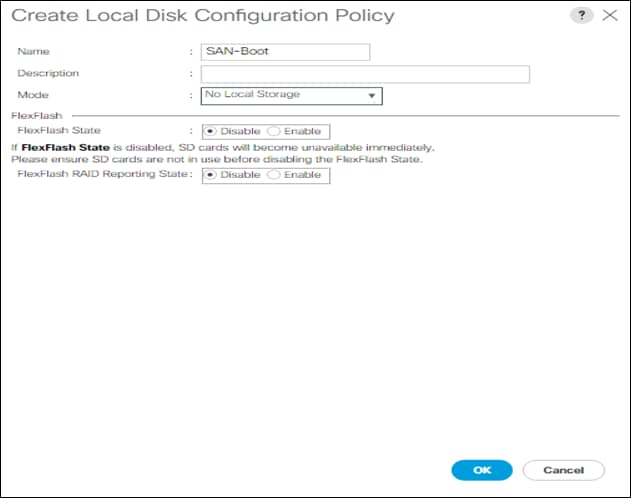
8. Click OK.
Create Network Control Policy for Cisco Discovery Protocol (CDP) and Link Layer Discovery Protocol (LLDP)
To create a network control policy that enables CDP and LLDP on virtual network ports, complete the following steps:
1. In Cisco UCS Manager, click LAN on the left.
2. Select Policies > root.
3. Right-click Network Control Policies.
4. Select Create Network Control Policy.
5. Enter Enable-CDP-LLDP as the policy name.
6. For CDP, select the Enabled option.
7. For LLDP, scroll down and select Enabled for both Transmit and Receive.
8. Click OK to create the network control policy.
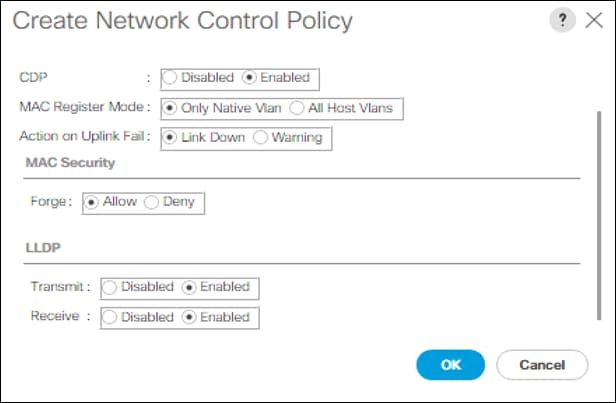
9. Click OK.
Create Power Control Policy
To create a power control policy for the Cisco UCS environment, complete the following steps:
1. In Cisco UCS Manager, click Servers tab on the left.
2. Select Policies > root.
3. Right-click Power Control Policies.
4. Select Create Power Control Policy.
5. Enter No-Power-Cap as the power control policy name.
6. Change the power capping setting to No Cap.
7. Click OK to create the power control policy.
8. Click OK.
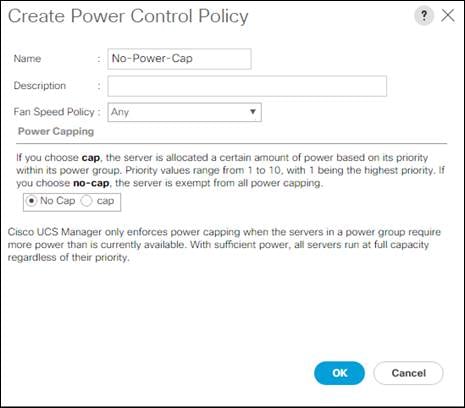
Create Server Pool Qualification Policy (Optional)
To create an optional server pool qualification policy for the Cisco UCS environment, complete the following steps:
![]() This example creates a policy for Cisco UCS B-Series and Cisco UCS C-Series servers with the Intel E2660 v4 Xeon Broadwell processors.
This example creates a policy for Cisco UCS B-Series and Cisco UCS C-Series servers with the Intel E2660 v4 Xeon Broadwell processors.
1. In Cisco UCS Manager, click Servers on the left.
2. Select Policies > root.
3. Right-click Server Pool Policy Qualifications.
4. Select Create Server Pool Policy Qualification.
5. Name the policy UCS-Broadwell.
6. Select Create CPU/Cores Qualifications.
7. Select Xeon for the Processor/Architecture.
8. Enter UCS-CPU-E52660E as the PID.
9. Click OK to create the CPU/Core qualification.
10. Click OK to create the policy then OK for the confirmation.
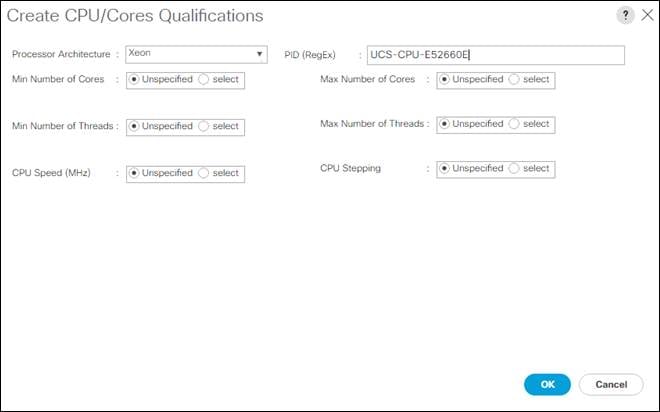
Create Server BIOS Policy
To create a server BIOS policy for the Cisco UCS environment, complete the following steps:
1. In Cisco UCS Manager, click Servers on the left.
2. Select Policies > root.
3. Right-click BIOS Policies.
4. Select Create BIOS Policy.
5. Enter MS-Host as the BIOS policy name.
6. Change the Quiet Boot setting to disabled.
7. Change Consistent Device Naming to enabled.

8. Click on the Processor tab on the left.
9. Set the following within the Processor tab
10. Processor C State -> disabled
11. Processor C1E -> disabled
12. Processor C3 Report -> disabled
13. Processor C7 Report -> disabled
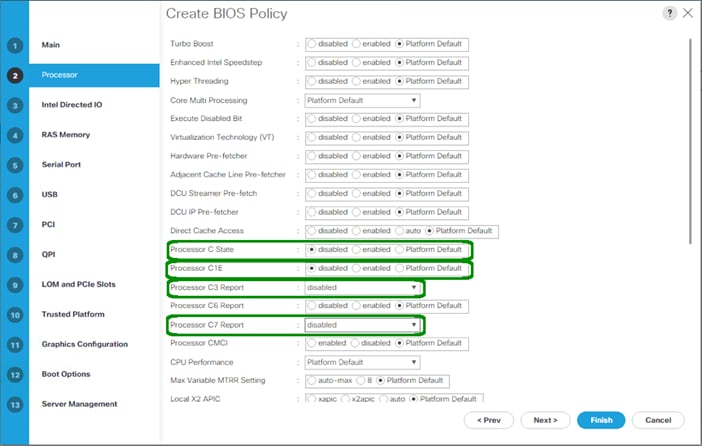
14. Scroll down to the remaining Processor options, and select:
15. Energy Performance -> performance
16. Frequency Floor Override -> enabled
17. DRAM Clock Throttling -> performance

18. Click on the RAS Memory option, and select:
19. LV DDR Mode -> performance-mode

20. Click Finish to create the BIOS policy.
21. Click OK.
Update the Default Maintenance Policy
To update the default Maintenance Policy, complete the following steps:
1. In Cisco UCS Manager, click Servers on the left.
2. Select Policies > root.
3. Select Maintenance Policies > default.
4. Change the Reboot Policy to User Ack.
5. Select “On Next Boot” to delegate maintenance windows to server administrators.
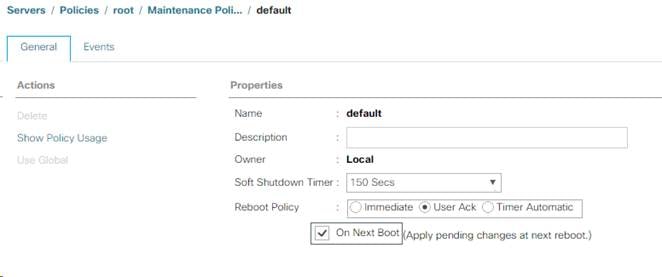
6. Click Save Changes.
7. Click OK to accept the change.
Create vNIC Templates
To create multiple virtual network interface card (vNIC) templates for the Cisco UCS environment, complete the following steps. A total of 2 vNIC Templates will be created.
Create Infrastructure vNICs
1. In Cisco UCS Manager, click LAN on the left.
2. Select Policies > root.
3. Right-click vNIC Templates.
4. Select Create vNIC Template.
5. Enter Host-A as the vNIC template name.
6. Keep Fabric A selected.
7. Do not select the Enable Failover checkbox.
8. Select Primary Template for Redundancy Type.
9. Leave the Peer Redundancy Template set to <not set>.
10. Under Target, make sure that only the Adapter checkbox is selected.
11. Select Updating Template as the Template Type.
12. Under VLANs, select the checkboxes for MS-IB-MGMT, MS-Cluster, MS-CSV, MS-SMB1, MS-SMB2, and MS-Tenant-VM VLANs.
13. Set Native-VLAN as the native VLAN.
14. Select vNIC Name for the CDN Source.
15. For MTU, enter 9000.
16. In the MAC Pool list, select MAC-POOL-A.
17. In the Network Control Policy list, select Enable-CDP-LLDP.
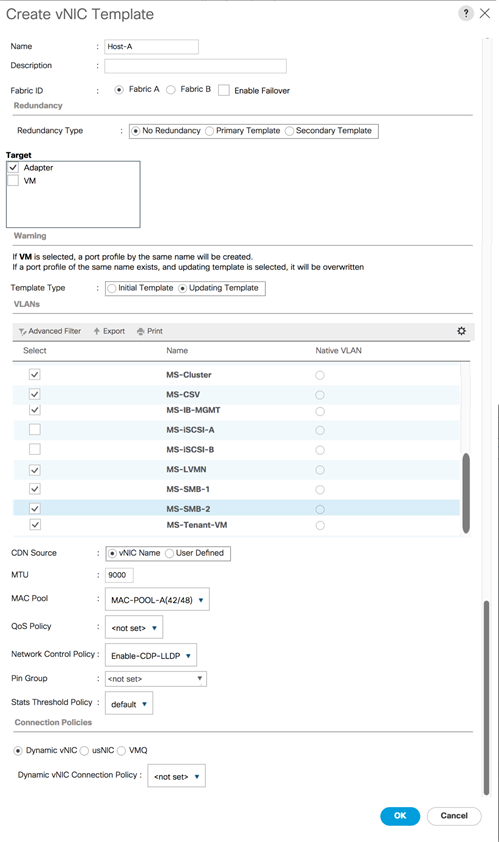
18. Click OK to create the vNIC template.
19. Click OK.
Create the secondary redundancy template Infra-B:
1. Select LAN on the left.
2. Select Policies > root.
3. Right-click vNIC Templates.
4. Select Create vNIC Template
5. Enter Host-B as the vNIC template name.
6. Select Fabric B.
7. Do not elect the Enable Failover checkbox.
8. Set Redundancy Type to Secondary Template.
9. Select Infra-A for the Peer Redundancy Template.
10. In the MAC Pool list, select MAC-POOL-B. The MAC Pool is all that needs to be selected for the Secondary Template.
11. Click OK to create the vNIC template.
12. Click OK.
Create LAN Connectivity Policy for FC Boot
To configure the necessary Infrastructure LAN Connectivity Policy, complete the following steps:
1. In Cisco UCS Manager, click LAN on the left.
2. Select LAN > Policies > root.
3. Right-click LAN Connectivity Policies.
4. Select Create LAN Connectivity Policy.
5. Enter FC-Boot as the name of the policy.
6. Click the upper Add button to add a vNIC.
7. In the Create vNIC dialog box, enter 00-Host-A as the name of the vNIC.
8. Select the Use vNIC Template checkbox.
9. In the vNIC Template list, select Host-A.
10. In the Adapter Policy list, select Windows.
11. Click OK to add this vNIC to the policy.
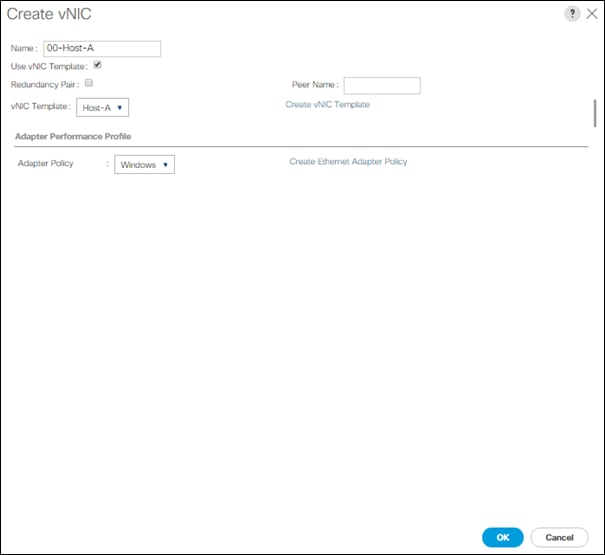
12. Click the upper Add button to add another vNIC to the policy.
13. In the Create vNIC box, enter 01-Host-B as the name of the vNIC.
14. Select the Use vNIC Template checkbox.
15. In the vNIC Template list, select Host-B.
16. In the Adapter Policy list, select Windows.
17. Click OK to add the vNIC to the policy.
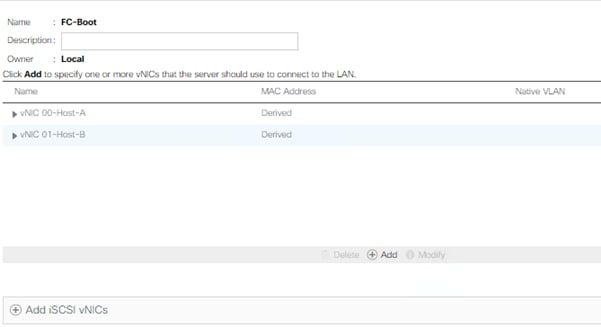
18. Click OK, then OK again to create the LAN Connectivity Policy.
Create Boot Policy (FCoE Boot)
This procedure applies to a Cisco UCS environment in which two FCoE logical interfaces (LIFs) are on cluster node 1 (fcp_lif03a_6332 and fcp_lif03b_6332) and two FCoE LIFs are on cluster node 2 (fcp_lif04a_6332 and fcp_lif04b_6332).
To create a boot policy for the Cisco UCS environment, complete the following steps:
1. In Cisco UCS Manager, click Servers on the left.
2. Select Policies > root.
3. Right-click Boot Policies.
4. Select Create Boot Policy.
5. Enter FCoE-Boot as the name of the boot policy.
6. Optional: Enter a description for the boot policy.
![]() Do not select the Reboot on Boot Order Change checkbox.
Do not select the Reboot on Boot Order Change checkbox.
7. Keep the Reboot on Boot Order Change option cleared.
8. Expand the Local Devices drop-down menu and select Local CD/DVD.
9. Expand the vHBAs drop-down menu and select Add SAN Boot.
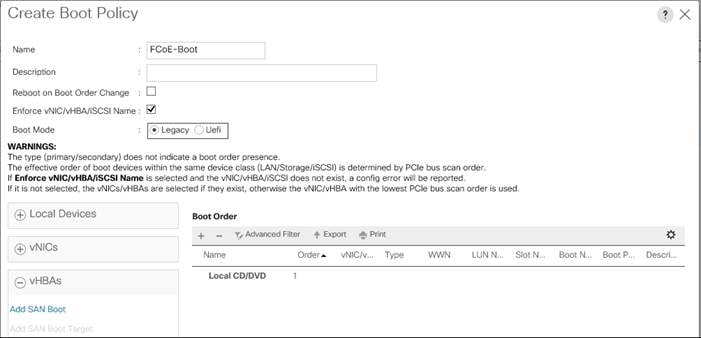
10. Select the Primary for type field.
11. Enter FABRIC-A in vHBA field.
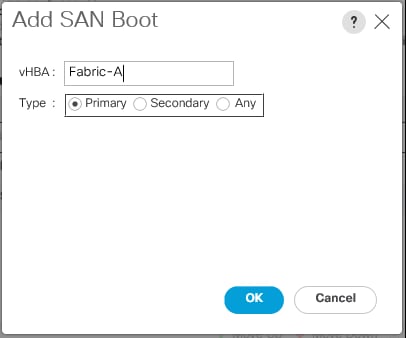
12. Click OK.
13. From the vHBA drop-down menu, select Add SAN Boot Target.
14. Keep 0 as the value for Boot Target LUN.
15. Enter the WWPN for fcp_lif03a_6332
![]() To obtain this information, log in to the storage cluster and run the network interface show command
To obtain this information, log in to the storage cluster and run the network interface show command
16. Select Primary for the SAN boot target type.

17. Click OK to add the SAN boot target.
18. From the vHBA drop-down menu, select Add SAN Boot Target.
19. Enter 0 as the value for Boot Target LUN.
20. Enter the WWPN for fcp_lif04a_6332.
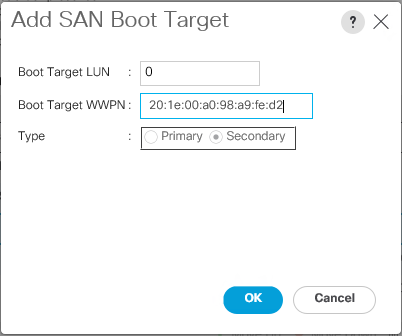
21. Click OK to add the SAN boot target.
22. From the vHBA drop-down menu, select Add SAN Boot.
23. In the Add SAN Boot dialog box, enter FABRIC-B in the vHBA box.
24. The SAN boot type should automatically be set to Secondary.
25. Click OK to add the SAN boot.
26. From the vHBA drop-down menu, select Add SAN Boot Target.
27. Keep 0 as the value for Boot Target LUN.
28. Enter the WWPN for fcp_lif03b_6332.
29. Select Primary for the SAN boot target type.
30. Click OK to add the SAN boot target.
31. From the vHBA drop-down menu, select Add SAN Boot Target.
32. Keep 0 as the value for Boot Target LUN.
33. Enter the WWPN for fcp_lif04b_6332.
34. Click OK to add the SAN boot target.

35. Click OK, then click OK again to create the boot policy.
Create Service Profile Templates
In this procedure, one service profile template for Infrastructure Hyper-V hosts is created for Fabric A boot.
To create the service profile template, complete the following steps:
1. In Cisco UCS Manager, click Servers on the left.
2. Select Service Profile Templates > root.
3. Right-click root.
4. Select Create Service Profile Template to open the Create Service Profile Template wizard.
5. Enter Hyper-V-Host-FC as the name of the service profile template. This service profile template is configured to boot from storage node 1 on fabric A.
6. Select the “Updating Template” option.
7. Under UUID, select UUID_Pool as the UUID pool.
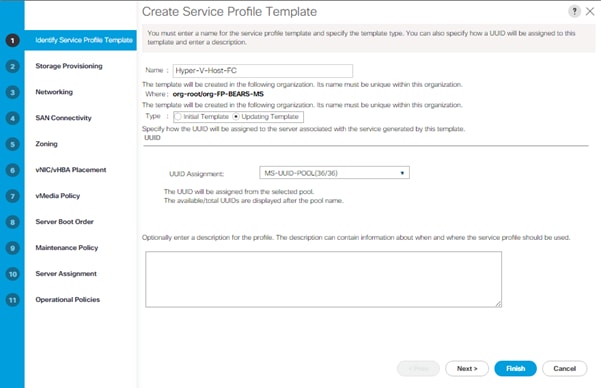
8. Click Next.
Configure Storage Provisioning
1. If you have servers with no physical disks, click on the Local Disk Configuration Policy and select the SAN-Boot Local Storage Policy. Otherwise, select the default Local Storage Policy.
2. Click Next.
Configure Networking Options
1. Keep the setting at default for Dynamic vNIC Connection Policy.
2. Select the “Use Connectivity Policy” option to configure the LAN connectivity.
3. Select FC-Boot from the LAN Connectivity Policy pull-down.
4. Leave Initiator Name Assignment at <not set>.
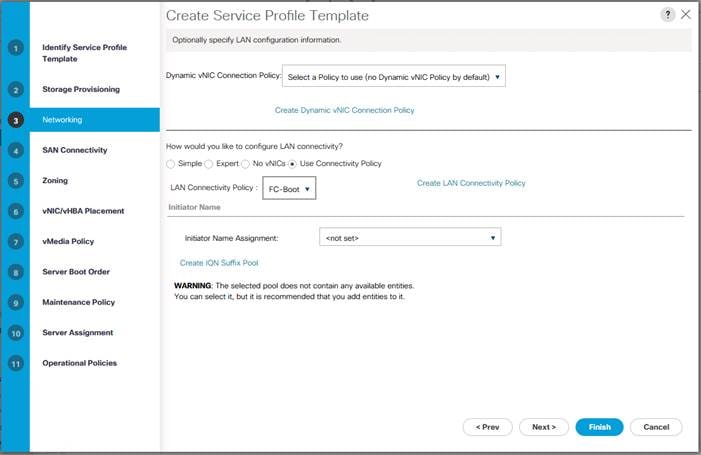
5. Click Next.
Configure Storage Options
1. Select the Use Connectivity Policy option for the “How would you like to configure SAN connectivity?” field.
2. Select the FC-BOOT option from the SAN Connectivity Policy pull-down.
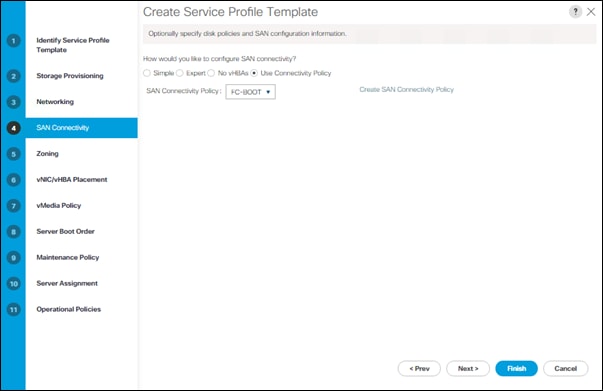
3. Click Next.
Configure Zoning Options
1. Set no Zoning options and click Next.
Configure vNIC/HBA Placement
1. In the “Select Placement” list, leave the placement policy as “Let System Perform Placement”.
2. Click Next.
Configure vMedia Policy
1. Do not select a vMedia Policy.
2. Click Next.
Configure Server Boot Order
1. Select FCoE-Boot for Boot Policy.
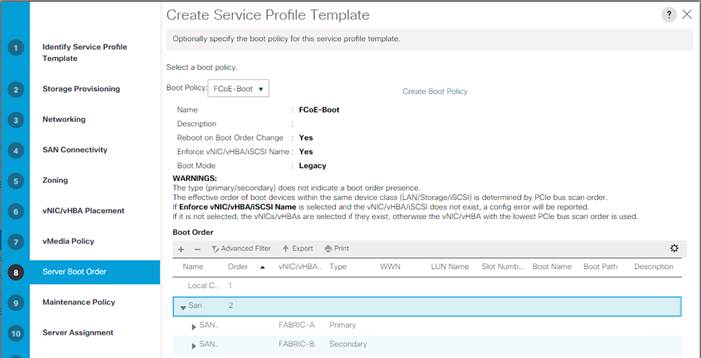
2. Click Next.
Configure Maintenance Policy
1. Change the Maintenance Policy to default.
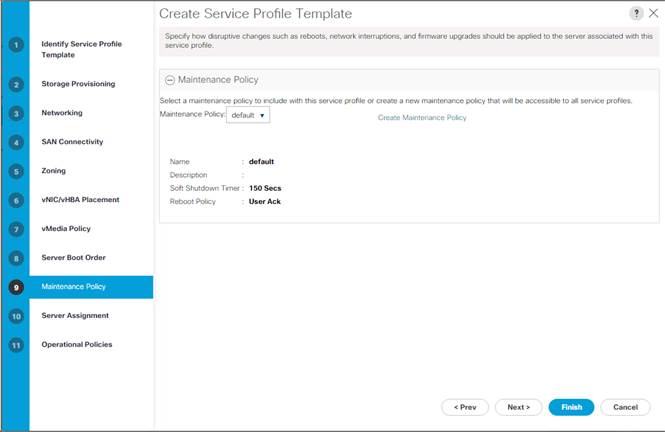
2. Click Next.
Configure Server Assignment
To configure server assignment, complete the following steps:
1. In the Pool Assignment list, select MS-Server-Pool.
2. Select Down as the power state to be applied when the profile is associated with the server.
3. Optional: select “UCS-Broadwell” for the Server Pool Qualification.
4. Expand Firmware Management at the bottom of the page and select the default policy
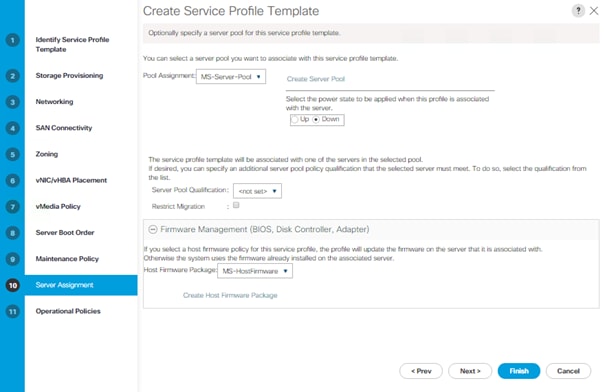
5. Click Next.
Configure Operational Policies
To configure the operational policies, complete the following steps:
1. In the BIOS Policy list, select MS-Host.
2. Expand Power Control Policy Configuration and select No-Power-Cap in the Power Control Policy list.
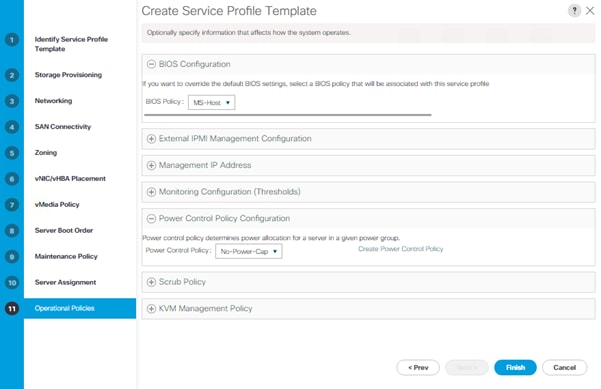
3. Click Finish to create the service profile template.
4. Click OK in the confirmation message.
Create Service Profiles
To create service profiles from the service profile template, complete the following steps:
1. Connect to UCS Manager and click Servers on the left.
2. Select Service Profile Templates > root > Service Template Hyper-V-Host-FC.
3. Right-click Hyper-V-Host-FC and select Create Service Profiles from Template.
4. Enter Hyper-V-Host-0 as the service profile prefix.
5. Enter 1 as “Name Suffix Starting Number.”
6. Enter 2 as the “Number of Instances.”
7. Click OK to create the service profiles.
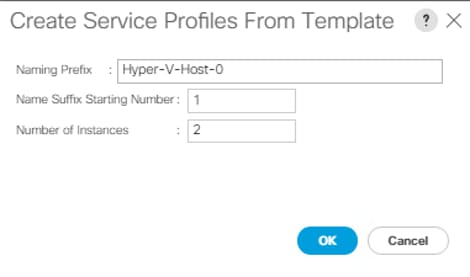
8. Click OK in the confirmation message.
Add More Servers to FlexPod Unit
Additional server pools, service profile templates, and service profiles can be created in the respective organizations to add more servers to the FlexPod unit. All other pools and policies are at the root level and can be shared among the organizations.
Gather Necessary Information
After the Cisco UCS service profiles have been created, each infrastructure server in the environment will have a unique configuration. To proceed with the FlexPod deployment, specific information must be gathered from each Cisco UCS server and from the NetApp controllers. Insert the required information into Table 6 and Table 7 below.
Table 1 WWPNs from NetApp storage
| SVM |
Adapter |
MDS Switch |
Target: WWPN |
| Infra-MS-SVM |
fcp_lif03a_6332 |
Fabric A |
<fcp_ lif03a_6332-wwpn> |
| fcp_lif03b_6332 |
Fabric B |
<fcp_ lif03b_6332-wwpn> |
|
| fcp_lif04a_6332 |
Fabric A |
<fcp_ lif04a_6332-wwpn> |
|
| fcp_lif04b_6332 |
Fabric B |
<fcp_ lif04b_6332-wwpn> |
![]() To obtain the FC WWPNs, run the network interface show command on the storage cluster management interface.
To obtain the FC WWPNs, run the network interface show command on the storage cluster management interface.
Table 2 WWPNs for UCS Service Profiles
| Cisco UCS Service Profile Name |
MDS Switch |
Initiator WWPN |
| Hyper-V-Host-01 |
Fabric A |
Hyper-V-Host -01-wwpna |
| Fabric B |
Hyper-V-Host -01-wwpnb |
|
| Hyper-V-Host -02 |
Fabric A |
Hyper-V-Host -02-wwpna |
| Fabric B |
Hyper-V-Host -02-wwpnb |
![]() To obtain the FC vHBA WWPN information in Cisco UCS Manager GUI, go to Servers > Service Profiles > root. Click each service profile and then click the “Storage” tab, then “vHBAs” tab on the right. The WWPNs are displayed in the table at the bottom of the page.
To obtain the FC vHBA WWPN information in Cisco UCS Manager GUI, go to Servers > Service Profiles > root. Click each service profile and then click the “Storage” tab, then “vHBAs” tab on the right. The WWPNs are displayed in the table at the bottom of the page.
Adding Direct Connected Tenant FC Storage
To add FC storage from an additional storage SVM, two storage connection policies, one for each fabric must be added in UCS Manager and attached to vHBA Initiator Groups in the SAN Connectivity Policy. These steps were not shown in the initial deployment above because it is not necessary to zone boot targets. Boot targets are automatically zoned in the fabric interconnect when zoning is enabled on the fabric VSAN. To add direct connected tenant FC storage from a tenant SVM, complete the following steps:
Create Storage Connection Policies
In this procedure, one storage connection policy is created for each fabric.
To create the storage connection policies, complete the following steps:
1. In Cisco UCS Manager, click SAN on the left.
2. Right-click SAN > Policies > root > Storage Connection Policies and select Create Storage Connec-tion Policy.
3. Name the policy to indicate a tenant on Fabric A.
4. Select the Single Initiator Multiple Targets Zoning Type.
5. Click Add to add a target.
6. Enter the WWPN of the first fabric A FC LIF in the tenant SVM connected to fabric interconnect A. Select Path A and VSAN VSAN-A. Click OK.
7. Click Add to add a target.
8. Enter the WWPN of the second fabric A FC LIF in the tenant SVM connected to fabric interconnect A. Select Path A and VSAN VSAN-A. Click OK.
9. Click OK then OK again to complete adding the Storage Connection Policy.
10. Right-click SAN > Policies > root > Storage Connection Policies and select Create Storage Connec-tion Policy.
11. Name the policy to indicate a tenant on Fabric B.
12. Select the Single Initiator Multiple Targets Zoning Type.
13. Click Add to add a target.
14. Enter the WWPN of the first fabric B FC LIF in the tenant SVM connected to fabric interconnect B. Select Path B and VSAN VSAN-B. Click OK.
15. Click Add to add a target.
16. Enter the WWPN of the second fabric B FC LIF in the tenant SVM connected to fabric interconnect B. Select Path B and VSAN VSAN-B. Click OK.
17. Click OK then OK again to complete adding the Storage Connection Policy.
Map Storage Connection Policies vHBA Initiator Groups in SAN Connectivity Policy
In this procedure, storage connection policies are mapped to vHBA initiator groups for each fabric.
To create the storage connection policy mappings, complete the following steps:
1. In Cisco UCS Manager, click SAN on the left.
2. Select SAN > Policies > root > SAN Connectivity Policies > FC-Boot.
3. In the center pane, select the vHBA Initiator Groups tab.
4. Click Add to add a vHBA Initiator Group.
5. Name the group Fabric A and select the Fabric A Initiator.
6. Use the pulldown to select the Fabric A Storage Connection Policy.
7. Click OK and OK to complete adding the Initiator Group.
8. Click Add to add a vHBA Initiator Group.
9. Name the group Fabric B and select the Fabric B Initiator.
10. Use the pulldown to select the Fabric B Storage Connection Policy.
11. Click OK and OK to complete adding the Initiator Group.
Setup the Microsoft Windows 2016 install
The Microsoft Windows 2016 install sub-sections listed below and their installation procedures follow the installation guidelines covered in the main document.
Install Windows Server 2016
To complete this section, refer to the corresponding section of the main document and execute all the steps.
Install Chipset and Windows eNIC Drivers
To complete this section, refer to the corresponding section of the main document and execute all the steps.
Install Windows Roles and Features
To complete this section, refer to the corresponding section of the main document and execute all the steps.
Install NetApp Host Utilities
To complete this section, refer to corresponding section of the main document and execute all the steps.
Host Renaming and Join to Domain
To complete this section, refer to the corresponding section of the main document and execute all the steps.
Deploying and Managing Hyper-V Clusters using System Center 2016 VMM
To complete this section, refer to the corresponding section of the main document and execute all the steps.
Cisco UCS Backup
Automated backup of the UCS domain is important for recovery of the Cisco UCS Domain from issues ranging catastrophic failure to human error. There is a native backup solution within UCS that allows local or remote backup using FTP/TFTP/SCP/SFTP as options.
Created backups can be a binary file containing the Full State, which can be used for a restore to the original or a replacement pair of Cisco UCS fabric interconnects. Alternately this XML configuration file consists of All configurations, just System configurations, or just Logical configurations of the UCS Domain. For scheduled backups, the available options are Full State or All Configuration, backup of just the System or Logical configurations can be manually initiated.
Specification of the backup can be done by following these steps within the UCSM GUI:
1. Select Admin within the Navigation pane and select All.
2. Click on the Policy Backup and Export tab within All.
3. For a Full State Backup, All Configuration Backup, or both, specify the following:
a. Hostname : <IP or FQDN of host that will receive the backup>
b. Protocol: [FTP/TFTP/SCP/SFTP]
c. User: <account on host to authenticate>
d. Password: <password for account on host>
e. Remote File: <full path and filename prefix for backup file>
f. Admin State: <select Enable to activate the schedule on save, Disable to disable schedule on save>
g. Schedule: [Daily/Weekly/Bi Weekly]
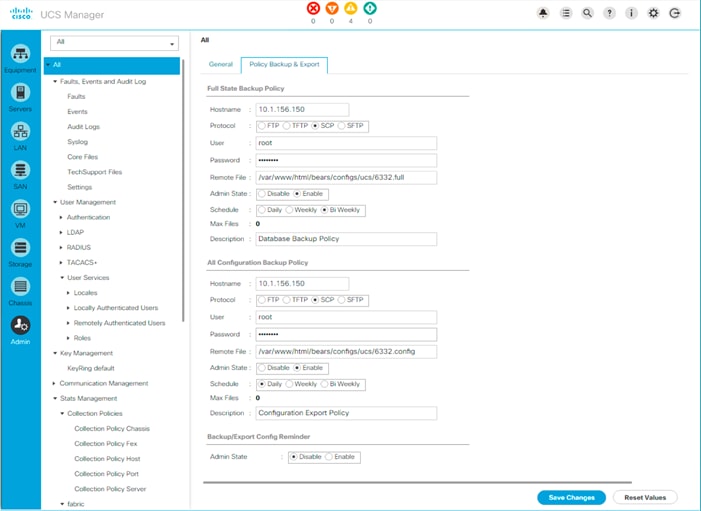
4. Click Save Changes to create the Policy.
Cisco Nexus Backups
The configuration of the Cisco Nexus 9000 switches can be backed up manually at any time with the copy command, but automated backups can be put in place with the NX-OS feature scheduler. An example of setting up an automated configuration backup for one of the FlexPod 9332PQ switches is shown below:
bb04-9332-a# conf t
Enter configuration commands, one per line. End with CNTL/Z.
bb04-9332-a(config)# feature scheduler
bb04-9332-a(config)# scheduler logfile size 1024
bb04-9332-a(config)# scheduler job name backup-cfg
bb04-9332-a(config-job)# copy running-config tftp://192.168.156.155/9332/$(SWITCHNAME)-cfg.$(TIMESTAMP) vrf management
bb04-9332-a(config-job)# exit
bb04-9332-a(config)# scheduler schedule name daily
bb04-9332-a(config-schedule)# job name backup-cfg
bb04-9332-a(config-schedule)# time daily 2:00
bb04-9332-a(config-schedule)# end
Show the job that has been setup:
bb04-9332-a# sh scheduler job
Job Name: backup-cfg
--------------------
copy running-config tftp://192.168.156.155/9332/$(SWITCHNAME)-cfg.$(TIMESTAMP) vrf management
==============================================================================
bb04-9332-a# show scheduler schedule
Schedule Name : daily
---------------------------
User Name : admin
Schedule Type : Run every day at 2 Hrs 0 Mins
Last Execution Time : Sun Apr 9 02:00:00 2017
Last Completion Time: Sun Apr 9 02:00:01 2017
Execution count : 3
-----------------------------------------------
Job Name Last Execution Status
-----------------------------------------------
backup-cfg Success (0)
==============================================================================
Full documentation for the feature scheduler can be found at: http://www.cisco.com/c/en/us/td/docs/switches/datacenter/nexus9000/sw/7-x/system_management/configuration/guide/b_Cisco_Nexus_9000_Series_NX-OS_System_Management_Configuration_Guide_7x/b_Cisco_Nexus_9000_Series_NX-OS_System_Management_Configuration_Guide_7x_chapter_01010.html
The 40Gb end to end FlexPod design in this document uses a pair of Nexus 9332PQ which is built with 40 Gbps Quad Small Form Factor Pluggable Plus (QSFP+) type on all ports. If there is a need to directly support a 10Gb Small Form Pluggable Plus (SFP+), this can be configured within the switch, and connected to the 10Gb SFP+ device using a supported QSFP+ Breakout Cable.
Configuration of the QSFP+ ports will use the interface breakout command as shown in this example to turn the 40Gb interface Ethernet 1/1 into 4x10Gb interfaces:
bb04-9332-a(config)# show running-config interface Ethernet1/1
interface Ethernet1/1
no switchport
bb04-9332-a(config)# interface breakout module 1 port 5 map 10g-4x
bb04-9332-a(config)# show running-config interface Ethernet1/1/1-4
interface Ethernet1/1/1
interface Ethernet1/1/2
interface Ethernet1/1/3
interface Ethernet1/1/4
Breakout configurations that are no longer needed can be reverted with the no interface breakout command:
bb04-9332-a(config)# no interface breakout module 1 port 1 map 10g-4x
Rajendra Yogendra, Technical Marketing Engineer, Data Center Solutions Engineering, Cisco Systems Inc.
Rajendra has over 9 years of experience in IT Infrastructure, Server Virtualization, and Cloud Computing. His current role includes building Infrastructure solutions, software defined storage solutions, and performance benchmarking on Cisco UCS platforms.
Aaron Kirk, Technical Marketing Engineer, Converged Infrastructure Engineering, NetApp Inc.
Aaron Kirk is a Technical Marketing Engineer in the NetApp Converged Infrastructure Engineering team. He focuses on producing validated reference architectures that promote the benefits of end-to-end data center solutions and cloud environments. Aaron has been at NetApp since 2010, previously working as an engineer on the MetroCluster product in the Data Protection Group. Aaron holds a Bachelor of Science in Computer Science and a Masters of Business Administration from North Carolina State University.
Acknowledgements
For their support and contribution to the design, validation, and creation of this Cisco Validated Design, the authors would like to thank:
· Suhas Rao
· Sanjeev Naldurgkar
· John George
· Chris Reno
· Karthick Radhakrishnan

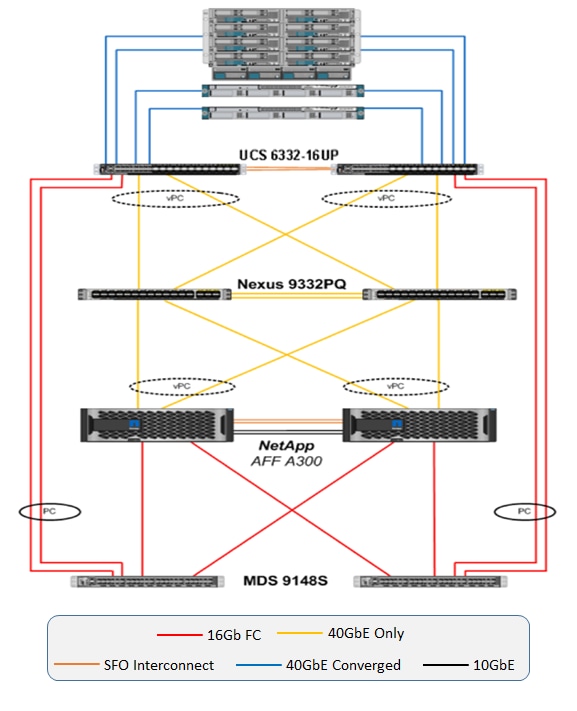
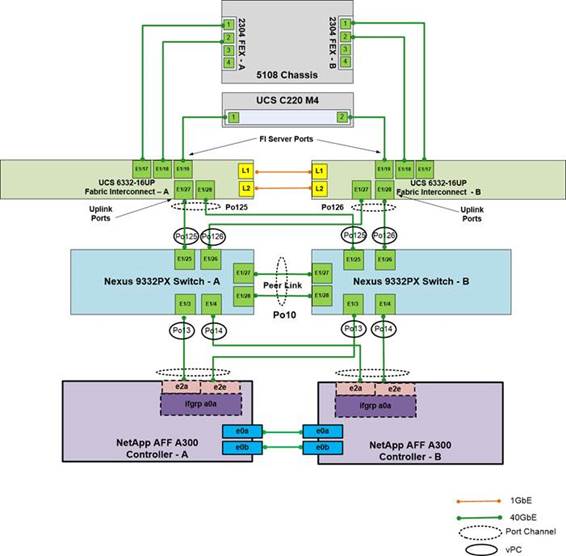
 Feedback
Feedback